
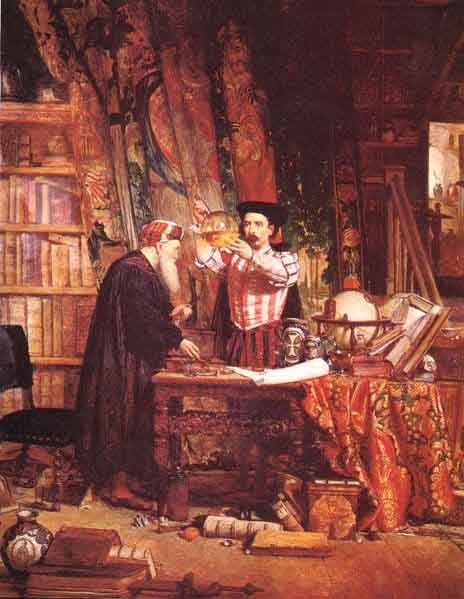
In the second decade of the twenty-first century, alchemy is not only about the transmutation of metals, but the shift in consciousness that returns us from the physical to the non-physical.
Throughout its history, alchemy has shown a dual nature. On the one hand, it has involved the use of chemical substances and so is claimed by the history of science as the precursor of modern chemistry. Yet at the same time, alchemy has, throughout its history, also been associated with the esoteric, spiritual beliefs of Hermeticism and thus is a proper subject for the historian of religious thought. Such an approach is complemented by the psychological studies of Carl Jung, which correlate alchemical symbolism with the development of the psycho-religious life of the individual.
Alchemy was practiced in Mesopotamia, Ancient Egypt, Persia, India, Japan, Korea and China, in Classical Greece and Rome, in the Muslim civilizations, and then in Europe up to the 19th century in a complex network of schools and philosophical systems spanning at least 2,500 years.
In the history of science, alchemy refers to both an early form of the investigation of nature and an early philosophical and spiritual discipline, both combining elements of chemistry, metallurgy, physics, medicine, astrology, semiotics, mysticism, spiritualism, and art all as parts of one greater force.
Alchemy is an ancient path of spiritual purification and transformation; the expansion of consciousness and the development of insight and intuition through images. Alchemy is steeped in mysticism and mystery. It presents to the initiate a system of eternal, dreamlike, esoteric symbols that have the power to alter consciousness and connect the human soul to the Divine.
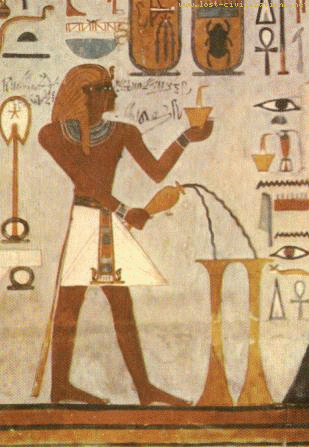
It is part of the mystical and mystery traditions of both East and West. In the West, it dates to ancient Egypt, where adepts first developed it as an early form of chemistry and metallurgy. Egyptians alchemists used their art to make alloys, dyes, perfumes and cosmetic jewelry, and to embalm the dead.
The early Arabs made significant contributions to alchemy, such as by emphasizing the mysticism of numbers (quantities and lengths of time for processes). The Arabs also gave us the term 'alchemy', from the Arabic term 'alchimia', which loosely translated means 'the Egyptian art'.
During medieval and Renaissance times, alchemy spread through the Western world, and was further developed by Kabbalists, Rosicrucians, astrologers and other occultists. It functioned on two levels: mundane and spiritual. On a mundane level, alchemists sought to find a physical process to convert base metals such as lead into gold. On a spiritual level, alchemists worked to purify themselves by eliminating the "base" material of the self and achieving the 'gold' of enlightenment.
By Renaissance times, many alchemists believed that the spiritual purification was necessary in order to achieve the mundane transformations of metals.
The alchemists relied heavily upon their dreams, inspirations and visions for guidance in perfecting their art. In order to protect their secrets, they recorded diaries filled with mysterious symbols rather than text. These symbols remain exceptionally potent for changing states of consciousness.
Alchemy is a form of speculative thought that, among other aims, tried to transform base metals such as lead or copper into silver or gold and to discover a cure for disease and a way of extending life.
Alchemy was the name given in Latin Europe in the 12th century to an aspect of thought that corresponds to astrology, which is apparently an older tradition. Both represent attempts to discover the relationship of man to the cosmos and to exploit that relationship to his benefit. The first of these objectives may be called scientific, the second technological.
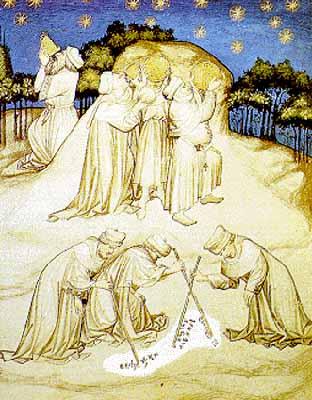
Astrology is concerned with man's relationship to "the stars" (including the members of the solar system); alchemy, with terrestrial nature. But the distinction is far from absolute, since both are interested in the influence of the stars on terrestrial events. Moreover, both have always been pursued in the belief that the processes human beings witness in heaven and on earth manifest the will of the Creator and, if correctly understood, will yield the key to the Creator's intentions.
Nature and Significance
Evidence from ancient Middle America (Aztecs, Mayans) is still almost nonexistent; evidence from India is tenuous and from ancient China, Greece, and Islamic lands is only relatively more plentiful.
A single manuscript of some 80,000 words is the principal source for the history of Greek alchemy.
Chinese alchemy is largely recorded in about 100 "books" that are part of the Taoist canon.
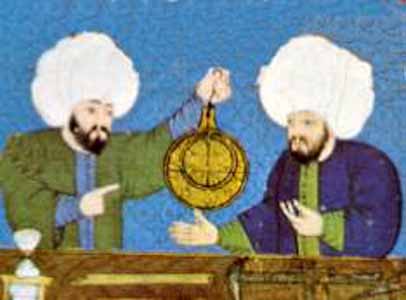
Neither Indian nor Islamic alchemy has ever been collected, and scholars are thus dependent for their knowledge of the subject on occasional allusions in works of natural philosophy and medicine, plus a few specifically alchemical works.
Nor is it really clear what alchemy was (or is). The word is a European one, derived from Arabic, but the origin of the root word, chem, is uncertain. Words similar to it have been found in most ancient languages, with different meanings, but conceivably somehow related to alchemy. In fact, the Greeks, Chinese, and Indians usually referred to what Westerners call alchemy as "The Art," or by terms denoting change or transmutation.
The Chemistry of Alchemy
Mercury, the liquid metal, certainly known before 300 BC, when it appears in both Eastern and Western sources, was crucial to alchemy. Sulfur, "the stone that burns," was also crucial. It was known from prehistoric times in native deposits and was also given off in metallurgic processes (the "roasting" of sulfide ores).
Mercury united with most of the other metals, and the amalgam formed colored powders (the sulfides) when treated with sulfur. Mercury itself occurs in nature in a red sulfide, cinnabar, which can also be made artificially. All of these, except possibly the last, were operations known to the metallurgist and were adopted by the alchemist.
The alchemist added the action on metals of a number of corrosive salts, mainly the vitriols (copper and iron sulfates), alums (the aluminum sulfates of potassium and ammonium), and the chlorides of sodium and ammonium. And he made much of arsenic's property of colouring metals. All of these materials, except the chloride of ammonia, were known in ancient times.
Known as sal ammoniac in the West, nao sha in China, nao sadar in India, and nushadir in Persia and Arabic lands, the chloride of ammonia first became known to the West in the Chou-i ts'an t'ung ch'i, a Chinese treatise of the 2nd century AD.
It was to be crucial to alchemy, for on sublimation it dissociates into antagonistic corrosive materials, ammonia and hydrochloric acid, which readily attack the metals. Until the 9th century it seems to have come from a single source, the Flame Mountain (Huo-yen Shan) near T'u-lu-p'an (Turfan), in Central Asia.
Finally, the manipulation of these materials was to lead to the discovery of the mineral acids, the history of which began in Europe in the 13th century. The first was probably nitric acid, made by distilling together saltpetre (potassium nitrate) and vitriol or alum. More difficult to discover was sulfuric acid, which was distilled from vitriol or alum alone but required apparatus resistant to corrosion and heat. And most difficult was hydrochloric acid, distilled from common salt or sal ammoniac and vitriol or alum, for the vapours of this acid cannot be simply condensed but must be dissolved in water.
Goals
Alchemy was not original in seeking these goals, for it had been preceded by religion, medicine, and metallurgy. The first chemists were metallurgists, who were perhaps the most successful practitioners of the arts in antiquity. Their theories seem to have come not from science but from folklore and religion. The miner and metallurgist, like the agriculturalist, in this view, accelerate the normal maturation of the fruits of the earth, in a magico-religious relationship with nature. In primitive societies the metallurgist is often a member of an occult religious society.
But the first ventures into natural philosophy, the beginnings of what is called the scientific view, also preceded alchemy. Systems of five almost identical basic elements were postulated in China, India, and Greece, according to a view in which nature comprised antagonistic, opposite forces--hot and cold, positive and negative, and male and female; i.e., primitive versions of the modern conception of energy. Drawing on a similar astrological heritage, philosophers found correspondences among the elements, planets, and metals. In short, both the chemical arts and the theories of the philosophers of nature had become complex before alchemy appeared.
Regional Variations
Chinese Alchemy
Although non-Chinese influences (especially Indian) are possible, the genesis of alchemy in China may have been a purely domestic affair. It emerged during a period of political turmoil, the Warring States Period (from the 5th to the 3rd century BC), and it came to be associated with Taoism--a mystical religion founded by the 6th-century-BC sage Lao-tzu--and its sacred book, the Tao-te Ching ("Classic of the Way of Power"). The Taoists were a miscellaneous collection of "outsiders"--in relation to the prevailing Confucians--and such mystical doctrines as alchemy were soon grafted onto the Taoist canon. What is known of Chinese alchemy is mainly owing to that graft, and especially to a collection known as Yün chi ch'i ch'ien ("Seven Tablets in a Cloudy Satchel"), which is dated 1023. Thus, sources on alchemy in China (as elsewhere) are compilations of much earlier writings.
The oldest known Chinese alchemical treatise is the Chou-i ts'an t'ung ch'i ("Commentary on the I Ching"). In the main it is an apocryphal interpretation of the I Ching ("Classic of Changes"), an ancient classic especially esteemed by the Confucians, relating alchemy to the mystical mathematics of the 64 hexagrams (six-line figures used for divination). Its relationship to chemical practice is tenuous, but it mentions materials (including sal ammoniac) and implies chemical operations.
The first Chinese alchemist who is reasonably well known was Ko Hung (AD 283-343), whose book Pao-p'u-tzu (pseudonym of Ko Hung) contains two chapters with obscure recipes for elixirs, mostly based on mercury or arsenic compounds.
The most famous Chinese alchemical book is the Tan chin yao chüeh ("Great Secrets of Alchemy"), probably by Sun Ssu-miao (AD 581-after 673). It is a practical treatise on creating elixirs (mercury, sulfur, and the salts of mercury and arsenic are prominent) for the attainment of immortality, plus a few for specific cures for disease and such other purposes as the fabrication of precious stones.
Altogether, the similarities between the materials used and the elixirs made in China, India, and the West are more remarkable than are their differences. Nonetheless, Chinese alchemy differed from that of the West in its objective. Whereas in the West the objective seems to have evolved from gold to elixirs of immortality to simply superior medicines, neither the first nor the last of these objectives seems ever to have been very important in China.
Chinese alchemy was consistent from first to last, and there was relatively little controversy among its practitioners, who seem to have varied only in their prescriptions for the elixir of immortality or perhaps only over their names for it, of which one Sinologist has counted about 1,000. In the West there were conflicts between advocates of herbal and "chemical" (i.e., mineral) pharmacy, but in China mineral remedies were always accepted.
In Europe, there were conflicts between alchemists who favoured gold making and those who thought medicine the proper goal, but the Chinese always favoured the latter. Since alchemy rarely achieved any of these goals, it was an advantage to the Western alchemist to have the situation obscured, and the art survived in Europe long after Chinese alchemy had simply faded away.
Chinese alchemy followed its own path. Whereas the Western world, with its numerous religious promises of immortality, never seriously expected alchemy to fulfill that goal, the deficiencies of Chinese religions in respect to promises of immortality left that goal open to the alchemist. A serious reliance on medical elixirs that were in varying degrees poisonous led the alchemist into permanent exertions to moderate those poisons, either through variation of the ingredients or through chemical manipulations.
The fact that immortality was so desirable and the alchemist correspondingly valued enabled the British historian of science Joseph Needham to tabulate a series of Chinese emperors who probably died of elixir poisoning. Ultimately a succession of royal deaths made alchemists and emperors alike more cautious, and Chinese alchemy vanished (probably as the Chinese adopted Buddhism, which offered other, less dangerous avenues to immortality), leaving its literary manifestations embedded in the Taoist canons.
Indian Alchemy
Evidence of the idea of transmuting base metals to gold appears in 2nd- to 5th-century-AD Buddhist texts, about the same time as in the West. Since Alexander the Great had invaded India in 325 BC, leaving a Greek state (Gandhara) that long endured, the possibility exists that the Indians acquired the idea from the Greeks, but it could have been the other way around.
It is also possible that the alchemy of medicine and immortality came to India from China, or vice versa; in any case, gold making appears to have been a minor concern, and medicine the major concern, of both cultures. But the elixir of immortality was of little importance in India (which had other avenues to immortality). The Indian elixirs were mineral remedies for specific diseases or, at the most, to promote long life.
As in China and the West, alchemy in India came to be associated with religious mysticism, but much later--not until the rise of Tantrism (an esoteric, occultic, meditative system), AD 1100-1300. To Tantrism are owed writings that are clearly alchemical (such as the 12th-century Rasarnava, or "Treatise on Metallic Preparations").
From the earliest records of Indian natural philosophy, which date from the 5th-3rd centuries BC, theories of nature were based on conceptions of material elements (fire, wind, water, earth, and space), vitalism ("animated atoms"), and dualisms of love and hate or action and reaction.
The alchemist colored metals and on occasion "made" gold, but he gave little importance to that. His six metals (gold, silver, tin, iron, lead, and copper), each further subdivided (five kinds of gold, etc.), were "killed" (i.e., corroded) but not "resurrected," as was the custom of Western alchemy. Rather, they were killed to make medicines. Although "the secrets of mercurial lore" became part of the Tantric rite, mercury seems to have been much less important than in China.
The Indians exploited metal reactions more widely, but, although they possessed from an early date not only vitriol and sal ammoniac but also saltpetre, they nevertheless failed to discover the mineral acids. This is the more remarkable because India was long the principal source of saltpetre, which occurs as an efflorescence on the soil, especially in populous tropical countries.
But it lacks the high degree of corrosivity of metals possessed by the vitriols and chlorides and played a small part in early alchemy. Saltpetre appears particularly in 9th- to 11th-century-AD Indian and Chinese recipes for fireworks, one of which--a mixture of saltpetre, sulfur, and charcoal--is gunpowder. Saltpetre first appears in Europe in the 13th century, along with the modern formula for gunpowder and the recipe for nitric acid.
Hellenistic Alchemy
The earliest is the author designated Democritus but identified by scholars with Bolos of Mende, a Hellenized Egyptian who lived in the Nile Delta about 200 BC.
He is represented by a treatise called Physica et mystica ("Natural and Mystical Things"), a kind of recipe book for dyeing and colouring but principally for the making of gold and silver. The recipes are stated obscurely and are justified with references to the Greek theory of elements and to astrological theory.
Most end with the phrase "One nature rejoices in another nature; one nature triumphs over another nature; one nature masters another nature," which authorities variously trace to the Magi (Zoroastrian priests), Stoic pantheism (a Greek philosophy concerned with nature), or to the 4th-century-BC Greek philosopher Aristotle. It was the first of a number of such aphorisms over which alchemists were to speculate for many centuries.
In 1828 a group of ancient papyrus manuscripts written in Greek was purchased in Thebes (Egypt), and about a half-century later it was noticed that among them, divided between libraries in Leyden (The Netherlands) and Stockholm, was a tract very like the Physica et mystica. It differed, however, in that it lacked the former's theoretical embellishments and stated in some recipes that only fraudulent imitation of gold and silver was intended.
Scholars believe that this kind of work was the ancestor both of the Physica et Mystica and of the ordinary artist's recipe book. The techniques were ancient. Archaeology has revealed metal objects inlaid with colors obtained by grinding metals with sulfur, and Homer's description (8th century BC) of the shield of Achilles gives the impression that the artist in his time was virtually able to paint in metal. Democritus is praised by most of the other authors in the Venice-Paris manuscript, and he is much commented upon.
Zosimos
In about 300 A.D., Zosimos provided one of the first definitions of alchemy:
-
Alchemy (330) Ð the study of the composition of waters, movement,
growth, embodying and disembodying, drawing the spirits from bodies and
bonding the spirits within bodies.
Arabic translations of texts by Zosimos were discovered in 1995 in a copy of the book Keys of Mercy and Secrets of Wisdom by Ibn Al-Hassan Ibn Ali Al-Tughra'i', a Persian alchemist. Unfortunately, the translations were incomplete and seemingly non-verbatim.
The famous index of Arabic books, Kitab al-Fihrist by Ibn Al-Nadim, mentions earlier translations of four books by Zosimos, however due to inconsistency in transliteration, these texts were attributed to names "Thosimos", "Dosimos" and "Rimos"; also it is possible that two of them are translations of the same book.
In general, his understanding of alchemy reflects the influence of Hermetic and Sethian-Gnostic spiritualities. The external processes of metallic transmutation the transformations of lead and copper into silver and gold--mirror an inner purification and redemption.
The alchemical vessel is imagined as a baptismal font, and the tincturing vapours of mercury and sulphur are likened to the purifying waters of baptism, which perfect and redeem the Gnostic initiate. Here Zosimos draws on the Hermetic image of the 'krater' or mixing bowl, a symbol of the divine mind in which the Hermetic initiate was 'baptised' and purified in the course of a visionary ascent through the heavens and into the transcendent realms. Similar ideas of a spiritual baptism in the 'waters' of the transcendent Pleroma are characteristic of the Sethian-Gnostic texts unearthed at Nag Hammadi. This image of the alchemical vessel as baptismal font is central to his so-called 'Visions', discussed below.
Zosimos shows what had become of alchemy after Bolos of Mende. His theory is luxuriant in imagery, beginning with a discussion of "the composition of waters, movement, growth, embodying and disembodying, drawing the spirits from bodies and binding the spirits within bodies" and continuing in the same vein. The "base" metals are to be "ennobled" (to gold) by killing and resurrecting them, but his practice is full of distillation and sublimation, and he is obsessed with "spirits." Theory and practice are joined in the concept that success depends upon the production of a series of colours, usually black, white, yellow, and purple, and that the colors are to be obtained through Theion hydor (divine or sulfur water--it could mean either).
Zosimos credits these innovations mainly to Maria (sometimes called "the Jewess"), who invented the apparatus, and to Agathodaimon, probably a pseudonym. Neither is represented (beyond Zosimos' references) in the Venice-Paris manuscript, but a tract attributed to Agathodaimon, published in 1953, shows him to be preoccupied with the colour sequence and complicating it by using arsenic instead of sulfur. Thus, the color-producing potentialities of chemistry were considerable by the time of Zosimos.
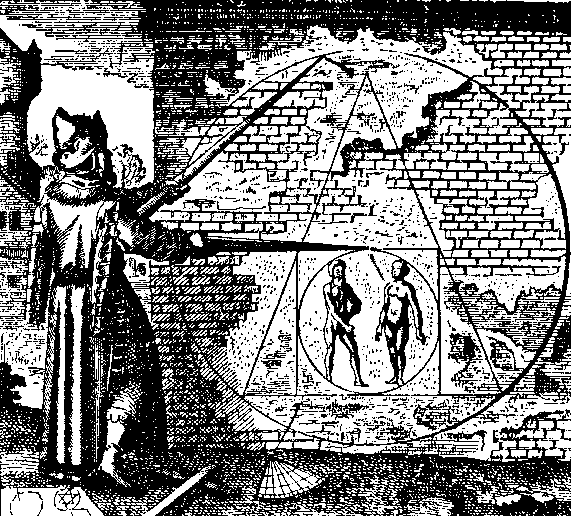
The Philosopher's Stone
It was sometimes called a medicine for the rectification of "base" or "sick" metals, and from this it was a short step to view it as a drug for the rectification of human maladies. Zosimos notes the possibility, in passing. When the objective of alchemy became human salvation, the material constitution of the elixir became less important than the incantations that accompanied its production. Synesius, the last author in the Venice-Paris manuscript, already defined alchemy as a mental operation, independent of the science of matter.
Thus, Greek alchemy came to resemble, in both theory and practice, that of China and India.
But its objectives included gold making; thus it remained fundamentally different.
Arabic Alchemy
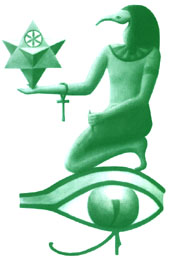
The Emerald Tablets of Thoth
(He was Hermes)
(As is Above, So is Below)
Zero Point Merge
Sacred Geometry - Golden Ratio
Reality as a Consciousness Hologram
Beginning "That which is above is like to that which is below,
and that which is below is like to that which is above,"
it is brief, theoretical, and astrological.
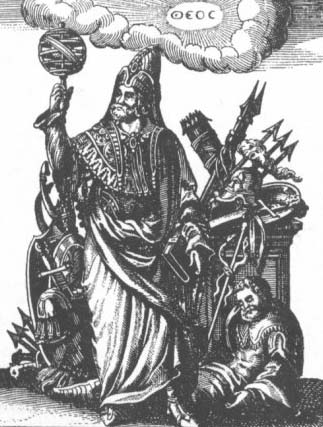
Hermes
Hermes "the thrice great" (Trismegistos) was a Greek version of the Egyptian god Thoth and the supposed founder of an astrological philosophy that is first noted in 150 BC. The Emerald Tablet, however, comes from a larger work called Book of the Secret of Creation, which exists in Latin and Arabic manuscripts and was thought by the Muslim alchemist ar-Razi to have been written during the reign of Caliph al-Ma'mun (AD 813-833), though it has been attributed to the 1st-century-AD pagan mystic Apollonius of Tyana.
Some scholars have suggested that Arabic alchemy descended from a western Asiatic school and that Greek alchemy was derived from an Egyptian school. As far as is known, the Asiatic school was not Chinese or Indian. What is known is that Arabic alchemy was associated with a specific city in Syria, Harran, which seems to have been a fountainhead of alchemical notions. And it is possible that the distillation ideology and its spokeswoman, Maria--as well as Agathodaimon--represented the alchemy of Harran, which presumably migrated to Alexandria and was incorporated into the alchemy of Zosimos.
The existing versions of the Book of the Secret of Creation have been carried back only to the 7th or 6th century but are believed by some to represent much earlier writings, although not necessarily those of Apollonius himself. He is the subject of an ancient biography that says nothing about alchemy, but neither does the Emerald Tablet nor the rest of the Book of the Secret of Creation. On the other hand, their theories of nature have an alchemical ring, and the Book mentions the characteristic materials of alchemy, including, for the first time in the West, sal ammoniac. It was clearly an important book to the Arabs, most of whose eminent philosophers mentioned alchemy, although sometimes disapprovingly.
Those who practiced it were even more interested in literal gold making than had been the Greeks. The most well-attested and probably the greatest Arabic alchemist was ar-Razi (c. 850-923/924), a Persian physician who lived in Baghdad. The most famous was Jabir ibn Hayyan, now believed to be a name applied to a collection of "underground writings" produced in Baghdad after the theological reaction against science. In any case, the Jabirian writings are very similar to those of ar-Razi.
Ar-Razi classified the materials used by the alchemist into "bodies" (the metals), stones, vitriols, boraxes, salts, and "spirits," putting into the latter those vital (and sublimable) materials, mercury, sulfur, orpiment and realgar (the arsenic sulfides), and sal ammoniac. Much is made of sal ammoniac, the reactive powers of which seem to have given Western alchemy a new lease on life. Ar-Razi and the Jabirian writers were really trying to make gold, through the catalytic action of the elixir. Both wrote much on the compounding of "strong waters," an enterprise that was ultimately to lead to the discovery of the mineral acids, but students have been no more able to find evidence of this discovery in the writings of the Arabic alchemists than in those of China and India. The Arabic strong waters were merely corrosive salt solutions.
Ar-Razi's writing represents the apogee of Arabic alchemy, so much so that students of alchemy have little evidence of its later reorientation toward mystical or quasi-religious objectives. Nor does it seem to have turned to medicine, which remained independent. But there was a tendency in Arabic medicine to give greater emphasis to mineral remedies and less to the herbs that had been the chief medicines of the earlier Greek and Arabic physicians. The result was a pharmacopoeia not of elixirs but of specific remedies that are inorganic in origin and not very different from the elixirs of ar-Razi. This new pharmacopoeia was taken to Europe by Constantine of Africa, a Baghdad-educated Muslim who died in 1087 as a Christian monk at Monte Cassino (Italy). The pharmacopoeia also appeared in Spain in the 11th century and passed from there to Latin Europe, along with the Arabic alchemical writings, which were translated into Latin in the 12th century.
Latin Alchemy
The Greek alchemy of the Venice-Paris manuscript had much less impact than the work of ar-Razi and other Arabs, which emerged among the voluminous translations made in Spain about 1150 by Gerard of Cremona. By 1250 alchemy was familiar enough to enable such encyclopaedists as Vincent of Beauvais to discuss it fairly intelligibly, and before 1300 the subject was under discussion by the English philosopher and scientist Roger Bacon and the German philosopher, scientist, and theologian Albertus Magnus.
To learn about alchemy was to learn about chemistry, for Europe had no independent word to describe the science of matter. It had been touched upon in works concerned with other forms of change--e.g., the motion of projectiles, the aging of man, and similar Aristotelian concepts. On the practical side there were also artists' recipe books; but for the first time in the works of Bacon and Albertus Magnus change was discussed in a truly chemical sense, with Bacon treating the newly translated alchemy as a general science of matter for which he had great hopes.
But the more familiar alchemy became, the more clearly it was understood that gold making was the almost exclusive objective of alchemy, and Europeans proved no more resistant to the lure of this objective than their Arabic predecessors. By 1350, alchemical tracts were pouring out of the scriptoria (monastic copying rooms), and the Europeans had even taken over the tradition of anonymity and false attribution.
One authority wrote at length about supposed disagreements between two Arabs, Iahiae Abindinon and Geber Abinhaen, who were probably two versions of the name of Jabir ibn Hayyan. The most famous Jabirian work in Europe, The Sum of Perfection, is now thought to have been an original European composition. At about this time personal reminiscences of alchemists began to appear.
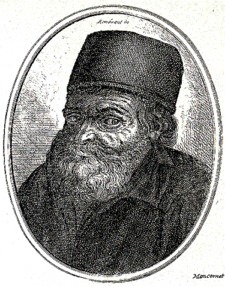
Most famous was the Paris notary Nicolas Flamel (1330-1418), who claimed that he dreamed of an occult book, subsequently found it, and succeeded in deciphering it with the aid of a Jewish scholar learned in the mystic Hebrew writings known as the Kabbala. In 1382 Flamel claimed to have succeeded in the "Great Work" (gold making); certainly he became rich and made donations to churches.
By 1300 alchemists had begun the discovery of the mineral acids, a discovery that occupied about three centuries between the first evidence of the new strong water (aqua fortis--i.e., nitric acid) and the clear differentiation of the acids into three kinds: nitric, hydrochloric, and sulfuric. These three centuries saw prodigious efforts in European alchemy, for these spontaneously reactive and highly corrosive substances opened a whole new world of research. And yet, it was of little profit to chemistry, for the experiments were inhibited by the old objectives of separating the base metals into their "elements," concocting elixirs, and other traditional procedures.
The "water of life" (aqua vitae; i.e., alcohol) was probably discovered a little earlier than nitric acid, and some physicians and a few alchemists turned to the elixir of life as an objective. John of Rupescissa, a Catalonian monk who wrote c. 1350, prescribed virtually the same elixirs for metal ennoblement and for the preservation of health. His successors multiplied elixirs, which lost their uniqueness and finally simply became new medicines, often for specific ailments.
Medical chemistry may have been conceived under Islam, but it was born in Europe. It only awaited christening by its great publicist, Paracelsus (1493-1541), who was the sworn enemy of the malpractices of 16th-century medicine and a vigorous advocate of "folk" and "chemical" remedies. By the end of the 16th century, medicine was divided into warring camps of Paracelsians and anti-Paracelsians, and the alchemists began to move en masse into pharmacy.
Paracelsian pharmacy was to lead, by a devious path, to modern chemistry, but gold making still persisted, though methods sometimes differed. SalomonTrismosin, purported author of the Splendor solis, or "Splendour of the Sun" (published 1598), engaged in extensive visits to alchemical adepts (a common practice) and claimed success through "kabbalistic and magical books in the Egyptian language." The impression given is that many had the secret of gold making but that most of them had acquired it from someone else and not from personal experimentation. Illustrations, often heavily symbolic, became particularly important, those of Splendor solis being far more complex than the text but clearly exercising a greater appeal, even to modern students.
Modern Alchemy
This was not altogether to the alchemist's advantage. In 1595 Edward Kelley, an English alchemist and companion of the famous astrologer, alchemist, and mathematician John Dee, lost his life in an attempt to escape after imprisonment by Rudolf II, and in 1603 the elector of Saxony, Christian II, imprisoned and tortured the Scotsman Alexander Seton, who had been traveling about Europe performing well-publicized transmutations.
The situation was complicated by the fact that some alchemists were turning from gold making not to medicine but to a quasi-religious alchemy reminiscent of the Greek Synesius. Rudolf II made the German alchemist Michael Maier a count and his private secretary, although Maier's mystical and allegorical writings were, in the words of a modern authority, "distinguished for the extraordinary obscurity of his style" and made no claim to gold making. Neither did the German alchemist Heinrich Khunrath (c. 1560-1601), whose works have long been esteemed for their illustrations, make such a claim.
Conventional attempts at gold making were not dead, but by the 18th century alchemy had turned conclusively to religious aims. The rise of modern chemistry engendered not only general skepticism as to the possibility of making gold but also widespread dissatisfaction with the objectives of modern science, which were viewed as too limited.
Unlike the scientists of the Middle Ages and Renaissance, the successors of Newton and the great 18th-century French chemist Antoine-Laurent Lavoisier limited their objectives in a way that amounted to a renunciation of what many had considered the most important question of science, the relation of man to the cosmos. Those who persisted in asking these questions came to feel an affinity with the alchemists and sought their answers in the texts of "esoteric," or spiritual, alchemy (as distinct from the "exoteric" alchemy of the gold makers), with its roots in Synesius and other late Greek alchemists of the Venice-Paris manuscript.
This spiritual alchemy, or Hermetism, as its practitioners often prefer to call it, was popularly associated with the supposititious Rosicrucian brotherhood, whose so-called Manifestoes (author unknown; popularly ascribed to the German theologian Johann Valentin AndreŠ) had appeared in Germany in the early 17th century and had attracted the favorable attention not only of such reforming alchemists as Michael Maier but also of many prominent philosophers who were disquieted by the mechanistic character of the new science.
In modern times alchemy has become a focal point for various kinds of mysticism. The old alchemical literature continues to be scrutinized for evidence, because alchemical doctrine is claimed to have on more than one occasion come into the possession of man but always again been lost. Nor is its association with chemistry considered accidental.
In the words of the famous 19th-century English spiritual alchemist Mary Anne Atwood,
- Alchemy is an universal art of vital chemistry which by fermenting the human spirit
purifies and finally dissolves it. . . . Alchemy is philosophy; it is the philosophy, the
finding of the Sophia in the mind.
Assessments of Alchemy
It has been said that alchemy can be credited with the development of the science of chemistry, a keystone of modern science. During the alchemical period the repertoire of known substances was enlarged (e.g., by the addition of sal ammoniac and saltpetre), alcohol and the mineral acids were discovered, and the basis was laid from which modern chemistry was to rise.
Historians of chemistry have been tempted to credit alchemy with laying this base while at the same time regarding alchemy as mostly "wrong." It is far from clear, however, that the basis of chemistry was in fact laid by alchemy rather than medicine. During the crucial period of Arabic and early Latin alchemy, it appears that innovation owed more to nascent medical chemistry than to alchemy.
But those who explore the history of the science of matter, where matter is considered on a wider basis than the modern chemist understands the term, may find alchemy more rewarding.
Numerous Hermetic writers of previous centuries claimed that the aims of their art could yet be achieved--indeed, that the true knowledge had been repeatedly found and repeatedly lost. This is a matter of judgment, but it can certainly be said that the modern chemist has not attained the goal sought by the alchemist. For those who are wedded to scientific chemistry, alchemy can have no further interest. For those who seek the wider goal, which was also that of the natural philosopher before the advent of "mechanical," "Newtonian," or "modern" science, the search is still on.
Interpretations
Other historians of chemistry have attempted to differentiate the good from the bad in alchemy, citing as good the discovery of new substances and processes and the invention of new apparatus. Some of this was certainly accomplished by alchemists (e.g., Maria), but most of it is more justifiably ascribed to early pharmacists.
Scholars generally agree that alchemy had something to do with chemistry, but the modern Hermetic holds that chemistry was the handmaiden of alchemy, not the reverse. From this point of view the development of modern chemistry involved the abandonment of the true goal of the art.
Finally, a new interpretation was offered in the 1920s by the Swiss psychoanalyst Carl Jung, who, following the earlier work of the Austrian psychologist Herbert Silberer, judged alchemical literature to be explicable in psychological terms. Noticing the similarities between alchemical literature, particularly in its reliance on bizarre symbolic illustrations, and the dreams and fantasies of his patients, Jung viewed them as manifestations of a "collective unconscious" (inherited disposition). Jung's theory, still largely undeveloped, remains a challenge rather than an explanation.
 \
\
Alchemy was the precursor to modern chemistry. Alchemists were therefore chemists, pharmacologists, and physicians. Alchemy flourished in the Islamic world during the Middle Ages, and then in Europe from the 13th to the 18th centuries. We know the names of some of the better known alchemists thanks to the numerous alchemical manuscript and books that survived. It must be kept in mind however that the vast majority of ancient alchemists, being self-taught, and more bent on experimenting than writing, have left no trace in history.
Middle East
Geber
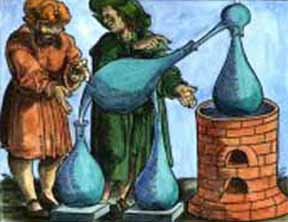
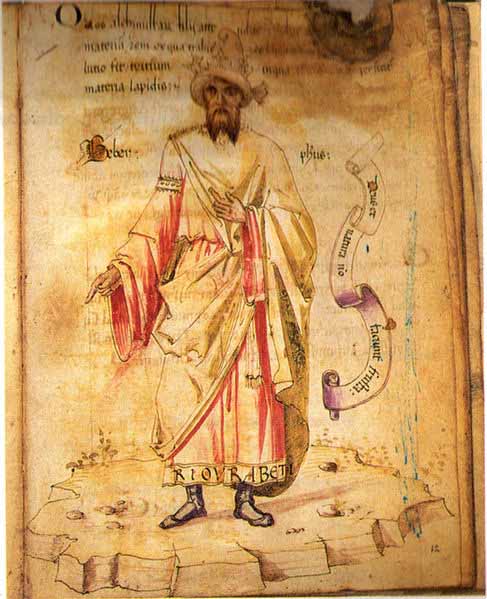
Geber, aka Abu Musa Jabir ibn Hayyan, was a prominent Islamic alchemist, pharmacist, philosopher, astronomer, and physicist. He has also been referred to as "the father of Arab chemistry" by Europeans. His ethnic background is not clear; although most sources state he was an Arab, some describe him as Persian.
Jabir was born in Tus, Khorasan, in Iran, which was at the time ruled by the Umayyad Caliphate; the date of his birth is disputed, but most sources give 721 or 722. He was the son of Hayyan al-Azdi, a pharmacist of the Arabian Azd tribe who emigrated from Yemen to Kufa (in present-day Iraq) during the Umayyad Caliphate.
Hayyan had supported the revolting Abbasids against the Umayyads, and was sent by them to the province of Khorasan (in present Iran) to gather support for their cause. He was eventually caught by the Ummayads and executed. His family fled back to Yemen, where Jabir grew up and studied the Koran, mathematics and other subjects under a scholar named Harbi al-Himyari.
After the Abbasids took power, Jabir went back to Kufa, where he spent most of his career. Jabir's father's profession may have contributed greatly to his interest to chemistry.
In Kufa he became a student of the celebrated Islamic teacher and sixth Imam Ja'far al-Sadiq.
It is said that he also studied with the Umayyad prince Khalid Ibn Yazid. He began his career
practising medicine, under the patronage of the Barmakid Vizir of Caliph Haroun al-Rashid.
It is known that in 776 he was engaged in alchemy in Kufa.His connections to the Barmakid cost him dearly in the end. When that family fell from grace in 803, Jabir was placed under house arrest in Kufa, where he remained until his death.
The date of his death is given as c.815 by the Encyclop¾dia Britannica, but as 808 by other sources.
Contributions to Chemistry
He also paved the way for most of the later Islamic alchemists, including al-Razi, al-Tughrai and al-Iraqi, who lived in the 9th, 12th and 13th centuries respectively. His books strongly influenced the medieval European alchemists and justified their search for the philosopher's stone.In spite of his leanings toward mysticism (he was considered a Sufi) and superstition, he more clearly recognised and proclaimed the importance of experimentation.
"The first essential in chemistry", he declared, "is that you should perform practical work and conduct experiments, for he who performs not practical work nor makes experiments will never attain the least degree of mastery."Jabir is also credited with the invention and development of several chemical instruments that are still used today, such as the alembic, which made distillation easy, safe, and efficient.
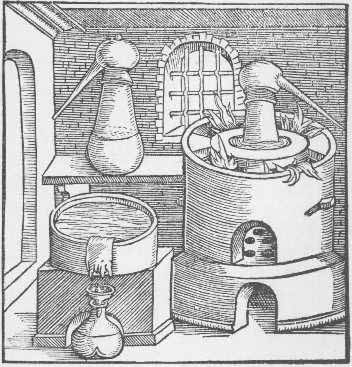
Distillation Process
Jabir applied his chemical knowledge to the improvement of many manufacturing processes, such as making steel and other metals, preventing rust, engraving gold, dyeing and waterproofing cloth, tanning leather, and the chemical analysis of pigments and other substances. He developed the use of manganese dioxide in glassmaking, to counteract the green tinge produced by iron - a process that is still used today. He noted that boiling wine released a flammable vapor, thus paving the way to Al-Razi's discovery of ethanol.
The seeds of the modern classification of elements into metals and non-metals could be seen in his chemical nomenclature. He proposed three categories: "spirits" which vaporise on heating, like camphor, arsenic, and ammonium chloride; "metals", like gold, silver, lead, copper, and iron; and "stones" that can be converted into powders.In the Middle Ages, Jabir's treatises on chemistry were translated into Latin and became standard texts for European alchemists.
These include the Kitab al-Kimya (titled Book of the Composition of Alchemy in Europe), translated by Robert of Chester (1144); and the Kitab al-Sab'een by Gerard of Cremona (before 1187). Marcelin Berthelot translated some of his books under the fanciful titles Book of the Kingdom, Book of the Balances, and Book of Eastern Mercury.
Several technical terms introduced by Jabir, such as alkali, have found their way into various European languages and have become part of scientific vocabulary.
Contributions to Alchemy
Jabir's alchemical investigations revolved around the ultimate goal of takwin - the artificial creation of life. Alchemy had a long relationship with Shi'ite mysticism; according to the first Imam, Ali ibn Abi Talib, "alchemy is the sister of prophecy".
Jabir's interest in alchemy was probably inspired by his teacher Ja'far al-Sadiq, and he was himself called "the Sufi", indicating that he followed the ascetic form of mysticism within Islam.In his writings, Jabir pays tribute to Egyptian and Greek alchemists Hermes Trismegistus, Agathodaimon, Pythagoras, and Socrates.
He emphasises the long history of alchemy, "whose origin is Arius ... the first man who applied the first experiment on the [philosopher's] stone... and he declares that man possesses the ability to imitate the workings of Nature" (Nasr, Seyyed Hossein, Science and Civilization of Islam).
Jabir states in his Book of Stones (4:12) that "The purpose is to baffle and lead into error everyone except those whom God loves and provides for". His works seem to have been deliberately written in highly esoteric code, so that only those who had been initiated into his alchemical school could understand them. It is therefore difficult at best for the modern reader to discern which aspects of Jabir's work are to be read as symbols (and what those symbols mean), and what is to be taken literally. Because his works rarely made overt sense, the term gibberish is believed to have originally referred to his writings (Hauck, p. 19).
Jabir's alchemical investigations were theoretically grounded in an elaborate numerology related to Pythagorean and Neoplatonic systems. The nature and properties of elements was defined through numeric values assigned the Arabic consonants present in their name, ultimately culminating in the number 17.
To Aristotelian physics, Jabir added the four properties of hotness, coldness, dryness, and moistness (Burkhardt, p. 29). Each Aristotelian element was characterised by these qualities: Fire was both hot and dry, earth cold and dry, water cold and moist, and air hot and moist. This came from the elementary qualities which are theoretical in nature plus substance. In metals two of these qualities were interior and two were exterior. For example, lead was cold and dry and gold was hot and moist.
Thus, Jabir theorised, by rearranging the qualities of one metal, based on their sulfur/mercury content, a different metal would result. (Burckhardt, p. 29) This theory appears to have originated the search for al-iksir, the elusive elixir that would make this transformation possible - which in European alchemy became known as the philosopher's stone.
Jabir also made important contributions to medicine, astronomy, and other sciences. Only a few of his books have been edited and published, and fewer still are available in translation. The Geber crater, located on the Moon, is named after him.
Writings by Jabir
- The 112 Books dedicated to the Barmakids, viziers of Caliph Harun al-Rashid. This group includes the Arabic version of the Emerald Tablet, an ancient work that is the foundation of the Hermetic or "spiritual" alchemy. In the Middle Ages it was translated into Latin (Tabula Smaragdina) and widely diffused among European alchemists.
- The Seventy Books, most of which were translated into Latin during the Middle Ages. This group includes the Kitab al-Zuhra ("Book of Venus") and the Kitab Al-Ahjar ("Book of Stones").
- The Ten Books on Rectification, containing descriptions of "alchemists" such as Pythagoras, Socrates, Plato and Aristotle.
- The Books on Balance; this group includes his most famous 'Theory of the balance in Nature'.Some scholars suspect that some of these works were not written by Jabir himself, but are instead commentaries and additions by his followers. In any case, they all can be considered works of the 'Jabir' school of alchemy.
Mohammad Ibn Zakariya al-Razi
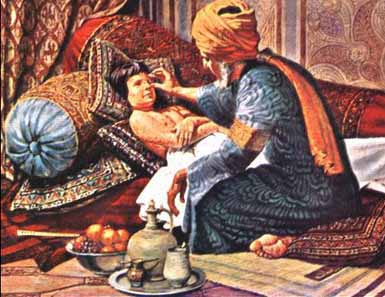
Muhammad ibn Zakariya Razi known as Rhazes or Rasis after medieval Latinists, (August 26, 865-925) was a Persian polymath, a prominent figure in Islamic Golden Age, physician, alchemist and chemist, philosopher, and scholar
Numerous ÒfirstsÓ in medical research, clinical care, and chemistry are attributed to him, including being the first to differentiate smallpox from measles, and the discovery of numerous compounds and chemicals including kerosene, among others. Edward Granville Browne considers him as "probably the greatest and most original of all the physicians, and one of the most prolific as an author".
Razi made fundamental and enduring contributions to the fields of medicine, alchemy, music, and philosophy, recorded in over 200 books and articles in various fields of science. He was well-versed in Persian, Greek and Indian medical knowledge and made numerous advances in medicine through own observations and discoveries.
Educated in music, mathematics, philosophy, and metaphysics, he chose medicine as his professional field. As a physician, he was an early proponent of experimental medicine and has been described as the father of pediatrics. He was also a pioneer of ophthalmology. He was among the first to use Humoralism to distinguish one contagious disease from another. In particular, Razi was the first physician to distinguish smallpox and measles through his clinical characterization of the two diseases. He became chief physician of Rey and Baghdad hospitals.
As an alchemist, Razi is known for his study of sulfuric acid. He traveled extensively, mostly in Persia. As a teacher in medicine, he attracted students of all disciplines and was said to be compassionate and devoted to the service of his patients, whether rich or poor.
Life and Background
There is a difference of opinion as to whether he was an Arab from Kufa who lived in Khurasan or a Persian from Khorasan who later went to Kufa or whether he was, as some have suggested, of Syrian origin and later lived in Persia and Iraq. His ethnic background is not clear,and sources reference him as an Arab or a Persian.
In some sources, he is reported to have been the son of Hayyan al-Azdi, a pharmacist of the Arabian Azd tribe who emigrated from Yemen to Kufa (in present-day Iraq) during the Umayyad Caliphate. while Henry Corbin believes Geber seems to have been a client of the 'Azd tribe. Jabir became an alchemist at the court of Caliph Harun al-Rashid, for whom he wrote the Kitab al-Zuhra ("The Book of Venus", on "the noble art of alchemy"). Hayyan had supported the Abbasid revolt against the Umayyads, and was sent by them to the province of Khorasan (present day Afghanistan and Iran) to gather support for their cause. He was eventually caught by the Ummayads and executed. His family fled to Yemen, where Jabir grew up and studied the Quran, mathematics and other subjects.Jabir's father's profession may have contributed greatly to his interest in alchemy.
After the Abbasids took power, Jabir went back to Kufa. He began his career practicing medicine, under the patronage of a Vizir (from the noble Persian family Barmakids) of Caliph Harun al-Rashid. His connections to the Barmakid cost him dearly in the end. When that family fell from grace in 803, Jabir was placed under house arrest in Kufa, where he remained until his death.
It has been asserted that Jabir was a student of the sixth Imam Ja'far al-Sadiq and Harbi al-Himyari, however other scholars have questioned this theory.
Razi wrote 184 books and articles, in several fields of science. His books and articles are named by Ibn Abi Asi'boed.
Ibn an-Nadim identifies five areas in which Razi distinguished himself:
- 1. Razi was recognized as the best physician of his time who had fully absorbed Greek
medical learning.
2. He traveled in many lands. His repeated visits to Baghdad and his services to many princes and rulers are known from many sources.
3. He was a medical educator who attracted many students, both beginners and advanced.
4. He was compassionate, kind, upright, and devoted to the service of his patients whether rich or poor.
5. He was a prolific reader and writer and authored many books.
Avicenna
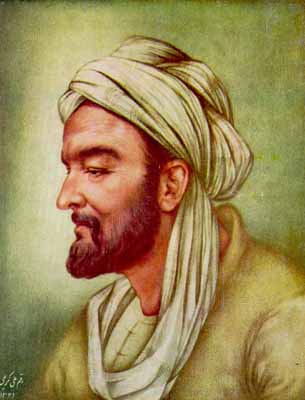
Avicenna, aka Abu Ali al-Husain ibn Abdallah ibn Sina, was a Persian polymath, physician, philosopher, and scientist who wrote almost 450 treatises on a wide range of subjects, of which around 240 have survived. Many of his woorks concentrated on philosophy and medicine. He is considered by many to be "the father of modern medicine." In particular, 150 of his surviving treatises concentrate on philosophy and 40 of them concentrate on medicine.
His most famous works are The Book of Healing, a vast philosophical and scientific encyclopedia, and The Canon of Medicine, which was a standard medical text at many medieval universities. The Canon of Medicine was used as a text-book in the universities of Montpellier and Leuven as late as 1650. Ibn Sina's Canon of Medicine provides a complete system of medicine according to the principles of Galen (and Hippocrates).
His corpus also includes writing on philosophy, astronomy, alchemy, geology, psychology, Islamic theology, logic, mathematics, physics, as well as poetry. He is regarded as the most famous and influential polymath of the Islamic Golden Age.
Avicenna created an extensive corpus of works during what is commonly known as Islam's Golden Age, in which the translations of Greco-Roman, Persian, and Indian texts were studied extensively. Greco-Roman (Mid- and Neo-Platonic, and Aristotelian) texts by the Kindi school were commented, redacted and developed substantially by Islamic intellectuals, who also built upon Persian and Indian mathematical systems, astronomy, algebra, trigonometry and medicine. The Samanid dynasty in the eastern part of Persia, Greater Khorasan and Central Asia as well as the Buyid dynasty in the western part of Persia and Iraq provided a thriving atmosphere for scholarly and cultural development. Under the Samanids, Bukhara rivaled Baghdad as a cultural capital of the Islamic world.
The study of the Quran and the Hadith thrived in such a scholarly atmosphere. Philosophy, Fiqh and theology (kalaam) were further developed, most noticeably by Avicenna and his opponents. Al-Razi and Al-Farabi had provided methodology and knowledge in medicine and philosophy. Avicenna had access to the great libraries of Balkh, Khwarezm, Gorgan, Rey, Isfahan and Hamadan. Various texts (such as the 'Ahd with Bahmanyar) show that he debated philosophical points with the greatest scholars of the time. Aruzi Samarqandi describes how before Avicenna left Khwarezm he had met Abu Rayhan Biruni (a famous scientist and astronomer), Abu Nasr Iraqi (a renowned mathematician), Abu Sahl Masihi (a respected philosopher) and Abu al-Khayr Khammar (a great physician).
Early Life
Avicenna was born c. 980 near Bukhara (in present-day Uzbekistan), the capital of the Samanids, a Persian dynasty in Central Asia and Greater Khorasan. His mother, named Setareh, was from Bukhara; his father, Abdullah, was a respected Ismaili scholar from Balkh, an important town of the Samanid Empire, in what is today Balkh Province, Afghanistan. His father was at the time of his son's birth the governor in one of the Samanid Nuh ibn Mansur's estates. He had his son very carefully educated at Bukhara. Ibn Sina's independent thought was served by an extraordinary intelligence and memory, which allowed him to overtake his teachers at the age of fourteen. As he said in his autobiography, there was nothing that he had not learned when he reached eighteen.
A number of different theories have been proposed regarding Avicenna's madhab. Medieval historian Zahir al-din al-Bayhaqi (d. 1169) considered Avicenna to be a follower of the Brethren of Purity. On the other hands, Shia faqih Nurullah Shushtari and Seyyed Hossein Nasr, in addition to Henry Corbin, have maintained that he was most likely a Twelver Shia. More recently, however, Dimitri Gutas demonstrated that Avicenna was a Sunni Hanafi. Similar disagreements exist on the background of Avicenna's family, whereas some writers considered them Sunni, more recent writers thought they were Shia.
According to his autobiography, Avicenna had memorized the entire Qur'an by the age of 10. He learned Indian arithmetic from an Indian greengrocer, and he began to learn more from a wandering scholar who gained a livelihood by curing the sick and teaching the young. He also studied Fiqh (Islamic jurisprudence) under the Hanafi scholar Ismail al-Zahid.
As a teenager, he was greatly troubled by the Metaphysics of Aristotle, which he could not understand until he read al-Farabi's commentary on the work. For the next year and a half, he studied philosophy, in which he encountered greater obstacles. In such moments of baffled inquiry, he would leave his books, perform the requisite ablutions (wudu), then go to the mosque, and continue in prayer (salah) till light broke on his difficulties.
Deep into the night, he would continue his studies, and even in his dreams problems would pursue him and work out their solution. Forty times, it is said, he read through the Metaphysics of Aristotle, till the words were imprinted on his memory; but their meaning was hopelessly obscure, until one day they found illumination, from the little commentary by Farabi, which he bought at a bookstall for the small sum of three dirhams. So great was his joy at the discovery, made with the help of a work from which he had expected only mystery, that he hastened to return thanks to God, and bestowed alms upon the poor.
He turned to medicine at 16, and not only learned medical theory, but also by gratuitous attendance of the sick had, according to his own account, discovered new methods of treatment. The teenager achieved full status as a qualified physician at age 18 and found that "Medicine is no hard and thorny science, like mathematics and metaphysics, so I soon made great progress; I became an excellent doctor and began to treat patients, using approved remedies." The youthful physician's fame spread quickly, and he treated many patients without asking for payment.
Adulthood
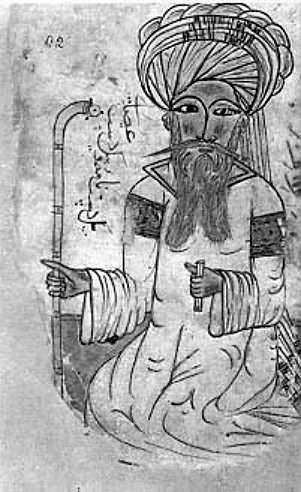
Avecenna 1271
When Ibn Sina was 22 years old, he lost his father. The Samanid dynasty came to its end in December 1004. Ibn Sina seems to have declined the offers of Mahmud of Ghazni, and proceeded westwards to Urgench in modern Turkmenistan, where the vizier, regarded as a friend of scholars, gave him a small monthly stipend. The pay was small, however, so Ibn Sina wandered from place to place through the districts of Nishapur and Merv to the borders of Khorasan, seeking an opening for his talents.
Qabus, the generous ruler of Dailam and central Persia, himself a poet and a scholar, with whom Ibn Sina had expected to find asylum, was on about that date (1012) starved to death by his troops who had revolted. Ibn Sina himself was at this time stricken by a severe illness. Finally, at Gorgan, near the Caspian Sea, Ibn Sina met with a friend, who bought a dwelling near his own house in which Ibn Sina lectured on logic and astronomy. Several of Ibn Sina's treatises were written for this patron; and the commencement of his Canon of Medicine also dates from his stay in Hyrcania.
Ibn Sina subsequently settled at Rai, in the vicinity of modern Tehran, (present day capital of Iran), the home town of Rhazes; where Majd Addaula, a son of the last Buwayhid emir, was nominal ruler under the regency of his mother (Seyyedeh Khatun). About thirty of Ibn Sina's shorter works are said to have been composed in Rai. Constant feuds which raged between the regent and her second son, Shams al-Daula, however, compelled the scholar to quit the place. After a brief sojourn at Qazvin he passed southwards to Hamadan where Shams al-Daula, another Buwayhid emir, had established himself.
At first, Ibn Sina entered into the service of a high-born lady; but the emir, hearing of his arrival, called him in as medical attendant, and sent him back with presents to his dwelling. Ibn Sina was even raised to the office of vizier. The emir decreed that he should be banished from the country.
Ibn Sina, however, remained hidden for forty days in sheikh Ahmed Fadhel's house, until a fresh attack of illness induced the emir to restore him to his post. Even during this perturbed time, Ibn Sina persevered with his studies and teaching. Every evening, extracts from his great works, the Canon and the Sanatio, were dictated and explained to his pupils. On the death of the emir, Ibn Sina ceased to be vizier and hid himself in the house of an apothecary, where, with intense assiduity, he continued the composition of his works.
Meanwhile, he had written to Abu Ya'far, the prefect of the dynamic city of Isfahan, offering his services. The new emir of Hamadan, hearing of this correspondence and discovering where Ibn Sina was hiding, incarcerated him in a fortress. War meanwhile continued between the rulers of Isfahan and Hamadan; in 1024 the former captured Hamadan and its towns, expelling the Tajik mercenaries. When the storm had passed, Ibn Sina returned with the emir to Hamadan, and carried on his literary labors. Later, however, accompanied by his brother, a favorite pupil, and two slaves, Ibn Sina escaped from the city in the dress of a Sufi ascetic. After a perilous journey, they reached Isfahan, receiving an honorable welcome from the prince.
Later Life and Death
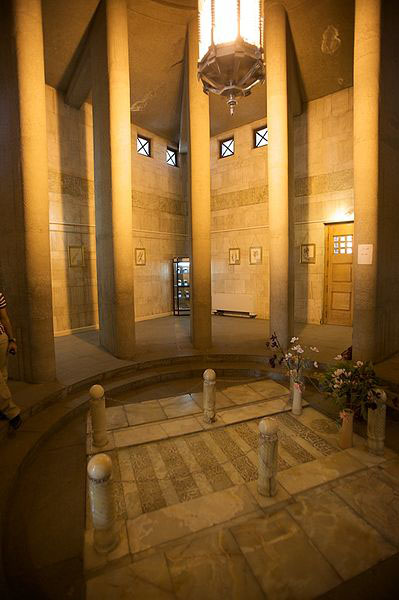
Avicenna Mausoleum
During these years he began to study literary matters and philology, instigated, it is asserted, by criticisms on his style. A severe colic, which seized him on the march of the army against Hamadan, was checked by remedies so violent that Ibn Sina could scarcely stand. On a similar occasion the disease returned; with difficulty he reached Hamadan, where, finding the disease gaining ground, he refused to keep up the regimen imposed, and resigned himself to his fate.
His friends advised him to slow down and take life moderately. He refused, however, stating that: "I prefer a short life with width to a narrow one with length". On his deathbed remorse seized him; he bestowed his goods on the poor, restored unjust gains, freed his slaves, and read through the Qur'an every three days until his death. He died in June 1037, in his fifty-eighth year, in the month of Ramadan and was buried in Hamadan, Iran.
Avicennian Philosophy
In the medieval Islamic world, due to Avicenna's successful reconciliation between Aristotelianism and Neoplatonism along with Kalam, Avicennism eventually became the leading school of Islamic philosophy by the 12th century, with Avicenna becoming a central authority on philosophy.
Avicennism was also influential in medieval Europe, particular his doctrines on the nature of the soul and his existence-essence distinction, along with the debates and censure that they raised in scholastic Europe. This was particularly the case in Paris, where Avicennism was later proscribed in 1210. Nevertheless, his psychology and theory of knowledge influenced William of Auvergne, Bishop of Paris and Albertus Magnus, while his metaphysics had an impact on the thought of Thomas Aquinas.
Metaphysical Doctrine
Following al-Farabi's lead, Avicenna initiated a full-fledged inquiry into the question of being, in which he distinguished between essence (Mahiat) and existence (Wujud). He argued that the fact of existence can not be inferred from or accounted for by the essence of existing things, and that form and matter by themselves cannot interact and originate the movement of the universe or the progressive actualization of existing things. Existence must, therefore, be due to an agent-cause that necessitates, imparts, gives, or adds existence to an essence. To do so, the cause must be an existing thing and coexist with its effect.
AvicennaÕs consideration of the essence-attributes question may be elucidated in terms of his ontological analysis of the modalities of being; namely impossibility, contingency, and necessity.
Avicenna argued that the impossible being is that which cannot exist, while the contingent in itself (mumkin bi-dhatihi) has the potentiality to be or not to be without entailing a contradiction. When actualized, the contingent becomes a Ônecessary existent due to what is other than itself' (wajib al-wujud bi-ghayrihi). Thus, contingency-in-itself is potential beingness that could eventually be actualized by an external cause other than itself.
The metaphysical structures of necessity and contingency are different. Necessary being due to itself (wajib al-wujud bi-dhatihi) is true in itself, while the contingent being is 'false in itself' and Ôtrue due to something else other than itselfÕ. The necessary is the source of its own being without borrowed existence. It is what always exists.
The Necessary exists Ôdue-to-Its-SelfÕ, and has no quiddity/essence (mahiyya) other than existence (wujud). Furthermore, It is ÔOneÕ (wahid ahad) since there cannot be more than one ÔNecessary-Existent-due-to-ItselfÕ without differentia (fasl) to distinguish them from each other. Yet, to require differentia entails that they exist Ôdue-to-themselvesÕ as well as Ôdue to what is other than themselvesÕ; and this is contradictory. However, if no differentia distinguishes them from each other, then there is no sense in which these ÔExistentsÕ are not one and the same. Avicenna adds that the 'Necessary-Existent-due-to-Itself' has no genus (jins), nor a definition (hadd), nor a counterpart (nadd), nor an opposite (did), and is detached (bari') from matter (madda), quality (kayf), quantity (kam), place (ayn), situation (wadÕ), and time (waqt).
Ibn Sina memorized the Qur'an by the age of seven, and as an adult, he wrote five treatises commenting on suras from the Qur'an. One of these texts included the Proof of Prophecies, in which he comments on several Quranic verses and holds the Qur'an in high esteem. Avicenna argued that the Islamic prophets should be considered higher than philosophers.
The thought experiment told its readers to imagine themselves created all at once while suspended in the air, isolated from all sensations, which includes no sensory contact with even their own bodies. He argued that, in this scenario, one would still have self-consciousness.
Because it is conceivable that a person, suspended in air while cut off from sense experience, would still be capable of determining his own existence, the thought experiment points to the conclusions that the soul is a perfection, independent of the body, and an immaterial substance. The conceivability of this "Floating Man" indicates that the soul is perceived intellectually, which entails the soulÕs separateness from the body.
Avicenna referred to the living human intelligence, particularly the active intellect, which he believed to be the hypostasis by which God communicates truth to the human mind and imparts order and intelligibility to nature. However, Avicenna posited the brain as the place where reason interacts with sensation. Sensation prepares the soul to receive rational concepts from the universal Agent Intellect.
The first knowledge of the flying person would be "I am," affirming his or her essence. That essence could not be the body, obviously, as the flying person has no sensation. Thus, the knowledge that "I am" is the core of a human being: the soul exists and is self-aware. Avicenna thus concluded that the idea of the self is not logically dependent on any physical thing, and that the soul should not be seen in relative terms, but as a primary given, a substance. The body is unnecessary; in relation to it, the soul is its perfection. In itself, the soul is an immaterial substance.
Legacy
George Sarton, the author of The History of Science, described Ibn Sina as "one of the greatest thinkers and medical scholars in history" and called him "the most famous scientist of Islam and one of the most famous of all races, places, and times." He was one of the Islamic world's leading writers in the field of medicine, and similarly to earlier Islamic writers he followed the approach of Galen (and Hippocrates as transmitted through Galen).
Along with Rhazes, Abulcasis, Ibn al-Nafis, and al-Ibadi, Ibn Sina is considered an important compiler of early Muslim medicine. He is remembered in the Western history of medicine as a major historical figure who made important contributions to medicine and the European Renaissance. His medical texts were unusual in that where controversy existed between Galen and Aristotle's views on medical matters (such as anatomy), he preferred to side with Aristotle, where necessary updating Aristotle's position to take into account post-Aristotilian advances in anatomical knowledge.
Aristotle's dominant intellectual influence among medieval European scholars meant that Avicenna's linking of Galen's medical writings with Aristotle's philosophical writings in the Canon of Medicine (along with its comprehensive and logical organization of knowledge) significantly increased Avicenna's importance in medieval Europe in comparison to other Islamic writers on medicine. His influence following translation of the Canon was such that from the early fourteenth to the mid-sixteenth centuries he was ranked with Hippocrates and Galen as one of the acknowledged authorities, princeps medicorum (prince of physicians).
In Iran, he is considered a national icon, and is often regarded as one of the greatest Persians to have ever lived. Many portraits and statues remain in Iran today. An impressive monument to the life and works of the man who is known as the 'doctor of doctors' still stands outside the Bukhara museum and his portrait hangs in the Hall of the Avicenna Faculty of Medicine in the University of Paris. There is also a crater on the Moon named Avicenna and a plant genus Avicennia.
Bu-Ali Sina University in Hamadan (Iran), the ibn Sina Tajik State Medical University in Dushanbe (The capital of the Republic of Tajikistan), Ibn Sina Academy of Medieval Medicine and Sciences at Aligarh, India, Avicenna School in Karachi and Avicenna Medical College in Lahore Pakistan, Ibne Sina Balkh Medical School in his native province of Balkh in Afghanistan, Ibni Sina Faculty Of Medicine of Ankara University Ankara, Turkey and Ibn Sina Integrated School in Marawi City (Philippines) are all named in his honor.
In 1980, the former Soviet Union, which then ruled his birthplace Bukhara, celebrated the thousandth anniversary of Avicenna's birth by circulating various commemorative stamps with artistic illustrations, and by erecting a bust of Avicenna based on anthropological research by Soviet scholars. Near his birthplace in Qishlak Afshona, some 25 km (16 mi). north of Bukhara, a training college for medical staff has been named for him. On the grounds is a museum dedicated to his life, times and work.
In March 2008, it was announced that Avicenna's name would be used for new Directories of education institutions for health care professionals, worldwide. The Avicenna Directories will list universities and schools where doctors, public health practitioners, pharmacists and others, are educated. The project team stated "Why Avicenna? Avicenna ... was ... noted for his synthesis of knowledge from both east and west. He has had a lasting influence on the development of medicine and health sciences. The use of AvicennaÕs name symbolizes the worldwide partnership that is needed for the promotion of health services of high quality."
Works
Ibn Sina wrote at least one treatise on alchemy, but several others have been falsely attributed to him. His book on animals was translated by Michael Scot. His Logic, Metaphysics, Physics, and De Caelo, are treatises giving a synoptic view of Aristotelian doctrine, though the Metaphysics demonstrates a significant departure from the brand of Neoplatonism known as Aristotelianism in Ibn Sina's world; Arabic philosophers have hinted at the idea that Ibn Sina was attempting to "re-Aristotelianise" Muslim philosophy in its entirety, unlike his predecessors, who accepted the conflation of Platonic, Aristotelian, Neo- and Middle-Platonic works transmitted into the Muslim world.
The Logic and Metaphysics have been extensively reprinted, the latter, e.g., at Venice in 1493, 1495, and 1546. Some of his shorter essays on medicine, logic, etc., take a poetical form (the poem on logic was published by Schmoelders in 1836). Two encyclopedic treatises, dealing with philosophy, are often mentioned. The larger, Al-Shifa' (Sanatio), exists nearly complete in manuscript in the Bodleian Library and elsewhere; part of it on the De Anima appeared at Pavia (1490) as the Liber Sextus Naturalium, and the long account of Ibn Sina's philosophy given by Muhammad al-Shahrastani seems to be mainly an analysis, and in many places a reproduction, of the Al-Shifa'. A shorter form of the work is known as the An-najat (Liberatio). The Latin editions of part of these works have been modified by the corrections which the monastic editors confess that they applied.
Classical and Roman Empire
Albertus Magnus

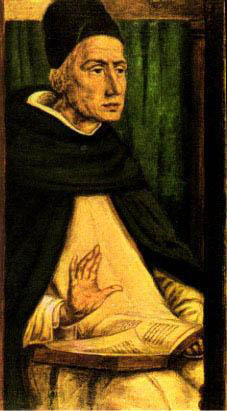
Albertus Magnus also known as Albert the Great and Albert of Cologne, is a Catholic saint. He was a German Dominican friar and a bishop who achieved fame for his comprehensive knowledge of and advocacy for the peaceful coexistence of science and religion. Those such as James A. Weisheipl and Joachim R. Soder have referred to him as the greatest German philosopher and theologian of the Middle Ages, an opinion supported by contemporaries such as Roger Bacon. The Catholic Church honours him as a Doctor of the Church, one of only 34 persons with that honor.
Albertus was born sometime between 1193 and 1206 to the Count of Bollstadt in Lauingen in Bavaria. Contemporaries such as Roger Bacon applied the term "Magnus" to Albertus during his own lifetime, referring to his immense reputation as a scholar and philosopher.
Albertus was educated principally at Padua, where he received instruction in Aristotle's writings. A late account by Rudolph de Novamagia refers to Albertus' encounter with the Blessed Virgin Mary, who convinced him to enter Holy Orders. In 1223 (or 1221) he became a member of the Dominican Order, against the wishes of his family, and studied theology at Bologna and elsewhere. Selected to fill the position of lecturer at Cologne, Germany, where the Dominicans had a house, he taught for several years there, at Regensburg, Freiburg, Strasbourg and Hildesheim. In 1245 he went to Paris, received his doctorate and taught for some time as a master of theology with great success. During this time Thomas Aquinas began to study under Albertus.
Albertus was the first to comment on virtually all of the writings of Aristotle, thus making them accessible to wider academic debate. The study of Aristotle brought him to study and comment on the teachings of Muslim academics, notably Avicenna and Averroes, and this would bring him in the heart of academic debate. He was ahead of his time in his attitude towards science.
Two aspects of this attitude deserve to be mentioned:
-
1) he did not only study science from books, as other academics did in
his day, but actually observed and experimented with nature (the rumors
starting by those who did not understand this are probably at the source
of Albert's supposed connections with alchemy and witchcraft),
2) he took from Aristotle the view that scientific method had to be
appropriate to the objects of the scientific discipline at hand (in
discussions with Roger Bacon, who, like many 20th century academics,
thought that all science should be based on mathematics).
In 1260 Pope Alexander IV made him Bishop of Regensburg, an office from which he resigned after three years. During the exercise of his duties he enhanced his reputation for humility by refusing to ride a horse - in accord with the dictates of the Dominican order - instead walking back and forth across his huge diocese. This earned him the affectionate sobriquet, "boots the bishop," from his parishioners.
After his stint as bishop, he spent the remainder of his life partly in retirement in the various houses of his order, yet often preaching throughout southern Germany. In 1270 he preached the eighth Crusade in Austria. After this, he was especially known for acting as a mediator between conflicting parties (In Cologne he is not only known for being the founder of Germany's oldest university there, but also for "the big verdict" (der Grose Schied) of 1258, which brought an end to the conflict between the citizens of Cologne and the archbishop. Among the last of his labors was the defense of the orthodoxy of his former pupil, Thomas Aquinas, whose death in 1274 grieved Albertus (the story that he travelled to Paris in person to defend the teachings of Aquinas can not be confirmed).
Roman sarcophagus containing the relics of Albertus Magnus in the crypt of St. Andreas church in Cologne, Germany After suffering a collapse of health in 1278, he died on November 15, 1280, in Cologne, Germany. Since November 15, 1954, his relics are in a Roman sarcophagus in the crypt of the Dominican St. Andreas church in Cologne.
Albertus is frequently mentioned by Dante, who made his doctrine of free will the basis of his ethical system. In his Divine Comedy, Dante places Albertus with his pupil Thomas Aquinas among the great lovers of wisdom (Spiriti Sapienti) in the Heaven of the Sun. Albertus is also mentioned, along with Agrippa and Paracelsus, in Mary Shelley's Frankenstein, in which his writings influence a young Victor Frankenstein.
Albertus was beatified in 1622. He was canonized and proclaimed a Doctor of the Church in 1931 by Pope Pius XI and patron saint of the sciences. St Albert's feast day is celebrated on November 15. According to Joan Carroll Cruz, is body is incorrupt.
Albertus' writings collected in 1899 went to thirty-eight volumes. These displayed his prolific habits and literally encyclopedic knowledge of topics such as logic, theology, botany, geography, astronomy, astrology, mineralogy, chemistry, zoology, physiology, phrenology and others; all of which were the result of logic and observation. He was perhaps the most well-read author of his time. He digested, interpreted and systematized the whole of Aristotle's works, gleaned from the Latin translations and notes of the Arabian commentators, in accordance with Church doctrine. Most modern knowledge of Aristotle was preserved and presented by Albertus.
Albertus' activity, however, was more philosophical than theological (see Scholasticism). The philosophical works, occupying the first six and the last of the twenty-one volumes, are generally divided according to the Aristotelian scheme of the sciences, and consist of interpretations and condensations of Aristotle's relative works, with supplementary discussions upon contemporary topics, and occasional divergences from the opinions of the master.
His principal theological works are a commentary in three volumes on the Books of the Sentences of Peter Lombard (Magister Sententiarum), and the Summa Theologiae in two volumes. The latter is in substance a more didactic repetition of the former.
Natural Philosopher
An exception to this general tendency is his Latin treatise "De falconibus" (later inserted in the larger work, De Animalibus, as book 23, chapter 40), in which he displays impressive actual knowledge of a) the differences between the birds of prey and the other kinds of birds; b) the different kinds of falcons; c) the way of preparing them for the hunt; and d) the cures for sick and wounded falcons. His scholarly legacy justifies his contemporaries' bestowing upon him the honourable surname Doctor Universalis.
In the centuries since his death, many stories arose about Albertus as an alchemist and magician. On the subject of alchemy and chemistry, many treatises relating to Alchemy have been attributed to him, though in his authentic writings he had little to say on the subject, and then mostly through commentary on Aristotle. For example, in his commentary, De mineralibus, he refers to the power of stones, but does not elaborate on what these powers might be.
A wide range of Pseudo-Albertine works dealing with alchemy exist, though, showing the belief developed in the generations following Albert's death that he had mastered alchemy, one of the fundamental sciences of the Middle Ages. These include Metals and Materials; the Secrets of Chemistry; the Origin of Metals; the Origins of Compounds, and a Concordance which is a collection of Observations on the philosopher's stone; and other alchemy-chemistry topics, collected under the name of Theatrum Chemicum.
He is credited with the discovery of the element arsenic and experimented with photosensitive chemicals, including silver nitrate.He did believe that stones had occult properties, as he related in his work De mineralibus. However, there is scant evidence that he personally performed alchemical experiments.
Much of the modern confusion results from the fact that later works, particularly the alchemical work known as the Secreta Alberti or the Experimenta Alberti, were falsely attributed to Albertus by their authors to increase the prestige of the text through association.
According to legend, Albertus Magnus is said to have discovered the philosopher's stone and passed it to his pupil Thomas Aquinas, shortly before his death. Magnus does not confirm he discovered the stone in his writings, but he did record that he witnessed the creation of gold by "transmutation." Given that Thomas Aquinas died six years before Albertus Magnus' death, this legend as stated is unlikely.
However, it is true that Albertus was deeply interested in astrology, as has been articulated by scholars such as Paola Zambelli. While today we would view this as evidence of superstition, in the high Middle Ages - and well into the early modern perio - few intellectuals, if any, questioned the basic assumptions of astrology: humans live within a web of celestial influences that affect our bodies, and thereby motivate us to behave in certain ways.
Within this worldview, it was logical to believe that astrology could be used to predict the probable future of a human being. Albertus made this a central component of his philosophical system, arguing that an understanding of the celestial influences affecting us could help us to live our lives more in accord with Christian precepts. The most comprehensive statement of his astrological beliefs is to be found in a work he authored around 1260, now known as the Speculum astronomiae. However, details of these beliefs can be found in almost everything he wrote, from his early Summa de bono to his last work, the Summa theologiae.
Music
He rejected the idea of "music of the spheres" as ridiculous: movement of astronomical bodies, he supposed, is incapable of generating sound.
He wrote extensively on proportions in music, and on the three different subjective levels on which plainchant could work on the human soul: purging of the impure; illumination leading to contemplation; and nourishing perfection through contemplation.
Of particular interest to 20th-century music theorists is the attention he paid to silence as an integral part of music.
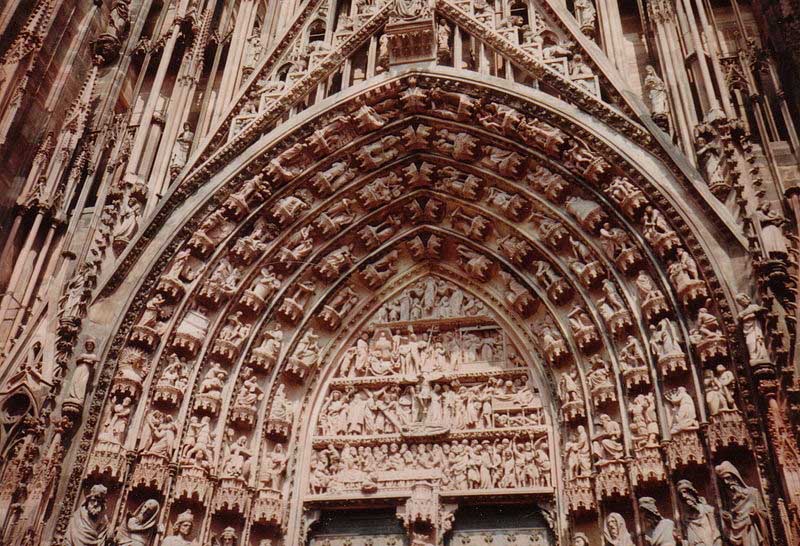
Iconography inspired by writings of Albertus Magnus
Influence and Tribute
The Academy for Science and Design in New Hampshire honored Albertus by naming one of its four houses Magnus House.
As a tribute to the scholar's contributions to the law, the University of Houston Law Center displays a statute of Albertus Magnus. It is located on the campus of the University of Houston.
The Albertus-Magnus-Gymnasium is found in Regensburg, Germany.
In Managua, Nicaragua, the Albertus Magnus International Institute, a business and economic development research center, was founded in 2004.
In the Philippines, the Albertus Magnus Building at the University of Santo Tomas that houses the Conservatory of Music, College of Tourism and Hospitality Management, College of Education, and UST Education High School is named in his honor. The Saint Albert the Great Science Academy in San Carlos City, Pangasinan, which offers preschool, elementary and high school education, takes pride in having St. Albert as their patron saint. Its main building was named Albertus Magnus Hall in 2008.
Due to his contributions to natural philosophy, the plant species Alberta magna and the asteroid 20006 Albertus Magnus were named after him.
In The Concept of Anxiety Soren Kierkegaard wrote that Albert Magnus, "arrogantly boasted of his speculation before the deity and suddenly became stupid." Kierkegaard cites G. O.
Marbach who he quotes as saying "Albertus repente ex asino factus philosophus et ex philosopho asinus" [Albert was suddenly transformed from an ass into a philosopher and from a philosopher into an ass].
In 1968, he was cited by William F. Buckley as one of several historical figures whose best qualities would be emulated by the ideal President.
The typeface Albertus is named in his memory.
In Mary Shelley's Frankenstein, Albertus Magnus is referred to as one of Victor Frankenstein's chosen readings. He is also referred to in Nathaniel Hawthorne's The Birth-mark and Herman Melville's The Bell Tower.
In Terry Pratchett's Discworld novels, the character of Alberto Mallich (founder of the Unseen University and later Death's manservant Albert) is a sly nod to Albertus Magnus in his more legendary and esoteric guise.
Walter M. Miller, Jr.'s novel A Canticle for Leibowitz centers on a monastic order called the Albertian Order of Leibowitz, named by its founder after Albertus Magnus and dedicated to preserving scientific knowledge lost after a nuclear war.
Roger Bacon
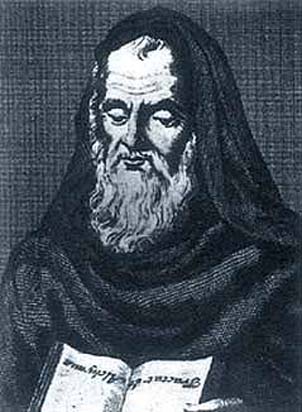
Roger Bacon (c. 1214-1294), also known as Doctor Mirabilis (Latin: "astounding teacher"), was one of the most famous Franciscan friars of his time. He was an English philosopher who placed considerable emphasis on empiricism, and has been presented as one of the earliest advocates of the modern scientific method in the West; though later studies have emphasized his reliance on occult and alchemical traditions. He was intimately acquainted with the philosophical and scientific insights of the Arab world, one of the most advanced civilizations at the time.
He is sometimes credited, mainly starting in the 19th century, as one of the earliest European advocates of the modern scientific method inspired by the works of Aristotle and later pseudo-Aristotelian works, like the works of Egyptian scientist Alhazen. However, more recent reevaluations emphasize that he was essentially a medieval thinker, with much of his "experimental" knowledge obtained from books, in the scholastic tradition. A survey of the reception of Bacon's work over centuries found that it often reflects the concerns and controversies central to the receivers.
Early Life
Bacon studied at Oxford and may have been a disciple of Grosseteste. He became a master at Oxford, lecturing on Aristotle. There is no evidence he was ever awarded a doctorate - the title Doctor Mirabilis was posthumous and figurative. Sometime between 1237 and 1245, he began to lecture at the university of Paris, then the centre of intellectual life in Europe.
His whereabouts between 1247 and 1256 are uncertain, but about 1256 he became a friar in the Franciscan Order. As a Franciscan friar, Bacon no longer held a teaching post, and after 1260 his activities were further restricted by a Franciscan statute forbidding friars from publishing books or pamphlets without specific approval.
Bacon circumvented this restriction through his acquaintance with Cardinal Guy le Gros de Foulques, who became Pope Clement IV in 1265. The new Pope issued a mandate ordering Bacon to write to him concerning the place of philosophy within theology. As a result Bacon sent the Pope his Opus Majus, which presented his views on how the philosophy of Aristotle and the new science could be incorporated into a new Theology. Besides the Opus maius Bacon also sent his Opus minus, De multiplicatione specierum, and, perhaps, other works on alchemy and astrology.
Pope Clement died in 1268. Sometime between 1277 and 1279, Bacon was probably imprisoned or placed under house arrest. The circumstances for this are still mysterious. Sometime after 1278 Bacon returned to the Franciscan House at Oxford, where he continued his studies. He is believed to have died in 1294.
Opus Majus
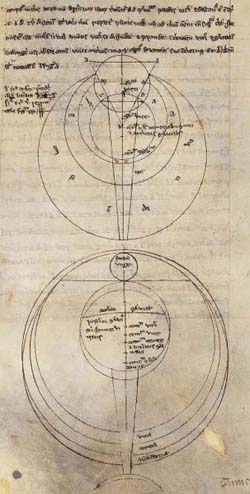
The Opus Majus (Latin for "Greater Work") is the most important work of Roger Bacon, containing treatments of mathematics and optics, alchemy, and the positions and sizes of the celestial bodies.
It was written in Medieval Latin, at the request of Pope Clement IV, to explain the work that Bacon had undertaken. The 840-page treatise ranges over all aspects of natural science, from grammar and logic to mathematics, physics, and philosophy. Bacon sent his work to the Pope in 1267, accompanied by a letter of dedication which was found by F. A. Gasquet in the Vatican Library and published in 1897. It was followed later the same year by a smaller second work, his Opus Minus, which was intended as an abstract or summary of the longer work, followed shortly by a third work, Opus Tertium, as a preliminary introduction to the other two.
The Opus Majus (Latin for "Greater Work") is the most important work of Roger Bacon. It was written in Medieval Latin, at the request of Pope Clement IV, to explain the work that Bacon had undertaken. The 840-page treatise ranges over all aspects of natural science, from grammar and logic to mathematics, physics, and philosophy. Bacon sent his work to the Pope in 1267, accompanied by a letter of dedication which was found by F. A. Gasquet in the Vatican Library and published in 1897. It was followed later the same year by a smaller second work, his Opus Minus, which was intended as an abstract or summary of the longer work, followed shortly by a third work, Opus Tertium, as a preliminary introduction to the other two.
The Opus Majus is divided into seven parts:
-
Part one considers the obstacles to real wisdom and truth, classifying
the causes of error (offendicula) into four categories: following a weak
or unreliable authority, custom, the ignorance of others, and
concealing one's own ignorance by pretended knowledge.
-
Part two considers the relationship between philosophy and theology,
concluding that theology (and particularly Holy Scripture) is the
foundation of all sciences.
Part three contains a study of Bibilical languages: Latin, Greek, Hebrew, and Arabic, as a knowledge of language and grammar is necessary to understand revealed wisdom.
Parts four, five, and six consider, respectively, mathematics, optics, and experimental science. They include a review of alchemy and the manufacture of gunpowder and of the positions and sizes of the celestial bodies, and anticipates later inventions, such as microscopes, telescopes, spectacles, flying machines, hydraulics and steam ships. The study of optics in part five seems to draw on the works of the Arab writers Kindi and Alhazen, including a discussion of the physiology of eyesight, the anatomy of the eye and the brain, and considers light, distance, position, and size, direct vision, reflected vision, and refraction, mirrors and lenses.
Part seven considers moral philosophy and ethics.
As a recent paper emphasizes, this major work can not be usefully read exclusively in the context of the history of science and philosophy while forgetting to consider Bacon's religious commitment to the Franciscan Order. "His Opus maius was a plea for reform addressed to the supreme spiritual head of the Christian faith, written against a background of apocalyptic expectation and informed by the driving concerns of the friars. It was designed to improve training for missionaries and to provide new skills to be employed in the defense of the Christian world against the enmity of non-Christians and of the Antichrist".
Calendar
Optics
His research in optics was primarily oriented by the legacy of Alhazen through a Latin translation of the latter's monumental Kitab al-manazir (De aspectibus; Perspectivae; The Optics), while the impact of the tradition of al-Kindi (Alkindus) was principally mediated through the influence that this Muslim scholar had on the optics of Robert Grosseteste. Moreover, Bacon's investigations of the properties of the magnifying glass partly rested on the handed-down legacy of Islamic opticians, mainly Alhazen, who was in his turn influenced by Ibn Sahl's 10th century legacy in dioptrics.
Gunpowde
The most telling passage reads: "We have an example of these things (that act on the senses) in the sound and fire of that children's toy which is made in many diverse parts of the world; i.e. a device no bigger than one's thumb. From the violence of that salt called saltpetre together with sulphur and willow charcoal, combined into a powder so horrible a sound is made by the bursting of a thing so small, no more than a bit of parchment containing it, that we find [the ear assaulted by a noise exceeding the roar of strong thunder, and a flash brighter than the most brilliant lightning."
More controversial are the claims originating with Royal Artillery colonel Henry William Lovett Hime (at the beginning of the 20th century) that a cryptogram existed in Bacon's Epistola, giving the ratio of ingredients of the mixture. These were published, among other places, in the 1911 edition of Encyclopedia Britannica.
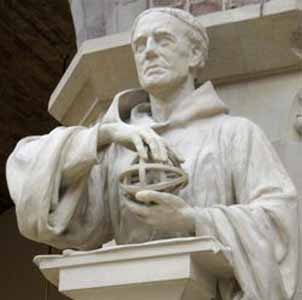
Works
Bacon withdrew from the scholastic routine and devoted himself to languages and experimental research. The mathematicians whom he considered perfect were Peter of Maricourt and John of London, and two were good: Campanus of Novara and a Master Nicholas. Peter was the author of a famous letter to a friend, Epistola de Magnete, in which he described some of the earliest European experiments with magnetism. Campanus wrote several important works on astronomy, astrology, and the calendar. Bacon often mentioned his debt to the work of Robert Grosseteste and Adam Marsh, as well as to other lesser figures. He was clearly not an isolated scholar in the thirteenth century.
Furthermore, he urged all theologians to study all sciences closely, and to add them to the normal university curriculum. With regard to the obtaining of knowledge, he strongly championed experimental study over reliance on authority, arguing that "thence cometh quiet to the mind". Bacon did not restrict this approach to theological studies. He rejected the blind following of prior authorities, both in theological and scientific study, which was the accepted method of undertaking study in his day.
In the Opus Minus he criticizes his contemporaries Alexander of Hales and Albertus Magnus who, he says, had not studied the philosophy of Aristotle but only acquired their learning during their life as preachers. Albert was received at Paris as an authority equal to Aristotle, Avicenna, and Averroes, leading Bacon to proclaim that "never in the world had such monstrosity occurred before."
The scientific training Bacon had received showed him the defects in existing academic debate. Aristotle was known only through poor translations, as none of the professors would learn Greek. The same was true of Scripture. Physical science was not carried out by experiment in the Aristotelian way, but by arguments based on tradition.
Bacon withdrew from the scholastic routine and devoted himself to languages and experimental research. The only teacher whom he respected was a certain Petrus de Maharncuria Picardus, or "of Picardie", probably identical with a certain mathematician, Petrus Peregrinus of Picardie, who is perhaps the author of a manuscript treatise, De Magnete, contained in the Bibliotheque Imperiale at Paris. The contrast between the obscurity of such a man and the fame enjoyed by the fluent young doctors roused Bacon's indignation.
In the Opus Minus and Opus Tertium he pours forth a violent tirade against Alexander of Hales, and another professor, who, he says, acquired his learning by teaching others, and adopted a dogmatic tone, which caused him to be received at Paris with applause as the equal of Aristotle, Avicenna, or Averroes. Bacon was always an outspoken man who stated what he believed to be true and attacked those with whom he disagreed, which repeatedly caused him great trouble.
In 1256 a new head of the scientific branch of the Franciscan order in England was appointed: Richard of Cornwall, with whom Bacon had strongly disagreed in the past. Before long, Bacon was transferred to a monastery in France, where for about 10 years he could communicate with his intellectual peers only in writing.
Bacon wrote to the Cardinal Guy le Gros de Foulques, who became interested in his ideas and asked him to produce a comprehensive treatise. Bacon, being constrained by a rule of the Franciscan order against publishing works out of the order without special permission, initially hesitated.
The cardinal became Pope Clement IV and urged Bacon to ignore the prohibition and write the book in secret. Bacon complied and sent his work, the Opus Majus, a treatise on the sciences (grammar, logic, mathematics, physics, and philosophy), to the pope in 1267. It was followed in the same year by the Opus Minus (also known as Opus Secundum), a summary of the main thoughts from the first work.
In 1268, he sent a third work, the Opus Tertium to the pope, who died the same year, apparently before even seeing the Opus Majus although it is known that the work reached Rome.
Some claim that Bacon fell out of favor, and was later imprisoned by the Franciscan order in 1278 in Ancona as his dissemination of Arab alchemy, and his protests against the ignorance and immorality of the clergy, roused accusations of witchcraft.
He supposedly stayed imprisoned for over ten years, until intercession of English noblemen secured his release. About this episode, the historian of science David C. Lindberg, quoted by James Hannam, says that "his imprisonment, if it occurred at all probably resulted with his sympathies for the radical 'poverty' wing of the Franciscans (a wholly theological matter) rather than from any scientific novelties which he may have proposed."
Bacon died without important followers, was quickly forgotten, and remained so for a long time.
In his writings, Bacon calls for a reform of theological study. Less emphasis should be placed on minor philosophical distinctions as in scholasticism, but instead the Bible itself should return to the center of attention and theologians should thoroughly study the languages in which their original sources were composed. He was fluent in several languages and lamented the corruption of the holy texts and the works of the Greek philosophers by numerous mistranslations and misinterpretations. Furthermore, he urged all theologians to study all sciences closely, and to add them to the normal university curriculum.
He possessed one of the most commanding intellects of his age, or perhaps of any, and, notwithstanding all the disadvantages and discouragements to which he was subjected, made many discoveries, and came near to many others. He rejected the blind following of prior authorities, both in theological and scientific study.
His Opus Majus contains treatments of mathematics and optics, alchemy and the manufacture of gunpowder, the positions and sizes of the celestial bodies, and anticipates later inventions such as microscopes, telescopes, spectacles, flying machines and steam ships.
Bacon studied astrology and believed that the celestial bodies had an influence on the fate and mind of humans. He also wrote a criticism of the Julian calendar which was then still in use. He first recognized the visible spectrum in a glass of water, centuries before Sir Isaac Newton discovered that prisms could disassemble and reassemble white light.
Roger Bacon is considered by some to be the author of the Voynich Manuscript, because of his studies in the fields of alchemy, astrology, and languages.
Bacon is also the ascribed author of the alchemical manual Speculum Alchemiae, which was translated into English as The Mirror of Alchemy in 1597.
He was an enthusiastic proponent and practitioner of the experimental method of acquiring knowledge about the world. He planned to publish a comprehensive encyclopedia, but only fragments ever appeared.
The Mirror of Alchemy
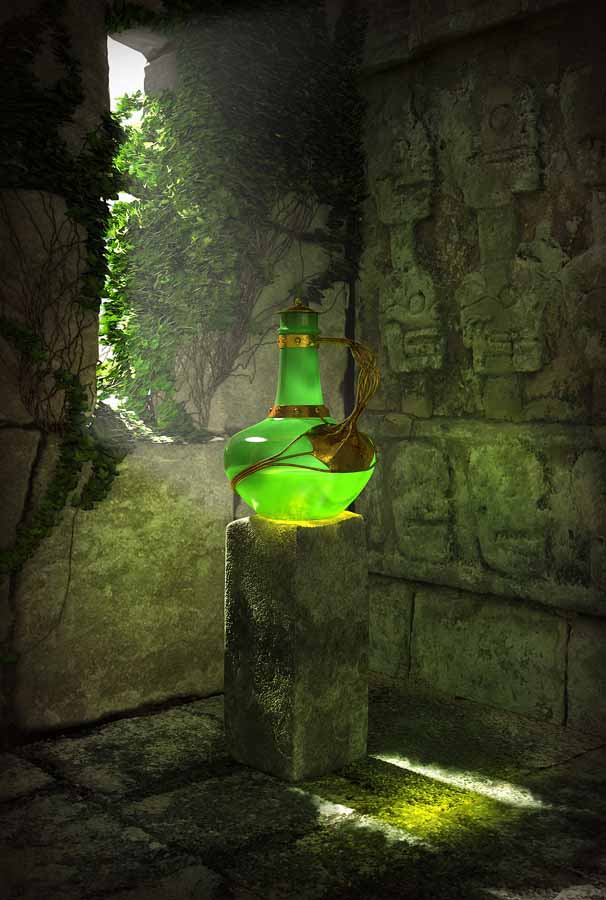
Seeing that by the former Chapters we have been taught, that all metals are engendered of Argent-vive and Sulphur, and how that their impurity and uncleanness does corrupt, and that nothing may be mingled with metals which have not been made or sprung from them, it: remains clean enough, that no strange thing which has not his original from these two, is able to perfect them, or to make a Change and new transmutation of them: so that it is to be wondered at, that any wise man should set his mind upon living creatures, or vegetables which are far off, when there be minerals to be found near enough: neither may we in any way think, that any of the Philosophers placed the Art in the said remote things, except it were by way of comparison: but of the aforesaid two, all metals are made, neither does any thing cleave unto them or is joined with them, not yet changes them, but that which is of them, and so of right we must take Argent-vive and Sulphur for the matter of our stone: Neither does Argent-vive by itself alone, nor Sulphur by itself alone, beget any metal, but of the commixtion of them both, diverse metals and minerals are diversely brought forth. Our matter therefore must be chosen of the commixtion of them both: but our final secret is most excellent, and most hidden, to wit, of what mineral thing that is more near than others, it should be made: and in making choice hereof, we must be very wary.
I put the case then, if our matter were first of all drawn out of vegetables, (of which sort are herbs, trees, and whatsoever springs out of the earth) here we must first make Argent-vive & Sulphur, by a long decoction, from which things, and their operation we are excused: for nature herself offers unto us Argent-vive and Sulphur. And if we should draw it from living creatures (of which sort is man's blood, hair, urine, excrements, hens' eggs, and what else proceed from living creatures) we must likewise out of them extract Argent-vive and Sulphur by decoction, from which we are freed, as we were before.
Or if we should choose it out of middle minerals (of which sort are all kinds of Magnesia, Marchasites, of Tutia, Coppers, Allums, Baurach, Salts, and many other) we should likewise, as afore, extract Argent-vive and Sulphur by decoction: from which as from the former, we are also excused. And if we should take one of the seven spirits by itself, as Argent-vive, or Sulphur alone, or Argent-vive and one of the two Sulphurs, or Sulphur-vive, or Auripigment, or Citrine Arsenicum, or red alone, or the like: we should never effect it, because since nature does never perfect anything without equal commixtion of both, neither can we: from these therefore, as from the foresaid Argent-vive and Sulphur in their nature we are excused.
Finally, if we should choose them, we should mix everything as it is, according to a due proportion, which no man knows, and afterward decoct it to coagulation, into a solid lump: and therefore we are excused from receiving both of them in their proper nature: to wit, Argent-vive and Sulphur, seeing we know not their proportion, and that we may meet with bodies, wherein we shall find the said things proportioned, coagulated and gathered together, after a due manner. Keep this secret more secretly.
Gold is a perfect masculine body, without any superfluity or diminution: and if it: should perfect imperfect bodies mingled with it by melting only, it should be Elixir to red. Silver is also a body almost perfect, and feminine, which if it should almost perfect imperfect bodies by his common melting only, it should be Elixir to white which it is not, nor cannot be, because they only are perfect.
And if this perfection might be mixed with the imperfect, the imperfect should not be perfected with the perfect, but rather their perfection's should be diminished by the imperfect, and become imperfect. But if they were more than perfect, either in a two-fold, four-fold, hundred-fold, or larger proportion, they might then well perfect the imperfect. And forasmuch as nature does always work simply, the perfection which is in them is simple, inseparable, and incommiscible, neither may they by art be put in the stone, for ferment to shorten the work, and so brought to their former state, because the most volatile does overcome the most fixed.
And for that gold is a perfect body, consisting of Argent-vive, red and clear, and of such a Sulphur, therefore we choose it not for the matter of our stone to the red Elixir, because it is so simply perfect, without artificial mundification, and so strongly digested and fed with a natural heat, that with our artificial fire, we are scarcely able to work on gold or silver, And though nature does perfect anything, yet she cannot thoroughly mundify, or perfect and purify it, because she simply works on that which she has. If therefore we should choose gold or silver for the matter of the stone, we should hard and scantly find fire working in them.
And although we are not ignorant of the fire, yet could we not come to the thorough mundification and perfection of it, by reason of his most firm knitting together, and natural composition: we are therefore excused for taking the first too red, or the second too white, seeing we may find out a thing or some body of as clean, or rather more clean Sulphur and Argent-vive, on which nature has wrought little or nothing at all, which with our artificial fire, and experience of our art, we are able to bring unto his due concoction, mundification, color and fixation, continuing our ingenious labor upon it.
There must therefore be such a matter chosen, where in there is Argent-vive, clean, pure, clear, white and red, not fully complete, but equally and proportionably commixt after a due manner with the like Sulphur, and congealed into a solid mass, that by our wisdom and discretion, and by our artificial fire, we may attain unto the uttermost cleanness of it, and the purity of the same, and bring it to that pass, that after the work ended, it might be a thousand thousand times more strong and perfect, then the simple bodies themselves, decoct by their natural heat.
Be therefore wise: for if you shall be subtle and witty in my Chapters (wherein by manifest prose I have laid open the matter of the stone easy to be known) you shall taste of that delightful thing, wherein the whole intention of the Philosophers is placed.
And if we know not the manner of working, what is the cause that we do not see how nature (which of long time has perfected metals) does continually work! Do we not see, that in the Mines through the continual heat that is in the mountains thereof, the grossness of water is so decocted and thickened, that in continuance of time it becomes Argent-vive?
And that of the fatness of the earth through the same heat and decoction, Sulphur is engendered! And that through the same heat without intermission continued in them, all metals are engendered of them according to their purity and impurity? and that nature does by decoction alone perfect or make all metals, as well perfect as imperfect? 0 extreme madness! what, I pray you, constrains you to seek to perfect the foresaid things by strange melancholical and fantastical regiments! as one says: Woe to you that will overcome nature, and make metals more then perfect by a new regiment, or work sprung from your own senseless brains.
God has given to nature a straight way, to wit, continual concoction, and you like fools despise it, or else know it not. Again, fire and Azot, are sufficient for you. And in another place, Heat perfects all things. And elsewhere, see, see, see, and be not weary. And in another place, let your fire be gentle, and easy, which being always equal, may continue burning: and let it not increase, for if it does, you shall suffer great loss.
And in another place, Know you that in one thing, to wit, the stone, by one way, to wit, decoction, and in one vessel the whole mastery is performed. And in another place, patiently, and continually, and in another place, grind it seven times.
And in another place, It is ground with fire, And in another place, this work is very like to the creation of man: for as the Infant in the beginning is nourished with light meats, but the bones being strengthened with stronger: so this mastery also, first it must have an easy fire, whereby we must always work in every essence of decoction. And though we always speak of a gentle fire, yet in truth, we think that in governing the work, the fire must always by little and little be increased and augmented unto the end.
Let us first of all therefore, see in what place the generation of metals is made. It does evidently appear in the places of Minerals, that in the bottom of the mountain there is heat continually alike, the nature whereof is always to ascend, and in the ascension it always dries up, and coagulates the thicker or grosser water hidden in the belly, or veins of the earth, or mountain, into Argent-vive.
And if the mineral fatness of the same place arising out of the earth, be gathered warm together in the veins of the earth, it runs through the mountain, and becomes Sulphur. And as a man may see in the foresaid veins of that place, that Sulphur engendered of the fatness of the earth (as is before touched) meets with the Argent-vive (as it is also written) in the veins of the earth, and begets the thickness of the mineral water. There, through the continual equal heat in the mountain, in long process of time diverse metals are engendered, according to the diversity of the place.
And in these Mineral places, you shall find a continual heat. For this cause we are of right to note, that the external mineral mountain is everywhere shut up within itself, and stony: for if the heat might issue out, there should never be engendered any metal. If therefore we intend to immitate nature, we must needs have such a furnace like unto the Mountains, not in greatness, but in continual heat, so that the fire put in, when it ascends, may find no vent: but that the heat may beat upon the vessel being close shut, containing in it the matter of the stone: which vessel must be round, with a small neck, made of glass or some earth, representing the nature or close knitting together of glass: the mouth whereof must be signed or sealed with a covering of the same matter, or with lute.
And as in the mines, the heat does not immediately touch the matter of Sulphur and Argent-vive, because the earth of the mountain comes everywhere between: So this fire must not immediately touch the vessel, containing the matter of the aforesaid things in it, but it must be put into another vessel, shut closed in the like manner, that so the temperate heat may touch the matter above and beneath, and where ever it be, more aptly and fitly: whereupon Aristotle says, in the light of lights, that Mercury is to be concocted in a three-fold vessel, and that the vessel must be of most hard Glass, or (which is better) of Earth possessing the nature of Glass.
But after putrifaction it waxes red, not with a true redness, of which one says: It is often red, and often of a citrine color, it often melts, and is often coagulated, before true whiteness. And it dissolves itself, it coagulates itself, it putrifies itself, it colors itself, it mortifies itself, it quickens itself it makes itself black, it makes itself white, it makes itself red. It is also green: whereon another says, Concoct it, till it appears green unto you, and that is the soul. And another, Know, that in that: green his soul bears dominion. There appears also before whiteness the peacocks color, whereon one says thus, Know you that all the colors in the world, or that may be imagined, appear before whiteness, and afterward true whiteness follows.
Whereof one says: When it has been decocted pure and clean, that it shines like the eyes of fishes, then are we to expect his utility, and by that time the stone is congealed round, And another says: When you shall find whiteness atop in the glass, be assured that in that whiteness, redness is hidden: and this you must extract: but concoct it while it becomes all red: for between true whiteness and true redness, there is a certain ash-color: of which it is said, After whiteness, you cannot err, for increasing the fire, you shall come to an ash-color: of which another says: Do not set light by the ashes, for God shall give it to you molten: and then at the last the King is invested with a red crown the by will of God.
The red Elixir turns into a citrine color infinitely, and changes all metals into pure gold. And the white Elixir does infinitely whiten, and brings every metal to perfect whiteness. But we know that one metal is farther off from perfection then another, and one more near then another.
And although every metal may by Elixir be reduced to perfection, nevertheless the nearest are more easily, speedily, and perfectly reduced, then those which are far distant, And when we meet with a metal that is near to perfection, we are thereby excused from many that are far off.
And as for the metals which of them be near, and which far off, which of them I say be nearest to perfection, if you are wise and discrete, you shall find to be plainly and truly set out in my Chapters.
And without doubt, he that is so quick sighted in this my Mirror, that by his own industry he can find out the true matter, he does full well know upon what body the medicine is to be projected to bring it to perfection. For the forerunners of this Art, who have found it out by their philosophy, do point out with their finger the direct and plain way, when they say: Nature, contains nature: Nature overcomes nature: and Nature meeting with her nature, exceedingly rejoices, and is changed into other natures, And in another place, Every like rejoices in his like: for likeness is said to be the cause of friendship, whereof many Philosophers have left a notable secret, Know you that the sour does quickly enter into his body, which may by no means be joined to another body, And in another place, The soul does quickly enter into his own body, which if you go about to join with another body, you shall loose your labor: for the nearness itself is more clear.
And because corporeal things in this regiment are made incorporeal, and contrariwise things incorporeal corporeal, and in the shutting up of the work, the whole body is made a spiritual fixed thing: and because also that spiritual Elixir evidently, whether white or red, is so greatly prepared and decocted beyond his nature, it is no marvel that it cannot be mixed with a body, on which it is projected, being only melted. It is also a hard matter to Project it on a thousand thousand and more, and incontinently to penetrate and transmute them.
I will therefore now deliver unto you a great and hidden secret. one part is to be mixed with a thousand of the next body, and let: all this be surely put into a fit vessel, and set it in a furnace of fixation, first with a lent fire, and afterwards increasing the fire for three days, till they be inseparably joined together, and this is a work of three days: then again and finally every part hereof by itself, must be projected upon another thousand parts of any near body: and this is a work of one day, Or one hour, or a moment, for which our wonderful God is eternally to be praised.
Arnaldus Villanovanus
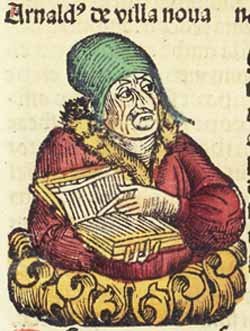
Arnaldus de Villa Nova (also called Arnaldus de Villanueva, Arnaldus Villanovanus, Arnaud de Ville-Neuve or Arnau de Vilanova, c. 1235-1311) was an alchemist, pharmacist, astrologer and physician. As with other alchemists of his time most of the details of his life are obscure.
He was born in Valencia, and appears to have been of Catalan origin, and to have studied chemistry, medicine, physics, and also Arabic philosophy. After having lived at the court of Aragon and taught many years in Montpellier School of Medicine, he went to Paris, where he gained a considerable reputation; but he incurred the enmity of the ecclesiastics and was forced to flee, finally finding an asylum in Sicily. About 1313 he was summoned to Avignon by Pope Clement V, who was ill, but he died on the voyage off the coast of Genoa.
He is credited with translating a number of medical texts from Arabic, including works by Ibn Sina (Avicenna), Qusta ibn Luqa (Costa ben Luca), and Galen. Many alchemical writings, including Thesaurus Thesaurorum or Rosarius Philosophorum, Novum Lumen, and Flos Florum, are also ascribed to him, but they are of very doubtful authenticity. Collected editions of them were published at Lyon in 1504 and 1532 (with a biography by Symphorianus Campegius), at Basel in 1585, at Frankfurt in 1603, and at Lyon in 1686. He is also the reputed author of various medical works, including Breviarium Practicae. Among his achievements was the discovery of carbon monoxide and pure alcohol.
At Barcelona he had John Casamila as teacher, thought highly of Galen, and among the Arabs cared only for Rhazes. He taught medicine, botany, and alchemy at Barcelona, Montpellier, and Paris. His life was a wandering one; besides the cities just mentioned, he lived for considerable periods of time at Lyons, Avignon, Rome, Florence, Bologna, Naples, and Palermo.
He was considered superior to all other physicians and alchemists, so that he was frequently summoned by popes and princes. Thus he was at times at the papal Court during the reigns of Innocent V, Boniface VIII, Benedict XI, and Clement V. He was also the personal physician of Pedro III and James II of Aragon, Robert of Naples, and Frederick II of Sicily.
He was repeatedly obliged to go from place to place because the Inquisition in Spain and Paris sentenced him to banishment on account of his fantastic writing, which were at times heretical. Owing to the large number of writings still extant bearing his name, some evidently spurious, others doubtful, it is not easy to judge Villanovanus.
His reputation in alchemy was excelled only by that of Raymond Lully, who was regarded as his pupil. Modern criticism has assigned to an earlier age many chemical discoveries that were formerly ascribed to Villanovanus, as acids, alcohol, distillation etc. Yet a number of his works were very important in placing medicine and pharmacology on a scientific basis; besides an independent judgment they show ripe experience and great humanity.
Although a layman he wrote much on theology. His alchemistic and astrological bent led him into erroneous opinions regarding the Church, the Mass, Antichrist, the end of the world, and the person of Christ. The first complete edition of his works was issued at Lyons in 1504, reissued at the same place in 1520 and 1532 (folio). The most complete edition is that of Taurellus (Basle, 1585), with a biography of Arnaldus. For the individual works see, in particular, Haser, op. cit. in bibliography below. Several of them were repeatedly reprinted before 1500.
He died while on his way to visit the sick pontiff, Clement V.
Nicholas Flamel
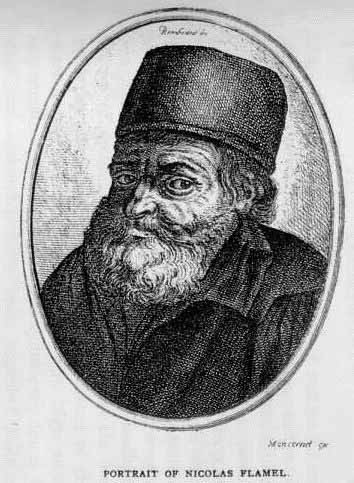
Nicolas Flamel 1330 - Paris, March 22, 1418 - was a successful French scrivener and manuscript-seller who developed a posthumous reputation as an alchemist due to his reputed work on the Philosopher's Stone.
According to the introduction to his work and additional details that have accrued since its publication, Flamel was the most accomplished of the European alchemists, and had learned his art from a Jewish converso on the road to Santiago de Compostela. As Deborah Harkness put it, "Others thought Flamel was the creation of 17th-century editors and publishers desperate to produce modern printed editions of supposedly ancient alchemical treatises then circulating in manuscript for an avid reading public."
The modern assertion that many references to him or his writings appear in alchemical texts of the 16th century, however, has not been linked to any particular source. The essence of his reputation are claims that he succeeded at the two magical goals of alchemy: that he made the Philosopher's Stone, which turns lead into gold, and that he and his wife Perenelle achieved immortality through the "Elixir of Life".
Life
Expanded accounts of his life are legendary. An alchemical book, published in Paris in 1613 as Livre des figures hieroglypiques and in London in 1624 as Exposition of the Hieroglyphical Figures was attributed to Flamel. It is a collection of designs purportedly commissioned by Flamel for a tympanum at the Cimetire des Innocents in Paris, long disappeared at the time the work was published. In the publisher's introduction Flamel's search for the philosopher's stone was described.
According to that introduction, Flamel had made it his life's work to understand the text of a mysterious 21-page book he had purchased. The introduction claims that, around 1378, he traveled to Spain for assistance with translation. On the way back, he reported that he met a sage, who identified Flamel's book as being a copy of the original Book of Abraham the Mage.
With this knowledge, over the next few years, Flamel and his wife allegedly decoded enough of the book to successfully replicate its recipe for the Philosopher's Stone, producing first silver in 1382, and then gold. In addition, Flamel is said to have studied some texts in Hebrew. Interest in Flamel revived in the 19th century, and Victor Hugo mentioned him in The Hunchback of Notre Dame. Eric Satie was intrigued by Flamel.
He had already achieved legendary status within the circles of alchemy by the mid 17th Century, with references in Isaac Newton's journals to "the Caduceus, the Dragons of Flammel". Albert Pike makes reference to Nicholas Flamel in his book Morals and Dogma of the Scottish Rite of Freemasonry.
Other Information
Wisdom has various means for making its way into the heart of man. Sometimes a prophet comes forward and speaks. Or a sect of mystics receives the teaching of a philosophy, like rain on a summer evening, gathers it in and spreads it abroad with love. Or it may happen that a charlatan, performing tricks to astonish men, may produce, perhaps without knowing it himself, a ray of real light with his dice and magic mirrors. In the fourteenth century, the pure truth of the masters was transmitted by a book.
This book fell into the hands of precisely the man who was destined to receive it; and he, with the help of the text and the hieroglyphic diagrams that taught the transmutation of metals into gold, accomplished the transmutation of his soul, which is a far rarer and more wonderful operation.
Thanks to the amazing book of Abraham the Jew all the Hermetists of the following centuries had the opportunity of admiring an example of a perfect life, that of Nicolas Flamel, the man who received the book. After his death or disappearance many students and alchemists who had devoted their lives to the search for the Philosopher's Stone despaired because they had not in their possession the wonderful book that contained the secret of gold and of eternal life. But their despair was unnecessary. The secret had become alive. The magic formula had become incarnate in the actions of a man. No ingot of virgin gold melted in the crucibles could, in color or purity, attain the beauty of the wise bookseller's pious life.
There is nothing legendary about the life of Nicolas Flamel. The Bibliotheque Nationale in Paris contains works copied in his own hand and original works written by him. All the official documents relating to his life have been found: his marriage contract, his deeds of gift, his will. His history rests solidly on those substantial material proofs for which men clamor if they are to believe in obvious things. To this indisputably authentic history, legend has added a few flowers. But in every spot where the flowers of legend grow, underneath there is the solid earth of truth.
Whether Nicolas Flamel was born at Pontoise or somewhere else, a question that historians have argued and investigated with extreme attention, seems to me to be entirely without importance. It is enough to know that towards the middle of the fourteenth century, Flamel was carrying on the trade of a bookseller and had a stall backing on to the columns of Saint-Jacques la Boucherie in Paris. It was not a big stall, for it measured only two feet by two and a half. However, it grew. He bought a house in the old rue de Marivaux and used the ground floor for his business. Copyists and illuminators did their work there. He himself gave a few writing lessons and taught nobles who could only sign their names with a cross. One of the copyists or illuminators acted also as a servant to him.
Nicolas Flamel married Pernelle, a good-looking, intelligent widow, slightly older than himself and the possessor of a little property. Every man meets once in his life the woman with whom he could live in peace and harmony. For Nicolas Flamel, Pernelle was that woman. Over and above her natural qualities, she had another which is still rarer. She was a woman who was capable of keeping a secret all her life without revealing it to anybody in confidence. But the story of Nicolas Flamel is the story of a book for the most part. The secret made its appearance with the book, and neither the death of its possessors nor the lapse of centuries led to the complete discovery of the secret.
Nicolas Flamel had acquired some knowledge of the Hermetic art. The ancient alchemy of the Egyptians and the Greeks that flourished among the Arabs had, thanks to them, penetrated to Christian countries. Nicolas Flamel did not, of course, regard alchemy as a mere vulgar search for the means of making gold.
For every exalted mind the finding of the Philosopher's Stone was the finding of the essential secret of Nature, the secret of her unity and her laws, the possession of perfect wisdom. Flamel dreamed of sharing in this wisdom. His ideal was the highest that man could attain. And he knew that it could be realized through a book, for the secret of the Philosopher's Stone had already been found and transcribed in symbolic form. Somewhere it existed. It was in the hands of unknown sages who lived somewhere unknown. But how difficult it was for a small Paris bookseller to get into touch with those sages.
Nothing, really, has changed since the fourteenth century. In our day also many men strive desperately towards an ideal, the path which they know but cannot climb; and they hope to win the magic formula (which will make them new beings) from some miraculous visit or from a book written expressly for them. But for most, the visitor does not come and the book is not written.
Yet for Nicolas Flamel the book was written. Perhaps because a bookseller is better situated than other people to receive a unique book; perhaps because the strength of his desire organized events without his knowledge, so that the book came when it was time. So strong was his desire, that the coming of the book was preceded by a dream, which shows that this wise and well-balanced bookseller had a tendency to mysticism.
Nicolas Flamel dreamed one night that an angel stood before him. The angel, who was radiant and winged like all angels, held a book in his hands and uttered these words, which were to remain in the memory of the hearer: "Look well at this book, Nicholas. At first you will understand nothing in it neither you nor any other man. But one day you will see in it that which no other man will be able to see." Flamel stretched out his hand to receive the present from the angel, and the whole scene disappeared in the golden light of dreams. Sometime after that the dream was partly realized.
One day, when Nicolas Flamel was alone in his shop, an unknown man in need of money appeared with a manuscript to sell. Flamel was no doubt tempted to receive him with disdainful arrogance, as do the booksellers of our day when some poor student offers to sell them part of his library. But the moment he saw the book he recognized it as the book that the angel had held out to him, and he paid two florins for it without bargaining.
The book appeared to him indeed resplendent and instinct with divine virtue. It had a very old binding of worked copper, on which were engraved curious diagrams and certain characters, some of which were Greek and others in a language he could not decipher.
The leaves of the book were not made of parchment, like those he was accustomed to copy and bind. They were made of the bark of young trees and were covered with very clear writing done with an iron point. These leaves were divided into groups of seven and consisted of three parts separated by a page without writing, but containing a diagram that was quite unintelligible to Flamel.
On the first page were written words to the effect that the author of the manuscript was Abraham the Jew - prince, priest, Levite, astrologer, and philosopher. Then followed great curses and threats against anyone who set eyes on it unless he was either a priest or a scribe.
The mysterious word Maranatha, which was many times repeated on every page, intensified the awe-inspiring character of the text and diagrams. But most impressive of all was the patined gold of the edges of the book, and the atmosphere of hallowed antiquity that there was about it.
Nicolas Flamel considered that being a scribe he might read the book without fear. He felt that the secret of life and of death, the secret of the unity of Nature, the secret of the duty of the wise man, had been concealed behind the symbol of the diagram and formula in the text by an initiate long since dead. He was aware that it is a rigid law for initiates that they must not reveal their knowledge, because if it is good and fruitful for the intelligent, it is bad for ordinary men. As Jesus has clearly expressed it, pearls must not be given as food to swine. Was he qualified to read this book?
Nicolas Flamel considered that being a scribe he might read the book without fear. He felt that the secret of life and of death, the secret of the unity of Nature, the secret of the duty of the wise man, had been concealed behind the symbol of the diagram and formula in the text by an initiate long since dead. He was aware that it is a rigid law for initiates that they must not reveal their knowledge, because if it is good and fruitful for the intelligent, it is bad for ordinary men. As Jesus has clearly expressed it, pearls must not be given as food to swine.
He had the pearl in his hands. It was for him to rise in the scale of man in order to be worthy to understand its purity. He must have had in his heart a hymn of thanksgiving to Abraham the Jew, whose name was unknown to him, but who had thought and labored in past centuries and whose wisdom he was now inheriting.
He must have pictured him a bald old man with a hooked nose, wearing the wretched robe of his race and wilting in some dark ghetto, in order that the light of his thought might not be lost. And he must have vowed to solve the riddle, to rekindle the light, to be patient and faithful, like the Jew who had died in the flesh but lived eternally in his manuscript.
Nicolas Flamel had studied the art of transmutation. He was in touch with all the learned men of his day. Manuscripts dealing with alchemy have been found, notably that of Almasatus, which were part of his personal library.
He had knowledge of the symbols of which the alchemists made habitual use. But those that he saw in the book of Abraham the Jew remained dumb for him. In vain, he copied some of the mysterious pages and set them out in his shop, in the hope that some visitor conversant with the Kabbalah would help him to solve the problem. He met with nothing but the laughter of skeptics and the ignorance of pseudo-scholars just as he would today if he showed the book of Abraham the Jew either to pretentious occultists or to the scholars at the Academie des Inscriptions et Belles Lettres.
Nicholas Flamel's Journey For twenty-one years, he pondered the hidden meaning of the book. That is really not that long. He is favored among men for whom twenty-one years are enough to enable him to find the key of life.
At age twenty-one Nicolas Flamel had developed in himself sufficient wisdom and strength to hold out against the storm of light involved by the coming of truth to the heart of man.
Only then did events group themselves harmoniously according to his will and allow him to realize his desire. For everything good and great that happens to a man is the result of the co-ordination of his own voluntary effort and a malleable fate.
No one in Paris could help Nicolas Flamel understand the book. Now, this book had been written by a Jew, and part of its text was in ancient Hebrew. The Jews had recently been driven out of France by persecution. Nicolas Flamel knew that many of these Jews had migrated to Spain.
In towns such as Malaga and Granada, which were still under the more enlightened dominion of the Arabs, there lived prosperous communities of Jews and flourishing synagogues, in which scholars and doctors were bred. Many Jews from the Christian towns of Spain took advantage of the tolerance extended by the Moorish kings and went to Granada to learn. There they copied Plato and Aristotle forbidden texts in the rest of Europe and returned home to spread abroad the knowledge of the ancients and of the Arab masters.
Nicolas Flamel thought that in Spain he might meet some erudite Cabalist who would translate the book of Abraham for him. Travelling was difficult, and without a strong-armed escort, safe passage was nearly impossible for a solitary traveler. Flamel made therefore a vow to St James of Compostela, the patron saint of his parish, to make a pilgrimage. This was also a means of concealing from his neighbors and friends the real purpose of his journey.
The wise and faithful Pernelle was the only person who was aware of his real plans. He put on the pilgrim's attire and shell-adorned hat, took the staff, which ensured a certain measure of safety to a traveler in Christian countries, and started off for Galicia.
Since he was a prudent man and did not wish to expose the precious manuscript to the risks of travel, he contented himself with taking with him a few carefully copied pages, which he hid in his modest baggage.
Nicolas Flamel has not recounted the adventures that befell him on his journey. Possibly he had none. It may be that adventures happen only to those who want to have them. He has told us merely that he went first to fulfill his vow to St James. Then he wandered about Spain, trying to get into relations with learned Jews.
But they were suspicious of Christians, particularly of the French, who had expelled them from their country. Besides, he had not much time. He had to remember Pernelle waiting for him, and his shop, which was being managed only by his servants. To a man of over fifty on his first distant journey, the silent voice of his home makes a powerful appeal every evening.
In discouragement, he started his homeward journey. His way lay through Leon, where he stopped for the night at an inn and happened to sup at the same table as a French merchant from Boulogne, who was traveling on business.
This merchant inspired him with confidence and trust, and he whispered a few words to him of his wish to find a learned Jew. By a lucky chance the French merchant was in relations with a certain Maestro Canches, an old man who lived at Leon, immersed in his books. Nothing was easier than to introduce this Maestro Canches to Nicolas Flamel, who decided to make one more attempt before leaving Spain.
One can easily appreciate the depth of the scene when the profane merchant of Boulogne has left them, and the two men are face to face. The gates of the ghetto close. Maestro Canches' only thought is expressed by a few polite words to rid himself as quickly as he can of this French bookseller, who has deliberately dulled the light in his eye and clothed himself in mediocrity (for the prudent traveler passes unnoticed).
Flamel speaks, reticently at first. He admires the knowledge of the Jews. Thanks to his trade, he has read a great many books. At last he timidly lets fall a name, which hitherto has aroused not a spark of interest in anyone to whom he has spoken - the name of Abraham the Jew, prince, priest, Levite, astrologer and philosopher.
Suddenly Flamel sees the eyes of the feeble old man before him light up. Maestro Canches has heard of Abraham the Jew! He was a great master of the wandering race, perhaps the most venerable of all the sages who studied the mysteries of the Cabala, a higher initiate, one of those who rise the higher the better they succeed in remaining unknown.
His book existed and disappeared centuries ago. But tradition says it has never been destroyed, that it is passed from hand to hand and that it always reaches the man whose destiny it is to receive it. Maestro Canches has dreamed all his life of finding it. He is very old, close to death, and now the hope that he has almost given up is near realization. The night goes by, and there is a light over the two heads bent over their work. Maestro Canches is translating the Hebrew from the time of Moses. He is explaining symbols that originated in ancient Chaldea. How the years fall from these two men, inspired by their common belief in truth.
But the few pages that Flamel had brought are not enough to allow the secret to be revealed. Maestro Canches made up his mind at once to accompany Flamel to Paris, but his extreme age was an obstacle. Furthermore, Jews were not allowed in France. He vowed to rise above his infirmity and convert his religion! For many years now, he had been above all religions. So the two men, united by their indissoluble bond, headed off along the Spanish roads north.
The ways of Nature are mysterious. The nearer Maestro Canches came to the realization of his dream, the more precarious became his health, and the breath of life weakened in him. Oh God! he prayed, grant me the days I need, and that I may cross the threshold of death only when I possess the liberating secret by which darkness becomes light and flesh spirit!
But the prayer was not heard. The inflexible law had appointed the hour of the old man's death. He fell ill at Orleans, and in spite of all Flamel's care, died seven days later. As he had converted and Flamel did not want to be suspected of bringing a Jew into France, he had him piously buried in the church of Sante-Croix and had masses said in his honor. For he rightly thought that a soul that had striven for so pure an aim and had passed at the moment of its fruition. could not rest in the realm of disembodied spirits.
Flamel continued his journey and reached Paris, where he found Pernelle, his shop, his copyists, and his manuscripts safe and sound. He laid aside his pilgrim's staff. But now everything was changed. It was with a joyous heart that he went his daily journey from house to shop, that he gave writing lessons to illiterates and discussed Hermetic science with the educated.
From natural prudence, he continued to feign ignorance, in which he succeeded all the more easily because knowledge was within him. What Maestro Canches had already taught him in deciphering a few pages of the book of Abraham the Jew was sufficient to allow his understanding of the whole book. He spent three years more in searching and in completing his knowledge, but at the end of this period, the transmutation was accomplished.
Having learned what materials were necessary to put together beforehand, he followed strictly the method of Abraham the Jew and changed a half-pound of mercury first into silver, and then into virgin gold. And simultaneously, he accomplished the same transmutation in his soul.
From his passions, mixed in an invisible crucible, the substance of the eternal spirit emerged.

From this point, according to historical records, the little bookseller became rich. He established many low-income houses for the poor, founded free hospitals, and endowed churches. But he did not use his riches to increase his personal comfort or to satisfy his vanity. He altered nothing in his modest life.
With Pernelle, who had helped him in his search for the Philosopher's Stone, he devoted his life to helping his fellow men. "Husband and wife lavished succor on the poor, founded hospitals, built or repaired cemeteries, restored the front of Saint Genevieve des Ardents and endowed the institution of the Quinze-Vingts, the blind inmates of which, in memory of this fact, came every year to the church of Saint Jacques la Boucherie to pray for their benefactor, a practice which continued until 1789," wrote historian Louis Figuier.
At the same time that he was learning how to make gold out of any material, he acquired the wisdom of despising it in his heart. Thanks to the book of Abraham the Jew, he had risen above the satisfaction of his senses and the turmoil of his passions. He knew that man attains immortality only through the victory of spirit over matter, by essential purification, by the transmutation of the human into the divine.
He devoted the last part of his life to what Christians call the working out of personal salvation. But he attained his object without fasting or asceticism, keeping the unimportant place that destiny had assigned him, continuing to copy manuscripts, buying and selling, in his new shop in the rue Saint-Jacques la Boucherie.
For him, there was no more mystery about the Cemetery of the Innocents, which was near his house and under the arcades of which he liked to walk in the evenings. If he had the vaults and monuments restored at his own expense, it was nothing more than compliance with the custom of his time. He knew that the dead who had been laid to rest there were not concerned with stones and inscriptions and that they would return, when their hour came, in different forms, to perfect themselves and die anew.
He knew the trifling extent to which he could help them. Yet he had no temptation to divulge the secret that had been entrusted to him through the book, for he was able to measure the lowest degree of virtue necessary for the possession of it, and he knew that the revelation of the secret to an undeveloped soul only increased the imperfection of that soul.
And when he was illuminating a manuscript and putting in with a fine brush a touch of skyblue into the eye of an angel, or of white into a wing, no smile played on his grave face, for he knew that pictures are useful to children; moreover, it is possible that beautiful fantasies which are pictured with love and sincerity may become realities in the dream of death. Though he knew how to make gold, Nicolas Flamel made it only three times in the whole of his life and then, not for himself, for he never changed his way of life; he did it only to mitigate the evils that he saw around him. And this is the single touchstone that convinces that he really attained the state of adept.
This "touchstone" test can be used by everyone and at all times. To distinguish a man's superiority, there is but a single sign: a practical and not an alleged-contempt for riches. However great may be a man's active virtues or the radiant power of his intelligence, if they are accompanied by the love of money that most eminent men possess, it is certain that they are tainted with baseness. What they create under the hypocritical pretext of good will bear within it the seeds of decay. Unselfishness and innocence alone is creative, and it alone can help to raise man.
Flamel's generous gifts aroused curiosity and even jealousy. It seemed amazing that a poor bookseller should found almshouses and hospitals should build houses with low rents, churches and convents. Rumors reached the ears of the king, Charles VI, who ordered Cramoisi, a member of the Council of State, to investigate the matter. But thanks to Flamel's prudence and reticence, the result of the inquiries was favorable to him.
The rest of Flamel's life passed without special event. It was actually the life of a scholar. He went from his house in the rue de Marivaux to his shop. He walked in the Cemetery of the Innocents, for the imagination of death was pleasant to him. He handled beautiful parchments. He illuminated missals. He paid devout attention to Pernelle as she grew old, and he knew that life holds few better things than the peace of daily work and a calm affection.
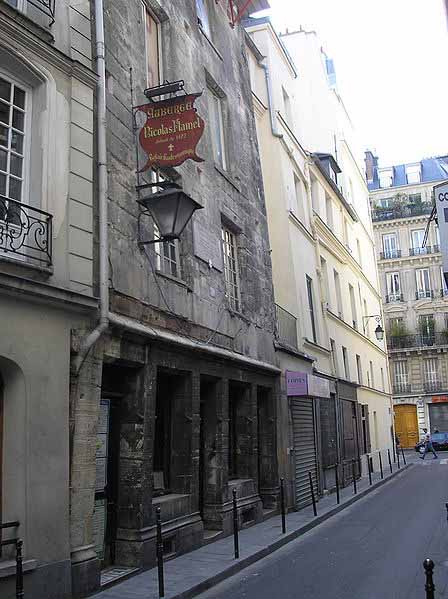
One of Flamel's houses still stands in Paris, at 51 rue de Montmorency. It is the oldest stone house in the city. There is an old inscription on the wall : We, ploughmen and women living at the porch of this house, built in 1407, are requested to say every day an "Our Father" and an "Ave Maria" praying God that His grace forgive poor and dead sinners. The ground floor currently contains a restaurant.
A Paris street near the Louvre Museum, the rue Nicolas Flamel, has been named for him; it intersects with the rue Perenelle, named for his wife.
Pernelle died first; Nicolas Flamel reached the age of eighty. He spent the last years of his life writing books on alchemy. He carefully settled his affairs and planned how he was to be buried: at the end of the nave of Saint Jacques la Boucherie. The tombstone to be laid over his body had already been made.
On this stone, in the middle of various figures, there was carved a sun above a key and a closed book. It contains the symbols of his life and can still be seen at his gravesite in the Musee de Cluny in Paris. His death, to which he joyfully looked forward, was as circumspect and as perfect as his life.
As it is equally useful to study men's weaknesses as their finest qualities, we may mark Flamel's weakness. This sage, who attached importance only to the immortality of his soul and despised the ephemeral form of the body, was inspired as he grew old with a strange taste for the sculptural representation of his body and face. Whenever he had a church built, or even restored, he requested the sculptor to represent him, piously kneeling, in a comer of the pediment of the facade.
He had himself twice sculptured on an arch in the Cemetery of the Innocents: once as he was in his youth and once old and infirm. When he had a new house built in the rue de Montmorency, on the outskirts of Paris, eleven saints were carved on the front, but a side door was surmounted with a bust of Flamel.
The bones of sages seldom rest in peace in their grave. Perhaps Nicolas Flamel knew this and tried to protect his remains by ordering a tombstone of great weight and by having a religious service held for him twelve times a year. But these precautions were useless. Hardly was Flamel dead when the report of his alchemical powers and of his concealment somewhere of an enormous quantity of gold spread through Paris and the world. Everyone who was seeking the famous projection powder, which turns all substances into gold, came prowling round all the places where he had lived in the hope of finding a minute portion of the precious powder.
It was said also that the symbolical figures which he had had sculptured on various monuments gave, for those who could decipher it, the formula of the Philosopher's Stone. There was not a single alchemist but came in pilgrimage to study the sacred science on the, stones of Saint-Jacques- la Boucherie, or the Cemetery of the Innocents. The sculptures and inscriptions were broken off under cover of darkness and removed. The cellars of his house were searched and the walls examined.
According to author Albert Poisson, towards the middle of the sixteenth century a man who had a well-known name and good credentials, which were no doubt fictitious, presented himself before the parish board of Saint-Jacques la Boucherie. He said he wished to carry out the vow of a dead friend, a pious alchemist, who, on his deathbed, had given him a sum of money with which to repair Flamel's house.
The board accepted the offer. The unknown man had the cellars ransacked under the pretext of strengthening the foundations; wherever he saw a hieroglyph he found some reason for knocking down the wall at that point. Having found nothing, he disappeared, forgetting to pay the workmen.
Not long afterwards, a Capuchin friar and a German baron are said to have discovered in the house some stone vials full of a reddish powder allegedly the projection powder.
By the seventeenth century, the various houses which had belonged to Flamel were despoiled of their ornaments and decorations, and there was nothing of them left but the four bare walls.
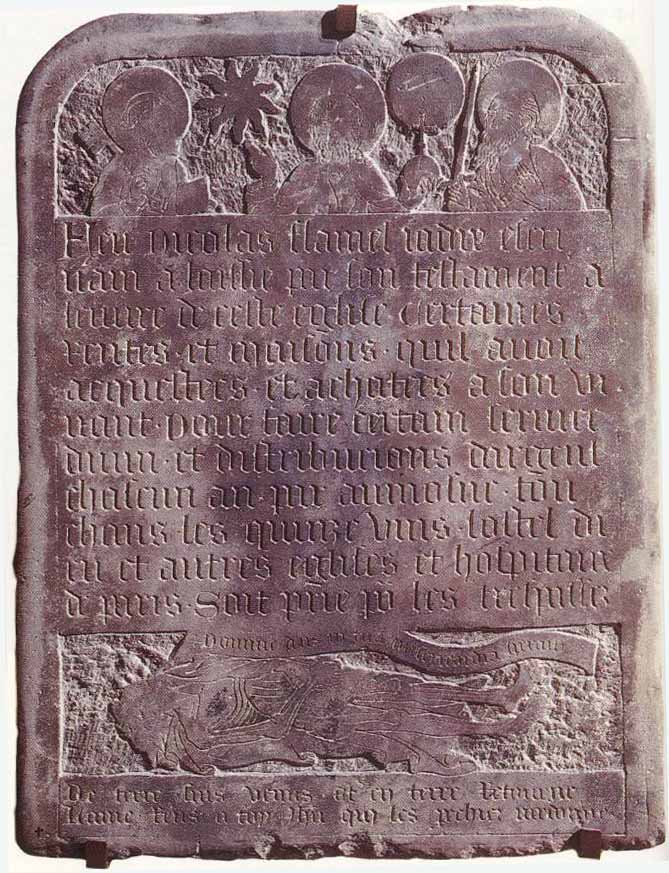
What had happened to the book of Abraham the Jew? Nicolas Flamel had bequeathed his papers and library to a nephew named Perrier, who was interested in alchemy and of whom he was very fond.
Absolutely nothing is known of Perrier. He no doubt benefited by his uncle's teachings and spent a sage's life in the munificent obscurity that Flamel prized so dearly, but had not been able altogether to maintain during the last years of his life.
For two centuries the precious heritage was handed down from father to son, without anything being heard of it. Traces of it are found again in the reign of Louis XIII.
A descendant of Flamel, named Dubois, who must still have possessed a supply of the projection powder, threw off the wise reserve of his ancestor and used the powder to dazzle his contemporaries. In the presence of the King, he changed leaden balls with it into gold.
As a result of this experiment, it is known he had many interviews with Cardinal de Richelieu, who wished to extract his secret.
Dubois, who possessed the powder but was unable to understand either Flamel's manuscripts or the book of Abraham the Jew, could tell him nothing and was soon imprisoned at Vincennes.
It was found that he had committed certain offences in the past, and this enabled Richelieu to get him condemned to death and confiscate his property for his own benefit.
At the same time the proctor of the Chitelet, no doubt by order of Richelieu, seized the houses that Flamel had owned and had them searched from top to bottom.
About this time, at the church of Saint-Jacques la Boucherie, robbers made their way in during the night, lifted Flamel's tombstone and broke open his coffin. It was after this incident that the rumor spread that the coffin had been found empty, and that it had never contained the body of Flamel, who was supposed to be still alive.
Through whatever means, it is believed Richelieu took possession of the book of Abraham the Jew. He built a laboratory at the Chateau of Rueil, which he often visited to read through the master's manuscripts and to try to interpret the sacred hieroglyphs.
But that which a sage like Flamel had been able to understand only after twenty-one years of meditation was not likely to be at once accessible to a politician like Richelieu. Knowledge of the mutations of matter, of life and death, is more complex than the art of planning strategies or administering a kingdom. Richelieu's search gave no good results.
On the death of the cardinal, all traces of the book were lost, or rather, all traces of the text, for the diagrams have often been reproduced. Indeed, the book must have been copied, for it is recorded in the seventeenth century that the author of the Tresor des Recherches et Antiquites Gauloises made a journey to Milan to see a copy which belonged to the Seigneur of Cabrieres. In any case, the mysterious book has now disappeared.
Perhaps a copy or the original itself rests under the dust of some provincial library. And it may be that a wise fate will send it at the proper time to a man who has the patience to ponder it, the knowledge to interpret it, the wisdom not to divulge it too soon.
1. I Nicholas Flamel, a scrivener of Paris, in the year 1414, in the
reign of our gracious Prince Charles VI, whom God preserve; and after
the death of my faithful partner Perenelle, am seized with a desire and a
delight, in remembrance of her, and in your behalf, dear nephew, to
write out the whole magistery of the secret of the Powder of Projection,
or the Philosophical Tincture, which God hath willed to impart to his
very insignificant servant, and which I have found out, as thou also
wilt find out in working as I shall declare unto you.
2. And for this cause do not forget to pray to God to bestow on thee the
understanding of the reason of the truth of nature, which thou wilt see
in this book, wherein I have written the secrets word for word, sheet
by sheet, and also as I have done and wrought with thy dear aunt
Perenelle, whom I very much regret.
3. Take heed before thou workest, to seek the right way as a man of
understanding. The reason of nature is Mercury, Sun and Moon, as I have
said in my book, in which are those figures which thou seest under the
arches of the Innocents at Paris. But I erred greatly upwards of 23
years and a half, in laboring without being able to marry the Moon, that
is quicksilver, to the Sun, and to extract from them the seminal dung,
which is a deadly poison; for I was then ignorant of the agent or
medium, in order to fortify the Mercury: for without this agent, Mercury
is as common water.
4. Know in what manner Mercury is to be fortified by a metallic agent,
without which it never can penetrate into the belly of the Sun and of
the Moon; afterward it must be hardened, which cannot be affected
without the sulfurous spirit of gold or silver. You must therefore first
open them with a metallic agent, that is to say with royal Saturnia,
and afterward you must actuate the Mercury by a philosophic means, that
you may afterward by this Mercury dissolve into a liquor gold and Luna,
and draw from their putrefaction the generative dung.
5. And know thou, that there is no other way nor means to work in this
art, than that which I give thee word for word; an operation, unless it
be taught as I now do, not at all easy to perform, but which on the
contrary is very difficult to find out.
6. Believe steadfastly, that the whole philosophic industry consists in
the preparation of the Mercury of the wise, for in it is the whole of
what we are seeking for, and which has always been sought for by all
ancient wise men; and that we, no more than they, have done nothing
without this Mercury, prepared with Sun or Moon: for without these
three, there is nothing in the whole world capable of accomplishing the
said philosophical and medicinal tincture. It is expedient then that we
learn to extract from them the living and spiritual seed.
7. Aim therefore at nothing but Sun, Moon and Mercury prepared by a
philosophical industry, which wets not the hands, but the metal, and
which has in itself a metallic sulfurous soul, namely, the ignited light
of sulfur. And in order that you may not stray from the right path,
apply yourself to metals; for there the aforesaid sulfur is found in
all; but thou wilt easily find it, even almost similar to gold, in the
cavern and depths of Mars, which is iron, and of Venus, which is copper,
nearly as much in the one as in the other; and even if you pay
attention to it, this sulfur has the power of tingeing moist and cold
Luna, which is fine silver, into pure yellow and good Sun; but this
ought to be done by a spiritual medium, viz. the key which opens all
metals, which I am going to make known to you. Learn therefore, that
among the minerals there is one which is a thief, and eats up all except
Sun and Moon, who render the thief very good; for when he has them in
his belly, he is good to prepare the quicksilver, as I shall presently
make known to you.
8. Therefore do not stray out of the right road, but trust to my words,
and then give thyself up to the practice, which I am going to bestow on
thee in the name of the Father, of Son, and Holy Ghost. The Practice.
9. Take thou in the first place the eldest or first-born child of
Saturn, not the vulgar, 9 parts; of the saber chalibs of the God of War,
4 parts. Put this latter into a crucible, and when it comes to a
melting redness, cast therein the 9 parts of Saturn, and immediately
this will redden the other. Cleanse thou carefully the filth that arises
on the surface of the saturnia, with saltpetre and tartar, four or five
times. The operation will be rightly done when thou seest upon the
matter an astral sign like a star.
10. Then is made the key and the saber, which opens and cuts through all
metals, but chiefly Sun, Moon and Venus, which it eats, devours and
keeps in his belly, and by this means thou art in the right road of
truth, if thou has operated properly. For this Saturnia is the royal
triumphant herb, for it is a little imperfect king, whom we raise up by a
philosophic artifice to the degree of the greatest glory and honor. It
is also the queen, that is to say the Moon and the wife of the Sun: it
is therefore both male and female, and our hermaphrodite Mercury. This
Mercury or Saturnia is represented in the seven first pages of the book
of Abraham the Jew, by two serpent encircling a golden rod. Take care to
prepare a sufficient quantity of it, for much is required, that is to
say about 12 or 13 lbs. of it, or even more, according as you wish to
work on a large or a small scale.
11. Marry thou therefore the young god Mercury, that is to say
quicksilver with this which is the philosophic Mercury, that you may
actuate by him and fortify the said running quicksilver, seven or even
ten or eleven times with the said agent, which is called the key, or a
steel sharpened saber, for it cuts, scythes and penetrates all the
bodies of the metals. Then wilt thou have the double and treble water
represented by the rose tree in the book of Abraham the Jew, which
issues out of the foot of an oak, namely our Saturnia, which is the
royal key, and goes to precipitate itself into the abyss, as says the
same author, that is to say, into the receiver, adapted to the neck of
the retort, where the double Mercury throws itself by means of a
suitable fire.
12. But here are found thorns and insuperable difficulties, unless God
reveals this secret, or a master bestows it. For Mercury does not marry
with royal Saturnia: it is experient to find a secret means to unite
them: for unless thou knowest the artifice by which this union and peace
are effected between these aforesaid argent-vives, you will do nothing
to any purpose. I would not conceal any thing from thee, my dear nephew;
I tell thee, therefore, that without Sun or Moon this work will profit
thee nothing. Thou must therefore cause this old man, or voracious wolf,
to devour gold or silver in the weight and measure as I am now about to
inform thee. Listen therefore to my words, that thou mayest not err, as
I have done in this work. I say, therefore, that you must give gold to
our old dragon to eat. Remark how well you ought to operate. For if you
give but little gold to the melted Saturnia, the gold is indeed opened,
but the quicksilver will not take; and here is an incongruity, which is
not at all profitable. I have a long while and greatly labored in this
affliction, before I found out the means to succeed in it. If therefore
you give him much gold to devour, the gold will not indeed be so much
opened nor disposed, but then it will take the quicksilver, and they
will both marry. Thus the means is discovered. Conceal this secret, for
it is the whole, and neither trust it to paper, or to any thing else
which may be seen. For we should become the cause of great mischief. I
give it thee under the seal of secrecy and of thy conscience, for the
love I bear thee.
13. Take thou ten ounces of the red Sun, that is to so say, very fine,
clean and purified nine or ten times by means of the voracious wolf
alone: two ounces of the royal Saturnia; melt this in a crucible, and
when it is melted, cast into it the ten ounces of fine gold; melt these
two together, and stir them with a lighted charcoal. Then will thy gold
be a little opened. Pour it on a marble slab or into an iron mortar,
reduce it to a powder, and grind it well with three pounds of
quicksilver. Make them to curd like cheese, in the grinding and working
them to and fro: wash this amalgama with pure common water until it
comes out clear, and that the whole mass appears clear and white like
fine Luna. The conjunction of the gold with the royal golden Saturnia is
effected, when the mass is soft to the touch like butter.
14. Take this mass, which thou wilt gently dry with linen or fine cloth,
with great care: this is our lead, and our mass of Sun and Moon, not
the vulgar, but the philosophical. Put it into a good retort of crucible
earth, but much better of steel. Place the retort in a furnace, and
adapt a receiver to it: give fire by degrees. Two hours after increase
your fire so that the Mercury may pass into the receiver: this Mercury
is the water of the blowing rose-tree; it is also the blood of the
innocents slain in the book of Abraham the Jew. You may now suppose that
this Mercury has eat up a little of the body of the king, and that it
will have much more strength to dissolve the other part of it hereafter,
which will be more covered by the body of the Saturnia. Thou has now
ascended one degree or step of the ladder of the art.
15. Take the feces out of the retort; melt them in a crucible in a
strong fire: cast into it four ounces of the Saturnia, (and) nine ounces
of the Sun. Then the Sun is expanded in the said feces, and much more
opened that at the first time, as the Mercury has more vigor than
before, it will have the strength and virtue of penetrating the gold,
and of eating more of it, and of filling his belly with it by degrees.
Operate therefore as at first; marry the aforesaid Mercury, stronger one
degree with this new mass in grinding the whole together; they will
take like butter and cheese; wash and grind them several times, until
all the blackness is got out: dry it as aforesaid; put the whole into
the retort, and operate as thou didst before, by giving during two
hours, a weak fire, and then strong, sufficient to drive out, and cause
the Mercury to fall into the receiver; then wilt thou have the Mercury
still more actuated, and thou wilt have ascended to the second degree of
the philosophic ladder.
16. Repeat the same work, by casting in the Saturnia in due weight, that
is to say, by degrees, and operating as before, till thou hast reached
the 10th step of the philosophic ladder; then take thy rest. For the
aforesaid Mercury is ignited, actuated, wholly engrossed and full of the
male sulfur, and fortified with the astral juice which was in the deep
bowels of the gold and of our saturnine dragon. Be assured that I am now
writing for thee things which by no philosopher was ever declared or
written. For this Mercury is the wonderful caduceus, of which the sages
have so much spoken in their books, and which they attest has the power
of itself of accomplishing the philosophic work, and they say the truth,
as I have done it myself by it alone, and thou wilt be enabled to do it
thyself, if thou art so disposed: for it is this and none else which is
the proximate matter and the root of all the metals.
17. Now is done and accomplished the preparation of the Mercury,
rendered cutting and proper to dissolve into its nature gold and silver,
to work out naturally and simply the Philosophic Tincture, or the
powder transmuting all metals into gold and silver.
18. Some believe they have the whole magistery, when they have the
heavenly Mercury prepared; but they are grossly deceived. It is for this
cause they find thorns before they pluck the rose, for want of
understanding. It is true indeed, that were they to understand the
weight, the regimen of the fire, and the suitable way, they would not
have much to do, and could not fail even if they would. But in this art
there is a way to work. Learn therefore and observe well how to operate,
in the manner I am about to relate to you.
19. In the name of God, thou shalt take of thy animated Mercury what
quantity thou pleasest; thou wilt put it into a glass vessel by itself;
or two or four parts of the Mercury with two parts of the golden
Saturnia; that is to say, one of the Sun and two of the Saturnia; the
whole finely conjoined like butter, washed, cleansed and dried; and thou
wilt lute thy vessel with the lute of wisdom. Place it in a furnace on
warm ashes at the degree of the heat of an hen sitting on her eggs.
Leave this said Mercury so prepared to ascend and descend for the space
of 40 or 50 days, until thou seest forming in thy vessel a white or red
sulfur, called philosophic sublimate, which issues out of the reins of
the said Mercury. Thou wilt collect this sulfur with a feather: it is
the living Sun and the living Moon, which Mercury begets out of itself.
20. Take this white or red sulfur, triturate it in a glass or marble
mortar, and pour on it, in sprinking it, a third part of its weight of
the Mercury from which this sulfur has been drawn. With these two make a
paste like butter: put again this mixture into an oval glass; place it
in a furnace on a suitable fire of ashes, mild, and disposed with a
philosophic industry. Concoct until the said Mercury is changed into
sulfur, and during this coction, thou wilt see wonderful things in thy
vessel, that is to say, all the colors which exist in the world, which
thou canst not behold without lifting up thy heart to God in gratitude
for so great a gift.
21. When thou has attained to the purple red, thou must gather it: for
then the alchymical powder is made, transmuting every metal into fine
pure and neat gold, which thou maist multiply by watering it as thou
hast already done, grinding it with fresh Mercury, concocting it in the
same vessel, furnace and fire, and the time will be much shorter, and
its virtue ten times stronger.
22. This then is the whole magistry done with Mercury alone, which some
do not believe to be true, because they are weak and stupid, and not at
all able to comprehend this work.
23. Shouldest thou desire to operate in another way, take of fine Sun in
fine powder or in very thin leaves: make a paste of it with seven parts
of thy philosophic Mercury, which is our Luna: put them both into an
oval glass vessel well luted; place it in a furnace; give a very strong
fire, that is to say, such as will keep lead in fusion; for then thou
has found out the true regimen of the fire; and let thy Mercury, which
is the philosophical wind, ascend and descend on the body of the gold,
which it eats up by degrees, and carries in its belly. Concoct it until
the gold and Mercury do no more ascend and descend, but both remain
quiet, and then will peace and union be effected between the two
dragons, which are fire and water both together.
24. Then wilt thou see in thy vessel a great blackness like that of
melted pitch, which is the sign of the death and putrefaction of the
gold, and the key of the whole magistery. Cause it therefore to
resuscitate by concocting it, and be not weary with concocting it:
during this period divers changes will take place; that is to say, the
matter will pass through all the colors, the black, the ash color, the
blue, the green, the white, the orange, and finally the red as red as
blood or the crimson poppy: aim only at this last color; for it is the
true sulfur, and the alchymical powder. I say nothing precisely about
the time; for that depends on the industry of the artist; but thou canst
not fail, by working as I have shown.
25. If thou are disposed to multiply thy powder, take one part thereof,
and water it with two parts of thy animated Mercury; make it into a soft
and smooth paste; put it in a vessel as thou hast already done, in the
same furnace and fire, and concoct it. This second turn of the
philosophic wheel will be done in less time than the first, and thy
powder will have ten times more strength. Let is wheel about again even a
thousand times, and as much as thou wilt. Thou wilt then have a
treasure without price, superior to all there is in the world, and thou
canst desire nothing more here below, for thou hast both health and
riches, if thou useth them properly.
26. Thou hast now the treasure of all worldly felicity, which I a poor
country clown of Pointoise did accomplish three times in Paris, in my
house, in the street des Ecrivains, near the chapel of St. Jacques de la
Boucherie, and which I Flammel give thee, for the love I bear thee, to
the honour of God, for His glory, for the praise of Father, Son, and
Holy Spirit.
References:
New Advent Encyclopedia
Nicholas Flamel
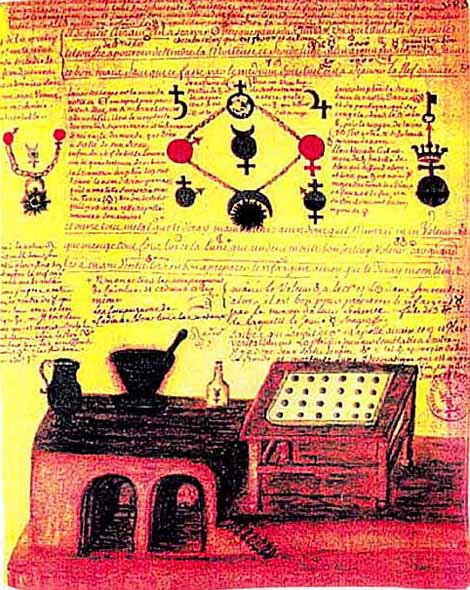
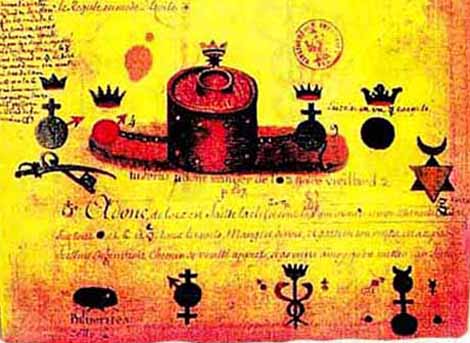
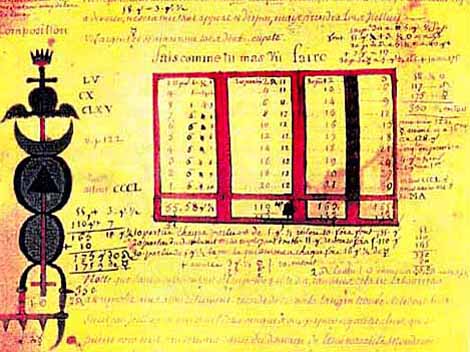


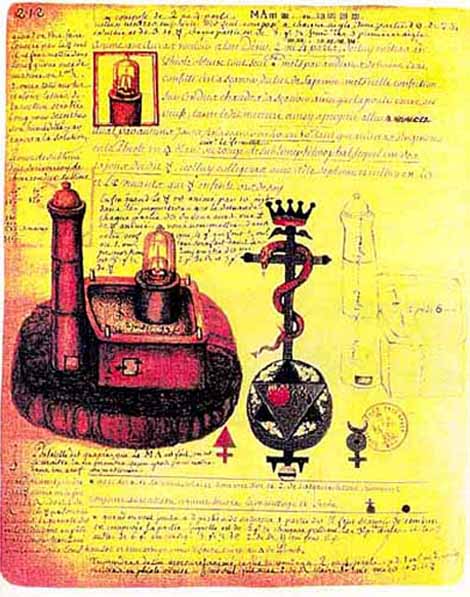
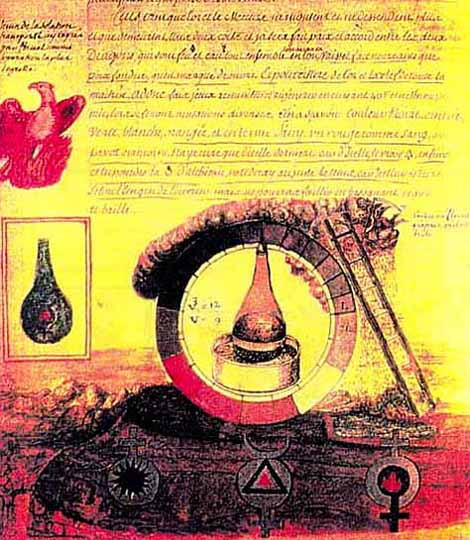
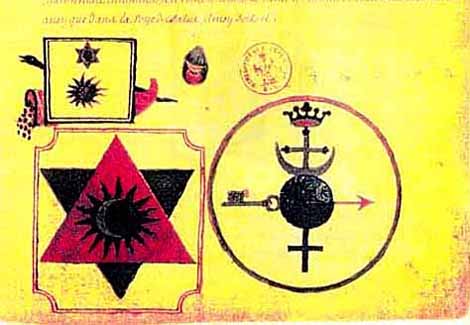
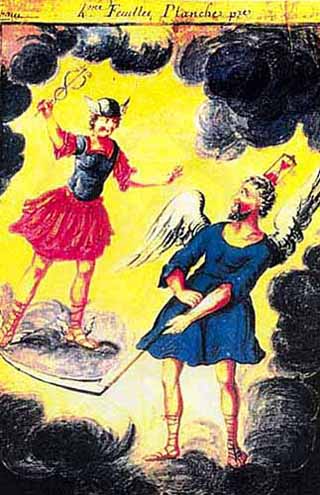
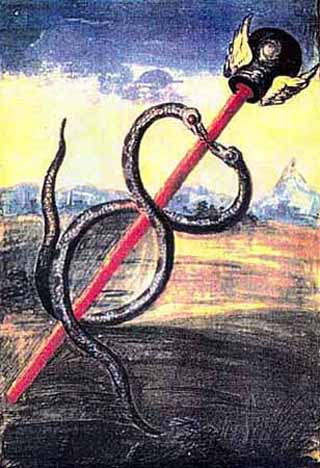
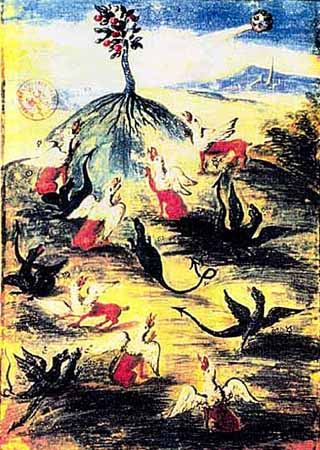
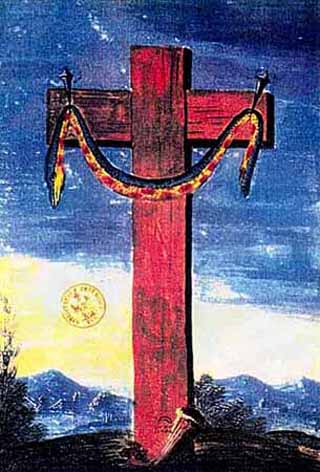
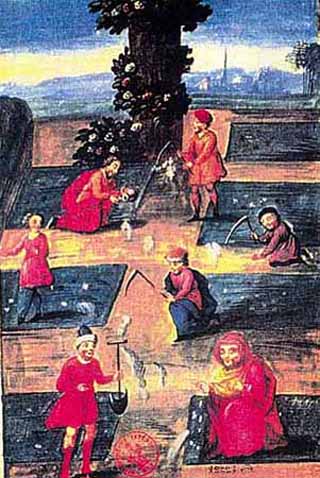
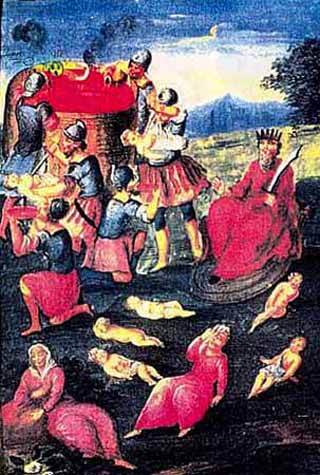
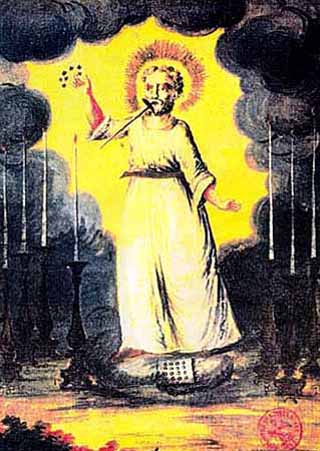
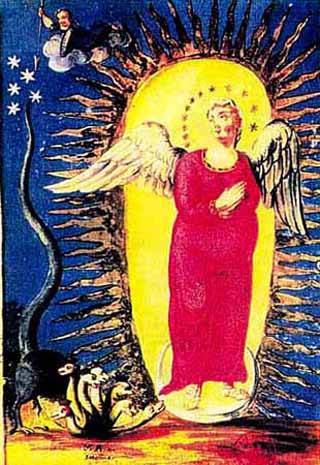
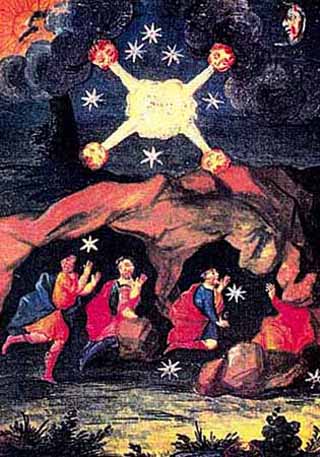
Basil Valentine
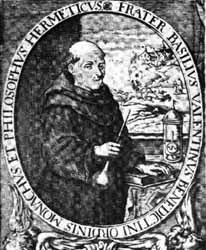
Records of the life of Basilius Valentinus, the Benedictine monk who for his achievements in the chemical sphere has been given the title of Father of Modern Chemistry, are a mass of conflicting evidence. Many and varied are the accounts of his life, and historians seem quite unable to agree as to his exact identity, or even as to the century in which he lived. It is generally believed, however, that 1394 was the year of his birth, and that he did actually join the Benedictine Brotherhood, eventually becoming Canon of the Priory of St. Peter at Erfurt, near Strasburg, although even these facts cannot be proved.
Whatever his identity, Basil Valentine was undoubtedly a great chemist, and the originator of many chemical preparations of the first importance. Amongst these are the preparation of spirit of salt, or hydrochloric acid from marine salt and oil of vitriol (sulphuric acid) the extraction of copper from its pyrites (sulphur) by transforming it firstly into copper sulphate, and then plunging a bar of iron in the watery dissolution of this product: the method of producing sulpho-ether by the distillation of a mixture of spirit of wine and oil of vitriol: the method of obtaining brandy by the distillation of wine and beer, rectifying the distillation on carbonate of potassium.
In his writings he has placed on record many valuable facts, and whether Basil Valentine is the correct name of the author or an assumed one matters little, since it detracts nothing from the value of his works, or the calibre of his practical experiments. From his writings one gathers that he was indeed a monk, and also the possessor of a mind and understanding superior to that of the average thinker of his day.
The ultimate intent and aim of his studies was undoubtedly to prove that perfect health in the human body is attainable, and that the perfection of all metallic substance is also possible. He believed that the physician should regard his calling in the nature of a sacred trust, and was appalled by the ignorance of the medical faculty of the day whose members pursued their appointed way in smug complacency, showing little concern for the fate of their patients once they had prescribed their pet panacea.
On the subject of the perfection of metallic bodies, as in his reference to the Spagyric Art, the Grand Magi-strum, the Universal Medicine, the Tinctures to transmute metals and other mysteries of the alchemist's art, he has completely mystified not only the lay reader, but the learned chemists of his own and later times. In all his works the important key to a laboratory process is apparently omitted. Actually, however, such a key is invariably to be found in some other part of the writings, probably in the midst of one of the mysterious theological discourses which he was wont to insert among his practical instructions, so that it is only by intensive study that the mystery can be unravelled.
His most famous work is his Currus Triumphalis Antimonii - The Triumphal Chariot of Antimony.
It has been translated into German, French, and English, and has done more to establish his reputation as a chemist than any other. The best edition is undoubtedly that published at Amsterdam in 1671 with a commentary by Theodorus Kerckringius. In his preface Kerckringius states that he had actually spoken with Valentine besides studying his works. He speaks of Basil as 'the prince of all chemists', and the most learned, upright, and lucid of all alchemistic writers. He tells the careful student everything that can be known in alchemy; of this I can most positively assure you.'
A perusal of this book makes it quite evident that Valentine had investigated very thoroughly the properties of antimony, and the findings on his experimental work with this metal have.been brought forward as recent discoveris by chemists of our day.
His other works are The Twelve Keys - The Medicine of Metals - Of Things Natural and Supernatural - Of the First Tincture, Root and Spirit of Metals - and his Last Will and Testament.
It is alleged that this last work remained concealed for a number of years within the High Altar of the church belonging to the Priory. Such a story is quite feasible, since alchemists both before and after this era, deeming their works unfit for the age in which they were written, are known to have buried or otherwise secreted their writings for the discovery and benefit, as they doubtless hoped, of a more deserving and more enlightened age. Such manuscripts would very often not be discovered for several generations after the death of the author.
In view of his other outstanding achievements as a chemist of great ability, it seems not illogical to suppose that Valentine's Universal Method of Medicine should be capable of achieving as great a measure of success as his other somewhat more prosaic discoveries.
The Twelve Keys of Basilius Valentinus
with which we may open the doorsof the knowledge of theMost Ancient Stone and unseal the Most Secret Fountain of Health.
Key One
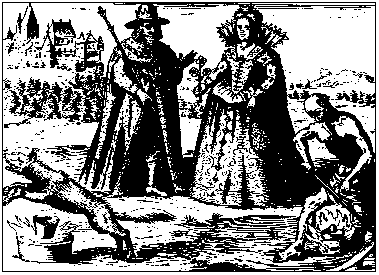
Let my friend know that no impure or spotted things are useful for our purpose. For there is nothing in their leprous nature capable of advancing the interests of our Art There is much more likelihood of that which is in itself good being spoiled by that which is impure. Everything that is obtained from the mines has its value, unless, indeed, it is adulterated. Adulteration, however, spoils its goodness and its efficacy.
As the physician purges and cleanses the inward parts of the body, and removes all unhealthy matter by means of his medicines, so our metallic substances must be purified and refined of all foreign matter, in order to ensure the success of our task. Therefore, our Masters require a pure, immaculate body, that is untainted with any foreign admixture, which admixture is the leprosy of our metals.
Let the diadem of the King be of pure gold, and let the Queen that is united to him in wedlock be chaste and immaculate.
If you would operate by means of our bodies, take a fierce grey wolf, which, though on account of its name it be subject to the sway of warlike Mars, is by birth the offspring of ancient Saturn, and is found in the valleys and mountains of the world, where he roams about savage with hunger. Cast to him the body of the King, and when he has devoured it, burn him entirely to ashes in a great fire. By this process the King will be liberated; and when it has been performed thrice the Lion has overcome the wolf, and will find nothing more to devour in him. Thus our Body has been rendered fit for the first stage of our work.
Know that this is the only right and legitimate way of purifying our substance: for the Lion purifies himself with the blood of the wolf, and the tincture of its blood agrees most wonderfully with the tincture of the Lion, seeing that the two liquids are closely akin to each other. When the Lion's hunger is appeased, his spirit becomes more powerful than before, and his eyes glitter like the Sun. His internal essence is now of inestimable value for the removing of all defects, and the healing of all diseases. He is pursued by the ten lepers, who desire to drink his blood; and all that are tormented with any kind of sickness are refreshed with this blood.
For whoever drinks of this golden fountain, experiences a renovation of his whole nature, a vanishing of all unhealthy matter, a fresh supply of blood, a strengthening of the heart and of all the vitals, and a permanent bracing of every limb. For it opens all the pores, and through them bears away all that prevents the perfect health of the body, but allows all that is beneficial to remain therein unmolested.
But let my friend be scrupulously careful to preserve the fountain of life limpid and clear. If any strange water be mixed with it, it is spoiled, and becomes positively injurious. If it still retain any of the solvent which has been used for its dissolution, you must carefully purge it off. For no corrosive can be of the least use for the prevention of internal diseases.
When a tree is found to bear sour and unwholesome fruit, its branches must be cut off, and scions of better trees grafted upon it. The new branches thereupon become organically united to the trunk; but though nourished with its sap, they thence forward produce good and pleasant fruit.
The King travels through six regions in the heavenly firmament, and in the seventh he fixes his abode. There the royal palace is adorned with golden tapestry. If you understand my meaning, this Key will open the first lock, and push back the first bolt; but if you do not, no spectacles or natural eyesight will enable you to understand what follows. But Lucius Papirius has instructed me not to say any more about this Key.
Key Two
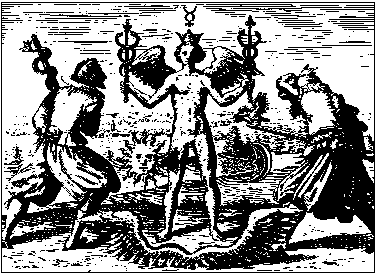
In the houses of the great are found various kinds of drink, of which scarcely two are exactly like each other in odour, colour, or taste. For they are prepared in a great variety of different ways. Nevertheless they are all drunk, and each is designed for its own special use. When the Sun gives out his rays, and sheds them abroad upon the clouds, it is commonly said that he is attracting water, and if he do it frequently, and thereby cause rain, it is called a fruitful year.
If it be intended to build a palace, the services of many different craftsmen must be employed, and a great variety of materials is required. Otherwise the palace would not be worthy the name. It is useless to use wood where stone is necessary.
The daily ebb and flow of the sea, which are caused by the sympathetic influence of heavenly bodies, impart great wealth and blessing to the earth. For whenever the water comes rolling back, it brings a blessing with it.
A bride, when she is to be brought forth to be married, is gloriously adorned in a great variety of precious garments, which, by enhancing her beauty, render her pleasant in the eyes of the bridegroom. But the rites of the bridal night she performs without any clothing but that which she was arrayed withal at the moment of her birth.
In the same way our bridal pair, Apollo and Diana, are arrayed in splendid attire, and their heads and bodies are washed with various kinds of water, some strong, some weak, but not one of them exactly like another, and each designed for its own special purpose. Know that when the moisture of the earth ascends in the form of a vapour, it is condensed in the upper regions, and precipitated to the earth by its own weight. Thus the earth regains the moisture of which it had been deprived, and receives strength to put forth buds and herbs. In the same way you must repeatedly distil the water which you have extracted from the earth, and then again restore it to your earth, as the water in the Strait of Euripus frequently leaves the shore, and then covers it again until it arrives at a certain limit.
When thus the palace has been constructed by the hands of many craftsmen, and the sea of glass has absolved its course, and filled the palace with good things, it is ready for the King to enter, and take his seat upon the throne. But you should notice that the King and his spouse must be quite naked when they are joined together. They must be stripped of all their glorious apparel, and must lie down together in the same state of nakedness in which they were born, that their seed may not be spoiled by being mixed with any foreign matter.
Let me tell you, in conclusion, that the bath in which the bridegroom is placed, must consist of two hostile kinds of matter, that purge and rectify each other by means of a continued struggle. For it is not good for the Eagle to build her nest on the summit of the Alps, because her young ones are thus in great danger of being frozen to death by the intense cold that prevails there.
But if you add to the Eagle the icy Dragon that has long had its habitation upon the rocks, and has crawled forth from the caverns of the earth, and place both over the fire, it will elicit from the icy Dragon a fiery spirit, which, by means of its great heat, will consume the wings of the Eagle, and prepare a perspiring bath of so extraordinary a degree of heat that the snow will melt upon the summit of the mountains, and become a water, with which the invigorating mineral bath may be prepared, and fortune, health, life, and strength restored to the King.
Key Three
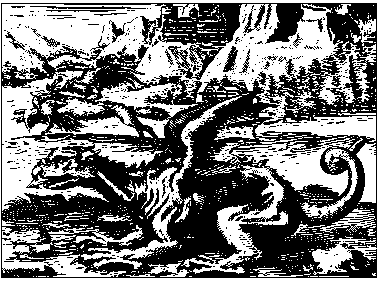
By means of water fire may be extinguished, and utterly quenched. If much water be poured upon a little fire, the fire is overcome, and compelled to yield up the victory to the water. In the same way our fiery sulphur must be overcome by means of our prepared water. But, after the water has vanished, the fiery life of our sulphurous vapour must triumph, and again obtain the victory. But no such triumph can take place unless the King imparts great strength and potency to his water and tinges it with his own colour, that thereby he may be consumed and become invisible, and then again recover his visible form, with a diminution of his simple essence, and a development of his perfection.
A painter can set yellow upon white, and red or crimson upon yellow; for, though all these colours are present, yet the latter prevails on account of its greater intensity. When you have accomplished the same thing in our Art, you have before your eyes the light of wisdom, which shines in the darkness, although it does not burn. For our sulphur does not burn, but nevertheless its brilliancy is seen far and near. Nor does it colour anything until it has been prepared, and dyed with its own colour, which it then imparts to all weak and imperfect metals. This sulphur, however, cannot impart this colour until it have first by persevering labour been prevailed upon to abjure its original colour.
For the weaker does not overcome the stronger, but has to yield the victory to it. The gist of the whole matter lies in the fact that the small and weak cannot aid that which is itself small and weak, and a combustible substance cannot shield another substance from combustion. That which is to protect another substance against combustion must itself be safe from danger. The latter must be stronger than the former, that is to say, it must itself be essentially incombustible. He, then, who would prepare the incombustible sulphur of the Sages, must look for our sulphur in a substance in which it is incombustible -- which can only be after its body has been absorbed by the salt sea, and again rejected by it.
Then it must be so exalted as to shine more brightly than all the stars of heaven, and in its essence it must have an abundance of blood, like the Pelican, which wounds its own breast, and, without any diminution of its strength, nourishes and rears up many young ones with its blood. This Tincture is the Rose of our Masters, of purple hue, called also the red blood of the Dragon, or the purple cloak many times folded with which the Queen of Salvation is covered, and by which all metals are regenerated in colour.
Carefully preserve this splendid mantle, together with the astral salt which is joined to this sulphur, and screens it from harm. Add to it a sufficient quantity of the volatility of the bird; then the Cock will swallow the Fox, and, having been drowned in the water, and quickened by the fire, will in its turn be swallowed by the Fox.
Key Four
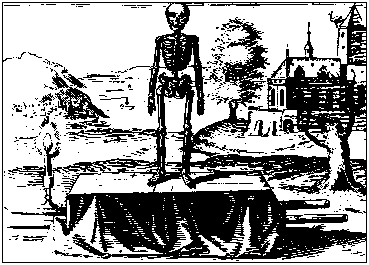
All flesh that is derived from the earth, must be decomposed and again reduced to earth; then the earthy salt produces a new generation by celestial resuscitation. For where there was not first earth, there can be no resurrection in our Magistery. For in earth is the balm of Nature, and the salt of the Sages.
At the end of the world, the world shall be judged by fire, and all those things that God has made of nothing shall by fire be reduced to ashes, from which ashes the Phoenix is to produce her young. For in the ashes slumbers a true and genuine tartaric substance, which, being dissolved, will enable us to open the strongest bolt of the royal chamber.
After the conflagration, there shall be formed a new heaven and a new earth, and the new man will be more noble in his glorified state than he was before.
When the sand and ashes have been well matured and ripened with fire, the glass-blower makes out of it glass, which remains hard and firm in the fire, and in colour resembles a crystal stone. To the uninitiated this is a great mystery, but not to the master whom long experience has familiarized with the process.
Out of stones the master also prepares lime by burning which is very useful for our work- But before they are prepared with fire, they are mere stones. The stone must be matured and rendered fervent with fire, and then it becomes so potent that few things are to be compared to the fiery spirit of lime.
By burning anything to ashes you may gain its salt. If in this dissolution the sulphur and mercury be kept apart, and restored to its salt, you may once more obtain that form which was destroyed by the process of combustion. This assertion the wise of this world denounce as the greatest folly, and count as a rebellion, saying that such a transformation would amount to a new creation, and that God has denied such creative power to sinful man. But the folly is all on their side. For they do not understand that our Artist does not claim to create anything, but only to evolve new things from the seed made ready to his hand by the Creator.
If you do not possess the ashes, you will be unable to obtain our salt; and without our salt you will not be able to impart to our substance a bodily form; for the coagulation of all things is produced by salt alone.
As salt is the great preserving principle that protects all things from decay, so the Salt of our Magistery preserves metal from decomposition and utter annihilation. If their Balm were to perish, and the Spirit to leave the body, the body would be quite dead, and no longer available for any good purpose. The metallic spirit would have departed, and would have left its habitation empty, bare, and lifeless.
Observe also, thou who art a lover of this Art, that the salt that is gained from ashes has great potency, and possesses many concealed virtues. Nevertheless, the salt is unprofitable, until its inward substance has been extracted. For the spirit alone gives strength and life. The body by itself profits nothing. If you know how to find this spirit, you have the Salt of the Sages, and the incombustible oil, concerning which many things have been written before my time.
Have sought for me with eagerness,
Yet very few succeed at length
In finding out my secret virtue.
Key Five
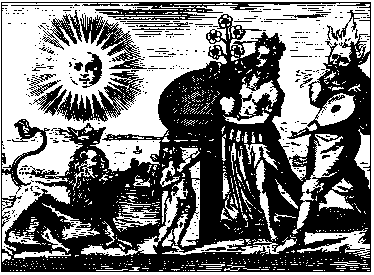
The quickening power of the earth produces all things that grow forth from it, and he who says that the earth has no life makes a statement which is flatly contradicted by the most ordinary facts. For what is dead cannot produce life and growth, seeing that it is devoid of the quickening spirit. This spirit is the life and soul that dwell in the earth, and are nourished by heavenly and sidereal influences. For all herbs, trees, and roots, and all metals and minerals, receive their growth and nutriment from the spirit of the earth, which is the spirit of life. This spirit is itself fed by the stars, and is thereby rendered capable of imparting nutriment to all things that grow, and of nursing them as a mother does her child while it is yet in the womb. The minerals are hidden in the womb of the earth, and nourished by her with the spirit which she receives from above.
Thus the power of growth that I speak of is imparted not by the earth, but by the life-giving spirit that is in it. If the earth were deserted by this spirit, it would be dead, and no longer able to afford nourishment to anything. For its sulphur or richness would lack the quickening spirit without which there can be neither life nor growth.
Two contrary spirits can scarcely dwell together, nor do they easily combine. For when a thunderbolt blazes amidst a tempest of rain, the two spirits, out of which it is formed, fly from one another with a great shock and noise, and circle in the air, so that no one can know or say whither they go, unless the same has been ascertained by experience as to the mode in which these spirits manifest.
Know then, gentle Reader, that life is the only true spirit, and that that which the ignorant herd look upon as dead may be brought back to permanent, visible, and spiritual life, if but the spirit be restored to the body -- the spirit which is supported by heavenly nutriment, and derived from heavenly, elementary, and earthly substances, which are also called formless matter.
Moreover, as iron has its magnet which draws it with the invisible bonds of love, so our gold has its magnet, viz., the first Matter of the great Stone. If you understand these my words, you are richer and more blessed than the whole world.
Let me conclude this chapter with one more remark. When a man looks into a mirror, he sees therein reflected an image of himself. If, however, he try to touch it, he will find that it is not palpable, and that he has laid his hand upon the mirror only. In the same way, the spirit which must be evolved from this Matter is visible, but not palpable. This spirit is the root of the life of our bodies, and the Mercury of the Philosophers, from which is prepared the liquid water of our Art - the water which must once more receive a material form, and be rectified by means of certain purifying agents into the most perfect Medicine. For we begin with a firm and palpable body, which subsequently becomes a volatile spirit, and a golden water, without any conversion, from which our Sages derive their principle of life. Ultimately we obtain the indestructible medicine of human and metallic bodies, which is fitter to be known to angels than to men, except such as seek it at God's hands in heartfelt prayer, and give genuine proofs of their gratitude by service rendered to Him, and to their needy neighbour.
Hereunto I may add, in conclusion, that one work is developed from another. First, our Matter should be carefully purified, then dissolved, destroyed, decomposed, and reduced to dust and ashes. Thereupon prepare from it a volatile spirit, which is white as snow, and another volatile spirit, which is red as blood. These two spirits contain a third, and are yet but one spirit. Now these are the three spirits which preserve and multiply life. Therefore unite them, give them the meat and drink that Nature requires, and keep them in a warm chamber until the perfect birth takes place. Then you will see and experience the virtue of the gift bestowed upon you by God and Nature. Know, also, that hitherto my lips have not revealed this secret to any one, and that God has endowed natural substances with greater powers than most men are ready to believe.
Upon my mouth God has set a seal, that there might be scope for others after me to write about the wonderful things of Nature, which by the foolish are looked upon as unnatural. For they do not understand that all things are ultimately traceable to supernatural causes, but nevertheless are, in this present state of the world, subject to natural conditions.
Key Six
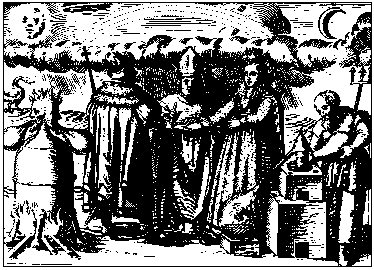
The male without the female is looked upon as only half a body, nor can the female without the male be regarded as more complete For neither can bring forth fruit so long as it remains alone. But if the two be conjugally united, there is a perfect body, and their seed is placed in a condition in which it can yield increase.
If too much seed be cast into the field, the plants impede each other's growth, and there can be no ripe fruit. But if, on the other hand, too little be sown, weeds spring up and choke it.
If a merchant would keep a clear conscience, let him give just measure to his neighbor. If his measure and weight be not short, he will receive praise from the poor.
In too much water you may easily be drowned; too little water, on the other hand, soon evaporates in the heat of the sun.
If, then, you would attain the longed-for goal, observe just measure in mixing the liquid substance of the Sages, lest that which is too much overpower that which is too little, and the generation be hindered. For too much rain spoils the fruit, and too much drought stunts its growth. Therefore, when Neptune has prepared his bath, measure out carefully the exact quantity of permanent water needed, and let there be neither too little nor too much.
The twofold fiery male must be fed with a snowy swan, and then they must mutually slay each other and restore each other to life; and the air of the imprisoned fiery male will occupy three of the four quarters of the world, and make up three parts of the imprisoned fiery male, that the death-song of the swans may be distinctly heard; then the swan roasted will become food for the King, and the fiery King will be seized with great love towards the Queen, and will take his fill of delight in embracing her, until they both vanish and coalesce into one body.
It is commonly said that two can overpower one, especially if they have sufficient room for putting forth their strength. Know also that there must come a twofold wind, and a single wind, and that they must furiously blow from the east and from the south. lf, when they cease to rage, the air has become water, you may be confident that the spiritual will also be transmuted into a bodily form, and that our number shall prevail through the four seasons in the fourth part of the sky (after the seven planets have exercised power), and that its course will be perfected by the test of fire in the lowest chamber of our palace, when the two shall overpower and consume the third.
For this part of our Magistery skill is needed, in order to divide and compound the substances aright, so that the art may result in riches, and the balance may not be falsified by unequal weights. The sky we speak of is the sky of our Art, and there must be justly proportioned parts of our air and earth, our true water and our palpable fire.
Key Seven
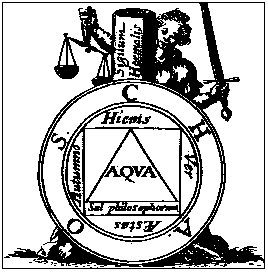
Natural heat preserves the life of man. If his body lose its natural heat his life has come to an end.
A moderate degree of natural heat protects against the cold; an excess of it destroys life. It is not necessary that the substance of the Sun should touch the earth. The Sun can heat the earth by shedding thereon its rays, which are intensified by reflection. This intermediate agency is quite sufficient to do the work of the Sun, and to mature everything by coction. The rays of the Sun are tempered with the air by passing through it so as to operate by the medium of the air, as the air operates through the medium of the fire.
Earth without water can produce nothing, nor can water quicken anything into growth without earth; and as earth and water are mutually indispensable in the production of fruit, so fire cannot operate without air, or air without fire. For fire has no life without air; and without fire air possesses neither heat nor dryness.
When its fruit is about to be matured, the vine stands in greater need of the Sun's warmth than in the spring; and if the Sun shine brightly in the autumn, the grapes will be better than if they had not felt his autumnal warmth.
In the winter the multitude suppose everything to be dead, because the earth is bound in the chains of frost, so that nothing is allowed to sprout forth. But as soon as the spring comes, and the cold is vanquished by the power of the Sun, everything is restored to life, the trees and herbs put forth buds, leaves, and blossoms, the hibernating animals creep forth from their hiding places, the plants give out a sweet fragrance, and are adorned with a great variety of many coloured flowers; and the summer carries on the work of the spring, by changing its flowers into fruit.
Thus, year by year, the operations of the universe are performed, until at length it shall be destroyed by its Creator, and all the dwellers upon earth shall be restored by resurrection to a glorified life. Then the operations of earthly nature shall cease, and the heavenly and eternal dispensation shall take its place.
When the Sun in the winter pursues his course far away from us, he cannot melt the deep snow. But in the summer he approaches nearer to us, the quality of the air becomes more fiery, and the snow melts and is transmuted by warmth into water. For that which is weak is always compelled to yield to that which is strong.
The same moderate course must be adopted in the fiery regimen of our Magistery. For it is all important that the liquid should not be dried up too quickly, and that the earth of the Sages should not be melted and dissolved too soon, otherwise your fishes would be changed into scorpions. If you would perform our task rightly, take the spiritual water, in which the spirit was from the beginning, and preserve it in a closely shut chamber. For the heavenly city is about to be besieged by earthly foes.
You must, therefore, strongly fortify it with three impassable and well-guarded walls, and let the one entrance be well protected. Then light the lamp of wisdom and seek with it the gross thing that was lost, shewing only such light as is needed. For you must know that the worms and reptiles dwell in the cold and humid earth, while man has his proper habitation upon the face of the earth; the bodies of angels, on the other hand, not being alloyed with sin or impurity, are injured by no extreme either of heat or cold. When man shall have been glorified, his body will become like the angelic body in this respect. If we carefully cultivate the life of our souls, we shall be sons and heirs of God, and shall be able to do that which now seems impossible. But this can be effected only by the drying up of all water, and the purging of heaven and earth and all men with fire.
The same moderate course must be adopted in the fiery regimen of our Magistery. For it is all important that the liquid should not be dried up too quickly, and that the earth of the Sages should not be melted and dissolved too soon, otherwise your fishes would be changed into scorpions. If you would perform our task rightly, take the spiritual water, in which the spirit was from the beginning, and preserve it in a closely shut chamber. For the heavenly city is about to be besieged by earthly foes.
You must, therefore, strongly fortify it with three impassable and well-guarded walls, and let the one entrance be well protected. Then light the lamp of wisdom and seek with it the gross thing that was lost, shewing only such light as is needed. For you must know that the worms and reptiles dwell in the cold and humid earth, while man has his proper habitation upon the face of the earth; the bodies of angels, on the other hand, not being alloyed with sin or impurity, are injured by no extreme either of heat or cold. When man shall have been glorified, his body will become like the angelic body in this respect. If we carefully cultivate the life of our souls, we shall be sons and heirs of God, and shall be able to do that which now seems impossible. But this can be effected only by the drying up of all water, and the purging of heaven and earth and all men with fire
Key Eight
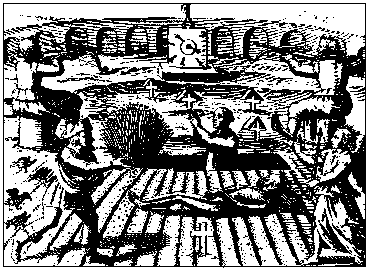
Neither human nor animal bodies can be multiplied or propagated without decomposition; the grain and all vegetable seed, when cast into the ground, must decay before it can spring up again; moreover, putrefaction imparts life to many worms and other animalculae. The process of augmentation and quickening is mostly performed in the earth, while it is caused by spiritual seed through the other elements.
The farmer's wife knows that she cannot hope to obtain chickens except through the decomposition of the egg. If bread is placed in honeys and suffered to decay, ants are generated; worms are bred in the putrefying bodies of men, horses, and other animals; maggots are also developed by the decay of nuts, apples, and pears.
The same thing may be observed in regard to vegetable life. Nettles and other weeds spring up where no such seed has ever been sown. This occurs only by putrefaction. The reason is that the soil in such places is so disposed, and, as it were, impregnated, that it produces these fruits, which is a result of the properties of sidereal influence; consequently the seed is spiritually produced in the earth, and putrefies in the earth, and by the operation of the elements generates corporeal matter according to the species of Nature.
Thus the stars and the elements may generate new spiritual, and, ultimately, new vegetable seed, by means of putrefaction. But man cannot create new seed; for it is not in his power to order the operation of the elements and the essential influences of the stars. By natural conditions, however, new plants are generated simply through putrefaction. This fact is not noticed by the farmer, simply because it is a thing that he has always been used to, and for which he is unable to find an explanation. But you who should know more than the vulgar herd, must search into the causes of things, and endeavor to understand how the process of generation and resuscitation is accomplished by means of decomposition, and how all life is produced out of decay.
Each element is in its turn decomposed and regenerated by that which is contained in it. For you should know that every element contains the three others. In air, for instance, there is fire, water, and earth. This assertion may appear incredible, but it is nevertheless true. In like manner, fire includes air, water, and earth, since otherwise it could generate nothing. Water contains fire, air, and earth; for if it did not, there could be no growth. At the same time, each element is distinct, though each contains the others. All this is: found by distillation in the separation of the elements.
In order to rationally prove this to you, who are investigating the separation of Nature. and purpose to understand the division of the elements, lest you should think my words inventions, and not true, I tell you that if you distil earth, you will find that, first of all, there is an escape of air, which, in its turn, always contains fire, as they are both of a spiritual essence, and exercise an irresistible mutual attraction. In the next place, there issues water from the earth, and the earth, in which is the precious salt, remains by itself at the bottom of the vessel.
When water is distilled, air and fire issue from it, and the water and material earth remain at the bottom. Again, when the invisible part of elementary fire is extracted, you get water and earth by themselves. Nor can any of the three other elements exist without air. It is air that gives to earth its power of production, to fire its power of burning, to water its power of generating fruit. Again, air can consume nothing, nor dry up any moisture, without that natural heat which must be imparted to it by fire. For everything that is hot and dry contains fire. From these considerations we conclude that no element can exist without the others, and that in the generation of all things there is a mingling of the four elements.
He who states the contrary in no wise understands the secrets of Nature, nor has he investigated the properties of the elements. For if anything is to be generated by putrefaction, the process must be as follows: The earth is first decomposed by the moisture which it contains; for without moisture, or water, there can be no true decay; thereupon the decomposed substance is kindled and quickened by the natural heat of fire: for without natural heat no generation can take place.
Again, if that which has received the spark of life, is to be stirred up to motion and growth, it must be acted upon by air. For without air, the quickened substance would be choked and stifled in the germ. Hence it manifestly appears that no one element can work effectually without the aid of the others, and that all must contribute towards the generation of anything. Thus their quickening cooperation takes the form of putrefaction, without which there can be neither generation, life, nor growth.
That there can be no perfect generation or resuscitation without the co-operation of the four elements, you may see from the fact that when Adam had been formed by the Creator out of earth, there was no life in him, until God breathed into him a living spirit. Then the earth was quickened into motion. In the earth was the salt that is, the Body; the air that was breathed into it was mercury or the Spirit, and this air imparted to him a genuine and temperate heat, which was sulphur, or fire.
Then Adam moved and by his power of motion, shewed that there had been infused into him a life-giving spirit. For as there is no fire without air so neither is there any air without fire. Water was incorporated with the earth Thus living man is an harmonious mixture of the four elements; and Adam was generated out of earth, water, air, and fire, out of soul, spirit, and body, out of mercury, sulphur, and salt.
In the same way, Eve, our common mother, was created; for her body was built up and formed out of Adam's body - a fact which I wish you particularly to notice.
To return again to putrefaction, O seeker of the Magistery and devotee of philosophy, know that, in like manner, no metallic seed can develop, or multiply, unless the said seed, by itself alone, and without the introduction of any foreign substance, be reduced to a perfect putrefaction.
The putrefaction of metallic seed must, like that of animal and vegetable seed, take place through the co-operation of the four elements. I have already explained that the elements themselves are not the seed. But it ought by this time to be clear to you that the metallic seed which was produced by the combined operation of heavenly, sidereal, and elementary essences, and reduced into bodily form, must, in due course, be corrupted and putrefied by means of the elements.
Observe that this seed contains a living volatile spirit. For when it is distilled, there issues from it first a spirit, and then that which is less volatile. But when by continued gentle heat, it is reduced to an acid, the spirit is not so volatile as it was before. For in the distillation of the acid the water issues first, and then the spirit. And though the substance remains the same, its properties have become very different. It is no longer wine, but has been transmuted by the putrefaction of gentle heat into an acid.
That which is extracted with wine or its spirit, has widely different properties and powers from that which is extracted with an acid. For if the crystal of antimony be extracted with wine or the spirit of wine, it causes vomiting and diarrhea, because it is a poison, and its poisonous quality is not destroyed by the wine. But if it be extracted with a good distilled acid, it furnishes a beautiful extract of a rich color. If the acid be removed by means of the St. Mary's Bath, and the residuum of yellow powder washed away, you obtain a sweet powder which causes no diarrhea, but is justly regarded as a marvellously beneficial medicine.
This excellent powder is dissolved in a moist place into a liquid which is profitably employed as a painless agent in surgery.
Let me sum up in few words what I have to say. The substance is of heavenly birth, its life is preserved by the stars, and nourished by the four elements; then it must perish, and be putrefied; again, by the influence of the stars, which works through the elements, it is restored to life, and becomes once more a heavenly thing that has its habitation in the highest region of the firmament. Then you will find that the heavenly has assumed an earthly body, and that the earthly body has been reduced to a heavenly substance.
Key Nine
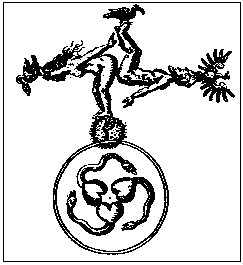
Saturn, who is called the greatest of the planets, is the least useful in our Magistry.
Nevertheless, it is the chief Key of the whole Art, howbeit set in the lowest and meanest place. Although by its swift flight it has risen to the loftiest height, far above all other luminaries, its feathers must be clipped, and itself brought down to the lowest place, from whence it may once more be raised by putrefaction, and the quickening caused by putrefaction, by which the black is changed to white, and the white to red, until the glorious color of the triumphant King has been attained.
Therefore, I say that though Saturn may seem the vilest thing in the world, yet it has such power and efficacy that if its precious essence, which is excessively cold, be reduced to a metallic body by being deprived of its volatility, it becomes as corporeal as, but far more fixed than, Saturn itself. This transmutation is begun, continued, and completed with Mercury, sulphur, and salt. This will seem unintelligible to many, and it certainly does make an extraordinary demand upon the mental faculties; but that must be so because the substance is within the reach of everyone, and there is no other way of keeping up the divinely ordained difference between rich and poor.
In the preparation of Saturn there appears a great variety of different colors; and you must expect to observe successively black, grey, white, yellow, red, and all the different intermediate shades. In the same way, the Matter of all the Sages passes through the several varieties of colour, and may be said to change its appearance as often as a new gate of entrance is opened to the fire.
The King shares his royal dignity with noble Venus, and appears in splendid state, surrounded by all the dignitaries of his court. Before him is borne a beautiful crimson banner, in which there is an embroidered representation of Charity in green garments. Saturn is the prefect of the royal household, and in front of him Astronomy bears a black standard, with a representation of Faith in yellow and red garments.
Jupiter is the Grand Marshal, and is preceded by a banner of grey color, borne by Rhetoric, and adorned with a variegated representation of Hope. Mars is at the head of military affairs, and executes his office with a certain fiery ardour. Geometry carries before him a crimson banner, on which you may behold Courage in a crimson cloak. Mercury holds the office of Chancellor; Arithmetic is his standard bearer, and his standard is of many colours; on it may be observed the figure of Temperance in a many coloured robe.
The Sun is Vice-Regent, and is preceded by Grammar, bearing a yellow banner, on which Justice is represented in a golden robe Though Venus seems to cast him into the shade by the gorgeous magnificence of her appearance, he really possesses more power in the kingdom than she.
Before the Moon, Dialectic bears a shining silver banner, with the figure of Prudence wrought into it in sky-blue, and because the husband of the Moon is dead, he has transferred to her his task of resisting the domination of Queen Venus. For among all these there is enmity, and they are all striving to supplant each other. Indeed, the tendency of events is to give the highest place to the most excellent and the most deserving. For the present state of things is passing away, and a new world is about to be created, and one Planet is devouring another spiritually, until only the strongest survive.
Let me tell you allegorically that you must put into the heavenly Balance the Ram, Bull, Cancer, Scorpion, and Goat. In the other scale of the Balance you must place the Twins, the Archer, the Water-bearer, and the Virgin. Then let the Lion jump into the Virgin's lap, which will cause the other scale to kick the beam. Thereupon, let the signs of the Zodiac enter into opposition to the Pleiads, and when all the colours of the world have shewn themselves, let there be a conjunction and union between the greatest and the smallest, and the smallest and the greatest.
Were seen in one figure,
And nothing could be evolved by Art,
Nothing wonderful would be found in the Universe,
And Nature would have nothing to tell us.
For which let us laud and praise God.
Key Ten
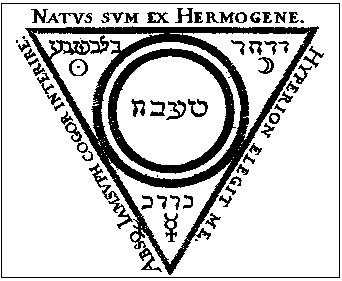
In our Stone, as composed by me and by those who have long preceded me, are contained all elements, all mineral and metallic forms, and all the qualities and properties of the whole world. In it we find most powerful natural heat, by which the icy body of Saturn is gently transmuted into the best gold. It contains also a high degree of cold, which tempers the fervent heat of Venus, and coagulates the mercury, which is thereby also changed into the finest gold.
All these properties slumber in the substance of our Stone, and are developed, perfected, and matured by the gentle connection of natural fire, until they have attained their highest perfection. If the fruit of a tree be plucked before it is ripe, it is unfit for use; and if the potter fail to harden his vessels in the fire, they cannot be employed for any good purpose.
In the same way you must exercise considerable patience in preparing our Elixir, if it is to become all that you wish it to become. No fruit can grow from a flower that has been plucked before the time. He who is in too great a hurry, can bring nothing to perfection, but is almost sure to spoil that which he has in hand. Remember, then, that if our Stone be not sufficiently matured, it will not be able to bring anything to maturity.
The substance is dissolved in a bath, and its parts reunited by putrefaction. In ashes it blossoms. In the form of sand all its excessive moisture is dried up. Maturity and fixity are obtained by living fire. The work does not actually take place in the Bath of St. Mary, in horse- dung, in ashes, or in sand, but the grades and regimen of the fire proceed after the degrees which are represented by these The Stone is prepared in an empty furnace, with a threefold line of circumvallation, in a tightly closed chamber.
It is subjected to continued connection, till all moisture and clouds are driven off, and the King attains to indestructible fixedness, and is no longer liable to any danger or injury, because he has become unconquerable. Let me express my meaning in a somewhat different manner. When you have dissolved your earth with your water, dry up the water with its own inward fire. Then the air will breathe new life into the body, and you will have that which can only be regarded as that Great Stone which in a spiritual manner pervades human and metallic bodies, and is the universal and immaculate Medicine, since it drives out that which is bad, and preserves that which is good, and is the unfailing corrective of all imperfect or diseased substances. This Tincture Is of a color intermediate between red and purple, with something of a granite hue, and its specific weight is very considerable.
Whoever gains possession of this Stone, should let his whole life he an expression of his gratitude towards God in practical kindness towards his suffering brethren, that after obtaining God's greatest earthly gift, he may hereafter inherit eternal life. Praise be unto God everlastingly for this His inestimable gift.
Key Eleven
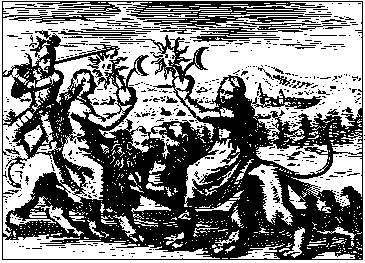
The eleventh Key to the Knowledge of the augmentation of our Stone, I will put before you in the form of a parable.
There lived in the East a gilded knight, named Orpheus, who was possessed of immense wealth, and had everything that heart can wish. He had taken to wife his own sister, Euridice, who did not, however, bear him any children. This he regarded as the punishment of his sin in having wedded his own sister, and was instant in prayer to God both by day and by night, that the curse might be taken from him.
One night, when he was buried in a deep sleep, there came to him a certain winged messenger, named Phoebus, who touched his feet, which were very hot, and said: " Thou noble knight, since thou hast wandered through many cities and kingdoms, and suffered many things at sea, in battle, and in the lists, the heavenly Father has bidden me make known to thee the following means of obtaining thy prayer: Take blood from thy right side, and from the left side of thy spouse.
For this blood is the heart's blood of your parents, and though it may seem to be of two kinds, vet, in reality, it is only one. Mix the two kinds of blood, and keep the mixture tightly enclosed in the globe of the seven wise Masters There that which is generated will be nourished with its own flesh and blood, and will complete its course of development when the Moon has changed for the eighth time If thou repeat this process again and again, thou shalt see children's children, and the offspring of thy body shall fill the world."
When Phoebus had thus spoken, he winged his flight heavenward. In the morning the knight arose and did the bidding of the celestial messenger, and God gave to him and to his wife many children, who inherited their father's glory, wealth, and knightly honours from generation to generation.
If you are wise, my son, you will find the interpretation of my parable. If you do not understand it, ascribe the blame not to me, but to your own ignorance. I may not express myself more explicitly; indeed, I have revealed the matter in a more plain and straightforward manner than any of my predecessors. 1 have concealed nothing; and if you will but remove the veil of ignorance from your eyes, you will behold that which many have sought and few found.
Key Twelve
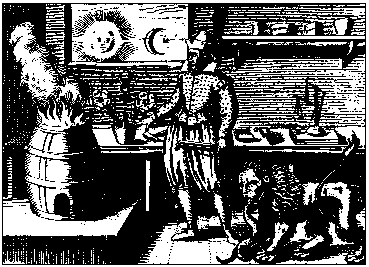
If an athlete know not the use of his sword, he might as well be without it; and if another warrior that is skilled in the use of that weapon come against him, the first is like to fare badly.
For he that has knowledge and experience on his side, must carry off the victory.
In the same way, he that possesses this tincture, by the grace of Almighty God, and is unacquainted with its uses, might as well not have it at all. Therefore this twelfth and last Key must serve to open up to you the uses of this Stone. In dealing with this part of the Subject I will drop my parabolic and figurative style, and plainly set forth all that is to be known. When the Medicine and Stone of all the Sages has been perfectly prepared out of the true virgin's milk, take one part of it to three parts of the best gold purged and refined with antimony, the gold being previously beaten into plates of the greatest possible thinness. Put the whole into a smelting pot and subject it to the action of a gentle fire for twelve hours, then let it be melted for three days and three nights more.
For without the ferment of gold no one can compose the Stone or develop the tinging virtue.
For the same is very subtle and penetrating if it be fermented and joined with a ferment like unto itself: then the prepared tincture has the power of entering into other bodies, and operating therein. Take then one part of the prepared ferment for the tinging of a thousand parts of molten metal, and then you will learn in all faith and truth that it shall be changed into the only good and fixed gold. For one body takes possession of the other; even if it be unlike to it, nevertheless, through the strength and potency added to it, it is compelled to be assimilated to the same, since like derives origin from like.
Whoever uses this as a medium shall find whither the vestibules of the palace lead, and there is nothing comparable to the subtlety thereof. He shall possess all in all, performing all things whatsoever which are possible under the sun.
O principle of the prime principle, consider the end! O end of the final end, consider the beginning! And be this medium commended unto your faithful care, wherein also God the Father, Son, and Holy Ghost, shall give unto you whatsoever you need both in soul and body.

Seek for that Stone which has no fleshly nature, but out of which a volatile fire is extracted, whence also this stone is made, being composed of white and red. It is a stone, and no stone; therein Nature alone operates. A fountain flows from it. The fixed part submerges its father, absorbing it, body and life, until the soul is returned to it. And the volatile mother like to him, is produced in her own kingdom; and he by his virtue and power receives greater strength.
The volatile mother when prepared surpasses the sun in summer. Thus the father by means of Vulcan was produced from the spirit. Body, soul, and spirit exist in both, whence the whole matter proceeds. It proceeds from one, and is one matter. Bind together the fixed and the volatile; they are two, and three, and yet one only. If you do not understand you will attain nothing. Adam was in a bath -- wherein Venus found her like, which bath the aged Dragon had prepared when his strength was deserting him. There is nothing, says the Philosopher, save a double mercury; I say that no other matter has been named; blessed is he who understands it. Seek therein, and be not weary; the result justifies the labour.
Tract concerning the Great Stone of the Ancient Sages
But, notwithstanding that my conscience doth bear me witness in the sight of the Most High, before whom all concealed matters are laid bare, that I have written no falsehood, but have so exposed the truth that understanding men can require no further light (that which is laid down in the theoretical part being borne out and confirmed by the practice of the Twelve Keys), yet have I been impelled by various considerations to demonstrate by a shorter way what I have written in the said treatise, and thus cast further light thereon, whereby also the lover of the desired wisdom may obtain an increased illumination for the fulfillment of his desire
There are many who will consider that I am speaking too openly, and will hold me answerable for the wickedness that they think will follow, but let them rest assured that it will be sufficiently difficult, notwithstanding, for any thick-headed persons to find what they seek herein. At the same time the matter shall be made clear to the elect. Hearken then, thou follower of truth, to these my words, and so shalt thou find the true way.
Behold, I write nothing more than I am willing to hold by after my death and resurrection! Do thou faithfully and simply lay to heart this shorter way, as hereinafter exhibited, for my words are grounded in simplicity, and my teaching is not confused by a labyrinth of language.
I have already indicated that all things are constituted of three essences - namely, mercury, sulphur, and salt - and herein I have taught what is true. But know that the Stone is composed out of one, two, three, four, and five. Out of five - that is, the quintessence of its own substance.
Out of four, by which we must understand the four elements. Out of three, and these are the three principles of all things. Out of two, for the mercurial substance is twofold. Out of one, and this is the first essence of everything which emanated from the primal fiat of creation.
But many may by all these discourses be rendered doubtful in mind as to what they must start with, and as to the consequent theory. So I will, in the first place, speak very briefly concerning Mercury, secondly concerning Sulphur, thirdly concerning Salt; for these are the essence of the Matter of our Stone.
In the first place, you must know that no ordinary quicksilver is useful, but our quicksilver is produced from the best metal by the spagyric art, pure, subtle, clear, and glistening, like a spring, pellucid even as crystal, free from all dross. Hence make water or combustible oil. For Mercury was in the beginning water, and herein all the Sages agree with my dictum and teaching In this oil of Mercury dissolve its own Mercury, from which the water in question was made, and precipitate the Mercury with its own oil.
Then we have a twofold mercurial substance; but you must know that gold must first be dissolved in a certain water, as explained in my second Key, after the purification described in the first Key, and must be reduced into a subtle calx, as is mentioned in the fourth Key. Next, this calx must be sublimated by the spirit of salt, again precipitated, and by reverberation reduced into a subtle powder. Then its own sulphur can more easily enter into its substance, and have great friendship with the same, for they have a wondrous love towards each other. Thus you have two substances in one, and it is called Mercury of the Sages, but is yet a single substance, which is the first ferment.
Georg Agricola
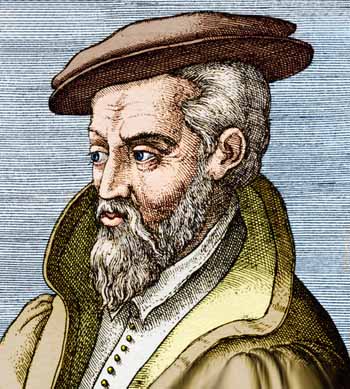
Georgius Agricola (March 24, 1494 - November 21, 1555) was a German scholar and scientist. Known as "the father of mineralogy", he was born at Glauchau in Saxony. His real name was Georg Pawer; Agricola is the Latinized version of his name, Pawer (Bauer) meaning "farmer". He is best known for his book De Re Metallica.
Life and Work
He returned to Zwickau in 1527, and was chosen as town physician at Joachimsthal, a centre of mining and smelting works, his object being partly "to fill in the gaps in the art of healing," partly to test what had been written about mineralogy by careful observation of ores and the methods of their treatment. His thorough grounding in philology and philosophy had accustomed him to systematic thinking, and this enabled him to construct out of his studies and observations of minerals a logical system which he began to publish in 1528. Agricola's dialogue Bermannus, sive de re metallica dialogus, (1530) the first attempt to reduce to scientific order the knowledge won by practical work, brought Agricola into notice; it contained an approving letter from Erasmus at the beginning of the book.
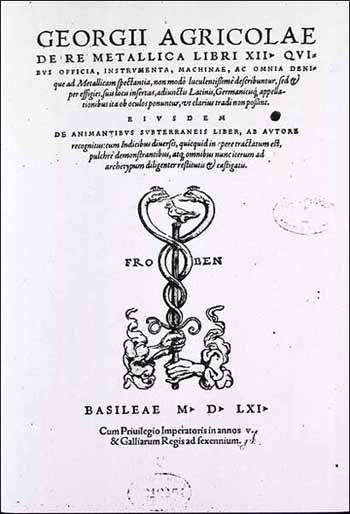
The book consists of a preface and twelve chapters, labelled books I to XII, without titles. It also has numerous woodcuts that provide annotated diagrams illustrating equipment and processes described in the text.
Agricola addresses the book to prominent German aristocrats, the most important of whom were Maurice, Elector of Saxony and his brother Augustus, who were his main patrons. He then describes the works of ancient and contemporary writers on mining and metallurgy, the chief ancient source being Pliny the Elder. Agricola describes several books contemporary to him, the chief being a booklet by Calbus of Freiberg in German.
The works of alchemists are then described. Agricola does not reject the idea of alchemy, but notes that alchemical writings are obscure and that we do not read of any of the masters who became rich. He then describes fraudulent alchemists, who deserve the death penalty. Agricola completes his introduction by explaining that, since no other author has described the art of metals completely, he has written this work, setting forth his scheme for twelve books. Finally, he again directly addresses his audience of German princes, explaining the wealth that can be gained from this art.
Agricola then states that it is rarely worthwhile digging for other metals unless the ores are rich. Gems are found in some mines, but rarely have their own veins, lodestone is found in iron mines and emery in silver mines. Various minerals and colours of earths can be used to give indications of the presence of metal ores. The actual mineworking varies with the hardness of the rock, the softest is worked with a pick and requires shoring with wood, the hardest is usually broken with fire. Iron wedges, hammers and crowbars are used to break other rocks.
Noxious gases and the ingress of water are described. Methods for lining tunnels and shafts with timber are described. The book concludes with a long treatise on surveying, showing the instruments required and techniques for determining the course of veins and tunnels. Surveyors allow veins to be followed, but also prevent mines removing ore from other claims and stop mine workings from breaking into other workings.
Horizontal drive shafts along tunnels allow lifting in shafts not directly connected to the surface. If this is not possible treadmills will be installed underground. Instead of lifting weights similar machines use chains of buckets to lift water. Agricola also describes several designs of piston force pumps which are either man or animal powered or powered by waterwheels. Because these pumps can only lift water about 24 feet batteries of pumps are required for the deepest mines. Water pipe designs are also covered in this section. Designs of wind scoop for ventilating shafts or forced air using fans or bellows are also described. Finally ladders and lifts using wicker cages are used to get miners up and down shafts.
The choice is made by which color the ore burns out which gives an indication of the metals present. The lead should be silver-free or be assayed separately. The prepared ore is wrapped in paper, placed on a scorifier and then placed under a muffle covered in burning charcoal in the furnace. The cupel should be heated at the same time. The scorifier is removed and the metal transferred to the cupel. Alteratively the ore can be smelted in a triangular crucible, and then have lead mixed with it when it is added to the cupel. The cupel is placed in the furnace and copper is separated into the lead which forms lithage in the cupel leaving the noble metal. Gold and silver are parted using an aqua which is probably nitric acid. Agricola describes precautions for ensuring the amount of lead is correct and also describes the amalgamation of gold with mercury. Assay techniques for base metals such as tin are described as well as techniques for alloys such as silver tin. The use of a touchstone to assay gold and silver is discussed. Finally detailed arithmetical examples show the calculations needed to give the yield from the assay.
When the furnace is ready, the forehearth is filled with molten lead into which the furnace is tapped. In other furnaces the smelting can be continuous, and lead is placed into the furnace if there is none in the ore. The slag is skimmed off the top of the metal as it is tapped. The lead containing the gold is separated by cupelation, the metal rich slags are re-smelted. Other smelting processes are similar, but lead is not added. Agricola also describes making crucible steel and distilling mercury and bismuth in this book.
In 1530 Prince Maurice of Saxony appointed him historiographer with an annual allowance, and he migrated to Chemnitz, the centre of the mining industry, in order to widen the range of his observations. The citizens showed their appreciation of his learning by appointing him town physician in 1533. In that year, he published a book about Greek and Roman weights and measures, De Mensuis et Ponderibus.
He was also elected burgomaster of Chemnitz. His popularity was, however, short-lived. Chemnitz was a violent centre of the Protestant movement, while Agricola never wavered in his allegiance to the old religion; and he was forced to resign his office. He now lived apart from the contentious movements of the time, devoting himself wholly to learning. His chief interest was still in mineralogy; but he occupied himself also with medical, mathematical, theological and historical subjects, his chief historical work being the Dominatores Saxonici a prima origine ad hanc aetatem, published at Freiberg.
In 1544 he published the De ortu et causis subterraneorum, in which he laid the first foundations of a physical geology, and criticized the theories of the ancients.
In 1545 followed the De natura eorum quae effluunt e terra; in 1546 the De veteribus et novis metallis, a comprehensive account of the discovery and occurrence of minerals; in 1548 the De animantibus subterraneis; and in the two following years a number of smaller works on the metals.
His most famous work, the De re metallica libri xii, was published in 1556, though apparently finished several years before, since the dedication to the elector and his brother is dated 1550. It is a complete and systematic treatise on mining and metallurgy, illustrated with many fine and interesting woodcuts and containing, in an appendix, the German equivalents for the technical terms used in the Latin text. It long remained a standard work, and marks its author as one of the most accomplished chemists of his time. Believing the black rock of the Schlossberg at Stolpen to be the same as Pliny the Elder's basalt, he applied this name to it, and thus originated a petrological term which has been permanently incorporated in the vocabulary of science.
In spite of the early proof that Agricola had given of the tolerance of his own religious attitude, he was not suffered to end his days in peace. He remained to the end a staunch Catholic, though all Chemnitz had gone over to the Lutheran creed; and it is said that his life was ended by a fit of apoplexy brought on by a heated discussion with a Protestant divine. He died at Chemnitz on the 21st of November 1555, and so violent was the theological feeling against him, that he was not suffered to rest in the town to which he had added lustre. Amidst hostile demonstrations he was carried to Zeitz, seven miles (prussian land miles, each about 7.5 km) from Chemnitz, and there buried.
De Re Metallica is considered a classic document of the dawn of metallurgy, unsurpassed for two centuries. In 1912, the Mining Magazine (London) published an English translation. The translation was made by Herbert Hoover, an American mining engineer better known in his term as a President of the United States, and his wife Lou Henry Hoover.
Final Days
He died in Chemnitz on November 21, 1555; so violent was the theological feeling against him, he was not allowed to be buried in the town to which he had added such lustre. Amidst hostile demonstrations, he was carried to Zeitz, some 50 kilometers away, and buried there.
Paracelsus
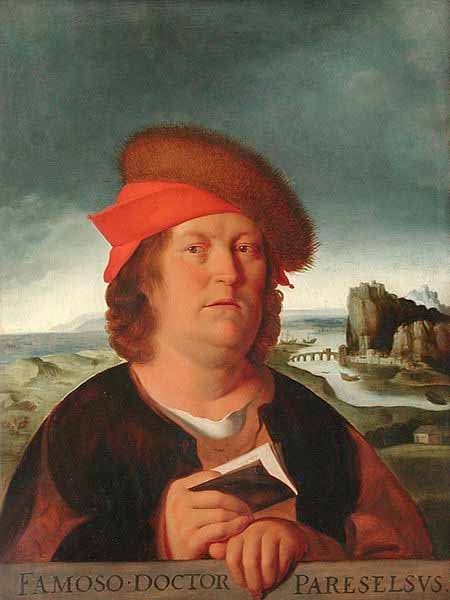
Paracelsus (born Philippus Aureolus Theophrastus Bombastus von Hohenheim November 11 or 17 December 1493 September 24, 1541) was a German-Swiss Renaissance physician, botanist, alchemist, astrologer, and general occultist. "Paracelsus", meaning "equal to or greater than Celsus", refers to the Roman encyclopedist Aulus Cornelius Celsus from the 1st century, known for his tract on medicine. He is also credited for giving zinc its name, calling it zincum, and is regarded as the first systematic botanist.
Paracelsus was born at Einsiedeln, Switzerland, of a Swabian chemist father and a Swiss mother. He was brought up in Switzerland, and as a youth he worked in nearby mines as an analyst. He started studying medicine at the university of Basel at the age of 16. There is speculation he gained his doctorate degree from the University of Ferrara.
He later journeyed to Egypt, Arabia, the Holy Land, and Constantinople seeking alchemists from whom to learn. On his return to Europe, his knowledge of these treatments won him fame. He did not go along with the conventional treatment of wounds, which was to pour boiling oil onto them to cauterize them; or if they were on a limb, to let them become gangrenous and then to amputate the limb. Paracelsus believed the then-ridiculous idea that wounds would heal themselves if allowed to drain and prevented from becoming infected.
Paracelsus rejected Gnostic traditions, but kept much of the Hermetic, neoplatonic, and Pythagorean philosophies; however, Hermetical science had so much Aristotelian theory that his rejection of Gnosticism was practically meaningless.
In particular, Paracelsus rejected the magic theories of Agrippa and Flamel (N.B. This assertion regarding Flamel is problematic, since
a.) no works by Flamel were in circulation prior to Paracelsus' death and
b.) Flamel's theories are specifically alchemical and not magical);
Paracelsus did not think of himself as a magician and scorned those who
did, though he was a practicing astrologer, as were most, if not all of
the university-trained physicians working at this time in Europe.
Astrology was a very important part of Paracelsus' medicine. In his Archidoxes of Magic Paracelsus
devoted several sections to astrological talismans for curing disease,
providing talismans for various maladies as well as talismans for each
sign of the Zodiac. He also invented an alphabet called the Alphabet of the Magi, for engraving angelic names upon talismans.
Paracelsus pioneered the use of chemicals and minerals in medicine. He
used the name "zink" for the element zinc in about 1526, based on the
sharp pointed appearance of its crystals after smelting and the old
German word "zinke" for pointed. He used experimentation in learning
about the human body.
He summarized his own views: "Many have said of Alchemy, that it is for the making of gold and silver. For me such is not the aim, but to consider only what virtue and power may lie in medicines." (Edwardes, p.47) (also in: Holmyard, Eric John. Alchemy. p. 170)
Indeed, the remnants of alchemical traditions can still be seen in modern medicine. For instance, the Caduceus has been adopted as the prime symbol of western medicine.
Paracelsus gained a reputation for being arrogant, and soon garnered the anger of other physicians in Europe. He held the chair of medicine at the University of Basel for less than a year; while there he angered his colleagues by publicly burning books by other physicians. He was forced from the city after having legal trouble over a physician's fee he sued to collect.
He then wandered Europe for some time, typically as a pauper. He revised old manuscripts and wrote new ones, but had trouble finding publishers.
In 1536, his Die grosse Wundartzney (The Great Surgery Book) was published which enabled him to make a short comeback in popularity.
After his death, the movement of Paracelsianism was seized upon by many wishing to subvert the traditional Galenic physick and thus did his therapies become more widely known and used.
His motto was "alterius non sit qui suus esse potest" which means "let no man belong to another that can belong to himself".
Valentin Weigel


Valentin Weigel (1553-1588) was a mystical writer who drew upon Paracelsist and alchemical ideas. His ideas influenced Jacob Boehme, and other German Protestant mystics of the 17th century. Most of his writings were published after his death, when a small group of Weigelians promoted his ideas, and some texts were issued in his name, pseudonymously. This book is the only one I know that was ever published in English.
Chapter 1
What Astrology is, and what Theology;
and how they have reference one to another
and how they have reference one to another
The Kingdom of Grace. - But Theology is the whole light of Grace happening to man from the Holy Spirit effused from above, which is the universal Wisdom of the Kingdom of Heaven, and the saving knowledge of divine and supernatural things, making chaste and purging the soul from every defilement of sin abiding in the mortal body in respect whereof that natural Wisdom is but a shadow, which, when the world is blotted out and removed, will together with it be blotted out and removed, and then Theology alone shall reign.
Astrology is so called because it ariseth from the stars. As Theology, because it flows from God.
'To live astrologically is with a pleasing concupiscence to eat of the Tree of the knowledge of good and evil, and to bring death to himself. To live theologically is to eat of the wood and Tree of Life by an intimate abnegation of oneself, and thence to attain to oneself, Life and Salvation.
The Light of Nature in Astrology, with his incitative fruits, is the probatory instrument whereby Man, placed in the midst, that is, between God and the Creature, is proved which way he would direct or convert his free will, desire, love and appetite; whether to God his Creator, by loving Him above all things, with his whole heart, with his whole mind, with his whole soul, and with his whole strength; which should be the Theological life.
Or, whether, casting God behind, he would reflect to himself and to the Creature by love of himself, and arrogating of good things received, which was the Astrological life at the Babylonish fornication, as will appear by that which followeth.
Astrology possesseth our soul with the eternal body, wherein the Light of Nature dwells and shines forth, in some more excellently, in others less. And it contains in itself two things.
1st. All kind of Sciences, Arts, Tongues, Faculties, and natural studies: all the gifts, as well of the mind, as of the body, and also all negotiations, occupations, actions, and labors of men, how many soever of them are found, exercised and used in all times upon the whole earth, everywhere amongst men, as well gross as subtle, as well old as new, serving as well to good as to bad uses.
2nd. Under Astrology, are referred all orders, states, and degrees of men, distinctions of persons, dignities, gifts, offices, and every kind of life as well naturally ordained by God Himself, as thought of and invented by human wit, and found out in the whole world from the highest and most honorable to the lowest and most base.
All these are the fruits of the Stars, and have their original from Astrology, and pertain to the body and soul, and may be as well good as bad, according to the divers pleasures of the users and abusers .
But Theology possesseth our Spirit, which we have from God, which alone is Theologus, that is the Speech of God, the Breath of God, the Word of God, being and inhabiting in the Temple of our heart, from which alone according to sacred letters, true Theology is to be drawn forth; that is, the knowledge of God, of things divine and celestial and supernatural, arising from within, from the illumination of the holy Spirit Itself dwelling within us.
According to Whose beck, will and command we ought to institute, direct and finish all our Sciences, Arts, studies, actions, offices, vocations, industries, labors and kinds of life, invented and drawn forth on earth from the Light of Nature; so as whatsoever we think, say or do in the world, in all arts, sciences and labours, it all proceeds from the Will of God, and seems, as it were, to be done and governed by God Himself in us, as by His fit instruments.
For every astrological gift, coming from the Light of Nature ought to be ruled and subjected. to the Divine Will by the Theological Spirit dwelling in us, that so the Will of the Lord be done, as in heaven, so also in earth. For all Wisdom, both Natural and Supernatural, is from the Lord.
Astrology is the science of tilling and perlustrating of the inferior terrestrial earth, ground, garden, Paradise, from which man was taken and made, as to his body and his soul, in the labour and culture whereof six days were ordained and appointed. But because this science of itself confers not salvation and eternal beatitude, but alone belongs to this present life; it is necessary the Lady and Mistress of all sciences and arts - Theology - be added, which seeing it is Wisdom from above, it hath in itself the science of tilling and perlustrating the celestial earth, ground, garden, Paradise, from whence also man was taken, created according to the similitude and image of God, which garden man also hath in himself, to the culture whereof, the seventh day alone, which is the Sabbath day, is appointed.
For so it was ordained between God and man from all eternity, that Man should be God, and God, Man, neither without the other; that is, as God Himself is, and will be, the Paradise, garden, tabernacle, mansion, house, temple, and Jerusalem of man, so also was Man created for the same end, that he should be the Paradise, garden, tabernacle, mansion, house, temple, and Jerusalem of God; that by this mutual union and friendship of God with Man, and of Man with God, all the wisdom power, virtue and glory eternally hidden in God should be opened and multiplied. For, God once made all things for Man, but Man for Himself.
Chapter 2
Concerning the Subject of Astrology
The exercise therefore of the Light of Nature is the most sagacious perscrutation and enucleation of the abstruse, internal and invisible virtues, lying hid in external, corporal and visible things; to wit,
What should be the first matter of this great world whereof it was made.
What the Elements should be, and those things which are bred of the Elements, and consist in them; of what kind is their creation, essence, nature, propriety and operation as well within as without.
What might be in the stars of heaven, what their operation.
What in volatiles, what in fishes, metals, minerals, gems; what in every species of sprigs and vegetables.
What in animals, beasts, creeping things, and in the whole frame of the world.
Lastly, what is in Man, who was made and created of all these; to wit,
What is that mass, or slime, or dust whereof the body of the first man was formed, and whence he received his soul, and what it is; and whence he hath the Spirit, and what he is: And so the Light of Nature, or Astrology comprehends in itself all the wisdom and knowledge of the whole universe; that is, all these are hid and learned in the School of the Light of Nature, and are referred to Astrology, or are rather Astrology itself; to wit,
The subject of Astrology is therefore double; the Macrocosm and the Microcosm, the greater world and the lesser world.
The greater World is this very frame and great House, or this huge Tabernacle wherein we inhabit and live; and it consists of the four elements, Fire, Air, Water and Earth; and is twofold, visible according to the body, invisible according to the soul or spirit.
The lesser world is Man, the offspring or sum of the greater world, extracted and composed out of the whole greater world, who also in himself is twofold, visible according to the body, invisible according to the soul or spirit.
And as Man is made of nothing else but the world, so also is he placed and put nowhere else but within the world, to wit, that he might live, dwell, and walk therein, yet so as that he should take heed of that subtle Serpent, and should not eat of the Tree of the knowledge of good and evil, lest he die; that is, that he serve not the soul of the world, and creatures subject to vanity: but as a wise man rule the stars, and resist the devil tempting him, by the concupiscence of the flesh, of the eyes and pride of life; and suppress sinful nature, living and walking in wisdom and simplicity of the Divine Godhead inspired into him, not in the subtlety of the Serpent by arrogancy and love of himself.
For it is most certain, of what anything is born and procreated, from thence also it seeks, desires and receives its nourishment, convenient to its essence and nature, for the sustentation of itself.
Now Man was taken from, and composed of the Macrocosm, and placed in the same: Therefore also necessarily he is nourished, cherished, receives his meat and drink, is clothed and sustained according to that. (Gen. iii, 19. Thou art taken from the earth, and thou shalt eat thereof in labour all the days of thy life, and shalt eat the herbs of the field until thou shalt return unto the earth, for from it thou art taken.)
Seeing therefore, Man, as to his body, is composed of the elements, and as to his soul, of the stars, and each part is fed and sustained from that from which it was taken; the food or aliment of the body, whereby the body grows to a due stature, comes to a man from the elements, the earth, the water, air and fire; not that man should take to himself for food the crude bodies of the elements, but the fruits growing from the elements: they are for nutriment. But the food of the soul inhabiting in the Microcosmical body, are all kinds of sciences, arts, faculties, and industries, with which she tincts and makes herself perfect.
Moreover; all aliment passeth into the substance of the user, and is made the same that he himself is; that is, whatsoever a man eats and drinks, the same thing is essentially transmitted into the substance, nature, propriety and form of man, by the digestion of Archeus in the ventricle. I say, the food passeth and is converted into the nature of the eater, and drink into the substance of the drinker, and is made one and the same with him.
And in the first place, let these things be understood concerning the body without wonder:
because man is made of that which he eats and drinks. So also whatsoever a man learns, studies, knows in things that are placed without himself, that knowledge and intelligence passeth into the very essence, nature and propriety of a man, and is made one with him.
The Light of Nature is made man in man, and by a man's diligent searching man is made Light both in light and by light; and by the benefit of that light he finds out all things, whatsoever he seeks and desires; but one more and another less, because all do not seek with the like study.
Every knowledge, science, art, industry and faculty passeth into the nature of man, penetrates him, occupies him, possesseth him, tincts him, is agglutinated to him, united with him, and perfected in him, and he in it. For, whatsoever kind of aliment man useth, and whatsoever he endeavours to study, inquire, know and understand, this is not strange or different from his essence and nature.
The reason is, because whatsoever is without a man, the same is also within him, for that man is made of all these things which are without him, that is, of the whole universe of things.
Therefore whatsoever man takes from without from the elements and stars by meat, drink, knowledge, study and intelligence, this is the same that man is, and is made the same with man. So man eating bread, and drinking water, wine, etc., from the Macrocosm, he eats and drinks himself; and learning - arts, tongues, faculties, and sciences of external things, he learns and knows himself.
And as he tincts his body by meat and drink, which pass into the substance of flesh and blood, so also his soul is tincted with whatsoever kind of sciences, arts, etc., eating and drinking, he is united essentially with that which he eats and drinks. And learning and knowing, he is united essentially with that which he studies, learns and knows. Wherefore this is a most certain rule; - Whatsoever is without us, is also within us. Which in this place, we, philosophising of the soul and body, do thus declare.
This whole world visible as to the body, invisible as to its soul, is without us. From this we are all essentially in and with the first man complicity made and created, and incontinently after the Creation, were put and placed into it. And seeing it is manifest that everything that is derived, retains the essence, nature and propriety of its original; that although the Macrocosm is without us, yet nevertheless it may also be found truly within us; I say the World is in us, and we are in it, and yet this is, as that is without us, and we without that. For indeed we have no existence or original from anything else, but from that which is without us, and which was before us; nor are we, nor do we inhabit, walk and live in anything else, save in that whereof we are made. Neither do we seek and draw forth meat and drink from any other, either for the body or the soul, but from that into which we are placed, and which is placed in us.
As to the Spirit, we are of God, move in God, and live in God, and are nourished of God. Hence God is in us and we are in God; God hath put and placed Himself in us, and we are put and placed in God.
As to the Soul, we are from the Firmament and Stars, we move and live therein, and are nourished thereof. Hence the firmament with its astralic virtues and operations is in us, and we in it. The Firmament is put and placed in us, and we are put and placed in the Firmament.
As to the Body, we are of the elements, we move and live in them, and are nourished of them: - hence the elements are in us, and we in them. The elements, by the slime, are put and placed in us, and we are put and placed in them.
So God is whole without us, and also whole within us, by the being of inspiration, that is, by His Spirit communicated to us.
So the world is whole without Adam, and also the whole world is within Adam, by the being of extracted slime.
So Adam is whole without us, and also whole within us, by the being of seed.
And so we bear God within us, and God bears us in Himself. God hath us with Himself, and is nearer to us than we are to ourselves We have God everywhere with us, whether me know it, or know it not. We bear the world in us, and the world bears us in itself.
Therefore whatsoever we perceive, feel, touch, taste, smell, hear, see, imagine, think, speculate learn, understand, savour, know, eat, and drink, and wheresoever we walk, this is the very same from whence we have drawn our original. We are always conversant in those things of which we are made. For Man is the centre of the whole universe. So we learn nothing else, but the very same thing that was before us, and whereof we are made, and which before we begin to learn, lies hid in us. Yea, we learn, search and know nothing else than our selves; to wit, learning, searching and knowing that whereof we come, and whence we have received our being. So we eat and drink nothing else but ourselves, to wit eating and drinking that whereof we are made.
So our body hath its hunger and thirst in itself from within, and desires the perfection of itself, by meat and drink taken from the elements from without.
See Paracelsus of the 'Lodestone of Nature in the Macrocosm and Microcosm'. So the soul hath its hunger and thirst in itself, and desires the perfection of itself, by meat and drink from the stars, which is the wisdom and knowledge of natural things; by arts, tongues, sciences, etc. Hence spring the artificers and wise men of this world.
Moreover, as in meat and drink taken from the elements, there is always pure and impure conjoined, which when they come into the stomach to the fire of digestion, are by the internal Vulcan or Archeus of Nature separated from one another after a spagirical manner, and that which is pure is retained and abides in us, that is the essence extracted from meat and drink, the pure is separated from the impure which passeth into flesh and blood.
For it penetrates the body like unto leaven, and is made one with it, and causeth it to increase, that it may become greater and more solid in its strength and nerves; but the impure, differing from nutriment, is cast forth into the draught, and that by the operation of Archeus labouring in the ventricle. By like reason the matter is even in all sciences arising from the Light of Nature, where always good and evil are joined together. For in Nature all things are convertible, as well to good as to evil. Wherefore unless Astrology be Theologized, that is, unless that which is good be retained, and that which is evil rejected, Man from thence acquires to himself eternal death. And this is the probation of Man.
Chapter 3
Of the three parts of Man; Spirit, Soul and Body, from whence every one is taken, and how one is in the other.The Spirit of man comes from the Spirit of God, and participates with eternity and Aevo.
The Soul in man is extracted from the soul of the World, and participates with Aevo and Time.
The Body of Man is formed and composed from the body of the World, as elements, and participates with Time only.
The Body extracted from the elements, and constituted into this form, is the House, the Tabernacle, the seat of the Soul, and resident chiefly in the heart.
The Soul of Man extracted from the Soul of the world, and delivered over to the heart, is the habitation of the Divine Spirit, and hath the Divine Spirit in itself.
So one exists in the other, and dwells in the other, abides in the other, and operates in the other.
The Spirit in the Soul, and by the Soul.
The Soul in the Body, and by the Body.
The Body in and by external subjects.
Everything which is without is as that which is within, but the internal always excels the external in essence. virtue, and operation. For by how much any thing is more inward, by so much the more it is more noble, potent and capacious.
Great virtue is in the Body, if it be excited.
Greater in the Soul of the firmament if it be excited.
Greatest in the Divine Spirit, if it be excited.
By excitation all things are laid open, which are hidden and placed in Ignorance. For both Divine and Natural Wisdom sleep in us, and each light shines in darkness, and without excitation man wants the having.
Great and excellent is the knowledge of the human body, extracted from the elements, and disposed into this form.
Greater and more excellent is the knowledge of the Soul, taken from the firmament, and inserted into the body.
Greatest and most excellent is the knowledge of the Spirit inspired from the mouth of God into the first man, and by the mysteries of multiplication equally communicated to every one of us.
Wherefore is the knowledge of the human body great? By reason of its wonderful composition, that is, because all the four Elements are essentially composed in it. And moreover I say, the essence, nature, and propriety of all the creatures of the whole invisible world which are in the earth, water, air and fire, are incorporated and situate in man. But seeing all things generally are conjoined and included into one skin, they are not altogether and at once discovered, nor can be revealed, but at least come forth and are known in specie, as they are drawn forth and excited.
Wherefore is the knowledge of the Soul which is in the heart of Man greater? Because the whole firmament, with all the essences, nature, virtue, propriety. inclination, operation and effect of all the Stars is therein conjoined and complicated, so as there is nothing in the whole power of the Spirit of the firmament or Soul of the World, which the soul of man also hath not in himself, and in the exaltation of itself, can give it of itself.
Yea, the whole Light of Nature is in the soul of the Microcosm, which is the wisdom and power and vigour of all things of the whole world throughout all the elements and things procreated of the elements. For she is the Astrological Spirit, containing in herself all kind of sciences, magic, Cabalistic, astronomic, with all their species, chemistry, medicine, Physic, all arts, tongues, all workmanships and all studies existent throughout the whole shop of Nature.
But because all these things are collected in one, and generally comprehended in the soul, they do not all lie open, or can they be in act together, although they are in power; but are let out and produced one species after another.
Wheresoever, therefore, these kinds of divers sciences flourish and are exercised amongst men, there shines the Light of Nature, and the soul of the Microcosm is in her exaltation, that is, the firmament of the Micrososm is in his ascendents.
But why is the knowledge of the Spirit of God greatest in us? Because He from Whom we receive this Spirit is greatest and most eminent above all. For in this same Spirit all the divine wisdom and power from whence that saving knowledge flows forth, that is, Theology, treating of supernatural, celestial and divine things, and is conversant in the Magnalia and mysteries of God placed above Nature, and tends even to the inexhausted and unspeakable profundity of the Deity, in which profundity, the very original matter, cause and end of all the works of God, and of things acted in time from the beginning of the creation even to the end of the consummation of the world, eternally and essentially lay hid. For all things came forth from Him; all things were made by Him, and all things consist in Him.
By how much anything is most inward, by so much it is more noble and excellent. This visible world is a body compacted of fire, air, water and earth, which is without, and hath in itself the spirit of Nature which is the soul of the world, which is within, to which soul this external body belongeth; because it is inhabited, possessed and governed by. Hence the soul of the world is more noble than the body.
This soul of the world hath in it the Spirit of God, which comprehendeth and possesseth it. For nothing is beyond God or the Spirit of God. Hence the Spirit is more noble than the soul. The more noble always exists in the more ignoble, and internals prevail over externals, as in essence as in power. So our external body is indeed great in its stature and quantity, and a wonderful creature.
Yet the soul dwelling in the body is far greater, and more wonderful, not in corporeal quantity, but in essence, virtue and power.
But the Spirit is the greatest of all, not in the lump or corporeal quantity, but in essence, virtue and power; and therefore most wonderful.
There is nothing greater than that in which are all things. And there is nothing less than that which is in all smallest things Therefore let us observe this rule well:
By how much anything is more inward and more hidden from the external senses, by so much the more it is more worthy, noble and potent in its essence, nature and propriety.
Which we will demonstrate by examples. There is not any house built for itself, but for the inhabitant. Now the edifice is an external thing, and the inhabitant an internal thing. The house is for the guest, and not the guest for the house. Therefore the inhabitant is far more noble, worthy and excellent in his essence than every edifice, although sumptuous. For what is the house profitable, the guest being absent?
So garments are made and prepared for the body, that it might be and walk in them. Garments are external things; the body is internal. Therefore the body in its essence is far more noble and worthy than all garments, although precious. For, what need is there of garments, if they are wanting which should put them on? Therefore garments are for the body, and not the body for garments.
So the body, raiment, house and habitation is a certain external thing to the soul, but the soul is internal.
And the body is for the soul, and not the soul for the body. Therefore the soul in her essence is a far more noble and worthy creature than the body, although most comely and most excellently proportioned. For, what availeth the body? the soul being wanting, it is a carcase.
So the Soul, made and created for an habitation of the Divine Spirit, is external; but the Spirit is internal. And the soul is for the Spirit, and not the Spirit for the soul. Therefore the Spirit of God is found far more noble and excellent, and worthy in His original essence? virtue, nature, power and propriety.
So God is and abides the most inward, chief, great, potent, noble and worthy above all things; and contains all things in Himself, and He Himself is contained of none.
Everything that is most Inward is most precious and most noble. - Moreover, by how much anything is more inward, by so much it is more nigh and near to us, but also so much the harder to be found and known. Because of the too much aversion and alienation of our soul from divine and heavenly things; and by reason of the too much tenacity and adherency of our love to the creatures of the world.
And on the contrary; - by how much anything is more exterior, by so much the more it is remote from us, and by so much the more strange. For example sake; - the Spirit of the Lord truly is and inhabiteth in my soul, whose seat is in the captula of my heart: But, seeing every inhabitant is within, and his habitation without, it followeth; that the Spirit of the Lord is more near to me than I am to myself, And so it most evidently appears; -That the Kingdom of God is not to be sought without us, here or there, but within us; - witness Christ himself who saith (Luke xvii), being asked of the Pharisees when the kingdom of God should come: "The kingdom of God shall not come with observation; neither shall they say, lo here, or lo there; for behold the kingdom of God is within you." And the Apostle Paul (Rom. xiv), "The kingdom of God is not meat and drink, but righteousness and peace, and joy in the holy Spirit." For by these he which doth service to Christ is accepted of God and approved by men.
The soul is and dwells in the heart, and the heart is in my body, therefore the soul is more near to me than the body - with garments: hence the body is nearer to me than garments, and the soul nearer to me than the body: and the Spirit nearer than the soul? and therefore more noble, more worthy, and of more moment.
And because it is true, - that every internal is more noble and more worthy than his external, in which it is and dwells; that even all of us do witness, nilling or willing, knowing or not knowing. For behold, if we are in danger of life by fire, by water, by pestilence, or wars, etc., these being imminent upon us, then indeed in the first place, we leave behind us all our edifices, as well sumptuous as vile, with our external goods: and with a few things, if there be any we can carry with us, we betake ourselves to flight; so that the body being clad, might be preserved safe and unhurt, with the life and soul. By which very thing we testify, that the internals are more desirable than externals.
For who would be so foolish that he would neglect, lose and destroy his body for the retaining of his edifices and external goods, when, the body being lost and destroyed, edifices and external goods are much more lost and destroyed. Furthermore, danger pressing, and necessity and straights urging us, and overwhelming us, with John the disciple of Christ we even leave and cast off our garments, with which we are covered, and whatsoever else is abounding to us of our substance, and naked and poor we commit ourselves to flight, that the body only with the life and soul may be preserved, and kept safe and sure. Do we not by this very thing point out and show that internals are better and greater than externals? - seeing that the body and life are internal, but vestments external. And who would be of so perverse a mind that he should embrace vestments with greater love than the body and life, and would in that mind persist in danger, that he would retain and keep his garments although he were compelled to lose and to destroy his body and life?
Moreover, in persecutions for the name of Christ, or for the truth, putting our body and life in danger, we even leave these and give them up to our enemies, to tyrants, etc., with patience, like the Lamb of God, whom all sheep imitate, only that the soul may be kept entire, strong, safe and uncorrupt, in the faith and knowledge of God and truth. Do we not signify by this, that internals prevail over externals? - because the soul is internal, the body external; and who would be of so foolish a mind, that he had rather neglect and lose his soul, with faith in God, and knowledge of the truth, only that he might keep his external mortal body, and temporal life? For faith and the knowledge of the truth being destroyed and lost, the body with the temporal life is of no moment.
Finally, in extreme torments, anguish and infernal dolours of our conscience for sins committed, even with David we leave and execrate the very soul itself, and we bring to nought, and empty ourselves of all the solace both of God and the creatures, and we are left unto ourselves, crying out with the Son of God, "My God, my God, why hast thou forsaken me?" So that God only, and alone, might be, and remain in us, unhurt, unviolated, just and perfect in all things that He doth with us, both sweet and bitter. So, by adverse things, we are always reduced to internals, and make a regression to ourselves, and unto God which is in us. Do we not therefore after this manner testify the truth of this rule: - that every internal is more noble and more worthy than his exterior?
Wherefore, seeing there is nothing in us so near and intimate as God is, it follows that any other thing is not to be so esteemed, sought and loved as God alone, Who hath put and hid in us, the most excellent Treasure of His divine Wisdom, Light, Life, Truth, and Virtue, taken from His own Self, and hath commanded to ask Him, seek, and knock in the hidden place of our heart, in Spirit, and in Truth, having given a testimony, that the kingdom of God, first of all, to be sought, is not here or there without us, but is to be found most inward in us, as a Treasure hid in a Field.
From all these things it clearly appears to me that God is not at all more remote or nearer to me in this life whilst I am in this world, and in this mortal body, than He will to me be in life eternal. But I have and feel my God equally now present and intimate to me, even as I shall have Him in the other world, in a new body. For He is in me and I in Him, whether I am in a mortal body in this world, or without this body in that world. This alone makes the difference, that this thing even hitherto is hidden: but then it shall be manifest and open.
But that I am not so nigh and near to Him as He is to me, this is not to be imputed to Him, but to my aversion, who do not sabbathize in my God Who is with me, that is, who by running up and down with my unquiet and vagabond soul through the creatures, am more delighted to be and to be busied in my proper will out of my internal Country; and I suffer that ever hissing Serpent to creep on to the creatures in the multifarious concupiscence and delectation of the flesh, of the eyes, and pride of life, or self-love: neither am I less frequent in the various discourse of my thoughts, ever and anon, day and night, ascending out of my heart, now desiring this, now that, speculating, willing, nilling, now this, now that; where, moreover I weary and burden myself with all kind of care, and vex myself with various affections. All of which things are the Astrological operation and revolution of the internal stars in our soul.
But if I could Theologize my Astrology, that is, if I could desist sometimes from all these things, and study to be at rest in my God Who dwells with me, that is, if I could accustom my mind to quiet and spiritual tranquillity, that it should cease to wander in the variety of thoughts, cares, and affections, that it might be at leisure from the external things and creatures of this world, and chiefly from the love of myself; that I might wholly die, and as it were be annihilated in my self, that I could come into a loathing and oblivion, not alone of all the things of the whole world placed without me, and of mundane friendship, which I have with men, but also into a plenary dereliction of myself, that is, of my will, of mine - if there be any - wisdom, knowledge, science, art, industry, prudence; of mine - if there be any - dignity, praise, honour, authority, estimation in the world amongst men; of mine - if there be any - office, state, degree, order; and, in brief, into an absolute forgetfulness of all my negotiations and occupations, and of myself as well within as without, which is nothing else than to Theologize Astrology.
Then, at length should I begin: more and more to see and know the most present habitation of God in me, and so I should taste and eat of the Tree of Life, which is in the midst of Paradise, which Paradise I myself am, as a guest with whom God is, and ought to be, and I in like manner with God.
This, I say, should be the exercise of my soul, the Theologization of Astrology, and a regression from Externals to Internals; from Nature to Grace; from the Creature to God; from the friendship of the world, to the friendship of God; from the tree of Death, to the Tree of Life; from terrene things to Celestial.
So should I go again to my first original, from whence I went forth, by arrogating to myself a liberty of willing, desiring, coveting, thinking, speaking and doing what I pleased me, God in the meantime being neglected, without Whom I ought not to do any thing.
Whatsoever therefore we have from the Light of Nature, all this with most humble self-denial once in the week is to be laid down at the feet of the best and greatest God, whether it be magic, or cabalistic, or astronomic, or chemic, or medicinal, or physical science. Also liberal arts, and mechanic work, and whatsoever study, office, state, order, dignity, kind of life, also wealth, riches, houses, and all kind of natural gifts. All these appertain to this our Astrology, and ought so to be Theologised, by the exercise of sanctifying the Sabbath, which is an universal forgetfulness of all things and of ourselves, and the rest of our soul from all disquiet, in a sacred silence, a cessation from all will, thought, desire, affection, discourse, operation, etc., as well within as without. And this is that only and principle cause of the Sabbaths being divinely commanded to Man: to wit, that man should not eat death and perish to himself by the eating of the forbidden Tree.
To eat is to be delighted in himself, and in the creatures, rather than in the Creator Himself.
Rom. I. I. Cor. 2. I. John 2. Matt. 6. Gen. 2. Exob. 20. - To kiss himself in the gift received, neglecting the Giver.
To love the world, and things which are in the world, neglecting God.
To serve Mammon, neglecting God.
To use all things after his pleasure and will, despising the Law of the Lord. Thou shalt not covet, thou shalt not eat, thou shalt not desire to turn from God to the creatures; and to thyself; to commit whoredom with the creatures; to depend on thyself and on things created: to languish in love of terrene things, and temporal good things, setting God aside; which may be described a thousand ways.
Hence the Doctrine of Christ, who came from above, and brings celestial and divine wisdom from the Light of Grace, sounds altogether contrary, to wit: -
That a man ought to be converted into a child, and to have so much of the knowledge of good and evil to live in him, as he had when he was but a child, or infant newly born.
I say the Doctrine of Christ commands a man to eat of the Tree of Life, to live by the inspiration of the internal Godhead, which is, -
To fall off again from the creatures, and from himself to God.
To adhere to God, Mammon being left.
To be united with God, the love of the creatures being left.
To believe in God, to offer and give up himself to God, to pray - "Thy will be done."
To put off the old Man, and to put on the new Man.
To fly evil and adhere to good, which in like sort may be explicated by a thousand manners of speaking and phrases from the very writings of the Apostles.
But in what manner all and singular kinds of sciences, and natural gifts, and those vain studies, actions, businesses and differences of men, etc., arise from the Light of Nature, or the Stars; and in what order they are referred to the Seven Governors of the world and how a man ought to use them; also how every one of us ought to Theologize his own Astrology flourishing in himself, and to erect to himself a new Nativity, from the heaven of the new Creature, and to institute and assume a new kind of life; and chiefly, what is the solid and the most certain cause of all the holy Sabbath, that is, after what manner a man ought to labour six days and on the seventh day to sanctify the Sabbath rightly; - all these things are most evidently set forth and propounded in the following chapters of this book.
Chapter 4
Of the composition of the Microcosm, that is Man, from the Macrocosm, the great World.Hence that creature was called Man, who afterwards, his admirable creation and formation being revealed amongst the wise, was wont most fitly to be called the Microcosm, that is, the little, or less world.
The absolute description, and essential explication of this slime, dust or mass, extracted from the whole macrocosm, we shall find everywhere abundantly and wonderfully declared, alone by Theophrastus Paracelsus in his most excellent writings.
Seeing therefore it is manifest, that every produced and composed thing can take or assume his essence, nature and propriety from nothing else but from that whereof it is made and produced; which even that first man, as another and later world, made of the former world, by the Ens of that slime, is made partaker of the same essence, nature and propriety, as the macrocosm had in itself. For the whole great world existing and being compact in that quintessence of extracted slime, forthwith it followed that the whole Macrocosm was collected and transposed into man, by divine formation, the substance and nature of the Macrocosm remaining nevertheless safe and entire. For such is the condition in the universal production and generation of things, that every like of itself produceth his like, and that without destruction of its essence and nature.
John 3. That which is born of the Spirit is Spirit. That which is born of the flesh is flesh. - Hence that which hath its original and derivation from God, is the same that God is, - the Spirit or breath of God which is in man immediately proceeds from God, therefore God is of a truth in man by the Ens of inspiration.
That which hath its original and derivation from the world, is the same that the world is. The soul and body of man are immediately taken, extracted, and composed of the world, therefore the world is of a truth in man, by the Ens of slime.
So the first man, made of the macrocosm, bears in himself the macrocosm, with the essence and nature of all creatures complicated, collected, and compacted together: yet, nevertheless, he was formed as to his body of the elements and things elementated; as to his soul, of the soul of the Macrocosm, or the Spirit of Nature which contains and comprehends in himself the whole Firmament, with all its stars, and astralic virtues and operations. So it comes to Pass that there is nothing without a man in the whole heaven of Nature and in all the elements, with which man in his composition doth not participate, and is endued with its nature.
But there are two things in which the Microcosm and the Macrocosm differ, and appear to be contrary, to wit, - the form of the person, and the complication of things.
As to the form, it seemed good to divine wisdom, to convert that mass extracted from the Macrocosm, and to be converted into a man, not to put and set it into the form of the Macrocosm, which is round and circular; nor according to the animal form. But it pleased him to erect and apply it to the form of His own Image and similitude; man nevertheless, in the meantime, remaining the Microcosm.
Therefore, this difference does not touch his essence. The form doth not take away the truth of the subject, that man may not be believed to be the Microcosm.
See, concerning this, the 'Foundation of Wisdom' by Paracelsus. - As to the complication or composition of all natural things into one body, or into one person, all things cannot be apparent and distinctly known together in a man; one thing after another, as it is excited and provoked, is manifest and flourish in the species, other things in the meantime remaining hidden in the Macrocosm; all things are explicitly existing, living and operating in the species. But in the Microcosm all things are compact and conjoined together.
Moreover, after that Man the Microcosm was, and held all things now in himself, out of which he was taken, behold the whole plenitude of Nature, as well corporally as spiritually, was conjoined in him, and as a most rich treasure collected and laid up in one Centre, yet so as man should be all things complicity; and yet none of them all explicitly.
Adam, Protoplastos. - And from this Protoplast, or first formed Man and begetter of all (Adam,) even in like manner are we constituted and formed: not of the same slime or mass as that was in the beginning, whereof Adam was made; but by a mass extracted from the substance of the Microcosm, which we, with Paracelsus, call the Ens of seed, which seed hath and bears in itself complicity the whole Microcosm, that is, Man, and thence the human offspring, as to the essence, nature and propriety, in all things alike grows and comes forth to its begetter, as a most lively image, which truly could not be done if all these things did not lie hid and extant in the Ens of the seed. Hence every one of us hath the same in himself essentially delivered over to himself by the Ens of the seed from his parent, which the first man received and had from the extracted Macrocosm by the Ens of slime, to wit - an elemental body from the Elements, and a soul or Siderean Spirit from the Firmament.
Tycho Brahe
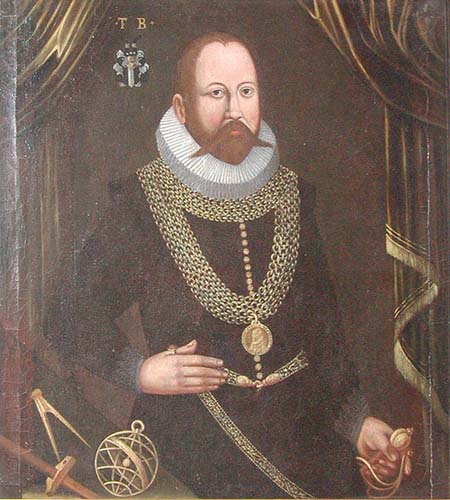
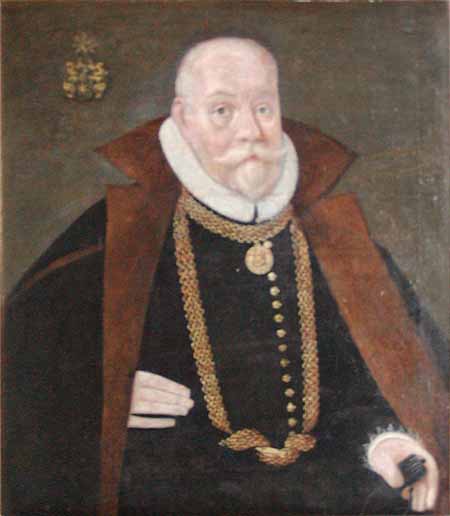
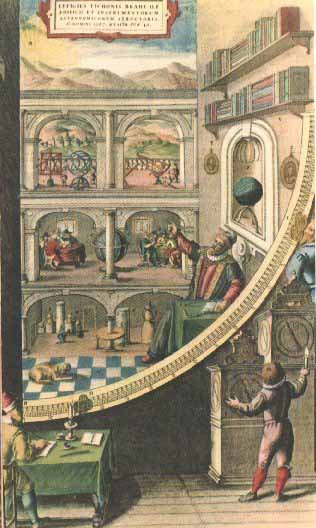
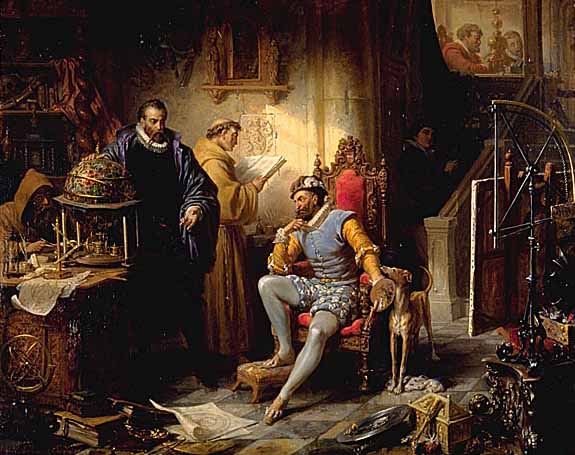
Tycho Brahe (December 14, 1546 Ð October 24, 1601), was a Danish (Scanian) nobleman astronomer as well as an astrologer and alchemist. He was granted an estate on the island of Hven and the funding to build the Uraniborg, an early research institute, where he built large astronomical instruments and took many careful measurements.
As an astronomer, Tycho worked to combine what he saw as the geometrical benefits of the Copernican system with the philosophical benefits of the Ptolemaic system into his own model of the universe, the Tychonic system. From 1600 until his death in 1601, he was assisted by Johannes Kepler, who would later use Tycho's astronomical information to develop his own theories of astronomy. He is universally referred to as "Tycho" rather than by his surname "Brahe", as was common in Scandinavia.
He is credited with the most accurate astronomical observations of his time, and the data were used by his assistant Kepler to derive the laws of planetary motion. No one before Tycho had attempted to make so many redundant observations, and the mathematical tools to take advantage of them had not yet been developed. He did what others before him were unable or unwilling to do - to catalogue the planets and stars with enough accuracy so as to determine whether the Ptolemaic or Copernican system was more valid in describing the heavens.
On April 19, 1559, Tycho began his studies at the University of Copenhagen. There, following the wishes of his uncle, he studied law but also studied a variety of other subjects and became interested in astronomy. It was, however, the eclipse which occurred on August 21, 1560, particularly the fact that it had been predicted, that so impressed him that he began to make his own studies of astronomy helped by some of the professors. He purchased an ephemeris and books such as Sacrobosco's Tractatus de Sphaera, Apianus's Cosmographia seu descriptio totius orbis and Regiomontanus' De triangulis Omnimodis.
Tycho realized that progress in the science of astronomy could be achieved not by occasional haphazard observations, but only by systematic and rigorous observation, night after night, and by using instruments of the highest accuracy obtainable. He was able to improve and enlarge the existing instruments, and construct entirely new ones.
Tycho's naked eye measurements of planetary parallax were accurate to the arcminute. His sister, Sophia, assisted Tycho in many of his measurements. These jealously guarded measurements became the possessions of Kepler following his death. Tycho was the last major astronomer to work without the aid of a telescope, soon to be turned toward the sky by Galileo.
While a student, Tycho lost part of his nose in a duel with rapiers with Manderup Parsbjerg, a fellow Danish nobleman. This occurred in the Christmas season of 1566, after a fair amount of drinking, while the just turned 20-year-old Tycho was studying at the University of Rostock in Germany. Attending a dance at a professor's house, he quarrelled with Parsbjerg. A subsequent duel (in the dark) resulted in Tycho losing the bridge of his nose. A consequence of this was that Tycho developed an interest in medicine and alchemy.
For the rest of his life, he was said to have worn a replacement made of silver and gold blended into a flesh tone, and used an adhesive balm to keep it attached. In 1901, though, Tycho's tomb was reopened and his remains were examined by medical experts. The nasal opening of the skull was rimmed with green, a sign of exposure to copper, not silver or gold. Some historians have speculated that he wore a number of different prosthetics for different occasions, noting that a copper nose would have been more comfortable and less heavy than one of precious metals.
Tycho was the preeminent observational astronomer of the pre-telescopic period, and his observations of stellar and planetary positions achieved unparalleled accuracy for their time. For example, Tycho measured Earth's axial tilt as 23 degrees and 31.5 minutes, which he claimed to be more accurate than Copernicus by 3.5 minutes. After his death, his records of the motion of the planet Mars enabled Kepler to discover the laws of planetary motion, which provided powerful support for the Copernican heliocentric theory of the solar system.
Tycho himself was not a Copernican, but proposed a system in which the Sun orbited the Earth while the other planets orbited the Sun. His system provided a safe position for astronomers who were dissatisfied with older models but were reluctant to accept the Earth's motion. It gained a considerable following after 1616 when Rome decided officially that the heliocentric model was contrary to both philosophy and Scripture, and could be discussed only as a computational convenience that had no connection to fact. His system also offered a major innovation: while both the geocentric model and the heliocentric model as set forth by Copernicus relied on the idea of transparent rotating crystalline spheres to carry the planets in their orbits, Tycho eliminated the spheres entirely.
He was aware that a star observed near the horizon appears with a greater altitude than the real one, due to atmospheric refraction, and he worked out tables for the correction of this source of error.To perform the huge number of products needed to produce much of his astronomical data, Tycho relied heavily on the then-new technique of prosthaphaeresis, an algorithm for approximating products based on trigonometric identities that predated logarithms.
Tycho argued that a nearby object should appear to shift its position with respect to the background. He published a small book, De Stella Nova (1573), thereby coining the term nova for a "new" star (we now know that Tycho's star in Cassiopeia was a supernova 7500 light years from earth, today known as SN 1572). This discovery was decisive for his choice of astronomy as a profession. Tycho was strongly critical of those who dismissed the implications of the astronomical appearance, writing in the preface to De Stella Nova: "O crassa ingenia. O caecos coeli spectatores" ("Oh thick wits. Oh blind watchers of the sky").
Tycho's discovery was the inspiration for Edgar Allan Poe's poem, Al Aaraaf. In 1998, Sky & Telescope magazine published an article by Donald W. Olson, Marilynn S. Olson and Russell L. Doescher arguing, in part, that Tycho's Supernova was also the same "star that's westward from the pole" in Shakespeare's Hamlet.
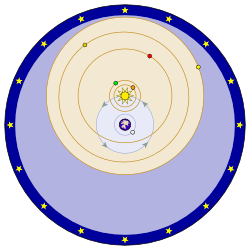
In this depiction of the Tychonic system, the objects on blue orbits (the moon and the sun) rotate around the earth. The objects on orange orbits (Mercury, Venus, Mars, Jupiter, and Saturn) rotate around the sun. Around all is sphere of fixed stars.
Kepler tried, but was unable, to persuade Tycho to adopt the heliocentric model of the solar system. Tycho believed in a modified geocentric model known as the Tychonic system, for the same reasons that he argued that the supernova of 1572 was not near the Earth. He argued that if the Earth were in motion, then nearby stars should appear to shift their positions with respect to background stars.
In fact, this effect of parallax does exist; it could not be observed with the naked eye, or even with the telescopes of the next two hundred years, because even the nearest stars are much more distant than most astronomers of the time believed possible. The Tychonic system is very similar to the Copernican one, except that it has a static earth instead of a static sun.
In the years following Galileo's observation of the phases of Venus in 1610, which made the Ptolemaic system intractable, the Tychonic system became the major competitor with Copernicanism, and was adopted by the Catholic Church for many years as its official astronomical conception of the universe.
King Frederick II of Denmark and Norway, impressed with Tycho's 1572 observations, financed the construction of two observatories for Tycho on the island of Hven in Oresund. These were Uraniborg and Stjerneborg. Uraniborg also had a laboratory for his alchemical experiments.
Because Tycho disagreed with Christian IV, the new king of his country, he left Hven in 1597 and moved to Prague in 1599. Sponsored by Rudolf II, the Holy Roman Emperor, he built a new observatory in a castle in Ben‡tky nad Jizerou, 50 km from Prague, and he worked there for one year. The emperor then had him move back to Prague, where he stayed until his death.In return for their support, Tycho's duties included preparing astrological charts and predictions for his patrons on events such as births, weather forecasting and astrological interpretations of significant astronomical events such as the comet of 1577 and the supernova of 1572.
Tycho was the preeminent observational astronomer of the pre-telescopic period, and his observations of stellar and planetary positions achieved unparalleled accuracy for their time.
For example, Tycho measured Earth's axial tilt as 23 degrees and 31.5 minutes, which he claimed to be more accurate than Copernicus by 3.5 minutes. After his death, his records of the motion of the planet Mars enabled Kepler to discover the laws of planetary motion, which provided powerful support for the Copernican heliocentric theory of the solar system.
Tycho himself was not a Copernican, but proposed a system in which the Sun orbited the Earth while the other planets orbited the Sun. His system provided a safe position for astronomers who were dissatisfied with older models but were reluctant to accept the Earth's motion. It gained a considerable following after 1616 when Rome decided officially that the heliocentric model was contrary to both philosophy and Scripture, and could be discussed only as a computational convenience that had no connection to fact. His system also offered a major innovation: while both the geocentric model and the heliocentric model as set forth by Copernicus relied on the idea of transparent rotating crystalline spheres to carry the planets in their orbits, Tycho eliminated the spheres entirely.
He was aware that a star observed near the horizon appears with a greater altitude than the real one, due to atmospheric refraction, and he worked out tables for the correction of this source of error.To perform the huge number of products needed to produce much of his astronomical data, Tycho relied heavily on the then-new technique of prosthaphaeresis, an algorithm for approximating products based on trigonometric identities that predated logarithms.
Tycho also worked in the area of weather prediction, produced astrological interpretations of the supernova of 1572 and the comet of 1577, and furnished his patrons Frederick II and Rudolph II with nativities and other predictions (thereby strengthening the ties between patron and client by demonstrating value).
An astrological worldview was fundamental to Tycho's entire philosophy of nature.
His interest in alchemy, particularly the medical alchemy associated with Paracelsus, was almost as long-standing as his study of astrology and astronomy simultaneously, and Uraniborg was constructed as both observatory and laboratory.In an introductory oration to the course of lectures he gave in Copenhagen in 1574, Tycho defended astrology on the grounds of correspondences between the heavenly bodies, terrestrial substances (metals, stones etc.) and bodily organs (medical astrology).
He was later to emphasise the importance of studying alchemy and astrology together with a pair of emblems bearing the mottos:
- Despiciendo suspicio ("By looking down I see upward") and Suspiciendo despicio ("By looking up I see downward").
However, recent investigations have suggested that Tycho did not die from urinary problems but most likely from mercury poisoning: toxic levels of it have been found in his hair and hair-roots. Tycho may have poisoned himself unintentionally by imbibing some mercury-containing medicine.3 Some have even speculated that Tycho may have been murdered, possibly by Kepler, though there is no solid evidence for this.
Tycho Brahe's body is currently interred in a tomb in the Church of Our Lady in front of Tyn near Old Town Square near the Astronomical Clock in Prague.
John Dee
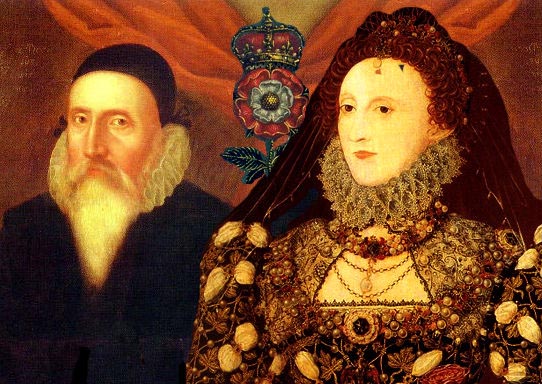
John Dee and Queen Elizabeth I
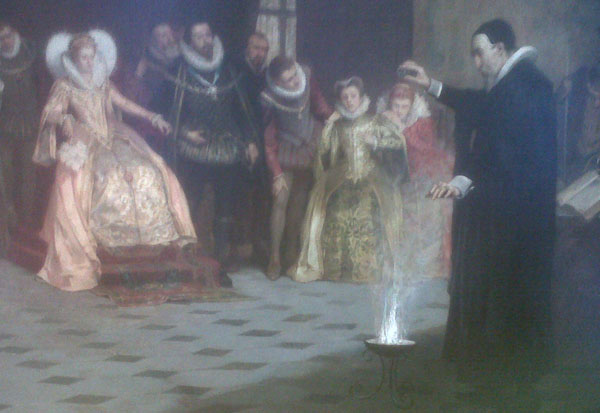
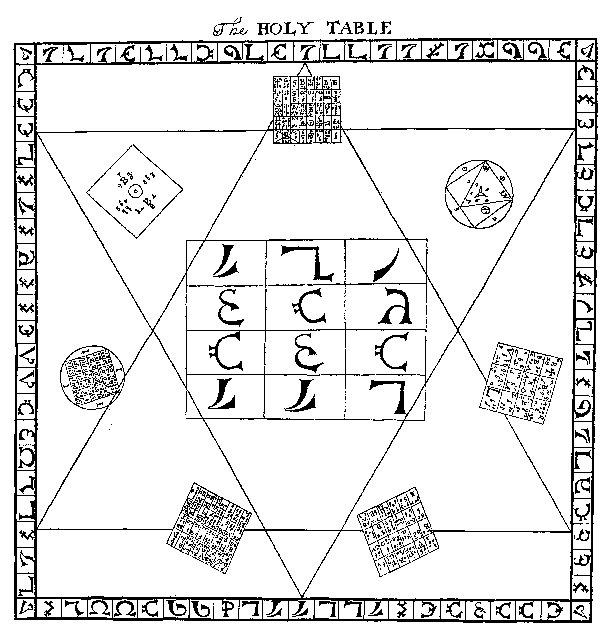
Dee straddled the worlds of science and magic just as they were becoming distinguishable. One of the most learned men of his time, he had lectured to crowded halls at the University of Paris when still in his early twenties. He was an ardent promoter of mathematics, a respected astronomer and a leading expert in navigation, having trained many of those who would conduct England's voyages of discovery.
(He coined the term "British Empire.") At the same time, he immersed himself deeply in Judeo-Christian magic and Hermetic philosophy, devoting the last third of his life almost exclusively to these pursuits. For Dee, as with many of his contemporaries, these activities were not contradictory, but particular aspects of a consistent world-view.
In the late 1540s and early 1550s, he travelled in Europe, studying at Leuven and Brussels and lecturing in Paris on Euclid. He studied with Gemma Frisius and became a close friend of the cartographer Gerardus Mercator, returning to England with an important collection of mathematical and astronomical instruments. In 1552, he met Gerolamo Cardano in London: during their acquaintance they investigated a perpetual motion machine as well as a gem purported to have magical properties.
Dee was offered a readership in mathematics at Oxford in 1554, which he declined, citing English universities' emphasis on rhetoric and grammar (which, together with logic, formed the academic trivium) over philosophy and science (the more advanced quadrivium, comprised of arithmetic, geometry, music, and astronomy) as offensive.
In 1555, Dee became a member of the Worshipful Company of Mercers, as his father had, through the company's system of patrimony. That year he was arrested and charged with "calculating" for having cast horoscopes of Queen Mary and Princess Elizabeth; the charges were expanded to treason against Mary. Dee appeared in the Star Chamber and exonerated himself, but was turned over to the reactionary Catholic Bishop Bonner for religious examination. His strong and lifelong penchant for secrecy perhaps worsening matters, this entire episode was only the most dramatic in a series of attacks and slanders that would dog Dee through his life. Clearing his name yet again, he soon became a close associate of Bonner.
Dee presented Queen Mary with a visionary plan for the preservation of old books, manuscripts and records and the founding of a national library in 1556, but his proposal was not taken up. Instead, he expanded his personal library at his house in Mortlake, tirelessly acquiring books and manuscripts in England and on the Continent. Dee's library, a center of learning outside the universities, became the greatest in England and attracted many scholars.
When Elizabeth took the throne in 1558, Dee became her trusted advisor on matters astrological and scientific, choosing Elizabeth's coronation date himself.
From the 1550s through the 1570s, he served as an advisor to England's voyages of discovery, providing technical assistance in navigation and ideological backing in the creation of a "British Empire", and was the first to use that term.
In 1577, Dee published General and Rare Memorials pertayning to the Perfect Arte of Navigation, a work that set out his vision of a maritime empire and asserted English territorial claims on the New World. Dee was acquainted with Humphrey Gilbert and was close to Sir Philip Sidney and his circle.
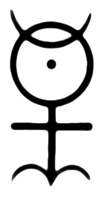
He published a "Mathematical Preface" to Henry Billingsley's English translation of Euclid's Elements in 1570, arguing the central importance of mathematics and outlining mathematics' influence on the other arts and sciences. Intended for an audience outside the universities, it proved to be Dee's most widely influential and frequently reprinted work.
By the early 1580s, Dee was growing dissatisfied with his progress in learning the secrets of nature and with his own lack of influence and recognition. He began to turn towards the supernatural as a means to acquire knowledge. Specifically, he sought to contact angels through the use of a "scryer" or crystal-gazer, who would act as an intermediary between Dee and the angels.
Dee's first attempts were not satisfactory, but in 1582 he met Edward Kelley, who impressed him greatly with his abilities. Dee took Kelley into his service and began to devote all his energies to his supernatural pursuits. These "spiritual conferences" or "actions" were conducted with an air of intense Christian piety, always after periods of purification, prayer and fasting.
Dee was convinced of the benefits they could bring to mankind. (The character of Kelley is harder to assess: some have concluded that he acted with complete cynicism, but delusion or self-deception are not out of the question. Kelley's "output" is remarkable for its sheer mass, its intricacy and its vividness.)
Dee maintained that the angels laboriously dictated several books to him this way, some in a special angelic or Enochian language.
In 1583, Dee met the visiting Polish nobleman Albert Aaski, who invited the Englishman to accompany him on his return to Poland. With some prompting by the angels, Dee was persuaded to go.
Dee, Kelley, and their families left for the Continent in September 1583, but Laski proved to be bankrupt and out of favor in his own country.
Dee and Kelley began a nomadic life in Central Europe, but they continued their spiritual conferences, which Dee recorded meticulously. He had audiences with Emperor Rudolf II and King Stephen of Poland in which he chided them for their ungodliness and attempted to convince them of the importance of his angelic communications. He was not taken up by either monarch.
During a spiritual conference in Bohemia in 1587, Kelley told Dee that the angel Uriel had ordered that the two men should share their wives. Kelley, who by that time was becoming a prominent alchemist and was much more sought-after than Dee, may have wished to use this as a way to end the spiritual conferences.
The order caused Dee great anguish, but he did not doubt its genuineness and apparently allowed it to go forward, but broke off the conferences immediately afterwards and did not see Kelley again. Dee returned to England in 1589.
Personal life - Dee was married three times and had eight children. His eldest son was Arthur Dee, about whom Dee wrote a letter to his headmaster at Westminster School which echos the worries of boarding school parents in every century; Arthur was also an alchemist and hermetic author. John Aubrey gives the following description of Dee: "He was tall and slender.
He wore a gown like an artist's gown, with hanging sleeves, and a slit.... A very fair, clear sanguine complexion... a long beard as white as milk. A very handsome man."
Final years - Dee returned to Mortlake after six years to find his library ruined and many of his prized books and instruments stolen. He sought support from Elizabeth, who finally made him warden of Christ's College, Manchester in Manchester (now Manchester Grammar School) in 1592. However, he was by now widely reviled as an evil magician and could not exert much control over the Fellows, who despised him. He left Manchester in 1605. By that time Elizabeth was dead, and James I, unsympathetic to anything related to the supernatural, provided no help. Dee spent his final years in poverty at Mortlake, where he died in late 1608 or early 1609. Unfortunately, both the parish registers and Dee's gravestone are missing.
Thought
Dee was an intensely pious Christian, but his Christianity was deeply influenced by the Hermetic and Platonic-Pythagorean doctrines that were pervasive in the Renaissance. He believed that number was the basis of all things and the key to knowledge, that God's creation was an act of "numbering". From Hermeticism, he drew the belief that man had the potential for divine power, and he believed this divine power could be exercised through mathematics.
His cabalistic angel magic (which was heavily numerological) and his work on practical mathematics (navigation, for example) were simply the exalted and mundane ends of the same spectrum, not the antithetical activities many would see them as today. His ultimate goal was to help bring forth a unified world religion through the healing of the breach of the Catholic and Protestant churches and the recapture of the pure theology of the ancients.
As the first public revelation of Dee's spiritual conferences, the book was extremely popular and sold quickly. Casaubon, who believed in the reality of spirits, argued in his introduction that Dee was acting as the unwitting tool of evil spirits when he believed he was communicating with angels. This book is largely responsible for the image, prevalent for the following two and a half centuries, of Dee as a dupe and deluded fanatic.
Around the same time the True and Faithful Relation was published, members of the Rosicrucian movement claimed Dee as one of their number. There is doubt, however, that an organized Rosicrucian movement existed during Dee's lifetime, and no evidence that he ever belonged to any secret fraternity.
Dee's reputation as a magician and the vivid story of his association with Edward Kelley have made him a seemingly irresistible figure to fabulists, writers of horror stories and latter-day magicians. The accretion of false and often fanciful information about Dee often obscures the facts of his life, remarkable as they are in themselves.
A re-evaluation of Dee's character and significance came in the 20th century, largely as a result of the work of the historian Frances Yates, who brought a new focus on the role of magic in the Renaissance and the development of modern science. As a result of this re-evaluation, Dee is now viewed as a serious scholar and appreciated as one of the most learned men of his day.
His personal library at Mortlake was the largest in the country, and was considered one of the finest in Europe, perhaps second only to that of de Thou. As well as being an astrological, scientific and geographical advisor to Elizabeth and her court, he was an early advocate of the colonization of North America and a visionary of a British Empire stretching across the North Atlantic.
Dee promoted the sciences of navigation and cartography. He studied closely with Gerardus Mercator, and he owned an important collection of maps, globes and astronomical instruments. He developed new instruments as well as special navigational techniques for use in polar regions. Dee served as an advisor to the English voyages of discovery, and personally selected pilots and trained them in navigation.
He believed that mathematics (which he understood mystically) was central to the progress of human learning. The centrality of mathematics to Dee's vision makes him to that extent more modern than Francis Bacon, though some scholars believe Bacon purposely downplayed mathematics in the anti-occult atmosphere of the reign of James I. It should be noted, though, that Dee's understanding of the role of mathematics is radically different from our contemporary view.
Dee's most long-lasting practical achievement may be his promotion of mathematics outside the universities. His "Mathematical Preface" to Euclid was meant to promote the study and application of mathematics by those without a university education, and was very popular and influential among the "mecanicians": the new and growing class of technical craftsmen and artisans. Dee's preface included demonstrations of mathematical principles that readers could perform themselves.
Dee was a friend of Tycho Brahe and was familiar with the work of Copernicus. Many of his astronomical calculations were based on Copernican assumptions, but he never openly espoused the heliocentric theory. Dee applied Copernican theory to the problem of calendar reform. His sound recommendations were not accepted, however, for political reasons.
He has often been associated with the Voynich Manuscript. Wilfrid M. Voynich, who bought the manuscript in 1912, suggested that Dee may have owned the manuscript and sold it to Rudolph II. Dee's contacts with Rudolph were far less extensive than had previously been thought, however, and Dee's diaries show no evidence of the sale.
The British Museum holds several items once owned by Dee and associated with the spiritual conferences:
- Dee's Speculum or Mirror (an obsidian Aztec cult object in the shape of a hand-mirror, brought to Europe in the late 1520s), which was once owned by Horace Walpole.
- The small wax seals used to support the legs of Dee's "table of practice" (the table at which the scrying was performed).
- The large, elaborately-decorated wax "Seal of God", used to support the "shew-stone", the crystal ball used for scrying.
- A gold amulet engraved with a representation of one of Kelley's visions.
- A crystal globe, six centimetres in diameter. This item remained unnoticed for many years in the mineral collection; possibly the one owned by Dee, but the provenance of this object is less certain than that of the others. In December 2004, both a shew-stone (a stone used for scrying) formerly belonging to Dee and a mid-1600s explanation of its use written by Nicholas Culpeper were stolen from the Science Museum in London; they were recovered shortly afterwards.
Edward Kelley
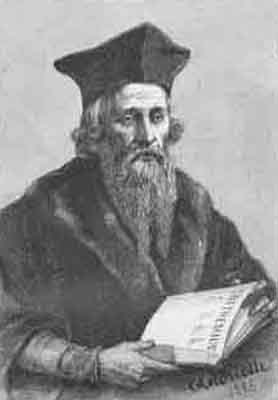
Edward Kelley or Kelly, also known as Edward Talbot (August 1, 1555 - 1597) was a convicted criminal and self-declared spirit medium who worked with John Dee in his magical investigations. Besides the 'ability' to summon spirits or angels on a crystal ball, which John Dee so valued, Kelley also claimed to possess the secret of transmuting base metals into gold.
Legends began to surround Kelley shortly after his death. His flamboyant biography, and his relative notoriety among English-speaking historians (chiefly because of his association with Dee) may have made him the source for the folklorical image of the alchemist-charlatan.
Birth and Early Career
With Dee in England
About a year after entering into Dee's service, Kelley appeared with an alchemical book (The Book of Dunstan) and a quantity of a red powder which, Kelley claimed, he and a certain John Blokley had been led to by a "spiritual creature" at Northwick Hill. (Accounts of Kelley's finding the book and the powder in the ruins of Glastonbury Abbey were first published by Elias Ashmole, but are contradicted by Dee's diaries.) With the powder (whose secret was presumably hidden in the book) Kelley believed he could prepare a red "tincture" which would allow him to transmute base metals into gold. He reportedly demonstrated its power a few times over the years, including in Bohemia (present Czech Republic) where he and Dee resided for many years.
With Dee in the Continent
Dee and Kelley lived a nomadic life in Central Europe. They continued with their spiritual conferences, though Kelley was more interested in alchemy than in scrying.In 1586, Kelley and Dee found the patronage of the wealthy Bohemian count Vilem Rozmberk. They settled in the town of Trebon and continued their researches.
In 1587, Kelley revealed to Dee that the angels had ordered them to share everything they had including their wives. It has been speculated that this was a way for Kelley to end the fruitless spiritual conferences so that he could concentrate on alchemy, which, under the patronage of Rozmberk was beginning to make Kelley wealthy.
Dee, anguished by the order of the angels, subsequently broke off the spiritual conferences even though he did share his (beautiful) wife. He did not see Kelley again after 1588, and returned to England the following year.
Apogee and fall
Around 1594, Kelley agreed to cooperate and produce gold; he was released and restored to his former status. Again he failed to produce, and was again imprisoned, this time in Hnevin Castle in Most. Kelley died in 1597 at the age of forty-two. A tradition has him dying while trying to escape: the story goes that he used an insufficiently long rope to lower himself from a tower, fell and broke his leg, and died from his injuries.
The Enochian Language
The angelic language was supposedly dictated by angels that Kelley claimed to see within a crystal ball. The angels were said to tap out letters on a complicated table, something like a crossword puzzle but with all the cells filled in. The first third were tapped out with each angelic word backwards; the following two thirds with each word forwards. Interestingly, there are no significant errors or discrepancies in word usage between the first and following parts.
The English translations were not tapped out but, according to Kelley, appeared on little strips of paper coming out of the angels' mouths.The reasoning that Kelley fabricated the language is based upon the claim that the angelic is just a word-for-word substitution for English translation.
This is not entirely the case, however, and there is tantalizing evidence of some other linguistic source. For example, the angelic word "telocvovim" is glossed as "he who has fallen" but it is actually a Germanic-like combination of two other angelic words: "teloch" (glossed as "death") and "vovin" (glossed as "dragon"). Thus "he who has fallen" would be literally translated as "death dragon", both rather obvious references to Lucifer. Interestingly, though, neither Kelley nor Dee appears to have noticed or remarked on this.
Another argument against Kelley's fabrication of angelic is that the english translations are in a very different style of writing to that of Kelley's own work, exhibiting an eldrich quality that seems beyond Kelley's own modest ability as a writer. This raises the possibility that Kelley might have plagiarized the material from a different source. However, no similar material has ever surfaced.
Dee considered the dictation of the angelic material as highly important for three reasons.
First, Dee believed the angelic represented a documentable case of true "glossalia" thereby proving that Kelley was actually speaking with angels and not from his imagination.
Second, the angels claimed that angelic was actually the original prototype of Hebrew and the language with which God spoke with Adam, and thus the first human language.
Third, the angelic material takes the form of a set of conjurations that are supposed to summon an extremely powerful set of angelic beings who, he believed, would be able to reveal many secrets, especially the key to the Philosopher's Stone.
Jacob Bohmen
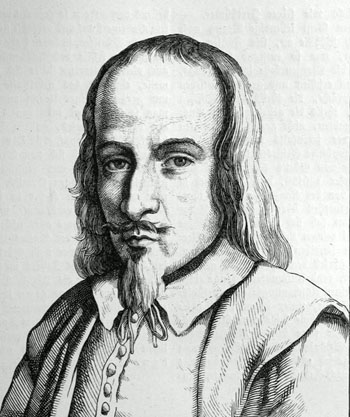
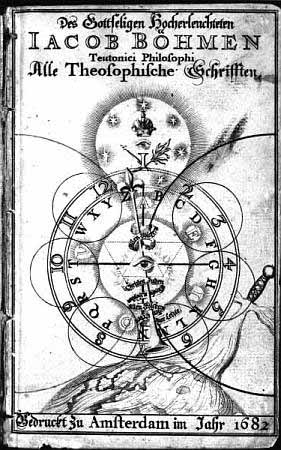
Jacob Bohmen, thought he could discover the secret of the transmutation of metals in the Bible, and who invented a strange heterogeneous doctrine of mingled alchemy and religion, and founded upon it the sect of the Aurea-crucians.
He was born at Gorlitz, in Upper Lusatia, in 1575; and followed, till his thirtieth year, the occupation of a shoemaker. In this obscurity he remained, with the character of a visionary and a man of unsettled mind, until the promulgation of the Rosicrucian philosophy in his part of Germany, toward the year 1607 or 1608.
From that time he began to neglect his leather, and buried his brain under the rubbish of metaphysics.
The works of Paracelsus fell into his hands; and these, with the reveries of the Rosicrucians, so completely engrossed his attention that be abandoned his trade altogether, sinking, at the same time, from a state of comparative independence into poverty and destitution.
But he was nothing daunted by the miseries and privations of the flesh; his mind was fixed upon the beings of another sphere, and in thought he was already the new apostle of the human race. In the year 1612, after a meditation of four years, he published his first work, entitled "Aurora; or, The Rising of the Sun;" embodying the ridiculous notions of Paracelsus, and worse confounding the confusion of that writer.
The philosopher's stone might, he contended, be discovered by a diligent search of the Old and New Testaments, and more especially of the Apocalypse, which alone contained all the secrets of alchymy.
He contended that the Divine Grace operated by the same rules, and followed the same methods, that the Divine Providence observed in the natural world; and that the minds of men were purged from their vices and corruptions in the very same manner that metals were purified from their dross, namely, by fire.
Besides the sylphs, gnomes, undines, and salamanders, he acknowledged various ranks and orders of demons. He pretended to invisibility and absolute chastity. He also said that, if it pleased him, he could abstain for years from meat and drink, and all the necessities of the body.
It is needless, however, to pursue his follies any further. He was reprimanded for writing this work by the magistrates of Gorlitz, and commanded to leave the pen alone and stick to his wax, that his family might not become chargeable to the parish. He neglected this good advice, and continued his studies; burning minerals and purifying metals one day, and mystifying the Word of God on the next.
He afterwards wrote three other works, as sublimely ridiculous as the first.
The one was entitled Metallurgia, and has the slight merit of being the least obscure of his compositions. Another was called The Temporal Mirror of Eternity and the last his Theosophy Revealed, full of allegories and metaphors.
Many of them became, during the seventeenth century, as distinguished for absurdity as their master; amongst whom may be mentioned Gifftheil, Wendenhagen, John Jacob Zimmermann, and Abraham Frankenberg. Their heresy rendered them obnoxious to the Church of Rome; and many of them suffered long imprisonment and torture for their faith. One, named Kuhlmann, was burned alive at Moscow, in 1684, on a charge of sorcery.
Bohmen's works were translated into English, and published, many years afterwards by an enthusiast, named William Law.
Bohmen died in 1624, leaving behind him a considerable number of admiring disciples.
Heinrich Khunrath
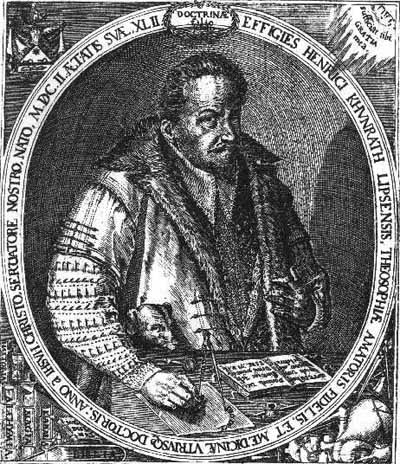
Heinrich Khunrath or Dr Henricus Khunrath as he was also called, was a famous physician, Hermetic philosopher, and alchemist. His most famous work is the Amphitheatrum Sapientiae Aeternae (Amphitheater of Eternal Wisdom), a work on the mystical aspects of alchemy, which contains the oft-seen engraving entitled "The First Stage of the Great Work," better-known as the "Alchemist's Laboratory." Amphitheatrum Sapientiae Aeternae was first published at Hamburg in 1595, but then made more widely available in an expanded edition published in Hanau in 1609. Frances Yates considered him to be a link between the philosophy of John Dee and Rosicrucianism.
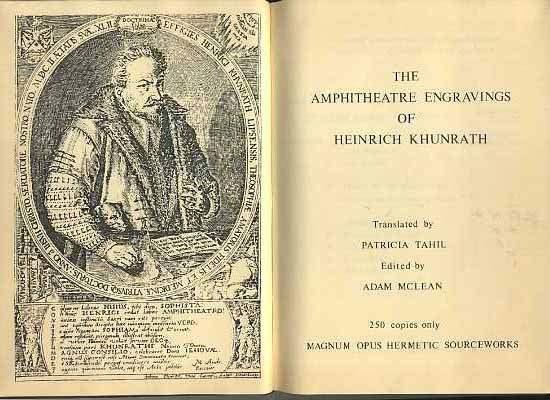
Heinrich Khunrath's biography is as uncertain as his work is enigmatic. He was born in Germany, probably in Dresden or Leipzig, around the year 1560. He might be related to another physician from Leipzig named Conrad Khunrath. In the winter of 1570, he may have enrolled at the University of Leipzig under the name of Henricus Conrad Lips. The uncertanties surrounding his life stem from his supposed use of multiple names. It is certain that in May 1588, he matriculated at the University of Basel, Switzerland, earning his Medicin¾ Doctor degree on September 3, 1588 after a defense of twenty-eight doctoral theses.
Khunrath, a disciple of Paracelsus, practiced medicine in Dresden, Magdeburg, and Hamburg and may have held a professorial position in Leipzig. He followed Paracelsian beliefs of divine initation into wisdom. He worked to develop Christianized natural magic; he sought to find the secret primary matter that would lead humankind into eternal wisdom. Yet he held experience and observation, to be the basis of his work, as would a natural philosopher.
This is not to say that Khunrath's vision was shared by most natural philosophers of his time.
He believed himself to be an adept of spiritual alchemy; as such, he expected the path to spiritual perfection to be a many-staged and intricate process. Certainly the language he used to describe the process sounds odd to modern ears.
He travelled widely after 1588, including a stay at the Imperial court in Prague, home to the mystically inclined Rudolf II von Habsburg.
During this court stay Khunrath met noted magician John Dee in 1589 while the latter was confined in prison. Dee probably became Khunrath's mentor in hermetic philosophy and he praised Dee in many of his later works.
In September 1591, Khunrath was appointed court physician to Count Rosemberk in Trebona. He probably met Johann Tholde while at Trebona, one of the suggested authors of the "Basilius Valentinus" treatises on alchemy.
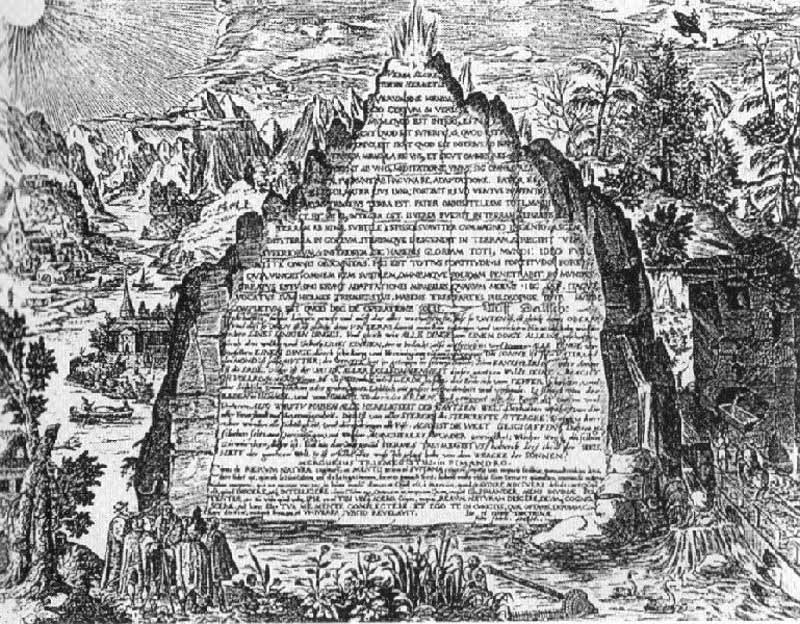
A 17th century depiction of the Tablet by Heinrich Khunrath, 1606
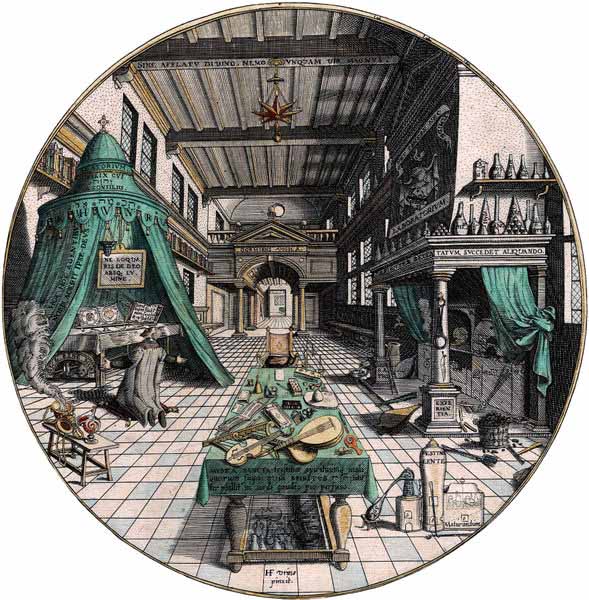
Khunrath's brushes with Dee and Thšlde and Paracelsian beliefs led him to develop a Christianized natural magic, seeking to find the secret prima materia that would lead man into eternal wisdom. He also held that experience and observation were essential to practical alchemical research, as would a natural philosopher.
His first known work on alchemy, Amphitheatrum Sapientiae Aeternae (Amphitheater of Eternal Wisdom), was first published at Hamburg in 1595. Amphitheatrum Sapientiae Aeternae is an alchemical classic, combining both Christianity and magic and illustrated with elaborate, hand-colored, engraved plates heightened with gold and silver. In it, Khunrath showed himself to be an adept of spiritual alchemy and illustrated the many-staged and intricate path to spiritual perfection. Some of the ideas in his works are Kabbalistic in nature and foreshadow Rosicrucianism.
Amphitheatrum Sapientiae Aeternae was condemned by the Sorbonne on February 1, 1625. However, it remained popular throughout the seventeenth century and has been republished in numerous editions even in the twentieth century.
Khunrath's motto, used in many of his works, was "Was helffn Fackeln, Liecht oder Brilln, Wann die Leute nicht sehen wšlln?" (What good are torches, light, or spectacles, to those who will not see?) He viewed his work as a path to illumination.
Khunrath may have encountered some opposition to his alchemical work because most of his publications on alchemy were published widely after his death. He died in poverty in either Dresden or Leipzig on September 9, 1605. The tension between spirituality and experiment in Amphitheatrum Sapientiae Aeternae brought about it's condemnation by the Sorbonne in 1625.
Located in the Duveen Collection in the Department of Special Collections, University of Wisconsin-Madison, this is a rare copy of the first edition of this work. There are several other editions, some with additional plates, though lacking in general the generous margins and hand-coloring of the copy in Madison. Only two other copies of this first edition, described by Denis Duveen as "one of the most important books in the whole literature of theosophical alchemy and the occult sciences," are known to exist.
With funding generously provided by the Brittingham Fund, the Department of Special Collections has undertaken the construction of this Web-based introduction to Heinrich Khunrath's Amphitheatrum sapientiae aeternae (1595). Because the engraved illustrations are packed with symbolic as well as textual information arrayed either on radii or concentric circles, we have provided for close-up examination of important iconographic features, and also transcribed the engraved text surrounding the circular images.
Michal Sedziwoj
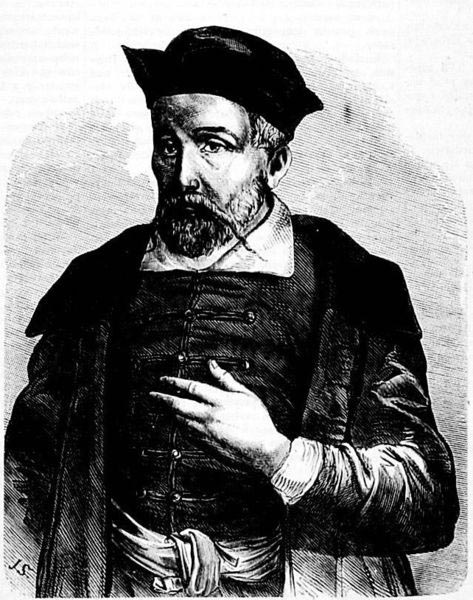
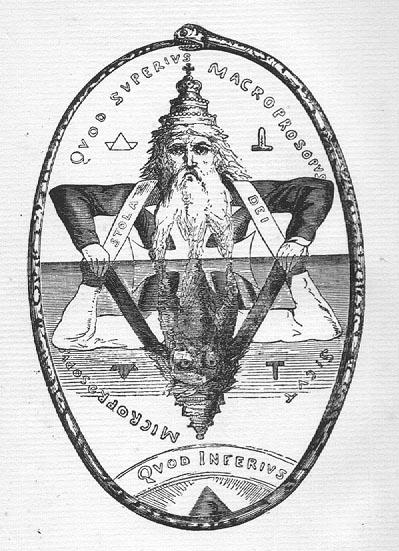
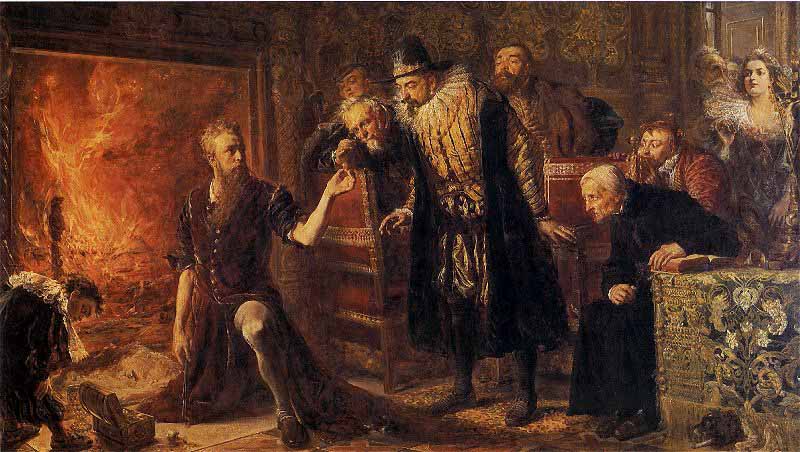
Michal Sedziwoj a Polish alchemist, philosopher, medical doctor. A pioneer of chemistry, he developed ways of purification and creation of various acids, metals and other chemical compounds.
He discovered that air is not a single substance and contains a life-giving substance - later called oxygen - 170 years before Scheele and Priestley. He correctly identified this 'food of life' with the gas (also oxygen) given off by heating nitre (saltpetre). This substance, the 'central nitre', had a central position in Sendivogius' schema of the universe. A pioneer of chemistry, he also developed methods for isolating and purifying various acids, metals and other chemical compounds.
In the 1590s Sendivogius was active in Prague, at the famously open-minded court of Rudolf II. In Poland he appeared at the court of King Sigismund III Vasa around 1600, and quickly achieved notoriety, as the Polish king was himself an alchemy enthusiast and even conducted experiments with Sedziwoj.
In Krakow's Wawel castle, the chamber where his experiments were performed is still intact. The more conservative Polish nobles soon came to dislike him for encouraging the king to expend vast sums of money on chemical experimentation. The more practical aspects of his work in Poland involved the design of mines and metal foundries. His widespread international contacts led to him being employed as a diplomat from about 1600.
His works and books, the most famous of which was 'A New Light of Alchemy' (Latin original published in 1605), were written in alchemical language, in effect a secret code which was understandable only by other alchemists. Besides a relatively clear exposition of Sendivogius's theory on the existence of a 'food of life' in air (ie Oxygen), his books contain various scientific, pseudo-scientific and philosophical theories, and were repeatedly translated and widely read among such worthies as Isaac Newton into the 18th century.
In his later years, Sedziwoj spent more time in Bohemia and Moravia (now in the Czech Republic), where he had been granted lands by the Habsburg emperor. Near the end of his life, Sedziwoj settled in Prague, on court of Rudolf II, where he gained even more fame as a designer of metal mines and foundries.
However the Thirty Years' War of 1618-48 had effectively ended the golden age of alchemy: the rich patrons now spent their money on financing war rather than chemical speculation, and Sendivogius died in relative obscurity.
Jan Baptista van Helmont
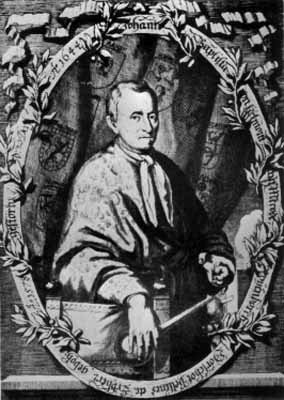
Jan Baptist van Helmont (January 12, 1577 - December 30, 1644) was a Flemish chemist, physiologist and physician. Born into a noble family in Brussels, he was educated at Leuven, and after ranging restlessly from one science to another and finding satisfaction in none, turned to medicine, in which he took his doctor's degree in 1599.
The next few years he spent in traveling through Switzerland, Italy, France, and England. Returning to his own country he was at Antwerp at the time of the great plague in 1605, and having contracted a rich marriage settled in 1609 at Vilvoorde, near Brussels, where he occupied himself with chemical experiments and medical practice until his death.
Van Helmont presents curious contradictions. On the one hand he was a disciple of Paracelsus (though he scornfully repudiates his errors as well as those of most other contemporary authorities), a mystic with strong leanings to the supernatural, an alchemist who believed that with a small piece of the philosopher's stone he had transmuted 2,000 times as much mercury into gold; on the other hand he was touched with the new learning that was producing men like Harvey, Galileo and Bacon, a careful observer of nature, and an exact experimenter who in some cases realized that matter can neither be created nor destroyed.
As a chemist he deserves to be regarded as the founder of pneumatic chemistry, even though it made no substantial progress for a century after his time, and he was the first to understand that there are gases distinct in kind from atmospheric air.
The very word "gas" he claims as his own invention, and he perceived that his "gas sylvestre" (our carbon dioxide) given off by burning charcoal is the same as that produced by fermenting must and that which sometimes renders the air of caves irrespirable. For him air and water are the two primitive elements of things.
Fire he explicitly denies to be an element, and earth is not one because it can be reduced to water. That plants, for instance, are composed of water he sought to show by the ingenious quantitative experiment of planting a willow weighing 5 lb (2 kg) in 200 lb (90 kg) of dry soil and allowing it to grow for five years; at the end of that time it had become a tree weighing 169 lb (76 kg), and since it had received nothing but water and the soil weighed practically the same as at the beginning, he argued that the increased weight of wood, bark and roots had been formed from water alone.
It was an old idea that the processes of the living body are fermentative in character, but he applied it more elaborately than any of his predecessors. For him digestion, nutrition, and even movement are due to ferments, which convert dead food into living flesh in six stages. But having got so far, with the application of chemical principles to physiological problems, he introduces a complicated system of supernatural agencies like the archeus of Paracelsus, which preside over and direct the affairs of the body.
A central archeus controls a number of subsidiary archei which move through the ferments, and just as diseases are primarily caused by some affection (exorbitatio) of the archeus, so remedies act by bringing it back to the normal.
At the same time chemical principles guided him in the choice of medicines - undue acidity of the digestive juices, for example, was to be corrected by alkalis and vice versa; he was thus a forerunner of the iatrochemical school, and did good service to the art of medicine by applying chemical methods to the preparation of drugs. Over and above the archeus he taught that there is the sensitive soul which is the husk or shell of the immortal mind.
Before the Fall the archeus obeyed the immortal mind and was directly controlled by it, but at the Fall men received also the sensitive soul and with it lost immortality, for when it perishes the immortal mind can no longer remain in the body.
In addition to the archeus, which he described as "aura vitalis seminum, vitae directrix," Van Helmont had other governing agencies resembling the archeus and not always clearly distinguished from it. From these he invented the term blas, defined as the "vis motus tam alterivi quam localis. Of blas there were several kinds, e.g. blas humanum and blas meteoron; the heavens he said, "constare gas materia et blas efficiente.
He was a faithful Catholic, but incurred the suspicion of the Church by his tract De magnetica vulnerum curatione (1621), which defended Rudolf Goclenius, Jr., a Calvinist professor of medicine at the University of Marburg, against the Jesuit Johannes Roberti.
The Spanish Inquisition persecuted him as it was thought that his "magnetic cure" derogated from some of the miracles.
From 1633 to 1636, he was arrested and could not publish until 1642. His works were collected and published at Amsterdam as Ortus medicinae, vel opera et opuscula omnia in 1648 by his son Franz Mercurius (b. 1618 at Vilvorde, d. 1699 at Berlin), in whose own writings e.g. Cabbalah Denudata (1677) and Opuscula Philosophica (1690) mystical theosophy and alchemy appear in still wilder confusion.
Robert Boyle
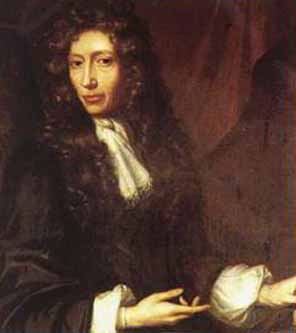
The Honorable Robert Boyle (January 25, 1627 - December 30, 1691) was an Irish natural philosopher (chemist, physicist, and inventor) , noted for his work in physics and chemistry. Although his research and personal philosophy clearly has its roots in the alchemical tradition, he is largely regarded today as the first modern chemist. Among his works The Sceptical Chymist is seen as a cornerstone book in the field of chemistry.
He was born at Lismore Castle, in the province of Munster, Ireland, as the seventh son and fourteenth child of Richard Boyle, the "Great Earl of Cork". While still a child he learned to speak Latin, Greek and French, and he was only eight years old when he was sent to Eton College, of which his father's friend, Sir Henry Wotton, was then provost. After spending over three years at the college, he went to travel abroad with a French tutor. Nearly two years were passed in Geneva; visiting Italy in 1641, he remained during the winter of that year in Florence, studying the "paradoxes of the great star-gazer" Galileo Galilei, who died within a league (3 miles) of the city early in 1642.
Returning to England in 1645 he found that his father was hospitalized and had left him the manor of Stalbridge in Dorset, together with estates in Ireland. From that time he gave up his life to study and scientific research, and soon took a prominent place in the band of inquirers, known as the "Invisible College," who devoted themselves to the cultivation of the "new philosophy."
-
The Invisible College refers mainly to the intrinsic ideology of the
free transfer of thought and technical expertise, usually carried out
without the establishment of designated facilities or authority
structure, spread by a loosely connected system of word-of-mouth
referral or localized bulletin-board system, and supported through
barter (i.e. trade of knowledge or services) or apprenticeship. In
earlier times the term also included certain Hegelian aspects of secret
societies and occultism.
-
It is akin to the old guild system, yet holds no sway in recognized
scholastic, technical or political circles. It is merely an attempt to
circumvent bureaucratic or monetary obstacles by knowledgeable
individuals and civic groups. Said entities generally feel a need to
share their methods with fellow journeymen, so to speak, and to
strengthen local techniques through collaboration. In short, it is a
grassroots educational system.
An account of the work he did with this instrument was published in 1660 under the title New Experiments Physico-Mechanical. Among the critics of the views put forward in this book was a Jesuit, Franciscus Linus (1595-1675), and it was while answering his objections that Boyle enunciated the law that the volume of a gas varies inversely as the pressure, which among English-speaking peoples is usually called after his name, though on the continent of Europe it is attributed to Edme Mariotte, who did not publish it till 1676. In 1663 the Invisible College became the Royal Society of London for the Improvement of Natural Knowledge, and the charter of incorporation granted by Charles II of England, named Boyle a member of the council. In 1680 he was elected president of the society, but declined the honor from a scruple about oaths.
It was during his time at Oxford that Boyle was a Chevalier. The Chevaliers are thought to have been established by royal order a few years before Boyle's time at Oxford. The period of Boyle's residence was marked by the reactionary actions of the victorious parliamentarian forces, consequently this period marked the most secretive period of Chevalier movements and thus little is known about Boyle's involvement beyond his membership. In 1668 he left Oxford for London where he resided at the house of his sister, Lady Ranelagh, in Pall Mall.
About 1689 his health, never very strong, began to fail seriously and he gradually withdrew from his public engagements, ceasing his communications to the Royal Society, and advertising his desire to be excused from receiving guests, "unless upon occasions very extraordinary," on Tuesday and Friday forenoon, and Wednesday and Saturday afternoon. In the leisure thus gained he wished to "recruit his spirits, range his papers," and prepare some important chemical investigations which he proposed to leave "as a kind of Hermetic legacy to the studious disciples of that art," but of which he did not make known the nature. His health became still worse in 1691, and his death occurred on December 30 of that year, just a week after that of the sister with whom he had lived for more than twenty years. He was buried in the churchyard of St Martin's in the Fields, his funeral sermon being preached by his friend Bishop Burnet. In his will, Boyle endowed a series of Lectures which came to be known as the Boyle Lectures.
Boyle's great merit as a scientific investigator is that he carried out the principles which Francis Bacon preached in the Novum Organum.
-
The Novum Organum is a philosophical work by Francis Bacon published in
1620. The title translates as "new organ" or "instrument". This is a
reference to Aristotle's work Organon which was his treatise on logic
and syllogism. In Novum Organum, Bacon details a new system of logic he
believes to be superior to the old ways of syllogism. For Bacon, finding
the essence of a thing was a simple process of reduction. One must list
all the things which cause the object in question, and then dismiss
each one as the primary cause until only one was left. This work was
critical in the historical development of the scientific method.
He himself was an alchemist; and believing the transmutation of metals to be a possibility, he carried out experiments in the hope of effecting it; and he was instrumental in obtaining the repeal, in 1689, of the statute of Henry IV against multiplying gold and silver. With all the important work he accomplished in physics - the enunciation of Boyle's law, the discovery of the part taken by air in the propagation of sound, and investigations on the expansive force of freezing water, on specific gravities and refractive powers, on crystals, on electricity, on color, on hydrostatics, etc.- chemistry was his peculiar and favourite study.
His first book on the subject was The Sceptical Chemist, published in 1661, in which he criticized the "experiments whereby vulgar Spagyrists are wont to endeavour to evince their Salt, Sulphur and Mercury (element) to be the true Principles of Things." For him chemistry was the science of the composition of substances, not merely an adjunct to the arts of the alchemist or the physician. He advanced towards the modern view of elements as the undecomposable constituents of material bodies; and understanding the distinction between mixtures and compounds, he made considerable progress in the technique of detecting their ingredients, a process which he designated by the term "analysis."
He further supposed that the elements were ultimately composed of particles of various sorts and sizes, into which, however, they were not to be resolved in any known way. Applied chemistry had to thank him for improved methods and for an extended knowledge of individual substances. He also studied the chemistry of combustion and of respiration, and conducted experiments in physiology, where, however, he was hampered by the "tenderness of his nature" which kept him from anatomical dissections, especially of living animals, though he knew them to be "most instructing."
Besides being a busy natural philosopher, Boyle devoted much time to theology, showing a very decided leaning to the practical side and an indifference to controversial polemics. At the Restoration he was favourably received at court, and in 1665 would have received the provostship of Eton, if he would have taken orders; but this he refused to do on the ground that his writings on religious subjects would have greater weight coming from a layman than a paid minister of the Church. As a director of the East India Company he spent large sums in promoting the spread of Christianity in the East, contributing liberally to missionary societies, and to the expenses of translating the Bible or portions of it into various languages. He founded the Boyle lectures, intended to defend the Christian religion against those he considered "notorious infidels, namely atheists, theists, pagans, Jews and Muslims," with the proviso that controversies between Christians were not to be mentioned.
In person Boyle was tall, slender and of a pale countenance. His constitution was far from robust, and throughout his life he suffered from feeble health and low spirits. While his scientific work procured him an extraordinary reputation among his contemporaries, his private character and virtues, the charm of his social manners, his wit and powers of conversation, endeared him to a large circle of personal friends. He was never married. His writings are exceedingly voluminous, and his style is clear and straightforward, though undeniably prolix.
In 2004 The Robert Boyle Science Room was opened in the Lismore Heritage Centre, near his birthplace, dedicated to his life and works where students have the opportunity of studying science and participating in scientific experiments.

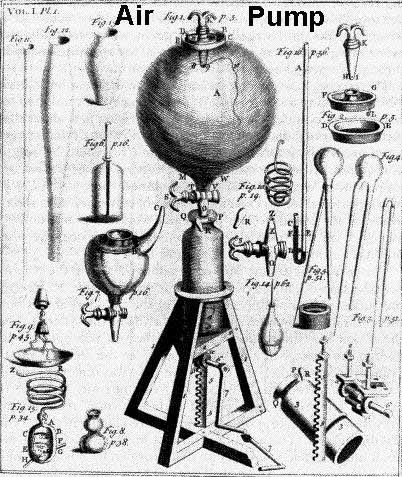
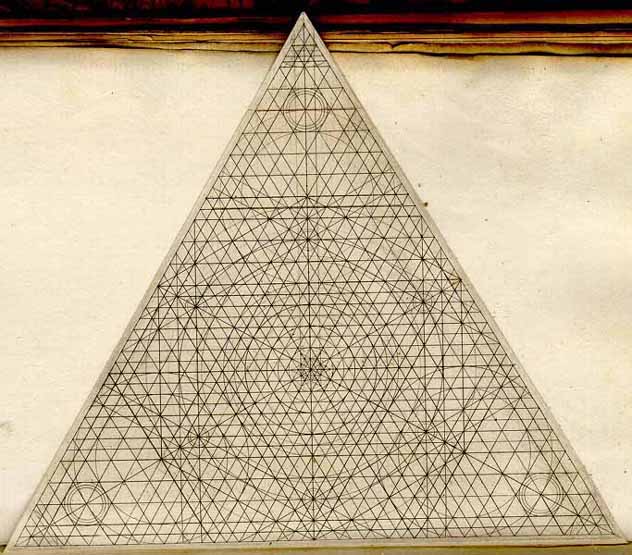
John Mayow
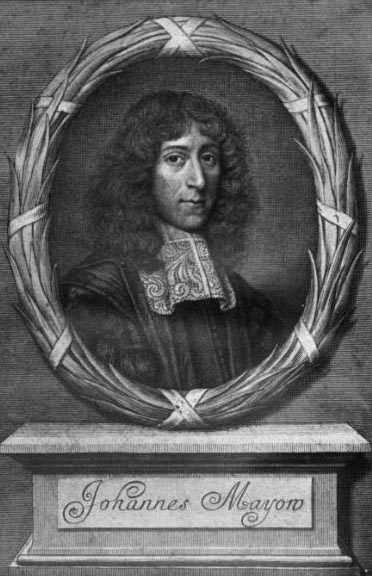
John Mayow (May, 1643 - September, 1679), English chemist and physiologist, was born in London. At the age of fifteen he went up to Wadham College, Oxford, of which he became a scholar a year later, and in 1660 he was elected to a fellowship at All Souls. He graduated in law (bachelor, 1665, doctor, 1670), but made medicine his profession, and became noted for his practice--therein, especially in the summer time, in the city of Bath.
In 1678, on the proposal of Robert Hooke, he was chosen a fellow of the Royal Society. The following year, after a marriage which was not altogether to his content, he died in London in September 1679. He published at Oxford in 1668 two tracts, on respiration and rickets, and in 1674 these were reprinted, the former in an enlarged and corrected form, with three others De sal-nitro et spiritu nitro-aereo, De respiratione foetus in utero et ovo, and De motu musculari et spiritibus animalibus as Tractatus quinque medico-physici.
The contents of this work, which was several times republished and translated into Dutch, German and French, show him to have been an investigator much in advance of his time.
Accepting as proved by Boyle's experiments that air is necessary for combustion, he showed that fire is supported not by the air as a whole but by a more active and subtle part of it. This part he called "spiritus igneo-aereus," or sometimes "nitro-aereus"; for he identified it with one of the constituents of the acid portion of nitre which he regarded as formed by the union of fixed alkali with a spiritus acidus. In combustion the particulae nitro-aereae--either pre-existent in the thing consumed or supplied by the air combined with the material burnt; as he inferred from his observation that antimony, strongly heated with a burning glass, undergoes an increase of weight which can be attributed to nothing else but these particles.
In respiration he argued that the same particles are consumed, because he found that when a small animal and a lighted candle were placed in a closed vessel full of air the candle first went out and soon afterwards the animal died, but if there was no candle present it lived twice as long.
He concluded that this constituent of the air is absolutely necessary for life, and supposed that the lungs separate it from the atmosphere and pass it into the blood. It is also necessary, he inferred, for all muscular movements, and he thought there was reason to believe that the sudden contraction of muscle is produced by its combination with other combustible (salino-sulphureous) particles in the body; hence the heart, being a muscle, ceases to beat when respiration is stopped. Animal heat also is due to the union of nitro-aerial particles, breathed in from the air, with the combustible particles in the blood, and is further formed by the combination of these two sets of particles in muscle during violent exertion.
In effect, therefore, Mayow--who also gives a remarkably correct anatomical description of the mechanism of respiration--preceded Priestley and Lavoisier by a century in recognizing the existence of oxygen, under the guise of his "spiritus nitro-aereus," as a separate entity distinct from the general mass of the air; he perceived the part it plays in combustion and in increasing the weight of the calces of metals as compared with metals themselves; and, rejecting the common notions of his time that the use of breathing is to cool the heart, or assist the passage of the blood from the right to the left side of the heart, or merely to agitate it, he saw in inspiration a mechanism for introducing oxygen into the body, where it is consumed for the production of heat and muscular activity, and even vaguely conceived of expiration as an excretory process.
Isaac Newton

Sir Isaac Newton (January 4, 1643 - March 31, 1727) was an English mathematician, physicist, astronomer, alchemist, and natural philosopher who is generally regarded as one of the greatest scientists and mathematicians in history. Newton wrote the Philosophiae Naturalis Principia Mathematica, in which he described universal gravitation and the three laws of motion, laying the groundwork for classical mechanics. By deriving Kepler's laws of planetary motion from this system, he was the first to show that the motion of objects on Earth and of celestial bodies are governed by the same set of natural laws. The unifying and deterministic power of his laws was integral to the scientific revolution and the advancement of heliocentrism.
Among other scientific discoveries, Newton realized that the spectrum of colors observed when white light passes through a prism is inherent in the white light and not added by the prism (as Roger Bacon had claimed in the thirteenth century), and notably argued that light is composed of particles.
He also developed a law of cooling, describing the rate of cooling of objects when exposed to air.
He enunciated the principles of conservation of momentum and angular momentum.
Finally, he studied the speed of sound in air, and voiced a theory of the origin of stars.
Despite this renown in mainstream science, Newton actually spent more time working on alchemy than physics, writing considerably more papers on the former than the latter.
Newton played a major role in the development of calculus, sharing credit with Gottfried Leibniz. He also made contributions to other areas of mathematics, for example the generalized binomial theorem. The mathematician and mathematical physicist Joseph Louis Lagrange (1736-1813), said that "Newton was the greatest genius that ever existed and the most fortunate, for we cannot find more than once a system of the world to establish."
From the age of about twelve until he was seventeen, Newton was educated at The King's School in Grantham (where his signature can still be seen upon a library window sill). He was removed from school and by Oct 1659 he was to be found at Woolsthorpe, where his mother attempted to make a farmer of him. He was, by later reports of his contemporaries, thoroughly unhappy with the work. It appears to be Henry Stokes, master at the King's School, who persuaded his mother to send him back to school so that he might complete his education.
In June 1661 he matriculated to Trinity College, Cambridge. At that time, the college's teachings were based on those of Aristotle, but Newton preferred to read the more advanced ideas of modern philosophers such as Descartes and astronomers such as Galileo, Copernicus and Kepler.
When Newton arrived in Cambridge in 1661, the movement now known as the scientific revolution was well advanced, and many of the works basic to modern science had appeared. Astronomers from Copernicus to Kepler had elaborated the heliocentric system of the universe. Galileo had proposed the foundations of a new mechanics built on the principle of inertia. Led by Descartes, philosophers had begun to formulate a new conception of nature as an intricate, impersonal, and inert machine. Yet as far as the universities of Europe, including Cambridge, were concerned, all this might well have never happened. They continued to be the strongholds of outmoded Aristotelianism, which rested on a geocentric view of the universe and dealt with nature in qualitative rather than quantitative terms.
Like thousands of other undergraduates, Newton began his higher education by immersing himself in Aristotle's work. Even though the new philosophy was not in the curriculum, it was in the air. Some time during his undergraduate career, Newton discovered the works of the French natural philosopher Rene Descartes and the other mechanical philosophers, who, in contrast to Aristotle, viewed physical reality as composed entirely of particles of matter in motion and who held that all the phenomena of nature result from their mechanical interaction.
A new set of notes, which he entitled Quaestiones Quaedam Philosophicae (Certain Philosophical Questions), begun sometime in 1664, usurped the unused pages of a notebook intended for traditional scholastic exercises; under the title he entered the slogan "Amicus Plato amicus Aristoteles magis amica veritas" ("Plato is my friend, Aristotle is my friend, but my best friend is truth").
Newton's scientific career had begun.
The "Quaestiones" reveal that Newton had discovered the new conception of nature that provided the framework of the scientific revolution. He had thoroughly mastered the works of Descartes and had also discovered that the French philosopher Pierre Gassendi had revived atomism, an alternative mechanical system to explain nature. The "Quaestiones" also reveal that Newton already was inclined to find the latter a more attractive philosophy than Cartesian natural philosophy, which rejected the existence of ultimate indivisible particles.
The works of the 17th-century chemist Robert Boyle provided the foundation for Newton's considerable work in chemistry. Significantly, he had read Henry More, the Cambridge Platonist, and was thereby introduced to another intellectual world, the magical Hermetic tradition, which sought to explain natural phenomena in terms of alchemical and magical concepts. The two traditions of natural philosophy, the mechanical and the Hermetic, antithetical though they appear, continued to influence his thought and in their tension supplied the fundamental theme of his scientific career.
Although he did not record it in the "Quaestiones," Newton had also begun his mathematical studies. He again started with Descartes, from whose La Geometrie he branched out into the other literature of modern analysis with its application of algebraic techniques to problems of geometry. He then reached back for the support of classical geometry. Within little more than a year, he had mastered the literature; and, pursuing his own line of analysis, he began to move into new territory. He discovered the binomial theorem, and he developed the calculus, a more powerful form of analysis that employs infinitesimal considerations in finding the slopes of curves and areas under curves.
undergraduate career in the history of university education had passed unrecognized. On his own, without formal guidance, he had sought out the new philosophy and the new mathematics and made them his own, but he had confined the progress of his studies to his notebooks.
Then, in 1665, the plague closed the university, and for most of the following two years he was forced to stay at his home, contemplating at leisure what he had learned. During the plague years Newton laid the foundations of the Calculus and extended an earlier insight into an essay, "Of Colors," which contains most of the ideas elaborated in his Opticks.
It was during this time that he examined the elements of circular motion and, applying his analysis to the Moon and the planets, derived the inverse square relation that the radially directed force acting on a planet decreases with the square of its distance from the Sun--which was later crucial to the law of universal gravitation. The world heard nothing of these discoveries. He chose not to share concepts he had discovered unless he was asked.
Newton and Gottfried Leibniz developed the calculus independently, using different notations. Although Newton had worked out his method years before Leibniz, he published almost nothing about it until 1693, and did not give a full account until 1704. Meanwhile, Leibniz began publishing a full account of his methods in 1684. Moreover, Leibniz's notation and "differential Method" were universally adopted on the Continent, and after 1820 or so, in the British Empire.
Newton claimed that he had been reluctant to publish his calculus because he feared being mocked for it. Starting in 1699, other members of the Royal Society accused Leibniz of plagiarism, and the dispute broke out in full force in 1711. Thus began the bitter calculus priority dispute with Leibniz, which marred the lives of both Newton and Leibniz until the latter's death in 1716. This dispute created a divide between British and Continental mathematicians that may have retarded the progress of British mathematics by at least a century.
Newton is generally credited with the generalized binomial theorem, valid for any exponent. He discovered Newton's identities, Newton's method, classified cubic plane curves (polynomials of degree three in two variables), made substantial contributions to the theory of finite differences, and was the first to use fractional indices and to employ coordinate geometry to derive solutions to Diophantine equations.
He approximated partial sums of the harmonic series by logarithms (a precursor to Euler's summation formula), and was the first to use power series with confidence and to revert power series. He also discovered a new formula for pi.He was elected Lucasian professor of mathematics in 1669.
In that day, any fellow of Cambridge or Oxford had to be an ordained Anglican priest. However, the terms of the Lucasian professorship required that the holder not be active in the church (presumably so as to have more time for science). Newton argued that this should exempt him from the ordination requirement, and Charles II, whose permission was needed, accepted this argument. Thus a conflict between Newton's religious views and Anglican orthodoxy was averted.
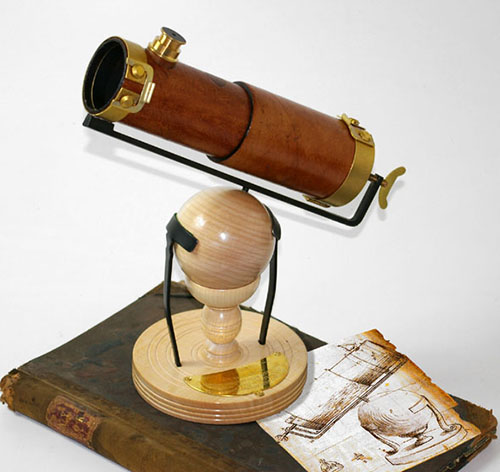
Replica of Newton's 6-inch reflecting telescope of 1672 for the Royal Society
Newton noted that regardless of whether it was reflected or scattered or transmitted, it stayed the same color. Thus the colors we observe are the result of how objects interact with the incident already-colored light, not the result of objects generating the color. Many of his findings in this field were criticized by later theorists, the most well-known being Johann Wolfgang von Goethe, who postulated his own color theories.
From this work he concluded that any refracting telescope would suffer from the dispersion of light into colours, and invented a reflecting telescope (today known as a Newtonian telescope) to bypass that problem.
By grinding his own mirrors, using Newton's rings to judge the quality of the optics for his telescopes, he was able to produce a superior instrument to the refracting telescope, due primarily to the wider diameter of the mirror. (Only later, as glasses with a variety of refractive properties became available, did achromatic lenses for refractors become feasible.)
In 1671 the Royal Society asked for a demonstration of his reflecting telescope. Their interest encouraged him to publish his notes On Color, which he later expanded into his Opticks.
When Robert Hooke criticized some of Newton's ideas, Newton was so offended that he withdrew from public debate. The two men remained enemies until Hooke's death.
In one experiment, to prove that color perception is caused by pressure on the eye, Newton slid a darning needle around the side of his eye until he could poke at its rear side, dispassionately noting "white, darke & colored circles" so long as he kept stirring with "ye bodkin."
Newton argued that light is composed of particles, but he had to associate them with waves to explain the diffraction of light (Opticks Bk. II, Props. XII-XX).
Later physicists instead favored a purely wavelike explanation of light to account for diffraction.
Today's quantum mechanics restores the idea of "wave-particle duality", although photons bear very little resemblance to Newton's corpuscles (e.g., corpuscles refracted by accelerating toward the denser medium).
Newton is believed to have been the first to explain precisely the formation of the rainbow from water droplets dispersed in the atmosphere in a rain shower.
Influence of the Hermetic Tradition
During a period of isolation, Newton was greatly influenced by the Hermetic tradition with which he had been familiar since his undergraduate days.
Newton, always somewhat interested in alchemy, now immersed himself in it, copying by hand treatise after treatise and collating them to interpret their arcane imagery. Under the influence of the Hermetic tradition, his conception of nature underwent a decisive change.
Until that time, Newton had been a mechanical philosopher in the standard 17th-century style, explaining natural phenomena by the motions of particles of matter. Thus, he held that the physical reality of light is a stream of tiny corpuscles diverted from its course by the presence of denser or rarer media. He felt that the apparent attraction of tiny bits of paper to a piece of glass that has been rubbed with cloth results from an ethereal effluvium that streams out of the glass and carries the bits of paper back with it.
This mechanical philosophy denied the possibility of action at a distance; as with static electricity, it explained apparent attractions away by means of invisible ethereal mechanisms.
Newton's Hypothesis of Light of 1675, with its universal ether, was a standard mechanical system of nature. Some phenomena, such as the capacity of chemicals to react only with certain others, puzzled him, however, and he spoke of a "secret principle" by which substances are "sociable" or "unsociable" with others.
About 1679, Newton abandoned the ether and its invisible mechanisms and began to ascribe the puzzling phenomena - chemical affinities, the generation of heat in chemical reactions, surface tension in fluids, capillary action, the cohesion of bodies, and the like, to attractions and repulsions between particles of matter.
More than 35 years later, in the second English edition of the Opticks, Newton accepted an ether again, although it was an ether that embodied the concept of action at a distance by positing a repulsion between its particles. The attractions and repulsions of Newton's speculations were direct transpositions of the occult sympathies and antipathies of Hermetic philosophy--as mechanical philosophers never ceased to protest.
Newton, however, regarded them as a modification of the mechanical philosophy that rendered it subject to exact mathematical treatment. As he conceived of them, attractions were quantitatively defined, and they offered a bridge to unite the two basic themes of 17th-century science--the mechanical tradition, which had dealt primarily with verbal mechanical imagery, and the Pythagorean tradition, which insisted on the mathematical nature of reality. Newton's reconciliation through the concept of force was his ultimate contribution to science.
John Maynard Keynes, who acquired many of Newton's writings on alchemy, stated that "Newton was not the first of the age of reason: he was the last of the magicians."
Newton's interest in alchemy cannot be isolated from his contributions to science. He lived at a time when there was no clear distinction between alchemy and science. Had he not relied on the occult idea of action at a distance, across a vacuum, he might not have developed his 'theory of gravity.'
In 1704 Newton wrote Opticks, in which he expounded his corpuscular theory of light. He considered light to be made up of extremely subtle corpuscles, that ordinary matter was made of grosser corpuscles and speculated that through a kind of alchemical transmutation "Are not gross Bodies and Light convertible into one another,...and may not Bodies receive much of their Activity from the Particles of Light which enter their Composition?" Newton also constructed a primitive form of a frictional electrostatic generator, using a glass globe (Optics, 8th Query). Controversy
Among the most important dissenters to Newton's paper was Robert Hooke, one of the leaders of the Royal Society who considered himself the master in optics and hence he wrote a condescending critique of the unknown parvenu. One can understand how the critique would have annoyed a normal man. The flaming rage it provoked, with the desire publicly to humiliate Hooke, however, bespoke the abnormal. Newton was unable rationally to confront criticism. Less than a year after submitting the paper, he was so unsettled by the give and take of honest discussion that he began to cut his ties, and he withdrew into virtual isolation.
In 1675, during a visit to London, Newton thought he heard Hooke accept his theory of colors. He was emboldened to bring forth a second paper, an examination of the colour phenomena in thin films, which was identical to most of Book Two as it later appeared in the Opticks.
The purpose of the paper was to explain the colors of solid bodies by showing how light can be analyzed into its components by reflection as well as refraction. His explanation of the colors of bodies has not survived, but the paper was significant in demonstrating for the first time the existence of periodic optical phenomena.
He discovered the concentric coloured rings in the thin film of air between a lens and a flat sheet of glass; the distance between these concentric rings (Newton's rings) depends on the increasing thickness of the film of air. In 1704 Newton combined a revision of his optical lectures with the paper of 1675 and a small amount of additional material in his Opticks.
A second piece which Newton had sent with the paper of 1675 provoked new controversy.
Entitled "An Hypothesis Explaining the Properties of Light," it was in fact a general system of nature. Hooke apparently claimed that Newton had stolen its content from him, and Newton boiled over again. The issue was quickly controlled, however, by an exchange of formal, excessively polite letters that fail to conceal the complete lack of warmth between the men.
Newton was also engaged in another exchange on his theory of colors with a circle of English Jesuits in Lige, perhaps the most revealing exchange of all. Although their objections were shallow, their contention that his experiments were mistaken lashed him into a fury. The correspondence dragged on until 1678, when a final shriek of rage from Newton, apparently accompanied by a complete nervous breakdown, was followed by silence. The death of his mother the following year completed his isolation. For six years he withdrew from intellectual commerce except when others initiated a correspondence, which he always broke off as quickly as possible.
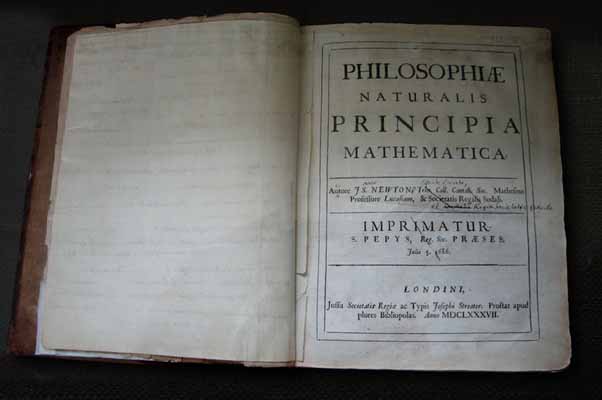
In this work Newton stated the three universal laws of motion that were not to be improved upon for more than two hundred years. He used the Latin word gravitas (weight) for the force that would become known as gravity, and defined the law of universal gravitation. In the same work he presented the first analytical determination, based on Boyle's law, of the speed of sound in air.
With the Principia, Newton became internationally recognised. He acquired a circle of admirers, including the Swiss-born mathematician Nicolas Fatio de Duillier, with whom he formed an intense relationship that lasted until 1693. The end of this friendship led Newton to a nervous breakdown.
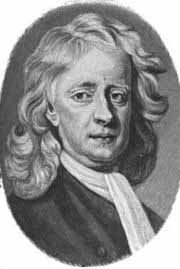
In the 1690s Newton wrote a number of religious tracts dealing with the literal interpretation of the Bible. Henry More's belief in the infinity of the universe and rejection of Cartesian dualism may have influenced Newton's religious ideas. A manuscript he sent to John Locke in which he disputed the existence of the Trinity was never published.
Later works - The Chronology of Ancient Kingdoms Amended (1728) and Observations Upon the Prophecies of Daniel and the Apocalypse of St. John (1733) - were published after his death.
He also devoted a great deal of time to alchemy.
Newton was also a member of the Parliament of England from 1689 to 1690 and in 1701, but his only recorded comments were to complain about a cold draft in the chamber and request that the window be closed.
Newton moved to London to take up the post of warden of the Royal Mint in 1696, a position that he had obtained through the patronage of Charles Montagu, 1st Earl of Halifax, then Chancellor of the Exchequer. He took charge of England's great recoining, somewhat treading on the toes of Master Lucas (and finagling Edmond Halley into the job of deputy comptroller of the temporary Chester branch). Newton became perhaps the best-known Master of the Mint upon Lucas' death in 1699, a position Newton held until his death. These appointments were intended as sinecures, but Newton took them seriously, retiring from his Cambridge duties in 1701, and exercising his power to reform the currency and punish clippers and counterfeiters.
As Master of the Mint Newton unofficially moved the Pound Sterling to the gold standard from silver in 1717; great reforms at the time and adding considerably to the wealth and stability of England. It was his work at the Mint, rather than his earlier contributions to science, that earned him a knighthood from Queen Anne in 1705.
Newton was made President of the Royal Society in 1703 and an associate of the French Academie des Sciences. In his position at the Royal Society, Newton made an enemy of John Flamsteed, the Astronomer Royal, by prematurely publishing Flamsteed's star catalogue.
Newton died in London on March 20th, 1727, and was buried in Westminster Abbey. His half-niece, Catherine Barton Conduitt, served as his hostess in social affairs at his house on Jermyn Street in London; he was her "very loving Uncle", according to his letter to her when she was recovering from smallpox. Newton died intestate and his considerable estate was divided between his half-nieces and half-nephews.
After his death, Newton's body was discovered to have had massive amounts of mercury in it, probably resulting from his alchemical pursuits. Mercury poisoning could explain Newton's eccentricity in late life.
His scientific fame notwithstanding, Newton's study of the Bible and of the early Church Fathers were among his greatest passions. He devoted more time to the study of the Scriptures, the Fathers, and to Alchemy than to science, and said, "I have a fundamental belief in the Bible as the Word of God, written by those who were inspired. I study the Bible daily."
Newton himself wrote works on textual criticism, most notably An Historical Account of Two Notable Corruptions of Scripture.
Newton also placed the crucifixion of Jesus Christ at 3 April, AD 33, which is now the accepted traditional date. He also attempted, unsuccessfully, to find hidden messages within the Bible.
Despite his focus on theology and alchemy, Newton tested and investigated these ideas with the scientific method, observing, hypothesizing, and testing his theories. To Newton, his scientific and religious experiments were one and the same, observing and understanding how the world functioned.
Newton rejected the church's doctrine of the trinity, and was probably a follower of arianism. In a minority view, T.C. Pfizenmaier argues that he more likely held the Eastern Orthodox view of the Trinity rather than the Western one held by Roman Catholics, Anglicans, and most Protestants.
In his own day, he was also accused of being a Rosicrucian (as were many in the Royal Society and in the court of Charles II).
In his own lifetime, Newton wrote more on religion than he did on natural science. He believed in a rationally immanent world, but he rejected the hylozoism implicit in Leibniz and Baruch Spinoza. Thus, the ordered and dynamically informed universe could be understood, and must be understood, by an active reason, but this universe, to be perfect and ordained, had to be regular.
Newton and Robert Boyle's mechanical philosophy was promoted by rationalist pamphleteers as a viable alternative to the pantheists and enthusiasts, and was accepted hesitantly by orthodox preachers as well as dissident preachers like the latitudinarians.
Thus, the clarity and simplicity of science was seen as a way to combat the emotional and metaphysical superlatives of both superstitious enthusiasm and the threat of atheism, and, at the same time, the second wave of English deists used Newton's discoveries to demonstrate the possibility of a "Natural Religion."
The attacks made against pre-Enlightenment "magical thinking," and the mystical elements of Christianity, were given their foundation with Boyle's mechanical conception of the universe. Newton gave Boyle's ideas their completion through mathematical proofs, and more importantly was very successful in popularizing them.
The perceived ability of Newtonians to explain the world, both physical and social, through logical calculations alone is the crucial idea in the disenchantment of Christianity.
Newton saw God as the master creator whose existence could not be denied in the face of the grandeur of all creation.
But the unforeseen theological consequence of his conception of God, as Leibniz pointed out, was that God was now entirely removed from the world's affairs, since the need for intervention would only evidence some imperfection in God's creation, something impossible for a perfect and omnipotent creator.
Leibniz's theodicy cleared God from the responsibility for "l'origine du mal" by making God removed from participation in his creation. The understanding of the world was now brought down to the level of simple human reason, and humans, as Odo Marquard argued, became responsible for the correction and elimination of evil.
On the other hand, latitudinarian and Newtonian ideas taken too far resulted in the millenarians, a religious faction dedicated to the concept of a mechanical universe, but finding in it the same enthusiasm and mysticism that the Enlightenment had fought so hard to extinguish.
He gathered much of that evidence himself, disguised, while he hung out at bars and taverns. For all the barriers placed to prosecution, and separating the branches of government, English law still had ancient and formidable customs of authority.
Newton was made a justice of the peace and between June 1698 and Christmas 1699 conducted some 200 cross-examinations of witnesses, informers and suspects. Newton later ordered all records of his interrogations to be destroyed. Newton won his convictions and in February 1699, he had ten prisoners waiting to be executed.
Newton's greatest triumph as the king's attorney was against William Chaloner. One of Chaloner's schemes was to set up phony conspiracies of Catholics and then turn in the hapless conspirators whom he entrapped. Chaloner made himself rich enough to posture as a gentleman.
Petitioning Parliament, Chaloner accused the Mint of providing tools to counterfeiters (a charge also made by others). He proposed that he be allowed to inspect the Mint's processes in order to improve them. He petitioned Parliament to adopt his plans for a coinage that could not be counterfeited, while at the same time striking false coins. After being exposed by Newton, Chaloner was hanged, drawn and quartered on March 23, 1699.
It was Newton's conception of the universe based upon Natural and rationally understandable laws that became the seed for Enlightenment ideology. Locke and Voltaire applied concepts of Natural Law to political systems advocating intrinsic rights; the physiocrats and Adam Smith applied Natural conceptions of psychology and self-interest to economic systems and the sociologists criticized the current social order for trying to fit history into Natural models of progress. Monboddo and Samuel Clarke resisted elements of Newton's work, but eventually rationalized it to conform with their strong religious views of nature.
Finally, he unified many of the isolated physics facts that had been discovered earlier into a satisfying system of laws. Newton's conceptions of gravity and mechanics, though not as accurate as Einstein's Theory of Relativity or quantum mechanics, still represent an enormous step in the evolution of human understanding of the universe. For this reason, he is generally considered one of history's greatest scientists.
In 1717, the Kingdom of Great Britain went on to an unofficial gold standard when Newton, then Master of the Mint, established a fixed price of 44 guineas per standard (22 carat) troy pound. Under the gold standard the value of the pound (measured in gold weight) remained largely constant until the beginning of the 20th century.
Newton is reputed to have invented the cat flap. This was said to be done so that he would not have to disrupt his optical experiments, conducted in a darkened room, to let his cat in or out.
Newtonmas is a holiday celebrated by some scientists as an alternative to Christmas, taking advantage of the fact that Newton's birthday fell on 25 December in the Julian calendar in use at the time of his birth.
To this day, Newton's achievements have been immortalized in popular culture. Almost all schoolchildren are familiar with the apocryphal story of Newton's apple and his subsequent discovery of gravity; even the likeness of Newton holding an apple under a tree is a well-known image of science. English poet Alexander Pope was sufficiently moved by Newton's accomplishments to write the famous epitaph:
-
"Nature and nature's laws lay hid in night;
God said 'Let Newton be' and all was light."
Newton has been identified as a "Grand Master of the Priory of Sion" from 1691-1727 in documents that have been dismissed as a hoax concocted by Pierre Plantard.
This information was incorporated into the 1982 book The Holy Blood and the Holy Grail, which was later one of the primary source books for the bestselling 2003 Dan Brown novel The Da Vinci Code.
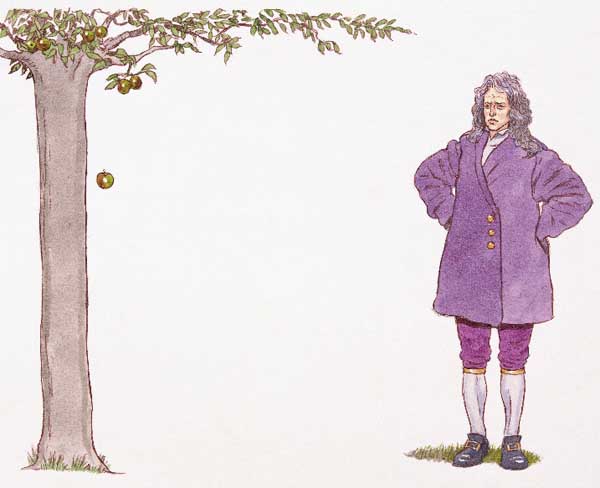
- Newton's First Law (also known as the Law of Inertia) states that an object at rest tends to stay at rest and that an object in uniform motion tends to stay in uniform motion unless acted upon by a net external force.
- Newton's Second Law states that an applied force equals the rate of change of momentum. For constant mass: F=ma, or force equals mass times acceleration. In other words, the acceleration produced by a net force on an object is directly proportional to the magnitude of the net force and inversely proportional to the mass. In the MKS system of measurement, mass is given in kilograms, acceleration in metres per second squared, and force in newtons (named in his honor).
- Newton's Third Law states that for every action there is an equal and opposite reaction.
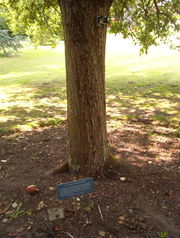
The question was not whether gravity existed, but whether it extended so far from Earth that it could also be the force holding the moon to its orbit. Newton showed that if the force decreased as the inverse square of the distance, one could indeed calculate the Moon's orbital period, and get good agreement. He guessed the same force was responsible for other orbital motions, and hence named it "universal gravitation".
A contemporary writer, William Stukeley, recorded in his Memoirs of Sir Isaac Newton's Life a conversation with Newton in Kensington on April 15, 1726, in which Newton recalled "when formerly, the notion of gravitation came into his mind. It was occasioned by the fall of an apple, as he sat in contemplative mood. Why should that apple always descend perpendicularly to the ground, thought he to himself. Why should it not go sideways or upwards, but constantly to the earth's centre." In similar terms, Voltaire wrote in his Essay on Epic Poetry (1727), "Sir Isaac Newton walking in his gardens, had the first thought of his system of gravitation, upon seeing an apple falling from a tree." These accounts are probably exaggerations of Newton's own tale about sitting by a window in his home (Woolsthorpe Manor) and watching an apple fall from a tree.
Various trees are claimed to be "the" apple tree which Newton describes, the King's School, Grantham, claims that the tree was purchased by the school, uprooted and transported to the headmaster's garden some years later, the staff of the [now] National Trust-owned Woolsthrope Manor dispute this, and claim that a tree present in their gardens is the one described by Newton. It is also claimed that the tree was replanted in front of the council buildings in Grantham, which is unlikely, considering that they were built over 300 years after Newton's death. A clone of the original tree can be seen growing outside the main gate of Trinity College, Cambridge, below the room Newton lived in when he studied there.
National Geographic - January 4, 2010
Unpublished Papers Reveal Lesser-known, but Significant Research of Sir Issac Newton PhysOrg - September 11, 2006
Known primarily for his foundational work in math and physics, Sir Issac Newton actually spent more time on research in alchemy, as well as its interrelationships with science, history and religion, and its implications for economics.
Alchemy, as Newton practiced it in the 17th and 18th centuries, was research into the nature of chemical substances and processes - primarily the transmutation of materials from one type of matter to another. Newton and others conducted experiments, but also incorporated philosophical thought in their attempts to uncover the mysteries of the physical universe.
"NewtonÕs extensive work on universal history (which presents human history as a coherent unit governed by certain immutable principles) provides an essential setting for linking his work on alchemy and his work heading EnglandÕs mint in the 1690s," said Georgia Institute of Technology Professor Kenneth Knoespel, who chairs the School of Literature, Communication and Culture. "It is not at all farfetched to think of history as a kind of alchemical process that looks to the creation of value and wealth."
Knoespel presented a talk titled NewtonÕs Alchemical work and the creation of economic value at the American Chemical SocietyÕs 232nd national meeting in San Francisco. The talk was part of a session dedicated to scholarship based on the unpublished manuscripts of Newton, most of which are housed at the University of Cambridge and in the Edelstein Center at Hebrew University in Jerusalem. For the past 15 years, Knoespel has studied both collections -- some portions of which weren't available to scholars until the 1970s.
By integrating the study of these manuscripts, Knoespel determined that NewtonÕs alchemical practice functions as a translation code for a new language of economics in which an investigation of material-spiritual value becomes transformed into a systematic structure of social value understood through economics.
Newton began to translate his notions of value in alchemy to an economic setting when he was appointed to head EnglandÕs mint Ð several years after the 1687 publication of "The Principia," in which Newton described universal gravitation and the three laws of motion, laying the groundwork for classical mechanics.
"Newton moves from an academic research position to a position of considerable visibility within the state," Knoespel noted. "He became the symbol of the stability of the British economy at this time. It is hardly an exaggeration to think of such a move as involving a shift from private research to the broad application of policy formed by decades of private research."
Newton took the new job very seriously, undertaking new research on the history of money and combining it with his work in mathematics, alchemy and metallurgy. He improved the edging of coins, much like U.S. coins are formed today, to prevent people from clipping the edges. Newton also assayed the coins of Europe to determine the amount of gold and silver they contained to help establish EnglandÕs economic basis.
As the economic system of capitalism began to be institutionalized in Europe in the decades following Newton, many thought that capital, or value, within capitalism was being mystified in the same way that gold is within its alchemical transformation. Newton thought by improving the English economic system, he was going to contribute to the ongoing transformation of England into GodÕs kingdom on Earth. A Newtonian approach to matter carries with it a Messianic force that finally grounds itself in natural philosophy that includes an interpretation of human and natural history.
Newton never makes economic value the sole force that determines history. Instead, the practice of economics is at least twofold, involving both the practice of a monetary system and a conceptual framework that sees within an economic system, the workings of God in time.
Connecting the published work of Newton the mathematician and the physicist with the unpublished work of Newton the alchemist, historian and religious philosopher provides broader insight into his legacy. The history of science has often separated Newton the complex mathematician from the Newton of the Newtonians. The purists say: 'Newton is a mathematician and a physicist. DonÕt mix him up with religion or alchemy because youÕll turn him into Harry Potter.' But it is this purist belief that for 200 years suppressed NewtonÕs unpublished work in alchemy until the mid-20th century. Newton was profoundly interested in the relationship between physics and religion, but that doesnÕt turn him into a magician."
Count Cagliostro

Count Alessandro di Cagliostro (June 2, 1743 - August 26, 1795) was a traveller, occultist and Freemason. "Cagliostro" is widely held to have been an alias for the charlatan Giuseppe Balsamo, born to a poor family in Palermo, Sicily. Balsamo was a petty criminal who, in his most famous crime, claimed aptitude in alchemy to swindle a man out of his gold. The identification of Cagliostro with Giuseppe is not certain, however, being based mainly upon the untrustworthy testimony of the French spy and blackmailer Theveneau de Morande, and later upon his confession to the Inquisition, obtained through torture.
Cagliostro himself claimed to have been born of Christians of noble birth, but abandoned as an orphan upon the island of Malta. He claimed to have travelled as a child to Medina, Mecca, and Cairo, and upon return to Malta to have been initiated into the Sovereign Military Order of the Knights of Malta, with whom he studied alchemy, the Kabbalah and magic. He founded the Egyptian Rite of Freemasonry in The Hague, which initiated men and women in separate lodges and had an influence on the foundation of the masonic Rite of Misraim.
Life and Travels
They traveled together to London, where he was initiated into Freemasonry, possibly by the Comte de Saint-Germain.
He adopted as his secret sign the symbol of Ouroboros; the snake that bites its own tail.
He soon founded the Egyptian Rite of Freemasonry in The Hague, which initiated men and women in separate lodges and had an influence on the foundation of the masonic Rite of Misraim.
He traveled throughout Russia, Germany, and later France, spreading the influence of the Egyptian Rite and also claiming to be a magnetic healer of great power.
His fame grew to the point that he was even recommended as a physician to Benjamin Franklin during a stay in Paris.
He was an extraordinary forger. In his autobiography, Giacomo Casanova narrates an encounter with Cagliostro who was able to forge a letter of Casanova despite being unable to understand it.
Occult historian Lewis Spence comments in his entry on Cagliostro that the swindler put his finagled wealth to good use by starting and funding a chain of maternity hospitals and orphanages around the continent.
Affair of the diamond necklace
Betrayal and Imprisonment
On December 27, 1789, he was arrested and imprisoned in the Castel Sant'Angelo. Soon afterwards he was sentenced to death on the charge of being a Mason. The Pope changed his sentence, however, to life imprisonment in the Castel Sant'Angelo. After attempting to escape he was relocated to the Fortress of San Leo. He died on August 26, 1795.
Compte St. Germain
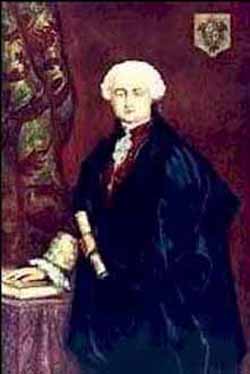
Compte St. Germain (allegedly 1710-1935) has been variously described as a courtier, adventurer, charlatan, inventor, alchemist, pianist, violinist and amateur composer, but is best known as a recurring figure in the stories of several strands of occultism - particularly those connected to Theosophy and the White Eagle Lodge, where he is also referred to as the Master Rakoczi or the Master R and as one of the Masters of the Ancient Wisdom, is credited with near god-like powers and longevity. Some sources write that his name is not familial, but was invented by him as a French version of the Latin Sanctus Germanus, meaning "Holy Brother."
He was known as 'Der Wundermann' -- 'The Wonderman'. He was a man whose origin was unknown and who disappeared without leaving a trace.
Since his death, various occult organizations have adopted him as a model figure or even as a powerful deity. In recent years several people have claimed to be the Count of St. Germain. (Note that St Germain was never regarded as a saint by the Roman Catholic Church - the "st." before his name refers to his alleged home).
St. Germain never revealed his actual background and identity, leading to many speculations about him and his origin and ancestry. Some of these include the possibility that he was the son of Francis II Rakoczi, the Prince of Transylvania (who was in exile), or that he was the illegitimate son of Maria Anna of Pfalz-Neuburg, the widow of Charles II of Spain.
While he may have studied in Italy at Siena University, possibly as a protŽgŽ of Grand Duke Gian Gastone (the last of the Medici line), St. Germain's first chronicled appearances were in London in 1743 and in Edinburgh in 1745, where he was apparently arrested for spying. He was released and soon acquired a reputation as a great violinist. He was ascetic and apparently celibate. During this time he met Jean-Jacques Rousseau.
In 1746 he disappeared. Horace Walpole, who knew him from about 1745 in London, described him thus: "He sings, plays the violin wonderfully, composes, is mad and not very sensible".
He reappeared in Versailles in 1758. He claimed to have had recipes for dyes and acquired quarters in the Chateau de Chambord. During this time in Paris he gave diamonds as gifts and reputedly hinted that he was centuries old. The old portrait of him dates from these years. He was an acquaintance of Louis XV and his mistress Madame de Pompadour. At the time a mime, Gower, began to mimic his mannerism in salons, joking that he would have advised Jesus.
In 1760 he left for England through Holland when the minister of State, Duke of Choiseul, tried to have him arrested.
After that the Count passed through the Netherlands into Russia and apparently was in St Petersburg when the Russian army put Catherine the Great on the throne. Later conspiracy theories credit him for causing it. The next year he turned up in Belgium, bought land and took the name Surmount. He tried to offer his processes Ð treatments of wood, leather, oil paint Ð to the state.
During his negotiations Ð that came to nothing Ð with Belgian minister Karl Cobenzl he hinted at a royal birth and turned iron into something resembling gold. He then disappeared for 11 years.
In 1774 he resurfaced, and apparently tried to present himself to a count in Bavaria as Freiherr Reinhard Gemmingen-Guttenberg, the count Tsarogy.
In 1776 the Count was in Germany, calling himself Count Welldone, and again offered recipes Ð cosmetics, wines, liqueurs, treatments of bone, paper and ivory. He alienated King Frederick's emissaries by his claims of transmutation of gold and reputedly compared himself to God. To Frederick he claimed to have been a Freemason. He settled in a house of Prince Karl of Hesse-Kassel, governor of Schleswig-Holstein and studied herbal remedies and chemistry to give to the poor. To him he claimed he was a Francis Rakoczy II, Prince of Transylvania.
1784 is when the Count supposedly died, probably of pneumonia. He left very little behind.
There were rumors of him alive in Paris in 1835, in Milan in 1867 and in Egypt during Napoleon's campaign. Napoleon III kept a dossier on him. Annie Besant said that she met the Count in 1896.
Theosophist C. W. Leadbeater claimed to have met him in Rome in 1926, and said that St. Germain showed him a robe that had been previously owned by a Roman Emperor and that St. Germain told him that one of his residences was a castle in Transylvania.
Theosophist Guy Ballard claimed that the Count had introduced him to visitors from Venus and published a book series about his channelings; Ballard founded the "I Am" Activity.
In January 28, 1972, ex-convict and lover of singing star Dalida, Richard Chanfray claimed to be the Count of St. Germain on French television. He also claimed that Louis XV was still alive.
There are several "authoritative" biographers who usually do not agree with one another. His ancestry is a matter of much speculation. Theosophists consider him to be an Ascended Master or adept. Aleister Crowley identified with him. Helena Blavatsky said he was one of her Masters of Wisdom and hinted at secret documents. Several books on palmistry and astrology have been published in his name.
During the centuries after his death, numerous myths, legends and speculations have surfaced. He has been attributed with occult practices like snake charming and ventriloquism. There are stories about an affair between him and Madame de Pompadour. Other legends report that he was immortal, the Wandering Jew, an alchemist with the elixir of life, a Rosicrucian or an ousted king, a bastard of Queen Anna Maria of Spain, that he prophesied the French Revolution. Casanova called him the violinist Catlini. Count Cagliostro was rumored to be his pupil. The fact that the name "St. Germain" was not exactly uncommon confuses the matters even more.
Many groups in occultism honor St. Germain as an Ascended Master. As such, he is believed to have many magical powers such as the ability to teleport, levitate, walk through walls, influence people telepathically, etc.
Some esoteric groups credit him with inspiring the Founding Fathers to draft the Declaration of Independence and the United States Constitution.
In the New Age beliefs regarding him, St. Germain is always associated with the color violet and the jewel amethyst; he is also regarded as the "Master of the Seventh (violet) Ray".
According to Theosophy, the Seven Rays are seven metaphysical principles that govern both individual souls and the unfolding of each 2,158 year long Astrological Age. Since according to Theosophy the next Astrological Age, the Age of Aquarius, will be governed by the Seventh (violet) Ray (the Ray of Ceremonial Order), St. Germain is sometimes called "The Cosmic Master of the Age of Aquarius."
In Rosicrucian Max Heindel's writings, the Count of St Germain (18th century) is described as one of the later incarnations of Christian Rosenkreuz, an enigmatic individual born in the 13th century and the Head of the Rosicrucian Order. According to this author, Rosenkreuz had been Lazarus in his previous previous physical life, a biblical character in the New Testament (this would contradict the idea that he was Joseph, since they both lived at the same time) and Hiram Abiff, the Widow's Son of Freemasonry, in an earlier existence.
In the 1925 book The Masters and the Path by C.W. Leadbeater, an adherent of Theosophy, St. Germain is called both the "Comte de St. Germain" and the "Master Rakoczi." His previous incarnations are enumerated (the same ones as noted below in the paragraph about Guy Ballard). On page 240 of The Masters and the Path it is stated that when performing magical rituals in his castle in Transylvania, St. Germain wears "a suit of golden chain-mail which once belonged to a Roman Emperor; over it is thrown a magnificent cloak of crimson, with on its clasp a seven-pointed star in diamond and amethyst, and sometimes he wears a glorious robe of violet."
In the Alice Bailey's books, St. Germain is also known as the "Master Rakoczi". Alice A. Bailey's book The Externalisation of the Hierarchy (1934) gives the most information about his reputed role as an Ascended Master. His title is said to be the "Lord of Civilization". He is said to telepathically influence people who are seen by him as being instrumental in bringing about the new civilization of the Age of Aquarius. It was said by Alice A. Bailey that "sometime after AD 2025" Jesus Christ, St. Germain, Kuthumi and the others in the Ascended Master hierarchy (except Gautama Buddha) would "externalisze" i.e., descend from the etheric plane, and live physically on Earth in ashrams surrounded by their disciples.
In the Godfre Ray King books, and Law of Life books is said that St. Germain was Joseph the foster-father of Jesus, Merlin the magician of King Arthur's Court, Roger Bacon, Christian Rosenkreuz of Germany, Christopher Columbus, Francis Bacon and Prince Rakoczy of Transylvania, in previous reincarnations. These beliefs about his previous incarnations are also promulgated by the Church Universal and Triumphant, with the addition that he was also incarnated as the ancient Jewish Prophet Samuel, as Saint Alban, and as a high priest of the white magicians in Atlantis. Guy Ballard claimed his book The Magic Presence was channeled to him from St. Germain (The official I Am edition of The Magic Presence, regarded as a sacred scripture, is printed in a violet colored typeface on lavender paper.).
According to Elizabeth Clare Prophet, St. Germain ascended on May 1st 1684. Although Sir Francis Bacon is said to have died in 1626, Prophet claims that the body in the coffin at Sir Francis Bacon's funeral was not his own and that he attended his own funeral. Supposedly, he continued living until his ascension in 1684. Thus, according to Prophet, the historical St. Germain was already an ascended master.In the Church Universal and Triumphant St Germain is regarded as a deity outranked only in importance by Jesus Christ, Gautama Buddha, and Sanat Kumara (the "Lord of the World"), and in that church, he is the deity towards whom the most intense devotion is given. Guy Ballard, the founder of I Am, originated the meditation practice of invoking the "Violet Flame" from St. Germain in order to contact one's "I Am Presence" and revivify one's etheric body. This practice has been continued by the Church Universal and Triumphant.
Conspiracy theorists who believe in NESARA, a purported secret law that the US government denies the existence of (such as controversial evangelist Sherry Shriner), believe that St. Germain is still alive and is actively working with Jesus Christ and with benevolent space aliens to get the law enacted.
Another story about Saint-Germain says that he was the natural son of the widow of Charles II of Spain and a certain Comte (Count) Adanero, whom she knew at Bayonne. This Spanish queen was Marie de Neubourg, whom Victor Hugo took as the heroine of his Ruy Blas. Those who disliked Saint-Germain said that he was the son of a Portuguese Jew named Aymar, while those who hated him said, in the effort to add to his discredit, that he was the son of an Alsatian Jew named Wolff.
Fairly recently a new genealogy of Saint-Germain has been put forward which seems the most probable of all. It is the work of the theosophists and Annie Besant, who has frequently made the statement that the Comte de Saint-Germain was one of the sons of Francis Racoczi II, Prince of Transylvania. The children of Francis Racoczi were brought up by the Emperor of Austria, but one of them was withdrawn from his guardianship.
Saint Germain never seemed to age. For an entire century he maintained the physical appearance of a man between forty and fifty years old.
He could do just about anything. He was almost too good to be true. He was a magician, a musician, artistry as a violinist, talent as a painter, skill in alchemy and chemistry, a seer who read for and socialized with the rich and famous, had great wealth, and was one of the most mysterious men on the Europe continent. He knew nearly all the European languages. His knowledge of history was comprehensive, and his accomplishments as a chemist, on which he based his reputation, were in many ways considerable.
By far the greatest obvious talents of the Comte de Saint-Germain were connected with his knowledge of alchemy. Yet if Saint-Germain he knew how to make gold, he was wise enough to say nothing about it. Nothing but the possession of this secret could perhaps account for the enormous wealth at his command, though he was not known to have money on deposit at any banks.
He was one of the of the most celebrated mystics and adventurers of modern times. He was a confidant of two kings of France, a dazzlingly rich and gifted social figure, the subject of a thousand rumors.
He enjoyed and sought the company of the pretty women of his day. It appears from the memoirs of Baron von Gleichen that when Saint-Germain was in Paris he became the lover of Mademoiselle Lambert, daughter of the Chevalier Lambert, who lived in the house in which he lodged. And it appears from Grosley's memoirs that in Holland he became the lover of a woman as rich and mysterious as himself.
Though he never ate any food in public, he liked dining out because of the people he met and the conversations he heard. They say he lived on oatmeal. He had an immense stock of amusing stories with which he regaled society.
He was an aristocrat who lived with princes and even with kings almost on a footing of an equal.
He gave recipes for removing wrinkles and dyeing hair.
His activity and the diversity of his occupations were very great. He was interested in the preparation of dyes and even started a factory in Germany for the manufacture of felt hats.
One of his principal roles was that of a secret agent in international politics in the service of France. He became Louis XV's confidential and intimate counselor and was entrusted by him with various secret missions.
He had a love of jewels in an extreme form, and he ostentatiously showed off those he possessed. He kept a great quantity of them in a casket, which he carried about everywhere with him. The importance he attached to jewels was so great that in the pictures painted by him, which were in themselves remarkable, the figures were covered with jewels; and his colors were so vivid and strange that faces looked pale and insignificant by contrast. Jewels cast their reflection on him and threw a distorting light on the whole of his life.
He was also known to carry jewels sewn into his clothing . He was said to have presented a cross ornamented with gems to a woman he scarcely knew, because she had idly admired it.
The count claimed that he had learned how to turn several small diamonds into one large one and to make pearls grow to spectacular size. He said he could remove flaws from diamonds. He could make a big diamond out of several small stones. The diamonds that he wore in his shoes and garters were believed to be worth more than 200,000 francs.
It was widely suspected that he also knew the secret for making gold out of base metal.
Tradition has related that he said he had known Jesus and been present at the Council of Nicea. But he did not go so far as this in his contempt for the men with whom he associated and in his derision of their credulity.
He seems to have become a celebrity in the 1750's as a friend of Louis XV and his mistress Madame de Pompadour, who together spent evenings with him simply for the pleasure of his conversation. Louis XV must have known who he was, for he extended to him a friendship that aroused the jealousy of his court. He allotted him rooms in the Chateau of Chambord. He shut himself up with Saint-Germain and Madam de Pompadour for whole evenings; and the pleasure he derived from his conversation and the admiration he no doubt felt for the range of his knowledge cannot explain the consideration, almost the deference, he had for him. Madam du Housset says in her memoirs that the king spoke of Saint-Germain as a personage of illustrious birth.
Count Charles of Hesse Cassel, with whom he lived during the last years in which history is able to follow his career, must also have possessed the secret of his birth. They worked with alchemy together. Saint-Germain treated him as an equal. It was to him that Saint-Germain entrusted his paper just before his supposed death in 1784.
However, neither Louis XV nor the Count of Hesse Cassel ever revealed anything about the birth of Saint-Germain. The count even went so far as invariably to withhold the smallest detail bearing on the life of his mysterious friend. This is a very remarkable fact, since Saint-Germain was an extremely well known figure.
Whether he was a genius or a charlatan, Saint-Germain had the talent to make himself noticed and the subject of gossip. But in Versailles and Paris he was embraced as the confidential adviser of Louis XV. The position earned him the envy and enmity of the king's ministers, who denounced him as an adventurer with a smooth line of talk.
Matters came to a head in 1760, when the count at the behest of the king involved himself in foreign affairs, going behind the back of ministry. Threatened with arrest, he was obliged to flee to England, where he stayed for a while; possibly for a period of two years.
From England Count Saint-Germain apparently went to Russia, where it is claimed he took part in a conspiracy that put Catherine the Great upon the throne in 1762.
After that nothing much is known of the count until 1774, when Louis XVI and Marie Antoinette came to the throne. Saint-Germain then returned to France. It is said that he warned the royal couple of the revolution 15 years in the future, saying, "There will be a blood-thirsty republic, whose scepter will be the executioner's knife."
He influenced Freemasonry and the secret societies, though many modern masons have denied this and have even omitted to mention him as a great source of inspiration.
In Vienna he took part in the foundation of the Society of Asiatic Brothers and of the Knights of Light, who studied alchemy; and it was he who gave Mesmer his fundamental ideas on personal magnetism and hypnotism. It is said that he initiated Cagliostro, who visited him on several occasions in Holstein to receive directions from him, though there is no direct evidence for this. The two men were to be far separated from one another by opposite currents and a different fate.
All over the country secret societies sprang up. The new spirit manifested itself in the form of associations. Neither the nobility nor the clergy escaped what had become a fashion.
There were lodges for women, and the Princesse de Lamballe became grand mistress of one of them.
In Germany there were the Illuminati and the Knights of Strict Observance, and Frederick II, when he came to the throne, founded the sect of the Architects of Africa.
In France, the Order of the Templars was reconstituted, and Freemasonry, whose grand master was the Duke de Chartres, increased the number of its lodges in every town. Martinez de Pasqually taught his philosophy at Marseilles, Bordeaux and Toulouse; and Savalette de Lange, with mystics such as Court de Gebelin and Saint-Martin, founded the lodge of the Friends Assembled.
The initiates of these sects understood that they were the depositories of a heritage that they did not know, but whose boundless value they guessed; it was to be found somewhere, perhaps in traditions, perhaps in a book written by a master, perhaps in themselves. They spoke of this revealing word, this hidden treasure it was said to be in the hands of "unknown superiors of these sects, who would one day disclose the wealth which gives freedom and immortality."
It was this immortality of the spirit that Saint-Germain tried to bring to a small group of chosen initiates. He believed that this minority, once it was developed itself, would, in its turn, help to develop another small number, and that a vast spiritual radiation would gradually descend, in beneficent waves, towards the more ignorant masses. It was a sage's dream, which was never to be realized.
With the co-operation of Savalette de Lange, who was the nominal head, he founded the group of Philalethes, or truth-lovers, which was recruited from the cream of the Friends Assembled.
The Prince of Hesse, Condorcet, and Cagliostro were all members of this group. Saint-Germain expounded his philosophy at Ermenonville and in Paris, in the rue Platriere. It was a Platonic Christianity, which combined Swedenborg's visions with Martinez de Pasqually's theory of reintegration. There were to be found in it Plotinus' emanations and the hierarchy of successive planes described by Hermeticists and modem theosophists. He taught that man has in him infinite possibilities and that, from the practical point of view, he must strive unceasingly to free himself of matter in order to enter into communication with the world of higher intelligences.
He was understood by some. In two great successive assemblies, at which every Masonic lodge in France was represented, the Philalethes attempted the reform of Freemasonry. If they had attained their aim, if they had succeeded in directing the great force of Freemasonry by the prestige of their philosophy, which was sublime and disinterested, it may be that the course of events would have been altered, that the old dream of a world guided by philosopher-initiates would have been realized.
But matters were to turn out differently. Old causes, created by accumulated injustices had paved the way for terrible effects. These effects were in their turn to create the causes of future evil. The chain of evil, linked firmly together by men's egoism and hatred, was not to be broken. The light kindled by a few wise visionaries, a few faithful watchers over the well being of their brothers, was extinguished almost as soon as it was kindled.
The count for his part asserted that he had lost a very dear friend. But his attitude was highly equivocal. He refused to give any information about his friend or his last moments, and turned the conversation if anyone spoke of him. His whole behavior gives color to the supposition that he was the accomplice of a pretended death.
Although, on the evidence of reliable witnesses, he must have been at least a hundred years old in 1784, his death in that year cannot have been genuine. The official documents of Freemasonry say that in 1785 the French masons chose him as their representative at the great convention that took place in that year, with Mesmer, Saint-Martin, and Cagliostro present. In the following year Saint-Germain was received by the Empress of Russia. Finally, the Comtesse d'Adhemar reports at great length a conversation she had with him in 1789 in the Church of the Recollets, after the taking of the Bastille.
His face looked no older than it had looked thirty years earlier. He said he had come from China and Japan. "There is nothing so strange out there," he said, "as that which is happening here. But I can do nothing. My hands are tied by someone who is stronger than I. There are times when it is possible to draw back; others at which the decree must be carried out as soon as he has pronounced it."
And he told her in broad outlines all the events, not excepting the death of the queen, that were to take place in the years that followed. "The French will play with titles and honors and ribbons like children. They will regard everything as a plaything, even the equipment of the Garde Nationale. There is today a deficit of some forty millions, which is the nominal cause of the Revolution. Well, under the dictatorship of philanthropists and orators the national debt will reach thousands of millions."
"I have seen Saint-Germain again," wrote Comtesse d'Adhemar in 1821, "each time to my amazement. I saw him when the queen was murdered, on the 18th of Brumaire, on the day following the death of the Duke d'Enghien, in January, 1815, and on the eve of the murder of the Duke de Berry."
Mademoiselle de Genlis asserts that she met the Comte de Saint-Germain in 1821 during the negotiations for the Treaty of Vienna; and the Comte de Chalons, who was ambassador in Venice, said he spoke to him there soon afterwards in the Piazza di San Marco. There is other evidence, though less conclusive, of his survival. The Englishman Grosley said he saw him in 1798 in a revolutionary prison; and someone else wrote that he was one of the crowd surrounding the tribunal at which the Princess de Lamballe appeared before her execution.
It seems quite certain that the Comte de Saint-Germain did not die at the place and on the date that history has fixed. He continued an unknown career, of whose end we are ignorant and whose duration seems so long that one's imagination hesitates to admit it.
What happened to the Comte de Saint-Germain after 1821, in which year there is evidence that he was still alive? An Englishman, Albert Vandam, in his memoirs, which he calls An Englishman in Paris, speaks of a certain person whom he knew towards the end of Louis Philippe's reign and whose way of life bore a curious resemblance to that of the Comte de Saint-Germain.
"He called himself Major Fraser, wrote Vandam, "lived alone and never alluded to his family. Moreover he was lavish with money, though the source of his fortune remained a mystery to everyone. He possessed a marvelous knowledge of all the countries in Europe at all periods. His memory was absolutely incredible and, curiously enough, he often gave his hearers to understand that he had acquired his learning elsewhere than from books. Many is the time he has told me, with a strange smile, that he was certain he had known Nero, had spoken with Dante, and so on."
Like Saint-Germain, Major Fraser had the appearance of a man of between forty and fifty, of middle height and strongly built. The rumor was current that he was the illegitimate son of a Spanish prince. After having been, also like Saint-Germain, a cause of astonishment to Parisian society for a considerable time, he disappeared without leaving a trace. Was it the same Major Fraser who, in 1820, published an account of his journey in the Himalayas, in which he said he had reached Gangotri, the source of the most sacred branch of the Ganges River, and bathed in the source of the Jumna River?
It was at the end of the nineteenth century that the legend of Saint-Germain grew so inordinately. By reason of his knowledge, of the integrity of his life, of his wealth and of the mystery that surrounded him, he might reasonably have been taken for an heir of the first Rosicrucians, for a possessor of the Philosopher's Stone. But the theosophists and a great many occultists regarded him as a master of the great White Lodge of the Himalayas. The legend of these masters is well known. According to it there live in inaccessible lamaseries in Tibet certain wise men who possess the ancient secrets of the lost civilization of Atlantis. Sometimes they send to their imperfect brothers, who are blinded by passions and ignorance, sublime messengers to teach and guide them. Krishna, the Buddha, and Jesus were the greatest of these. But there were many other more obscure messengers, of whom Saint-Germain has been considered to be one.
"This pupil of Hindu and Egyptian hierophants, this holder of the secret knowledge of the East," theosophist Madam Blavatsky says of him, "was not appreciated for who he was. The stupid world has always treated in this way men who, like Saint-Germain, have returned to it after long years of seclusion devoted to study with their hands full of the treasure of esoteric wisdom and with the hope of making the world better, wiser and happier." Between 1880 and 1900 it was admitted among all theosophists, who at that time had become very numerous, particularly in England and America, that the Comte de Saint-Germain was still alive, that he was still engaged in the spiritual development of the West, and that those who sincerely took part in this development had the possibility of meeting him.
The brotherhood of Khe-lan was famous throughout Tibet, and one of their most famous brothers was an Englishman who had arrived one day during the early part of the twentieth century from the West. He spoke every language, including the Tibetan, and knew every art and science, says the tradition. His sanctity and the phenomena produced by him caused him to be proclaimed a Shaberon Master after a residence of but a few years. His memory lives to the present day among the Tibetans, but his real name is a secret with the Shaberons alone. Might not this mysterious traveler be the Comte de Saint-Germain?
But even if he has never come back, even if he is no longer alive and we must relegate to legend the idea that the great Hermetic nobleman is still wandering about the world with his sparkling jewels, his senna tea, and his taste for princesses and queens even so it can be said that he has gained the immortality he sought.
For a great number of imaginative and sincere men the Comte de Saint-Germain is more alive than he has ever been. There are men who, when they hear a step on the staircase, think it may perhaps be he, coming to give them advice, to bring them some unexpected philosophical idea. They do not jump up to open the door to their guest, for material barriers do not exist for him. There are men who, when they go to sleep, are pervaded by genuine happiness because they are certain that their spirit, when freed from the body, will be able to hold converse with the master in the luminous haze of the astral world.

Comte of Saint-Germain remains with us in one magical way or another. Alchemy has come to mean the transformation of consciousness in time back to its natural state of light, a process that is going on today. The adventures of St. Germain were as real or illusionary as one perceives them them to be, for all of reality is a consciousness hologram set in the illusion of time for experience.
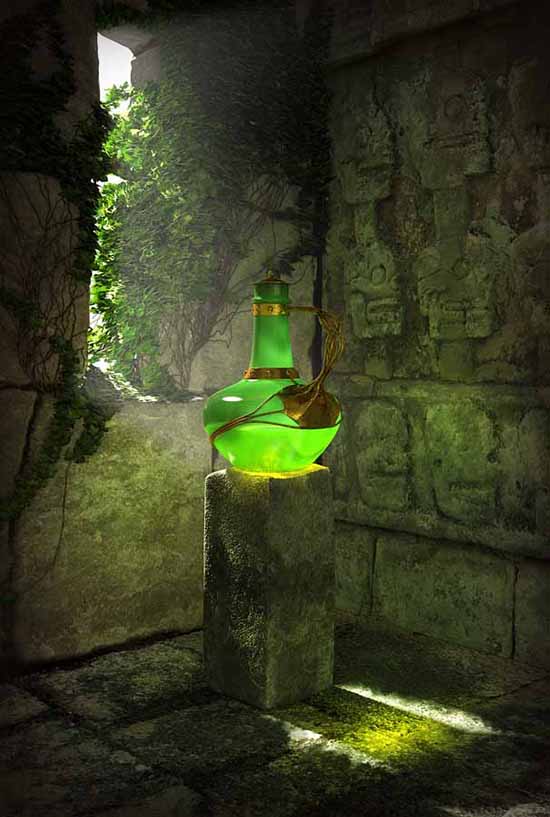
lay hidden in a place which depicts Earth's final destiny. Count St. Germain
Demosthenes The Alchemist God
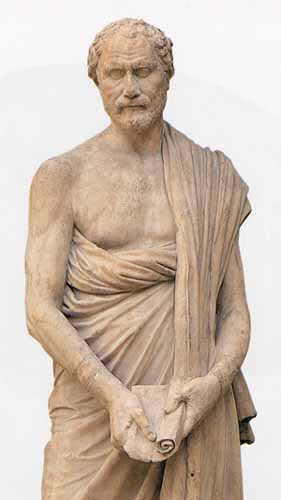
Demosthenes is an enigmatic God; the brother of Ishtar, he dedicates himself to researching the secrets of the World. From the earliest accounts, he was always taking things apart and putting them back together again.
He did not take an interest in politics and remained totally neutral throughout the Darkness and Chaos Wars. He appears in many legends as a source of rumour, knowledge and obscure questions. He brewed the intoxicating Nectar for the Gods and the healing elixir Ambrosia. It was after consulting with Demosthenes that Selene discovered or created Moon and Than devised the vile Head spell.
These acts caused some anger among the Gods but the Alchemist demonstrated his neutrality by advising Neibelung on the fashioning of the Dwarves and researching the Head of Than for Rhadamanthus. He questioned Rhadamanthus and Humakt after all their quests and thereby learnt much of the World, though in exasperation they sometimes refused to answer him.
He was interested in all things, but particularly the origins of Chaos and its connections with Darkness, and both their links with the Moon.
He researched deeply into the nature of elements and it was upon his advice that the elements were allocated their places in the calendar and the cyclic nature of Time was so wrought.
For this alone he deserves respect from the Gods, for it was his hand that scribed the Great Pact that all the gods signed to end the Chaos Wars and Godtime.
Since Time
The Apothecaries serve as vendors for medicines and herbs of strange properties and also as buyers, sellers and valuators of strange and unusual objects. The scribes perform a valued service in a society where literacy is rare, they read and write for others, and also draw-up legal documents, record histories, make maps and serve as professional linguists.
Finally the sages are often lone individuals who pursue some highly specialized aspect of knowledge.
While Scribes are generalists, Sages are specialists and are often nobles pursuing what was once a hobby or passing interest to the point of obsession. Above these are the true alchemists who conduct original research having risen above the most mundane aspects of the cult.
Life After Death
Runic Associations
Nature of Cult
Socio-Political Position and Power
Particular Likes and Dislikes
Organization
Lay Membership
Laymen must sacrifice a point of power each Holy Day, three on All Deities Day. Those apprenticed or acquiring a scholarship receive free room and board, others must pay. All laymen are governed by strict regulations and must obey their masters and tutors. Apprentices aspire to obtaining their professional qualifications as journeymen in their respective guilds. Pupils and students look to acquire mastery of their chosen subjects. All may purchase battlemagic at normal costs. An apprenticeship or studentship typically lasts for five years, at the end of which the laymen will be close to initiating. Training may be bought at half price in primary and full price secondary skills.
Initiate Membership
A sage may receive full cost tuition in any knowledge skill and free access to the library provided he spends an equal amount of time lecturing; if a member of the college, he need only spend half this time lecturing. Guildsmen pay a tithe to the guild.
Initiates may purchase all Battlemagic at normal cost plus all Detection spells, Glue, Ignite, Inking, Mind Speech and Smallsee all at half price.
There is of course, nothing to stop a guildsman from purchasing training from the Sages, however the guild will not allow him to lecture in guild knowledge skills at the college and he must either pay in cash or else lecture in some other skill. As the colleges and the guilds are facets of an Harmonious, Orderly cult, the respective hierarchies will co-operate to ensure this rule is enforced.
Initiates may sacrifice for all runemagic non-reusably save for those spells labelled "Alchemists only". In addition, upon initiating they may select one Runespell to be reusable, this must be a one point spell, and they may sacrifice for as many points as they please.
Runelord Membership - The Masters
An applicant has to convince a board of examiners in a test of 10% per mastered knowledge skill plus POW, INT and CHA, there may be a bonus if he has made his mark in whatever field he has selected. If unsuccessful, he must master a new knowledge skill and wait at least one year before reapplying. If successful, he is inaugurated on the Storm season Holy Day in anticipation of the High Holy Day when he spends his time in prayer.
All Runelord Masters are expected to spend All Deities' Day in prayer and feasting, they are expected to oversee underlings and ensure their proper training. In the Guilds their activities are highly regulated but they can make some considerable money within their professions. The sages do not make money unless they can sell their knowledge skills and the colleges usually rely on charity of some form. The sages have few restrictions and those not in colleges may do as they please. Colleges usually demand a sage keeps students and writes scrolls and books on his subjects for the library.
Masters may attune iron though they only receive token items from the cult. Brewers receive ironware stills; Apothecaries, iron pestle and mortar; Scribes, iron daggers for cutting quills; and Sages receive handsome rune metal trimmed gowns. They gain Runelord divints and familiars plus all other Runelord benefits, though only their knowledge skills or those directly related to cult business may rise above 100%. Usually any small animal may be used as familiars though most cultists favour owls. There is no POW maintenance requirements and they sacrifice for all cult runemagic reusably save for those spells intended for Alchemists alone and additionally may select one type of elemental to summon reusably. All their dexterity skills are limited to DEX x 5%.
The biggest benefit to the Master status is the purchase of the skills Analysis and Synthesis. These skills make him an erstwhile Alchemist and entitle him to use the Alchemist runespells non-reusably. When he has mastered one skill, he is an Alchemist and may then use these reusably. Alchemists are at the peak of their professions and can use their skills to elucidate how things work and explore the world within their laboratories; training may occur by normal training or by research from books and experiments, the latter is double time.
Runespell Compatibility
Alchemetical Skills - Analysis and Synthesis
Lore Skills
Alexandre Saint-Yves d'Alveydre
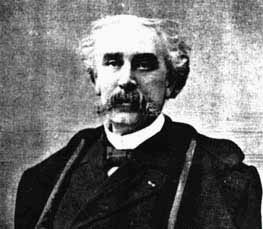
Alexandre St. Yves d'Alveydre, (March 26, 1842, Paris - February 5, 1909), was a French occultist who adapted the works of Fabre d'Olivet (1767-1825) and, in turn, had his ideas adapted by Papus. He developed the term Synarchy - the association of everyone with everyone else - into a political philosophy, and his ideas about this type of government proved influential in politics and the occult.
Born in Paris, from a family of Parisian intellectuals and son of psychiatrist Guillaume-Alexandre Saint-Yves, he started his career as a physician at a naval academy in Brest which he soon abandoned after becoming ill. In 1863 he relocated to Jersey where he connected with Victor Hugo. In 1870, he returned to France to fight in the Franco-Prussian War during which he was injured.
He then began a career as a civil servant. In 1877 Saint-Yves met and married Countess Marie de Riznitch-Keller, a relative of Honore de Balzac, and friend of the Empress Eugenie de Montijo, a move which made him independently wealthy. He dedicated the rest of his life to research and had a large number of influential contacts including Victor Hugo. Saint-Yves later knew many of the major names in French occultism such as Marquis Stanislas de Guaita, Josephin Peladan and Oswald Wirth and was a member of a number of Rosicrucian, and Freemason style orders. Saint-Yves supposedly inherited the papers of one of the great founders of French occultism, Antoine Fabre d'Olivet (1762-1825).
In 1877 he published the "Lyrical Testament", a collection of poetry, and "Keys of the Orient". In the latter book, he presents a solution (based on developing a religious understanding between Jews, Christians and Muslims) to the "question of the Orient", brought about by the decay of the Ottoman empire which caused tensions in the Near and Middle East.
He also began to study the development of industrial applications of marine plants ( "Utilising extracts from seaweed" was published in 1879) but he could not perform the operation for lack of capital. In 1880, he was granted the title of Marquis of Alveydre by the government of San Marino. Mission des Juifs (1884) was favorable to Jews, but material from it was used for The Secret of the Jews an anti-semitic tract attributed to Yuliana Glinka.
Development of Synarchy
He defended social differentiation and hierarchy with co-operation between social classes, transcending conflict between social and economic groups: Synarchy, as opposed to anarchy. Specifically, Saint-Yves envisioned a European society with a government composed of three councils, representing economic power, judicial power, and scientific community, of which the metaphysical chamber bound the whole structure together. These ideas were also influenced by works such as Plato's The Republic and by Martinism.
As part of this concept of government Alexandre Saint-Yves d'Alveydre, gave an important role to secret societies or, more precisely, esoteric societies, which are composed of oracles and who safeguarded the government from behind the scenes. He saw the Rosicrucians as having fulfilled this role in medieval Europe and was involved with a number of Freemason and other groups who claimed descent from the Knights Templar.
Agartha
Being an occultist and alchemist, Saint-Yves believed in the existence of spiritually superior beings. These 'beings' could be contacted telepathically.
Apparently Saint-Yves claimed that he was in touch with these 'superiors' himself, as a matter of fact the principles of Masters who lived in the mysterious underworld realm known as Agartha. Thus d'Alveydre introduced the concept of "Agartha" to the Western world.
The myth of "Agartha" is also known as "Shambhala", as it was known in India, the underworld realm peopled by initiates and lead by 'the Masters", Masters who are the Spiritual leaders of humanity.
Agartha is the great Asian University of the Initiates of the Greater Mysteries. Their 'Mahatma' ('Great Soul') plays the part of the supreme spiritual leader of humanity.
According to Saint-Yves the secret world of "Agartha" and all of its wisdom and wealth "will be accessible for all mankind, when Christianity lives up to the commandments which were once drafted by Moses and Jesus, meaning ' When the Anarchy which exists in our world is replaced by the Synarchy".
Saint-Yves gives a 'lively' description of "Agartha" in this book as if it were a place which really exists, situated in the Himalayas in Tibet. Saint-Yves' version of the history of "Agartha" is based upon ' revealed' information, meaning received by Saint-Yves himself through 'attunement'. However, several French 'reliable' sources state that Saint-Yves was NOT a medium. We've seen that Saint-Yves used a medium, a certain Marie Victoire, when he wrote the "Archeometre". It seems that "the sources" disagree with each other when it comes to Saint-Yves' gifts.
St. Yves d'Alveydre was incredibly influential in the development of 19th century occultism. The concept of Agartha and its Masters had a big influence on the teachings of Blavatsky, founder of the Theosophic Society . Blavatsky also 'promoted' one of Saint-Yves' other concepts, namely the idea of 'root races' ; a 'root race' dominated a long period in history, "destined to be supplanted by the next superior race ". The concept of "root races" can also be found in the writings of Alice A.Bail, Rudolf Steiner and Max Heindel.
On the matter of Atlantis - Saint-Yves believed the Atlantis was an advanced superior civilization. According to Saint-Yves the Sphinx was built by the Atlanteans, many thousands of years before the rise of Egypt. Saint-Yves placed the downfall of Atlantis at around 12,000 B.C.
Another source of inspiration for Saint-Yves were the medieval Knights Templar, which he regarded as the ultimate Synarchists in history. After all, the Knights Templar exerted control over the political, financial, and religious life of medieval Europe. These three pillars of medieval society corresponded with Saint-Yves' model of Synarchy.
Saint-Yves was influenced by the many neo-Templar societies that were flourishing in his day. He incorporated many of their ideas, in particular from a Masonic-Templar order called "the Rite of Strict Observance", which was founded around 1740-1750 by German Karl von Hund. Saint Yves borrowed the concept of "Unknown Superiors" from Von Hund , however he expanded the concept into "spiritually advanced beings that lived in a remote part of Tibet", aka "Agartha".
In his youth Saint-Yves (who was of French origin) apparently was not easy to handle and because of his "insubordination" he was, at the age of 13, taken under the custody of 2 professors, Frederic-Auguste of Metz and the Abbot Rosseau. Encouraged by his teachers, he started to read Joseph de Maistre and learned about Fabre d'Olivet. The young Alexandre wanted to study literature, but his father decided otherwise; His son should aim for a career in the military.
At a naval-academy in Brest, where he studied medicine (which his professor, Frederic-Auguste of Metz, had advised him to do), he contracts the blackpox (or "black variola") and he leaves for Jersey to recover from the disease. There he met Pelleport and Victor Hugo. It is said that Victor Hugo, a famous French 19th century novelist, was involved with a group of "Rose-Croix" (rosicrucians) of which Maurice Barres (a later member of the "Ordre Kabbalistique de la Rose+Croix" and of the Supreme Council of Papus' Martinist Order) was also a member.
Around this time Saint-Yves d'Alveydre also visited London for the first time . In 1870 Saint-Yves, still on Jersey, joined the 171 "bataillon de Marche". In 1871 he accepted a post at the Ministry of Home Affairs.
It is stated by an unknown biographer that Saint-Yves at his stay on the Isle of Jersey, received from a relative of Fabre d'Olivet several of his manuscripts which apparently made a huge impression on Saint-Yves. The works of Fabre d'Olivet exerted a major influence on the development of Saint-Yves' philosophy.
In 1877 Saint-Yves met Countess Marie de Riznitch-Keller, a relative of Honore de Balzac, novelist and a member of the 'original ' Martinist Order. Saint-Yves married the Countess, a decision which made him financially (in)dependent. He could afford it to spent almost all of his time doing research in libraries in France and abroad. In 1880 Saint-Yves obtains the title of "Marquis", a title which was conferred to Saint-Yves by the Vatican. Saint Yves had an excellently connected circle of acquaintances through his marriage with the Countess.
Books
In the year 1885 Saint-Yves was visited by a group of Eastern Initiates, one of them being named prince Hardjij Scharipf. Their mission was to inform Saint-Yves on 'Agartha' , a spiritual and political organization. Their visit lead to his publication, titled "Mission de l'Inde en Europe, mission de l'Europe en Asie. La question des Mahatmas et sa solution". Saint-Yves dedicated this work to the "Sovereign Pontiff who wears the tiara of the seven crowns of modern Brahatmah in the ancient Paradise of the Cycle of the Lamb and the Ram". But Saint-Yves did not publish the book but decided to destroy the work and tore it apart.
According to Saint Yves he acted under orders of the Brotherhood.
The wisdom revealed would not be understood and therefore a publication would be like casting pearls before swine. Other sources state that Saint-Yves decided not to "expose the life of a saint" to the outside world, the saint being "Guru Pandit", the Eastern initiate who'd visited Saint-Yves. Apparently Saint-Yves overlooked one copy of the manuscript which fell into the hands of Count Alexander Keller, son of Countess Marie de Riznitch-Keller.
This copy of Saint-Yves "Mission de l'Inde en Europea" was published (posthumous) in a limited edition in 1910 by the publishing firm of Dorbon-Aone. During the Second World War the Gestapo seized all the publications of this book that were known to exist. According to Dr.Philippe Encausse, Papus' son, the original copy belonging to Count Keller was given to Papus. After the death of Papus in 1916 it was donated to the Library of Sorbonne.
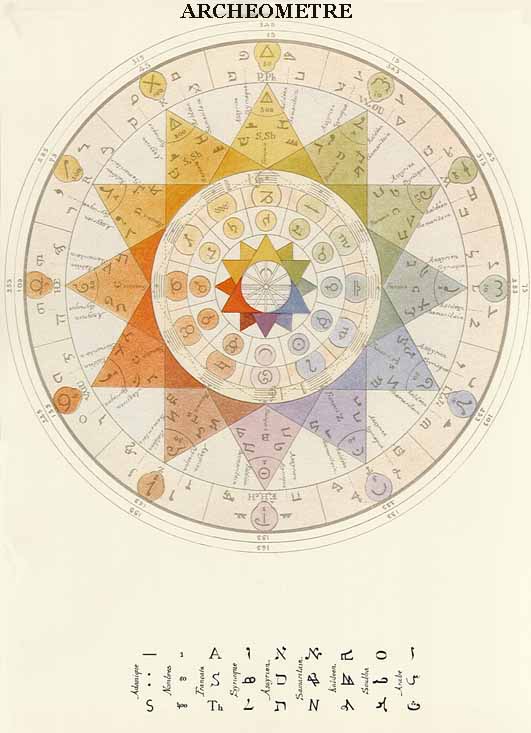
After his wife's death in 1895, Saint-Yves started to work on his last work, an enormous work called the "Archeometre", a book published in 1903. The "Archeometre" 'intended to be a comprehensive key permitting a survey of ancient culture'. The book 'explores' the value of various philosophical, scientific, occult and religious systems 'and its place in the universal tree of science or tradition'. "Archeometre" is derived from the Greek meaning roughly "the mass of the principle". Saint-Yves' system is build around a series of symbols and interpretations relating to the "Ark of the Covenant". It's a very complex system which intends to be the key to all Religions and Sciences of the Ancients.
The term "Archeometre" originates from the Greek and means "the measure of the principle". The system refers also to a series of symbols and meanings, which refer to the federal drawer.
'Archeometre' is it the measurement of the 'Archee' (Universal Cosmic Force) of which the Hermetists speaks. Is it a process, a 'key' which makes it possible to penetrate the Mysteries of the Word. It is a measuring instrument of the first (primary) principles of the manifested universe.
Alexandre Saint Yves d'Alveydre's Archeometre shows the original Atlantean alphabet translates into the material the word, form, color, smell, sound and taste, the key to all religions and the sciences of antiquity.
The Archeometre is represented by a circle, which has two scales from 0 to 360 degrees and 360 degrees to 0. It is divided into 12 ranges with 30 degrees each. In the individual ranges are drawn in the tierkreiszeichen, planet, colors, tones and the letters of different alphabets.
The Archeometre is a universal canon (guide), which wants to point the relationship out between the astrological indications, tones, smells, letters and colors. The musician finds therein the color of tones, the writer the toncharakter of letter etc. The Archeometre is to also point practical use out that the religions, arts and architecture a synthesis from different ranges to form.
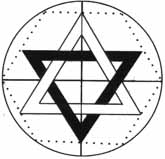
Blavatsky's work had an enormous impact on various esoteric organizations, mainly those which were established in the beginning of the 20th century. For instance, many of Blavatsky's concepts were incorporated into the teachings of Alice Baily (1880-1949), and it is generally known that Baily's teachings have had a huge influence over the beliefs of the New Age movement of today.
Then there is Rudolf Steiner (1861-1925) who used Synarchy as a major influence when he developed his own ideas for his own organization, the "Antroposofische Gesellschaft" (established in 1913, Steiner developed a philosophy which is known as "Antrosophy").
Steiner was a former member (and high dignitary) of the "Theosophic Society" in Germany. One of Steiner's former disciples, Max Heindel (1865-1919), founded the "Rosicrucian Fellowship" in 1908. All these organizations, and I just named a few of them, propagated several of the ideas which were "introduced" by Saint-Yves in a way. The principle of "Masters" is a well known concept within many of the esoteric organizations. The original concept did not descend from Saint-Yves, but he was probably one of the first in the West who introduced the idea of the hidden realms of these Masters, Adepts and Initiates which were situated in the East.
Saint-Yves d'Alveydre is buried in the cemetery at Notre Dame.
Fulcanelli
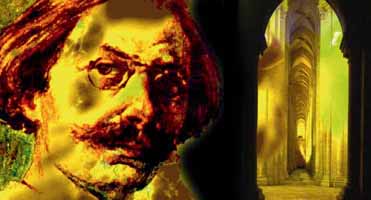
Fulcanelli (dates of birth and death unknown) is almost certainly a pseudonym assumed, in the late 19th century, by a French alchemist and esoteric author, whose identity is still debated. He is also called the Master Alchemist and sometimes the Last Alchemist, the latter because the heritage of medieval alchemic tradition seemed to have ceased with his disappearance. The appeal of Fulcanelli as a cultural phenomenon is partly due to the mystery that surrounds most aspects of his life and works; one of the anecdotes pertaining to his life retells, in particular, how his most devoted pupil Eugene Canseliet performed a successful transmutation of 100 grams of lead into gold in a laboratory near Sarcelles with the use of a small quantity of the "Projection Powder" given to him by his teacher, in the presence of several eyewitnesses.
Life
Very little has been established with any credence about Fulcanelli's origin or life. He was undoubtedly a Frenchman, widely and profoundly educated, and learned in the ways of alchemic lore, architecture, art, and languages.
To associate Fulcanelli with any exact dates or places, excepting the dates when his books were published, would be almost certainly to identify him with a man from his milieu and the illustrator of his books, Jean-Julien Champagne; and, while it is the single most plausible disambiguation of Fulcanelli's true identity, it is not without major flaws and should certainly not be accepted for an established fact.
Fulcanelli wrote two books that were later to be published, and disappeared in 1926, having left his magnum opus with Canseliet. One example of a fact which is difficult to reconcile with the Champagne theory is that Canseliet referred to Fulcanelli as being an eighty-year old man at the time he disappeared, while Champagne, born in 1877, would have only been fifty at the time.
Another is that in 1957, twenty-five years after Champagne's death from an excessive intake of absinthe, a new chapter (The Cyclic Cross at Hendaye) was added to the second edition of Fulcanelli's major book, The Mystery of the Cathedrals, undoubtedly written by the same man. It is unclear why Champagne would have concealed it while he was alive, or why it would have taken so long to have it published posthumously; or why Canseliet would keep denying that Fulcanelli and Champagne were the same man till his own death.
Other theories about Fulcanelli speculate that he was one or another famous French occultist of the time; a member of the former Royal Family (the Valois); another member of the Frres d'Heliopolis (Brotherhood of Heliopolis, a society centered around Fulcanelli which included Eugene Canseliet, Jean-Julien Champagne and Jules Boucher); etc. All of these theories are equally poorly grounded in actual fact.
It is believed that on the verge of World War II, the Abwehr was in active (but fruitless) pursuit of Fulcanelli because of his alleged knowledge of the technology of nuclear weapons.
Finally, according to Canseliet, his last encounter with Fulcanelli happened in 1954, when he went to Spain and there was taken to a castle high in the mountains for a rendezvous with his former master, now miraculously rejuvenated and looking Canseliet's age (about fifty). This particular account is of a highly ambiguous nature, leaving one to question its credibility.
Ancient Egyptian Science and Technology
The characteristics of ancient Egyptians are indicated by a set of artifacts and customs that lasted for thousands of years. The Egyptians invented and used many basic machines, such as the ramp and the lever, to aid construction processes. They used rope trusses to stiffen the beam of ships. Egyptian paper, made from papyrus, and pottery was mass produced and exported throughout the Mediterranean basin. The wheel, however, did not arrive until foreign invaders introduced the chariot in the 16th century BC. The Egyptians also played an important role in developing Mediterranean maritime technology including ships and lighthouses.
Significant advances in ancient Egypt during the dynastic period include astronomy, mathematics, and medicine. Their geometry was a necessary outgrowth of surveying to preserve the layout and ownership of farmland, which was flooded annually by the Nile river. The 3,4,5 right triangle and other rules of thumb served to represent rectilinear structures, and the post and lintel architecture of Egypt. Egypt also was a center of alchemy research for much of the western world. Scenes depict scientists able to work in fields of alchemy, biology, chemistry, dentistry, anesthesiology, air flight, and more.
Ancient Alien Theory
Dendera Light
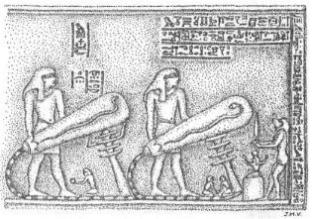
Electricity or Something Else?

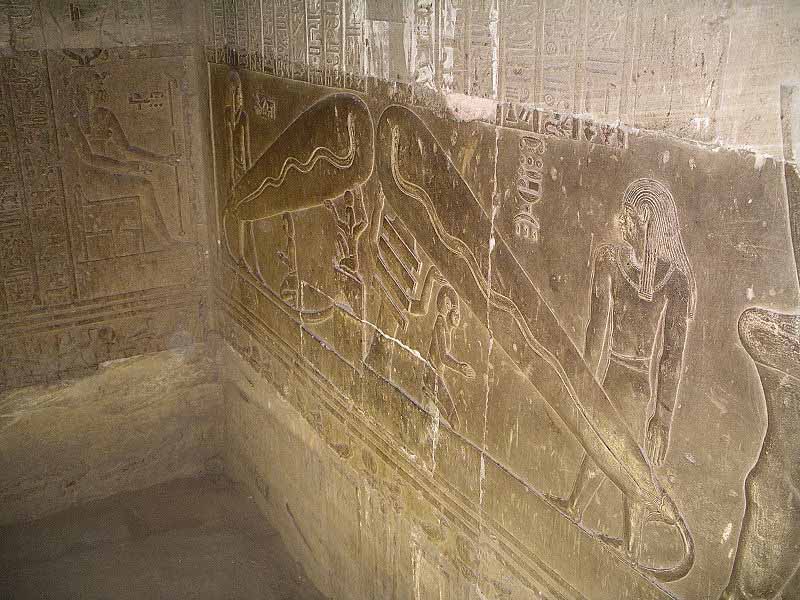
Some have suggested that the Egyptians had some form of understanding electric phenomena from observing lightning and interacting with electric fish (such as the Malapterurus electricus) or other animals (such as electric eels). The comment about lightning appears to come from a misunderstanding of a text referring to "high poles covered with copper plates" to argue this but Dr. Bolko Stern has written in detail explaining why the copper covered tops of poles (which were lower than the associated pylons) do not relate to electricity or lightning, pointing out that no evidence of anything used to manipulate electricity had been found in Egypt and that this was a magical and not a technical installation.
The single representation of the image, called the "Dendera light" by some alternative suggestions, exists on the left wall of the right wing in one of the crypts of the Hathor temple. Those exploring fringe theories of ancient technology have suggested that there were electric lights used in Ancient Egypt. Engineers have constructed a working model based on their interpretation of a relief found in the Hathor temple at the Dendera Temple complex.
The "Dendera light" is a technology of electrical lighting supposedly in existence in ancient Egypt, proposed by some fringe authors. Proponents argue that the technology is depicted in the Hathor temple at the Dendera Temple complex located in Egypt on three stone reliefs (one single and a double representation), which resemble some modern electical lighting systems. Egyptologists reject the theory and explain the reliefs as a typical set of symbolic images from Egyptian mythology.
Authors (such as Peter Krassa and Reinhard Habeck) have produced a basic theory of the device's operation. The standard explanation, however, for the Dendera light, which comprises three stone reliefs (one single and a double representation) is that the depicted image represents a lotus leaf and flower from which a sacred snake is spawned in accordance with Egyptian mythological beliefs. This sacred snake sometimes is identified as the Milky Way (the snake) in the night sky (the leaf, lotus, or "bulb") that became identified with Hathor because of her similar association in creation.

The cathode-ray tube or "Crookes' tube" like object depicted in scenes from the temple of Hathor at Dendera may depict a relativistic source of these heavy electrons - which could drastically expedite the magical processes which involve these particular tubes.
The walls are decorated with human figures next to bulb-like objects reminiscent of oversized light bulbs. Inside these "bulbs" there are snakes in wavy lines. The snakes' pointed tails issue from a lotus flower, which, without much imagination, can be interpreted as the socket of the bulb. Something similar to a wire leads to a small box on which the air god is kneeling. Adjacent to it stands a two-armed djed pillar as a symbol of power, which is connected to the snake. Also remarkable is the baboon-like demon holding two knives in his hands, which are interpreted as a protective and defensive power.
In his book The Eyes of the Sphinx, Erich Von Daniken writes that the relief is found in "a secret crypt" that "can be accessed only through a small opening. The room has a low ceiling. The air is stale and laced with the smell of dried urine from the guards who occasionally use it as a urinal." The room is not so secret, however, as many tourists visit and photograph the room every year. Von Daniken sees the snake as a filament, the djed pillar as an insulator, and claims "the monkey with the sharpened knives symbolizes the danger that awaits those who do not understand the device." This "device" is, the reader is assured, an ancient electric light bulb.
Metallurgy
Whether these exalted personages were themselves professional metallurgists we do not know, but we may at least surmise that the details of metallurgical practice, being of extreme importance to the Crown, were carefully guarded from the vulgar. And when we remember the close association between the Egyptian royal family and the priestly class we appreciate the probable truth of the tradition that chemistry first came to light in the laboratories of Egyptian priests.
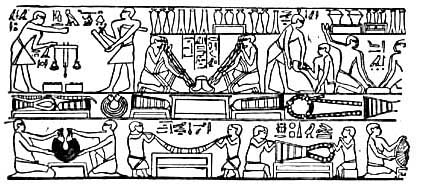
Metal-Workers' Workshop in Old Egypt
The Egyptians called iron 'the metal of heaven' or ba-en-pet, which indicates that the first specimen employed were of meteoric origin; the Babylonian name having the same meaning.
It was no doubt on account of its rarity that iron was prized so highly by the early Egyptians, while its celestial source would have its fascination. Strange to say, it was not used for decorative, religious or symbolical purposes, which - coupled with the fact that it rusts so readily - may explain why comparatively few iron objects of early dynastic age have been discovered.
One which has fortunately survived presents several points of interest: it is an iron tool from the masonry of the Great Pyramid of Khufu at Giza, and thus presumably dates from the time when the Pyramid was being built, i.e. about 2900 B.C. This tool was subjected to chemical analysis and was found to contain combined carbon, which suggests that it may have been composed of steel.
By 666 B.C. the process of casehardening was in use for the edges of iron tools, but the story that the Egyptians had some secret means of hardening copper and bronze that has since been lost is probably without foundation. Desch has shown that a hammered bronze, containing 10.34 per cent of tin, is considerably harder than copper and keeps a cutting edge much better.
Of the other non-precious metals, tin was used in the manufacture of bronze, and cobalt has been detected as a coloring agent in certain specimens of glass and glaze. Neither metal occurs naturally in Egypt, and it seems probable that supplies of ore were imported from Persia. Lead, though it never found extensive application, was among the earliest metals known, specimen having been found in graves of pre-dynastic times. Galena (PbS) was mined in Egypt at Gebel Rasas ('Mountain of Lead'), a few miles from the Red Sea coast, and the supply must have been fairly good, for when the district was re-worked from 19I2 to 1915 it produced more than I8,000 tons of ore.
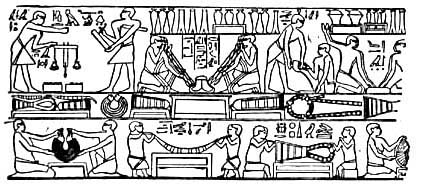
Egyptian Goldsmiths Washing, Melting and Weighing Gold Beni Hasan, 1900 B.C.
Of one of these mines - possibly near Apollinopolis - a plan has been found in a papyrus of the fourteenth century B.C., and the remains of no fewer than 1,300 houses for gold-miners are still to be seen in the Wadi Fawakhir, halfway between Koptos and the Red Sea. In one of the treasure chambers of the temple of Rameses III, at Medinet-Habu, are represented eight large bags, seven of which contained gold and bear the following descriptive labels.
The Egyptian word for gold is nub, which survives in the name Nubia, a country that provided a great deal of the precious metal in ancient days. French Scientist Champollion regarded it as a kind of crucible, while Rossellini and Lepsius preferred to see in it a bag or cloth, with hanging ends, in which the grains of gold were washed - the radiating lines representing the streams of water that ran through.
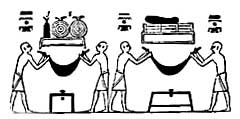
Gold Washing in Ancient Egypt
In the later dynasties, the Egyptians themselves forgot the original significance of the sign and drew it as a necklace with pendent beads. Elliot Smith however says that this was the primitive form and became the determinative of Hathor, the Egyptian Aphrodite, who was the guardian of the Eastern valleys where gold was found.
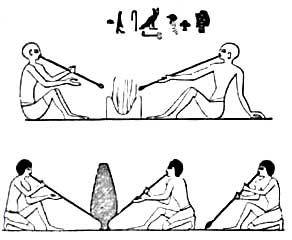
Egyptian Goldsmith Workshop in the Pyramid Age
Alluvial auriferous sand was also treated, a distinction being made between the gold obtained in this way and that extracted from the mines. The latter was called nub-en-set, i.e. gold of the mountain, while alluvial gold was named nub-en-mu, i.e. 'gold of the river'. Auriferous sand was placed in a bag made of a fleece with the woolly side inwards; water was then added and the bag vigorously shaken by two men. When the water was poured off, the earthy particles were carried away, leaving the heavier particles of gold adhering to the fleece. There is a picture of this operation on one of the buildings at Thebes. buildings at Thebes.
Leyden Papyrus X
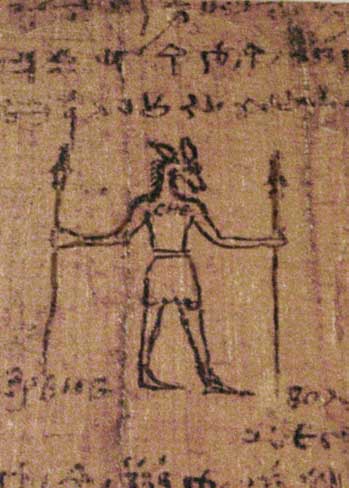
The Leyden papyrus X (P. Leyden X) is a papyrus codex written in Greek at about the end of the 3rd century A.D. or perhaps around 250 A.D. and buried with its owner, and today preserved at Leiden in the Netherlands. It contains alchemical texts, mostly concerned with making dyes and alloys which can be made to look like gold. It also mentions Moses as an alchemist.
The Leiden papyrus was discovered at Thebes in Egypt, together with the Stockholm Papyrus, which was probably written by the same scribe, and many Greek magical papyri, in the early 19th century by an adventurer calling himself Jean d'Anastasi, holding the office of Swedish vice-consul in Alexandria. In 1828 he sold a number of papyri to the Dutch government, which were lodged at the Leiden University Library, and labelled as "papyrus A", "papyrus B", etc. The first publication of information was in 1843, and the texts were published with Latin translation in 1885 by Leemans as Papyri Graeci Musei antiquarii publici Lugduni Batavii. Papyrus X is the most interesting of these. There is some relationship to the Greek magical papyri and to the Mappae clavicula.
The papyrus consists of 10 leaves, 30 x 34 cm in size, folded lengthwise and making 20 pages, of which 16 contain writing. Each page has 28-47 lines. The text contains one hundred and eleven recipes for extracting precious metals, or counterfeiting such metals, or precious stones and purple dye. It also contains details of the manufacture of textiles, and making gold and silver inks.
The recipes are not detailed, and probably served as an aide-memoire for those already familiar with the process. The presentation is exclusively practical, and does not include the usual alchemical or philosophical elements. The last eleven recipes are simply short extracts from the Materia Medica of Pedanius Dioscorides. They are chiefly descriptions of certain minerals. It is of interest to note that the extracts in the papyrus are very close to the present editions of this Greek writer compiled from quite different sources. The work is a collection of chemical recipes and directions for:
1. Making metallic alloys
2. Imitations of gold, silver or electrum
3. Dye and other related arts
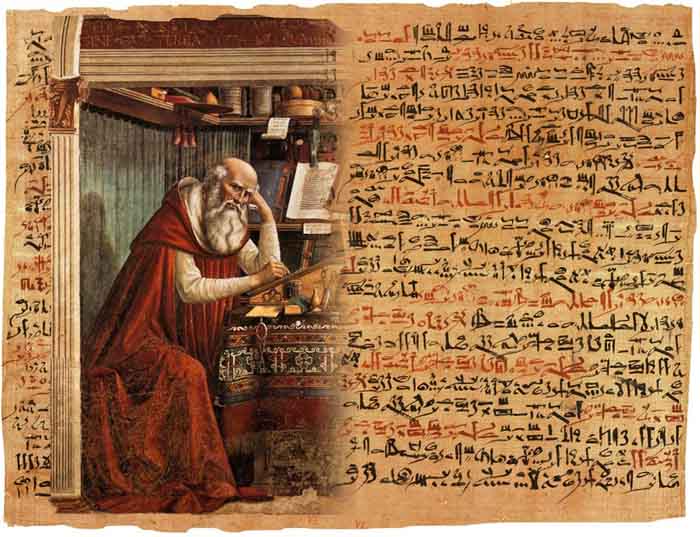
Ancient Egyptian Medicine Other Egyptian Papyri
Glass Making
The Egyptians made small jars and bottles using the core-formed method. Glass threads were wound around a bag of sand tied to a rod. The glass was continually reheated to fuse the threads together. The glass-covered sand bag was kept in motion until the required shape and thickness was achieved. The rod was allowed to cool, then finally the bag was punctured and the rod removed. The Egyptians also created the first colored glass rods which they used to create colorful beads and decorations. They also worked with cast glass, which was produced by pouring molten glass into a mold, much like iron and the more modern crucible steel.
The remains of glass furnaces discovered by Flinders-Petrie at Tel-El-Amarna (1400 B.C.) illustrates the manufacture of rods, beads, and jars or other figures, formed apparently by covering clay cores with glass and later removing the cores.
Egyptian glass articles were of colored glass, often beautifully patterned. Analyses of ancient Egyptian glass articles show that generally glass was a soda-lime glass with rather soda content as compared with modern soda-lime glass.
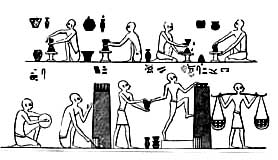
Egyptian Making Pottery, With Furnace Beni Hasan, 1900 B.C.
Paper and Writing
Egyptian hieroglyphs, a phonetic writing system, served as the basis for the Phoenician alphabet from which later alphabets were derived. With this ability, writing and record keeping, the Egyptians developed one of the - if not the - first decimal system.
The city of Alexandria retained preeminence for its records and scrolls with its library. That ancient library was damaged by fire when it fell under Roman rule, and was destroyed completely by 642 CE. With it, a huge amount of antique literature, history, and knowledge was lost.
Structures and Construction
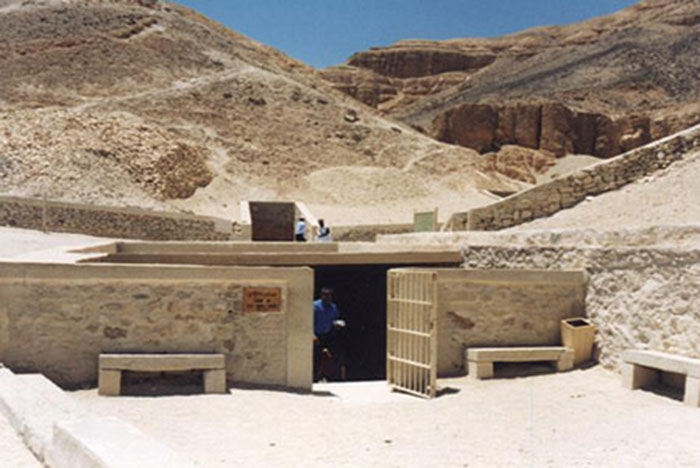
Pharaoh Tutankamun's rock-cut tomb in the Valley of the Kings was full of jewelery and antiques. In some late myths, Ptah was identified as the primordial mound and had called creation into being, he was considered the deity of craftsmen, and in particular, of stone-based crafts. Imhotep, who was included in the Egyptian pantheon, was the first documented engineer.
In Hellenistic Egypt, lighthouse technology was developed, the most famous example being the Lighthouse of Alexandria. Alexandria was a port for the ships that traded the goods manufactured in Egypt or imported into Egypt. A giant cantilevered hoist lifted cargo to and from ships. The lighthouse itself was designed by Sostratus of Cnidus and built in the 3rd century BC (between 285 and 247 BC) on the island of Pharos in Alexandria, Egypt, which has since become a peninsula. This lighthouse was renowned in its time and knowledge of it was never lost. A 2006 drawing of it created from the study of many references, is shown at the right.
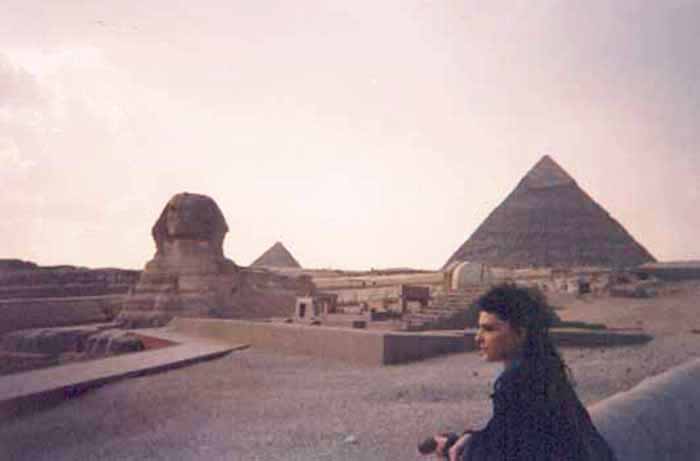
The Nile valley has been the site of one of the most influential civilizations in the world with its architectural monuments, which include the Pyramids of Giza and the Great Sphinx - among the largest and most famous buildings in the world. The most famous pyramids are the Egyptian pyramids - huge structures built of brick or stone, some of which are among the largest constructions by humans. Pyramids functioned as tombs for pharaohs.
In Ancient Egypt, a pyramid was referred to as mer, literally "place of ascendance." The Great Pyramid of Giza is the largest in Egypt and one of the largest in the world. The base is over 13 acres (53,000 m) in area. It is one of the Seven Wonders of the World, and the only one of the seven to survive into modern times. The Ancient Egyptians capped the peaks of their pyramids with gold and covered their faces with polished white limestone, although many of the stones used for the finishing purpose have fallen or been removed for use on other structures over the millennia.
The Red Pyramid of Egypt (c.26th century BC), named for the light crimson hue of its exposed granite surfaces, is the third largest of Egyptian pyramids. Menkaure's Pyramid, likely dating to the same era, was constructed of limestone and granite blocks. The Great Pyramid of Giza (c. 2580 BC) contains a huge granite sarcophagus fashioned of "Red Aswan Granite." The mostly ruined Black Pyramid dating from the reign of Amenemhat III once had a polished granite pyramidion or capstone, now on display in the main hall of the Egyptian Museum in Cairo . Other uses in Ancient Egypt, include columns, door lintels, sills, jambs, and wall and floor veneer.
The ancient Egyptians had some of the first monumental stone building. How the Egyptians worked the solid granite is still a matter of debate. Dr. Patrick Hunt has postulated that the Egyptians used emery shown to have higher hardness on the Mohs scale. Regarding construction, of the various methods possibly used by builders, the lever moved and uplifted obelisks weighing more than 100 tons.
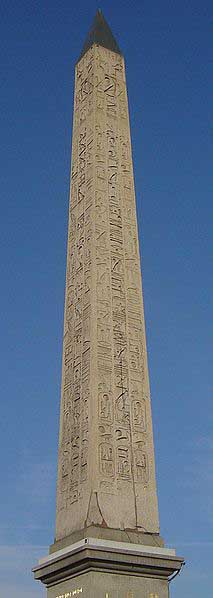
Obelisks were a prominent part of the architecture of the ancient Egyptians, who placed them in pairs at the entrances of various monuments and important buildings, such as temples. In 1902, Encyclopedia Britannia wrote, "The earliest temple obelisk still in position is that of Senwosri I of the Twelfth Dynasty at Heliopolis (68 feet high)".
The word "obelisk" is of Greek rather than Egyptian origin because Herodotus, the great traveler, was the first writer to describe the objects. Twenty-nine ancient Egyptian obelisks are known to have survived, plus the unfinished obelisk being built by Hatshepsut to celebrate her sixteenth year as pharaoh. It broke while being carved out of the quarry and was abandoned when another one was begun to replace it.
The broken one was found at Aswan and provides the only insight into the methods of how they were hewn. The obelisk symbolized the sky deity Ra and during the brief religious reformation of Akhenaten, was said to be a petrified ray of the Aten, the sun disk. It is hypothesized by New York University Egyptologist Patricia Blackwell Gary and Astronomy senior editor Richard Talcott that the shapes of the ancient Egyptian pyramid and Obelisk were derived from natural phenomena associated with the sun (the sun-god Ra being the Egyptians' greatest deity). It was also thought that the deity existed within the structure. The Egyptians also used pillars extensively.
It is unknown whether the Ancient Egyptians had kites, but a team led by Maureen Clemmons and Mory Gharib raised a 5,900-pound, 15-foot (4.6 m) obelisk into vertical position with a kite, a system of pulleys, and a support frame. Maureen Clemmons developed the idea that the ancient Egyptians used kites for work. Ramps have been reported as being widely used in Ancient Egypt.
A ramp is inclined plane, or a plane surface set at an angle (other than a right angle) against a horizontal surface. The inclined plane permits one to overcome a large resistance by applying a relatively small force through a longer distance than the load is to be raised. In civil engineering the slope (ratio of rise/run) is often referred to as a grade or gradient. An inclined plane is one of the commonly-recognized simple machines. Maureen Clemmons subsequently lead a team of researchers demonstrating a kite made of natural material and reinforced with shellac (which according to their research pulled with 97% the efficiency of nylon), in a 9mph wind, would easily pull an average 2-ton pyramid stone up the 1st two courses of a pyramid (in collaboration with Cal Poly, Pomona, on a 53-stone pyramid built in Rosamond, CA).
Ancient Egyptians had experience with building a variety of ships. Some of them survive to this day as Khufu Solar ship. The ships were found in many areas of Egypt as the Abydos boats and remnants of other ships were found near the pyramids.
Sneferu's ancient cedar wood ship Praise of the Two Lands is the first reference recorded to a ship being referred to by name.
Although quarter rudders were the norm in Nile navigation, the Egyptians were the first to use also stern-mounted rudders.
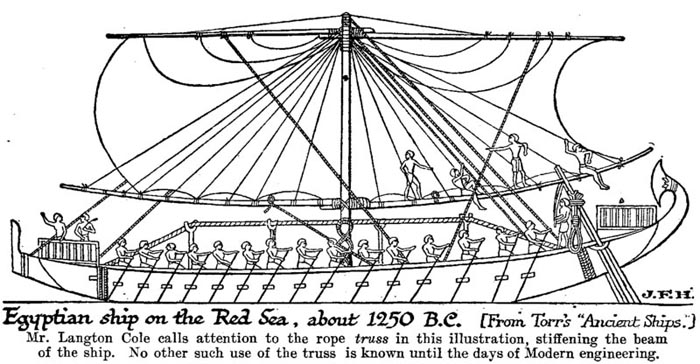
The Ancient Egyptians had knowledge to some extent of sail construction. This is governed by the science of aerodynamics. The earliest Egyptian sails were simply placed to catch the wind and push a vessel. Later Egyptian sails dating to 2400 BCE were built with the recognition that ships could sail against the wind using the side wind. Queen Hatshepsut oversaw the preparations and funding of an expedition of five ships, each measuring seventy feet long, and with several sails. Various others exist, also.
Irrigation and Agriculture
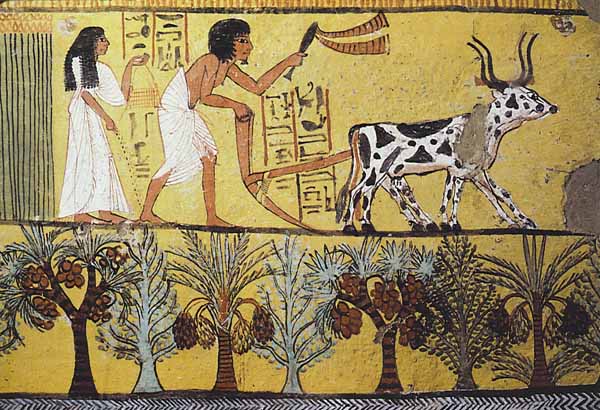
Irrigation as the artificial application of water to the soil was used to some extent in Ancient Egypt, a hydraulic civilization (which entail hydraulic engineering). In crop production it is mainly used to replace missing rainfall in periods of drought, as opposed to reliance on direct rainfall (referred to as dryland farming or as rainfed farming).
There is evidence of the ancient Egyptian pharaoh Amenemhet III in the twelfth dynasty (about 1800 BCE) using the natural lake of the Fayum as a reservoir to store surpluses of water for use during the dry seasons, as the lake swelled annually as caused by the annual flooding of the Nile.

To lift the water from the canal they used a shaduf. A shaduf is a large pole balanced on a crossbeam, a rope and bucket on one end and a heavy counter weight at the other. By pulling the rope it lowered the bucket into the canal. The farmer then raised the bucket of water by pulling down on the weight. He then swung the pole around and emptied the bucket onto the field.
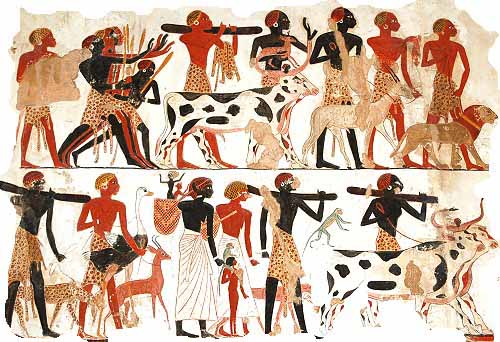
Animals were very important to Egyptian farmers. Animals helped them with jobs like trampling in the seeds, pulling the plough, eating unwanted grain or wheat and providing the Egyptians with food and drink. They kept animals such as cattle, goats, pigs, ducks, cows, and geese.

Furniture
Use of Ropes
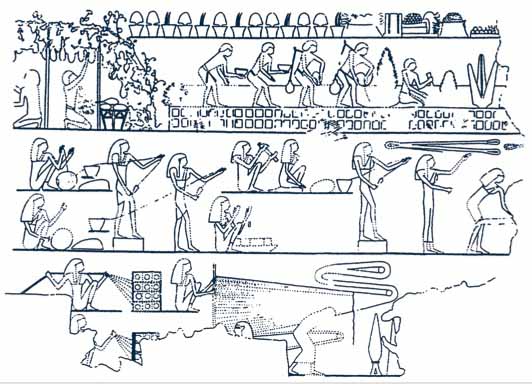
Ancient Egyptian depiction of women engaged in mechanical rope making, the first graphic evidence of the craft, shown in the two lower rows of the illustration.

Mummification
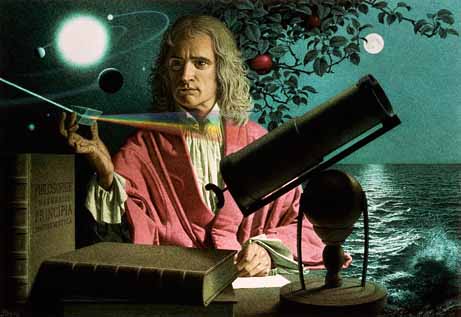
Cool Blog: Alchemy >>>>> Download Now
ReplyDelete>>>>> Download Full
Cool Blog: Alchemy >>>>> Download LINK
>>>>> Download Now
Cool Blog: Alchemy >>>>> Download Full
>>>>> Download LINK vV